Fein ASCT18M: инструкция
Раздел: Инструмент, электроинструмент, силовая техника
Тип:
Инструкция к Fein ASCT18M
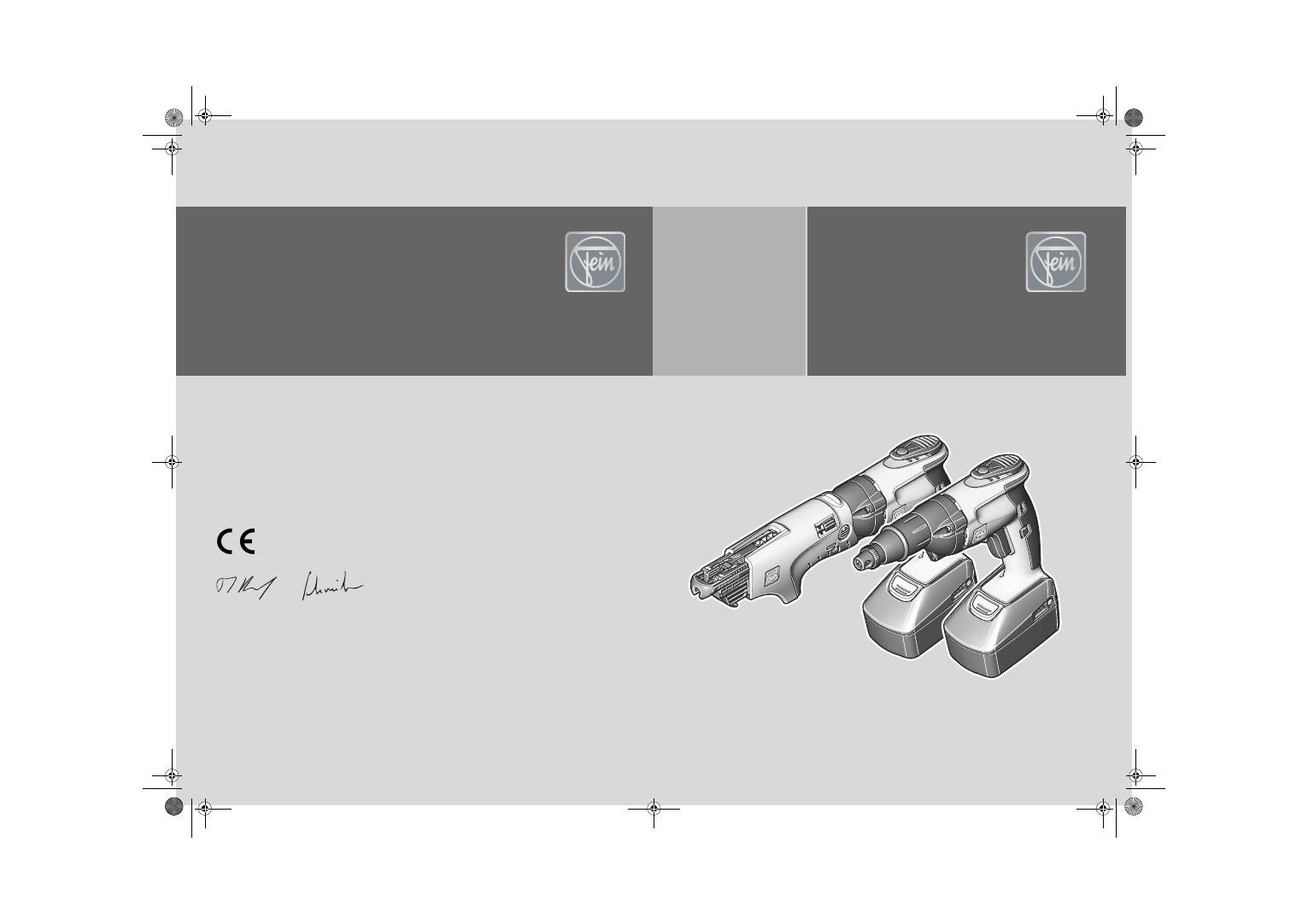
©
C.
& E
. FEIN
Gm
bH.
Pr
in
te
d i
n
Ger
m
an
y.
Abb
ild
u
n
gen
un
verb
in
d
lic
h.
T
ec
h
n
isc
h
e Änd
er
unge
n
vo
rb
eha
lt
en.
3 4
1
0
1
1
7
6 0
6
0
BY
20
1
2
.06 D
E
.
EN 60745, EN 55014
2011/65/EU, 2006/42/EG, 2004/108/EG
FEIN Service
C. & E. FEIN GmbH
Hans-Fein-Straße 81
D-73529 Schwäbisch Gmünd-Bargau
www.fein.com
ASCT14
7 113 14
ASCT14M
7 113 14
ASCT14U
7 113 15
ASCT14UM
7 113 15
ASCT18
7 113 16
ASCT18M
7 113 16
ASCT18U
7 113 17
ASCT18UM
7 113 17
Hammersdorf
Quality Manager
Dr. Schreiber
Manager of R&D department
OBJ_DOKU-0000002096-001.fm Page 1 Monday, June 18, 2012 8:39 AM

2
ASCT14 ASCT14M
ASCT14U ASCT14UM
ASCT18 ASCT18M
ASCT18U ASCT18UM
7 113 14 7 113 14 7 113 15
7 113 15 7 113 16 7 113 16 7 113 17
7 113 17
V
14,4
14,4
14,4
14,4
18
18
18
18
U
V
14,4
14,4
14,4
14,4
18
18
18
18
n
0
/min
0 – 4000
0 – 4000
0 – 4000
0 – 4000
0 – 4000
0 – 4000
0 – 4000
0 – 4000
n
1
/min
0 – 2700
0 – 2700
0 – 2700
0 – 2700
0 – 2700
0 – 2700
0 – 2700
0 – 2700
M...
Nm
10/5
10/5
10/5
10/5
10/5
10/5
10/5
10/5
kg
1,7
2,1
1,7
2,1
1,7
2,2
1,7
2,2
¼"
¼"
¼"
¼"
¼"
¼"
¼"
¼"
mm
3 – 4,2
3 – 4,2
3 – 4,2
3 – 4,2
3 – 4,2
3 – 4,2
3 – 4,2
3 – 4,2
L
pA
dB
71
71
71
71
74
74
74
74
K
pA
dB
3
3
3
3
3
3
3
3
L
wA
dB
82
82
82
82
85
85
85
85
K
wA
dB
3
3
3
3
3
3
3
3
L
pCpeak
dB
86
86
86
86
87
87
87
87
K
pCpeak
dB
3
3
3
3
3
3
3
3
h
m/s
2
1,5
1,5
1,5
1,5
1,5
1,5
1,5
1,5
K
a
m/s
2
1,5
1,5
1,5
1,5
1,5
1,5
1,5
1,5
3
de
12
pt
30
tr
49
sl
67
et
88
th
106
en
15
el
33
hu
52
sr
70
lt
91
ja
110
fr
18
da
37
cs
55
hr
73
lv
94
hi
113
it
21
no
40
sk
58
ru
76
zh(CM)
97
ar
118
nl
24
sv
43
pl
61
uk
80
zh(CK)
100
es
27
fi
46
ro
64
bg
84
ko
103
OBJ_BUCH-0000000072-001.book Page 2 Monday, June 18, 2012 8:40 AM

3
5
6
4
10
9
9
10
11
7
8
OBJ_BUCH-0000000072-001.book Page 3 Monday, June 18, 2012 8:40 AM

4
1.
2.
OBJ_BUCH-0000000072-001.book Page 4 Monday, June 18, 2012 8:40 AM

5
ASCT14M
ASCT14UM
ASCT18M
ASCT18UM
2.
1.
1.
5.
4.
3.
3.
2.
1.
4.
OBJ_BUCH-0000000072-001.book Page 5 Monday, June 18, 2012 8:40 AM

6
> Ø 38 mm
< Ø 45 mm
1.
2.
OBJ_BUCH-0000000072-001.book Page 6 Monday, June 18, 2012 8:40 AM

7
ASCT14U
ASCT14UM
ASCT18U
ASCT18UM
27 mm
10–12 Nm
27 mm
1.
2.
4.
3.
5.
6.
OBJ_BUCH-0000000072-001.book Page 7 Monday, June 18, 2012 8:40 AM

8
7.
7.
360 =
1 mm
4.
5.
6.
1.
2.
2.
3.
= 0 mm
OBJ_BUCH-0000000072-001.book Page 8 Monday, June 18, 2012 8:40 AM

9
1.
1.
2.
2.
3.
OBJ_BUCH-0000000072-001.book Page 9 Monday, June 18, 2012 8:40 AM

10
100 %
75 %
50 %
25 %
0 %
OBJ_BUCH-0000000072-001.book Page 10 Monday, June 18, 2012 8:40 AM

11
ASCT14U
ASCT14UM
ASCT18U
ASCT18UM
ASCT-14M
ASCT-14UM
ASCT-18M
ASCT-18UM
OBJ_BUCH-0000000072-001.book Page 11 Monday, June 18, 2012 8:40 AM

12
de
de
Originalbetriebsanleitung Akku-Schrauber.
Verwendete Symbole, Abkürzungen und Begriffe.
Symbol, Zeichen
Erklärung
Rotierende Teile des Elektrowerkzeugs nicht berühren.
Den Anweisungen im nebenstehenden Text oder Grafik folgen!
Die beiliegenden Dokumente wie Betriebsanleitung und Allgemeine Sicherheitshinweise
unbedingt lesen.
Vor diesem Arbeitsschritt den Akku aus dem Elektrowerkzeug entfernen. Sonst besteht
Verletzungsgefahr durch unbeabsichtigtes Anlaufen des Elektrowerkzeugs.
Beim Arbeiten Augenschutz benutzen.
Laden Sie keine beschädigten Akkus.
Setzen Sie den Akku nicht dem Feuer aus. Schützen Sie den Akku vor Hitze, z.B. auch vor
dauernder Sonneneinstrahlung.
Die Hinweise im nebenstehenden Text beachten!
Griffbereich
Bestätigt die Konformität des Elektrowerkzeugs mit den Richtlinien der Europäischen
Gemeinschaft.
Dieser Hinweis zeigt eine möglicherweise gefährliche Situation an, die zu ernsten Verlet-
zungen oder zum Tod führen kann.
Recycling-Zeichen: kennzeichnet wiederverwertbare Materialien
Ausgemusterte Elektrowerkzeuge und andere elektrotechnische und elektrische Erzeug-
nisse getrennt sammeln und einer umweltgerechten Wiederverwertung zuführen.
Akkutyp
Kleine Drehzahl
Große Drehzahl
Drehmoment verkleinern
Drehmoment vergrößern
Zeichen
Einheit international
Einheit national
Erklärung
U
V
V
elektrische Gleichspannung
n
0
/min, min
-1
, rpm, r/min
/min
Leerlaufdrehzahl
n
1
/min, min
-1
, rpm, r/min
/min
Lastdrehzahl
M...
Nm
Nm
Drehmoment (harter/weicher Schraubfall)
inch
inch
Werkzeugaufnahme Innensechskant
mm
mm
Schraubendurchmesser
kg
kg
Gewicht entsprechend EPTA-Procedure 01/2003
L
pA
dB
dB
Schalldruckpegel
L
wA
dB
dB
Schallleistungspegel
L
pCpeak
dB
dB
Spitzenschalldruckpegel
WARNUNG
OBJ_DOKU-0000002100-001.fm Page 12 Wednesday, June 20, 2012 8:02 AM

13
de
Zu Ihrer Sicherheit.
Lesen Sie alle Sicherheitshinweise
und Anweisungen.
Versäumnisse bei
der Einhaltung der Sicherheitshinweise und Anweisungen
können elektrischen Schlag, Brand und/oder schwere
Verletzungen verursachen.
Bewahren Sie alle Sicherheitshinweise und Anweisungen
für die Zukunft auf.
Verwenden Sie dieses Elektrowerkzeug nicht,
bevor Sie diese Betriebsanleitung sowie die beilie-
genden „Allgemeinen Sicherheitshinweise“ (Schrif-
tennummer 3 41 30 054 06 1) gründlich gelesen und
vollständig verstanden haben. Bewahren Sie die genann-
ten Unterlagen zum späteren Gebrauch auf und überrei-
chen Sie diese bei einer Weitergabe oder Veräußerung
des Elektrowerkzeugs.
Beachten Sie ebenso die einschlägigen nationalen
Arbeitsschutzbestimmungen.
Bestimmung des Elektrowerkzeugs:
handgeführter Schrauber zum Ein- und Ausdrehen von
Schrauben, speziell für den Einsatz im Trockenbau mit
Schnellbauschrauben, mit den von FEIN zugelassenen
Einsatzwerkzeugen und Zubehör in wettergeschützter
Umgebung.
Spezielle Sicherheitshinweise.
Halten Sie das Gerät an den isolierten Griffflächen, wenn
Sie Arbeiten ausführen, bei denen die Schraube verbor-
gene Stromleitungen treffen kann.
Der Kontakt der
Schraube mit einer spannungsführenden Leitung kann
auch metallene Geräteteile unter Spannung setzen und
zu einem elektrischen Schlag führen.
Achten Sie auf verdeckt liegende elektrische Leitungen, Gas-
und Wasserrohre.
Kontrollieren Sie vor Arbeitsbeginn den
Arbeitsbereich z. B. mit einem Metallortungsgerät.
Sichern Sie das Werkstück.
Ein mit einer Spannvorrich-
tung gehaltenes Werkstück ist sicherer gehalten als in
Ihrer Hand.
Halten Sie das Elektrowerkzeug gut fest.
Es können kurz-
zeitig hohe Reaktionsmomente auftreten.
Bearbeiten Sie kein asbesthaltiges Material.
Asbest gilt
als krebserregend.
Es ist verboten Schilder und Zeichen auf das Elektrowerk-
zeug zu schrauben oder zu nieten.
Eine beschädigte Iso-
lierung bietet keinen Schutz gegen elektrischen Schlag.
Verwenden Sie Klebeschilder.
Verwenden Sie kein Zubehör, das nicht speziell vom Elek-
trowerkzeughersteller entwickelt oder freigegeben
wurde.
Sicherer Betrieb ist nicht alleine dadurch gegeben,
dass ein Zubehör auf Ihr Elektrowerkzeug passt.
Verwendung und Behandlung des Akkus (Akku-
blocks)
Um Gefährdungen wie Verbrennungen, Brand, Explosion,
Hautverletzungen und andere Verletzungen beim Umgang
mit den Akkus zu vermeiden, beachten Sie folgende Hin-
weise:
Akkus dürfen nicht zerlegt, geöffnet oder zerkleinert wer-
den. Setzen Sie die Akkus keinen mechanischen Stößen
aus.
Bei Beschädigung und unsachgemäßem Gebrauch
des Akkus können schädliche Dämpfe und Flüssigkeiten
austreten. Die Dämpfe können die Atemwege reizen.
Austretende Akkuflüssigkeit kann zu Hautreizungen-
oder Verbrennungen führen.
Falls aus dem beschädigten Akku ausgetretene Flüssig-
keit angrenzende Gegenstände benetzt hat, überprüfen
Sie die betroffenen Teile, reinigen Sie diese oder tau-
schen Sie sie gegebenenfalls aus.
Setzen Sie den Akku nicht der Hitze oder dem Feuer aus.
Lagern Sie den Akku nicht im direkten Sonnenlicht.
Entnehmen Sie den Akku erst dann aus seiner Original-
verpackung, wenn er verwendet werden soll.
Nehmen Sie den Akku vor Arbeiten am Elektrowerkzeug
aus dem Elektrowerkzeug.
Läuft das Elektrowerkzeug
unbeabsichtigt an, besteht Verletzungsgefahr.
Nehmen Sie den Akku nur bei ausgeschaltetem Elek-
trowerkzeug ab.
Halten Sie Akkus von Kindern fern.
Halten Sie den Akku sauber und geschützt vor Feuchtig-
keit und Wasser.
Reinigen Sie die verschmutzten
Anschlüsse des Akkus und des Elektrowerkzeugs mit
einem trockenen, sauberen Tuch.
Verwenden Sie nur intakte original FEIN-Akkus, die für Ihr
Elektrowerkzeug bestimmt sind.
Beim Arbeiten mit und
Laden von falschen, beschädigten, reparierten oder auf-
gearbeiteten Akkus, Nachahmungen und Fremdfabri-
katen besteht Brandgefahr und/oder Explosionsgefahr.
Befolgen Sie die Sicherheitshinweise in der Betriebsanlei-
tung des Akku-Ladegeräts.
Hand-Arm-Vibrationen
Der in diesen Anweisungen angegebene Schwingungspe-
gel ist entsprechend einem in EN 60745 genormten
Messverfahren gemessen worden und kann für den Ver-
gleich von Elektrowerkzeugen miteinander verwendet
werden. Er eignet sich auch für eine vorläufige Einschät-
zung der Schwingungsbelastung.
Der angegebene Schwingungspegel repräsentiert die
hauptsächlichen Anwendungen des Elektrowerkzeugs.
Wenn allerdings das Elektrowerkzeug für andere
Anwendungen, mit abweichenden Einsatzwerkzeugen
K...
Unsicherheit
m/s
2
m/s
2
Schwingungsemissionswert nach EN 60745
(Vektorsumme dreier Richtungen)
h
m/s
2
m/s
2
Schwingungsemissionswert (Schrauben)
m, s, kg, A, mm, V,
W, Hz, N, °C, dB,
min, m/s
2
m, s, kg, A, mm, V,
W, Hz, N, °C, dB,
min, m/s
2
Basis- und abgeleitete Einheiten aus dem Interna-
tionalen Einheitensystem
SI
.
Zeichen
Einheit international
Einheit national
Erklärung
WARNUNG
OBJ_DOKU-0000002100-001.fm Page 13 Wednesday, June 20, 2012 8:02 AM

14
de
oder ungenügender Wartung eingesetzt wird, kann der
Schwingungspegel abweichen. Dies kann die Schwin-
gungsbelastung über den gesamten Arbeitszeitraum
deutlich erhöhen.
Für eine genaue Abschätzung der Schwingungsbelastung
sollten auch die Zeiten berücksichtigt werden, in denen
das Gerät abgeschaltet ist oder zwar läuft, aber nicht
tatsächlich im Einsatz ist. Dies kann die Schwingungs-
belastung über den gesamten Arbeitszeitraum deutlich
reduzieren.
Legen Sie zusätzliche Sicherheitsmaßnahmen zum Schutz
des Bedieners vor der Wirkung von Schwingungen fest
wie zum Beispiel: Wartung von Elektrowerkzeug und
Einsatzwerkzeugen, Warmhalten der Hände, Organisa-
tion der Arbeitsabläufe.
Bedienungshinweise.
Betätigen Sie den Drehrichtungsumschalter nur bei Still-
stand des Motors.
Bringen Sie den Drehrichtungsumschalter in Mittelstel-
lung, um eine unbeabsichtigte Inbetriebnahme, z. B. beim
Transport, zu vermeiden.
Bei Überhitzung läuft das Elektrowerkzeug mit kurzen,
leistungsarmen Impulsen. Lassen Sie das Elektrowerk-
zeug im Leerlauf abkühlen.
ASCT14/ASCT14M/ASCT18/ASCT18M:
Die Verschrau-
bungen sind mit montiertem Tiefenanschlag auszuführen.
ASCT14M/ASCT14UM/ASCT18M/ASCT18UM:
Das
Schraubmagazin darf nur in Stellung „Drehrichtung
rechts“ betrieben werden.
Drehmoment einstellen (ASCT14U/ASCT14UM/
ASCT18U/ASCT18UM) (siehe Seite 7).
Die Werkseinstellung entspricht dem Bereich für
kleinere bis mittelgroße Schrauben.
Das Anzugsdrehmoment ist auch von der Kraft abhängig,
mit der das Elektrowerkzeug gegen die Schraube
gedrückt wird.
Umgang mit dem Akku.
Betreiben und laden Sie den Akku nur im Akku-Betriebs-
temperaturbereich von 0 °C – 45 °C (32 °F – 113 °F). Die
Akku-Temperatur muss am Anfang des Ladevorgangs im
Akku-Betriebstemperaturbereich sein.
Der echte prozentuale Ladezustand des Akkus wird nur
bei gestopptem Motor des Elektrowerkzeugs angezeigt.
Bei einer bevorstehenden Akku-Tiefentladung stoppt die
Elektronik automatisch den Motor.
Instandhaltung und Kundendienst.
Bei extremen Einsatzbedingungen kann sich
bei der Bearbeitung von Metallen leitfähiger
Staub im Innern des Elektrowerkzeugs abset-
zen. Blasen Sie häufig den Innenraum des Elektrowerk-
zeugs durch die Lüftungsschlitze mit trockener und
ölfreier Druckluft aus.
Die aktuelle Ersatzteilliste dieses Elektrowerkzeuges fin-
den Sie im Internet unter www.fein.com.
Folgende Teile können Sie bei Bedarf selbst austauschen:
Einsatzwerkzeuge, Tiefenanschlag, Akku, Gerüsthaken,
Magazin
Gewährleistung und Garantie.
Die Gewährleistung auf das Erzeugnis gilt gemäß den
gesetzlichen Regelungen im Lande des Inverkehrbrin-
gens. Darüber hinaus leistet FEIN Garantie entsprechend
der FEIN-Hersteller-Garantieerklärung.
Im Lieferumfang Ihres Elektrowerkzeugs kann auch nur
ein Teil des in dieser Betriebsanleitung beschriebenen
oder abgebildeten Zubehörs enthalten sein.
Konformitätserklärung.
Die Firma FEIN erklärt in alleiniger Verantwortung, dass
dieses Produkt den auf der letzten Seite dieser Betriebs-
anleitung angegebenen einschlägigen Bestimmungen ent-
spricht.
Technische Unterlagen bei: C. & E. FEIN GmbH,
C-DB_IA, D-73529 Schwäbisch Gmünd
Umweltschutz, Entsorgung.
Verpackungen, ausgemusterte Elektrowerkzeuge und
Zubehör einer umweltgerechten Wiederverwertung
zuführen.
Akkus nur im entladenen Zustand einer geordneten Ent-
sorgung zuführen.
Bei nicht vollständig entladenen Akkus zur Vorsorge
gegen Kurzschlüsse den Steckverbinder mit Klebestrei-
fen isolieren.
LED-Anzeige Bedeutung
Aktion
1 – 4 grüne
LED
prozentualer
Ladezustand
Betrieb
rotes
Dauerlicht
Akku ist fast
leer
Akku aufladen
rotes
Blinklicht
Akku ist nicht
betriebsbereit
Akku in Akku-Betriebs-
temperaturbereich brin-
gen, danach aufladen
OBJ_DOKU-0000002100-001.fm Page 14 Wednesday, June 20, 2012 8:02 AM

15
en
en
Original Instructions for Cordless Screwdriver.
Symbols, abbreviations and terms used.
Symbol, character
Explanation
Do not touch the rotating parts of the power tool.
Observe the instructions in the text or graphic opposite!
Make sure to read the enclosed documents such as the Instruction Manual and the General
Safety Instructions.
Before commencing this working step, remove the battery from the power tool. Other-
wise there may be danger of injury caused by unintentional starting of the power tool.
Use eye protection during operation.
Do not charge damaged batteries.
Keep the battery away from fire. Protect the battery against heat, e. g. against continuous
intense sunlight.
Observe the information in the adjacent text!
Gripping surface
Confirms the conformity of the power tool with the directives of the European Commu-
nity.
This sign indicates a possible dangerous situation that could cause severe or fatal injury.
Recycling symbol: designates recyclable materials
Worn out power tools and other electrotechnical and electrical products should be
sorted separately for environmental-friendly recycling.
Battery type
Low speed
High speed
Reduce torque
Increase torque
Character
Unit of measurement,
international
Unit of measurement,
national
Explanation
U
V
V
DC voltage
n
0
/min, min
-1
, rpm, r/min
rpm
No-load speed
n
1
/min, min
-1
, rpm, r/min
rpm
Speed, full load
M...
Nm
Nm
Torque (hard/soft screwdriving application)
inch
inch
Hexagon socket tool holder
mm
mm
Screw diameter
kg
kg
Weight according to EPTA-Procedure 01/2003
L
pA
dB
dB
Sound pressure level
L
wA
dB
dB
Sound power level
WARNING
OBJ_BUCH-0000000072-001.book Page 15 Monday, June 18, 2012 8:40 AM

16
en
For your safety.
Read all safety warnings and all
instructions.
Failure to follow the
warnings and instructions may result in electric shock,
fire and/or serious injury.
Save all warnings and instructions for future reference.
Do not use this power tool before you have thor-
oughly read and completely understood this
Instruction Manual and the enclosed “General
Safety Instructions” (document number
3 41 30 054 06 1). The documents mentioned should be
kept for later use and enclosed with the power tool,
should it be passed on or sold.
Please also observe the relevant national industrial safety
regulations.
Intended use of the power tool:
hand-guided screwdriver for screwing in and unscrewing
screws, especially for drywall screws, in weather-pro-
tected environments using the application tools and
accessories recommended by FEIN.
Special safety instructions.
Hold power tool by insulated gripping surfaces, when
performing an operation where the fastener may contact
hidden wiring.
Fasteners contacting a “live” wire may
make exposed metal parts of the power tool “live” and
could give the operator an electric shock.
Beware of any concealed electric cables, gas or water
conduits.
Check the working area before commencing
work, e.g. with a metal detector.
Secure the work piece firmly.
A work piece that is
gripped tightly in a clamping device or vice, is more
secure than if held by hand.
Hold the power tool firmly.
High reaction torque can
briefly occur.
Do not machine any material containing asbestos.
Asbes-
tos is cancerogenic.
Do not rivet or screw any name-plates or signs onto the
power tool.
If the insulation is damaged, protection
against an electric shock will be ineffective. Adhesive
labels are recommended.
Do not use accessories which are not specifically
designed and recommended by the power tool manufac-
turer.
Safe operation is not ensured merely because an
accessory fits your power tool.
Use and handling of the battery (battery pack)
To avoid hazardous situations such as burns, fire, explo-
sion, skin injuries, and other injuries when handling the
battery, observe the following instructions:
Batteries must not be disassembled, opened or reduced
in size. Do not subject batteries to mechanical impact or
shock.
Hazardous vapours and fluid can escape in case of
damage and improper use of the battery. The vapours can
irritate the respiratory system. Liquid ejected from the
battery may cause skin irritations or burns.
When battery fluid from a damaged battery has come into
contact with objects close by, check the respective com-
ponents, clean them or replace them as required.
Keep the battery away from heat and fire. Do not store the
battery in direct sunlight.
Do not remove the battery from its original packaging
until it is going to be used.
Before any work on the machine itself, remove the bat-
tery from the power tool.
If the power tool accidentally
starts, there is danger of injury.
Remove the battery only when the power tool is switched
off.
Keep the battery away from children.
Keep the battery clean and protect it against moisture
and water.
Clean contaminated battery terminals and
power tool connections with a dry, clean cloth.
Use only intact original FEIN batteries that are intended
for your power tool.
When working with and charging
incorrect, damaged, repaired or reconditioned batteries,
imitations or other brands, there is danger of fire and/or
explosion.
Follow the safety warnings in the operating instructions
of the battery charger.
Hand/arm vibrations
The vibration emission level given in this information
sheet has been measured in accordance with a standard-
ised test given in EN 60745 and may be used to compare
one tool with another. It may be used for a preliminary
assessment of exposure.
The declared vibration emission level represents the
main applications of the tool. However, if the tool is used
for different applications, with different accessories or
poorly maintained, the vibration emission may differ.
This may significantly increase the exposure level over
the total working period.
L
pCpeak
dB
dB
Peak sound pressure level
K...
Uncertainty
m/s
2
m/s
2
Vibrational emission value according to
EN 60745 (vector sum of three directions)
h
m/s
2
m/s
2
Vibrational emission value (screwdriving)
m, s, kg, A, mm, V,
W, Hz, N, °C, dB,
min, m/s
2
m, s, kg, A, mm, V,
W, Hz, N, °C, dB,
min, m/s
2
Basic and derived units of measurement from
the international system of units
SI
.
Character
Unit of measurement,
international
Unit of measurement,
national
Explanation
WARNING
OBJ_BUCH-0000000072-001.book Page 16 Monday, June 18, 2012 8:40 AM

17
en
An estimation of the level of exposure to vibration
should also take into account the times when the tool is
switched off or when it is running but not actually doing
the job. This may significantly reduce the exposure level
over the total working period.
Identify additional safety measures to protect the opera-
tor from the effects of vibration such as: maintain the tool
and the accessories, keep the hands warm, organisation
of work patterns.
Operating Instructions.
Adjust the rotation selector switch only when the
machine is at a complete stop.
To avoid accidental starting, e. g., during transport, set
the rotation selector switch to the centre position.
When overheated, the machine runs with short, low-
power impulses. Allow the machine to cool down at no-
load speed.
ASCT14/ASCT14M/ASCT18/ASCT18M:
The screwdriving
applications are to be carried out with mounted depth
stop.
ASCT14M/ASCT14UM/ASCT18M/ASCT18UM:
The collated
cartridge may only be operated in “clockwise-rotation
direction” position.
Setting the torque (ASCT14U/ASCT14UM/
ASCT18U/ASCT18UM) (see page 7).
The factory setting is for the small to mid-size screw
range.
The tightening torque also depends on the force with
which the power tool is pressed against the screw.
Handling the battery.
Operate and charge the battery only within the battery
operating-temperature range of 0°C – 45°C (32°F –
113°F). At the beginning of the charging procedure, the
battery temperature must be within the battery operat-
ing-temperature range.
The real percentage of the battery charge condition is
only indicated when the power tool motor is stopped.
The electronics automatically switch off the motor prior
to the battery being deep discharged.
Repair and customer service.
When working metal under extreme operat-
ing conditions, it is possible for conductive
dust to settle in the interior of the power tool.
Blow out the interior of the power tool via the ventila-
tion slots frequently with dry and oil-free compressed air.
The current spare parts list for this power tool can be
found in the Internet at www.fein.com.
If required, you can change the following parts yourself:
Application tools, depth stop, battery, belt clip, magazine
Warranty and liability.
The warranty for the product is valid in accordance with
the legal regulations in the country where it is marketed.
In addition, FEIN also provides a guarantee in accordance
with the FEIN manufacturer’s warranty declaration.
The delivery scope of your power tool may include only
a part of the accessories described or shown in this
Instruction Manual.
Declaration of conformity.
FEIN declares itself solely responsible for this product
conforming with the relevant provisions given on the last
page of this Instruction Manual.
Technical documents at: C. & E. FEIN GmbH, C-DB_IA,
D-73529 Schwäbisch Gmünd
Environmental protection, disposal.
Packaging, worn out power tools and accessories should
be sorted for environmental-friendly recycling.
Dispose of batteries only when discharged.
For batteries that are not completely discharged, insulate
the terminals with tape as a protective measure against
short-circuiting.
LED indicator
Meaning
Activity
1 – 4 green
LED
Percentage of
charge condi-
tion
Operation
Continuous
red light
Battery is
almost empty
Charge battery
Red flashing
light
Battery is not
ready for
operation
Bring the battery into
the battery operat-
ing-temperature
range, then charge
OBJ_BUCH-0000000072-001.book Page 17 Monday, June 18, 2012 8:40 AM

18
fr
fr
Notice originale visseuse sans fil.
Symboles, abréviations et termes utilisés.
Symbole, signe
Explication
Ne pas toucher les éléments en rotation de l’outil électrique.
Suivre les indications données dans le texte ou la représentation graphique ci-contre !
Lire impérativement les documents ci-joints tels que la notice d’utilisation et les instruc-
tions générales de sécurité.
Avant d’effectuer ce travail, retirer l’accumulateur de l’outil électrique. Sinon, il y a des
risques de blessures dues à un démarrage non intentionné de l’outil.
Lors des travaux, porter une protection oculaire.
Ne pas charger des accus endommagés.
Ne pas exposer ou jeter l’accumulateur au feu. Protéger l’accumulateur des sources de
chaleur, comme par ex. l’exposition directe au soleil.
Suivre les indications données dans le texte ci-contre !
Poignée
Confirme la conformité de l’outil électrique aux directives de l’Union Européenne.
Cette indication indique une situation éventuellement dangereuse pouvant entraîner de
graves blessures ou la mort.
Signalisation de recyclage : indique les matériaux recyclables
Trier les outils électriques ainsi que tout autre produit électrotechnique et électrique et
les déposer à un centre de recyclage respectant les directives relatives à la protection de
l’environnement.
Type d’accu
Faible vitesse de rotation
Vitesse de rotation élevée
Diminuer le couple
Augmenter le couple
Signe
Unité internationale
Unité nationale
Explication
U
V
V
Tension en courant continu
n
0
/min, min
-1
, rpm, r/min
tr/min
Vitesse à vide
n
1
/min, min
-1
, rpm, r/min
tr/min
Vitesse de rotation en charge
M...
Nm
Nm
Couple (vissage dur/tendre)
inch
inch
Porte-outil six pans creux
mm
mm
Diamètre vis
kg
kg
Poids suivant EPTA-Procedure 01/2003
L
pA
dB
dB
Niveau de pression acoustique
L
wA
dB
dB
Niveau d’intensité acoustique
AVERTISSEMENT
OBJ_BUCH-0000000072-001.book Page 18 Monday, June 18, 2012 8:40 AM

19
fr
Pour votre sécurité.
Lisez tous les avertissements
de sécurité et toutes les ins-
tructions.
Ne pas suivre les avertissements et instructions
peut donner lieu à une électrocution, un incendie et/ou
une blessure sérieuse.
Conservez tous les avertissements et toutes les instruc-
tions pour pouvoir vous y reporter ultérieurement.
N’utilisez pas cet outil électrique avant d’avoir soi-
gneusement lu et compris à fond cette notice d’uti-
lisation ainsi que les « Instructions générales de
sécurité » (réf. documents 3 41 30 054 06 1). Conservez
ces documents pour une utilisation ultérieure et joignez-
les à l’outil électrique en cas de transmission ou de vente
à une tierce personne.
De même, respectez les dispositions concernant la pré-
vention des accidents du travail en vigueur dans le pays en
question.
Conception de l’outil électrique :
visseuse portative, pour le serrage et desserrage de vis,
surtout pour l’utilisation dans la construction sèche avec
des vis de serrage rapide, à l’abri des intempéries, avec les
outils de travail et les accessoires autorisés par FEIN.
Instructions particulières de sécurité.
Tenir l’outil par les surfaces de préhension isolées, lors
de la réalisation d’une opération au cours de laquelle le
dispositif de serrage peut entrer en contact avec un
câblage non apparent.
Le contact avec un fil « sous ten-
sion » peut également mettre « sous tension » les parties
métalliques exposées de l’outil électrique et provoquer
un choc électrique sur l’opérateur.
Faites attention aux câbles électriques, conduites de gaz
et d’eau éventuellement cachés.
Avant de commencer le
travail, contrôlez la zone de travail à l’aide d’un détecteur
de métaux par exemple.
Bloquez la pièce à travailler.
Une pièce à travailler serrée
par un dispositif de serrage est fixée de manière plus sûre
que si elle est seulement tenue de la main.
Tenez fermement l’outil électrique.
Il pourrait avoir des
réactions inattendues.
Ne travaillez pas de matériaux contenant de l’amiante.
L’amiante est considérée comme cancérigène.
Il est interdit de visser ou de riveter des plaques ou des
repères sur l’outil électrique.
Une isolation endommagée
ne présente aucune protection contre une électrocution.
Utilisez des autocollants.
N’utilisez pas des accessoires qui n’ont pas été spéciale-
ment conçus ou autorisés par le fabricant de l’outil élec-
trique.
Le seul fait qu’un accessoire puisse être monté sur
votre outil électrique ne garantit pas une utilisation sans
risque.
Utilisation et entretien de l’accumulateur
(blocs d’accu)
Afin d’éviter des dangers tels que brûlures, incendie,
explosion, blessures de la peau et d’autres blessures lors
du maniement de l’accumulateur, respectez les indica-
tions suivantes :
Ne pas ouvrir, ni démonter les accumulateurs. Ne pas
exposer les accus à des chocs mécaniques.
En cas
d’endommagement et d’utilisation non conforme de
l’accu, des vapeurs et liquides nuisibles peuvent s’échap-
per. Les vapeurs peuvent irriter les voies respiratoires. Le
liquide qui sort de l’accumulateur peut provoquer des
irritations de la peau ou causer des brûlures.
Au cas où le liquide contenu dans les accumulateurs
aurait contaminé des objets se trouvant à proximité,
contrôlez les parties touchées, nettoyez-les ou, le cas
échéant, remplacez-les.
N’exposez pas l’accumulateur à la chaleur ni au feu. Ne
stockez pas l’accumulateur dans un endroit directement
exposé au soleil.
Ne retirez l’accumulateur de son emballage d’origine que
lorsqu’il doit être utilisé.
Avant tous travaux sur l’outil électrique, retirez l’accumu-
lateur de l’outil.
Risque de blessures en cas de démarrage
non intentionnel de l’outil électrique.
Ne retirez l’accumulateur que lorsque l’outil électrique
est à l’arrêt.
Maintenez les accumulateurs hors de la portée des
enfants.
Tenez toujours l’accumulateur propre et protégez-le de
l’humidité et de l’eau.
Nettoyez les raccords encrassés de
l’accumulateur et de l’outil électrique a l’aide d’un chiffon
sec et propre.
N’utilisez que des accumulateurs intacts d’origine FEIN
conçus pour votre outil électrique.
Lors du travail avec et
lors du chargement d’accumulateurs d’un type ne conve-
nant pas à l’outil, d’accumulateurs endommagés, réparés
ou modifiés, d’accumulateurs contrefaits ou d’autres
fabricants, il y a danger d’incendie et/ou d’explosion.
Respectez les indications de sécurité de la notice d’utili-
sation du chargeur d’accumulateurs.
L
pCpeak
dB
dB
Niveau max. de pression acoustique
K...
Incertitude
m/s
2
m/s
2
Valeur d’émission vibratoire suivant EN 60745
(somme vectorielle des trois axes directionnels)
h
m/s
2
m/s
2
Valeur d’émission vibratoire (vissage)
m, s, kg, A, mm, V,
W, Hz, N, °C, dB,
min, m/s
2
m, s, kg, A, mm, V,
W, Hz, N, °C, dB,
min, m/s
2
Unités de base et unités dérivées du système
international
SI
.
Signe
Unité internationale
Unité nationale
Explication
AVERTISSEMENT
OBJ_BUCH-0000000072-001.book Page 19 Monday, June 18, 2012 8:40 AM

20
fr
Vibrations mains-bras
L’amplitude d’oscillation indiquée dans ces instructions
d’utilisation a été mesurée conformément à la norme
EN 60745 et peut être utilisée pour une comparaison
d’outils électriques. Elle est également appropriée pour
une estimation préliminaire de la sollicitation vibratoire.
L’amplitude d’oscillation indiquée correspond aux utilisa-
tions principales de l’outil électrique. Si, toutefois, l’outil
électrique était utilisé pour d’autres applications, avec
d’autres outils de travail ou en cas d’un entretien insuffi-
sant, l’amplitude d’oscillation pourrait être différente.
Ceci peut augmenter considérablement la sollicitation
vibratoire pendant toute la durée du travail.
Pour une estimation précise de la sollicitation vibratoire,
il est recommandé de prendre aussi en considération les
espaces de temps pendant lesquels l’appareil est éteint ou
allumé, mais pas vraiment utilisé. Ceci peut réduire consi-
dérablement la sollicitation vibratoire pendant toute la
durée du travail.
Déterminez des mesures de protection supplémentaires
pour protéger l’utilisateur des effets des vibrations, tels
que par exemple : entretien de l’outil électrique et des
outils de travail, maintenir les mains chaudes, organisation
des opérations de travail.
Instructions d’utilisation.
N’actionnez le commutateur du sens de rotation qu’à
l’arrêt total du moteur.
Mettez le commutateur du sens de rotation en position
médiane pour éviter un déclenchement intempestif, par
ex. lors du transport.
En cas de surchauffe, l’outil électrique fonctionne par
courtes impulsions de faible puissance. Faites travailler
l’outil électrique à vide afin de le laisser refroidir.
ASCT14/ASCT14M/ASCT18/ASCT18M :
Effectuer les vis-
sage à l’aide de la butée de profondeur montée.
ASCT14M/ASCT14UM/ASCT18M/ASCT18UM :
Il ne faut
travailler avec le magasin de vis qu’en position « Rotation
droite ».
Réglage du couple (ASCT14U/ASCT14UM/
ASCT18U/ASCT18UM) (voir page 7).
Le réglage par défaut correspond à la plage pour vis peti-
tes et moyennes.
Le couple de serrage dépend aussi de la force avec
laquelle l’outil électrique est pressé contre la vis.
Maniement de l’accumulateur.
N’utilisez et ne chargez l’accumulateur que dans la plage
de température de service admissible de l’accu de 0 °C –
45 °C (32 °F – 113 °F). Au début du processus de charge,
la température de l’accumulateur doit se situer dans la
plage de température de service de l’accu.
L’état de charge actuel en pourcentage de l’accumulateur
n’est indiqué que lorsque le moteur de l’outil électropor-
tatif est à l’arrêt.
L’électronique stoppe automatiquement le moteur pour
éviter toute décharge avancée de l’accumulateur.
Travaux d’entretien et service
après-vente.
En cas de conditions d’utilisation extrêmes,
lors du travail de matériaux métalliques, des
poussières conductrices pourraient se déposer
à l’intérieur de l’outil électrique. Soufflez souvent de l’air
comprimé sec et sans huile dans l’intérieur de l’outil élec-
trique à travers les fentes de ventilation.
Vous trouverez la liste actuelle des pièces de rechange
pour cet outil électroportatif sur notre site www.fein.com.
Si nécessaire, vous pouvez vous-même remplacer les
éléments suivants :
Accessoires, butée de profondeur,
accumulateur, crochet, magasin
Garantie.
La garantie du produit est valide conformément à la régle-
mentation légale en vigueur dans le pays où le produit est
mis sur le marché. Outre les obligations de garantie léga-
le, les appareils FEIN sont garantis conformément à notre
déclaration de garantie de fabricant.
Il se peut que seule une partie des accessoires décrits ou
représentés dans cette notice d’utilisation soit fournie
avec l’outil électrique.
Déclaration de conformité.
L’entreprise FEIN déclare sous sa propre responsabilité
que ce produit est en conformité avec les réglementa-
tions en vigueur indiquées à la dernière page de la présen-
te notice d’utilisation.
Dossier technique auprès de : C. & E. FEIN GmbH,
C-DB_IA, D-73529 Schwäbisch Gmünd
Protection de l’environnement, recyclage.
Rapportez les emballages, les outils électriques hors
d’usage et les accessoires dans un centre de recyclage res-
pectant les directives concernant la protection de l’envi-
ronnement.
N’éliminez les accumulateurs que lorsqu’ils sont déchar-
gés.
Si les accumulateurs ne sont pas complètement déchar-
gés, isolez par précaution le connecteur électrique a l’aide
d’un ruban adhésif pour les protéger contre les courts-
circuits.
Affichage
LED
Explication
Action
1 – 4 LED
vertes
Etat de charge
en pourcentage
Machine prête à
l’emploi
Voyant
rouge
permanent
L’accumulateur
est presque
vide
Charger l’accumulateur
Voyant
rouge
clignotant
L’accumulateur
n’est pas prêt à
fonctionner
Mettre l’accumulateur
dans la plage de tempé-
rature de service de
l’accu, le charger ensuite
OBJ_BUCH-0000000072-001.book Page 20 Monday, June 18, 2012 8:40 AM

21
it
it
Istruzioni originali avvitatore a batteria ricaricabile.
Simboli, abbreviazioni e termini utilizzati.
Simbolo
Descrizione
Non toccare mai parti in rotazione dell’elettroutensile.
Osservare le istruzioni nel testo o nel grafico riportato a lato!
La documentazione allegata, come le istruzioni per l’uso e le indicazioni generali di sicu-
rezza devono essere lette assolutamente.
Prima di questa operazione rimuovere la batteria ricaricabile dall’elettroutensile. Altri-
menti esiste pericolo di lesioni dovute all’accensione accidentale dell’elettroutensile.
Durante la fase operativa utilizzare la protezione per gli occhi.
Non ricaricare batterie ricaricabili danneggiate.
Non esporre la batteria ricaricabile al fuoco. Proteggere la batteria ricaricabile dal calore,
p. es. anche dall’irradiamento solare continuo.
Attenersi alle indicazioni contenute nel testo accanto!
Settore di presa
Conferma la conformità dell’elettroutensile con le direttive della Comunità europea.
Questa avvertenza mette in guardia dallo sviluppo di una possibile situazione pericolosa
che può comportare il pericolo di incidenti gravi oppure anche mortali.
Simbolo riciclaggio: contrassegna materiali riutilizzabili
Una volta che un elettroutensile o un qualunque altro prodotto elettrotecnico sarà diven-
tato inservibile, portarlo ad un centro di raccolta adibito ad un riciclaggio eseguito secondo
criteri ecologici.
Tipo di batteria ricaricabile
Numero di giri minimo
Numero di giri massimo
Ridurre la coppia
Aumentare la coppia
Simbolo
Unità internazionale
Unità nazionale
Descrizione
U
V
V
Tensione elettrica continua
n
0
/min, min
-1
, rpm, r/min
g/min
Numero di giri a vuoto
n
1
/min, min
-1
, rpm, r/min
g/min
Numero di giri a carico
M...
Nm
Nm
Coppia (avvitamento più rigido/più morbido)
inch
pollice
Mandrino portautensile esagono cavo
mm
mm
Diametro delle viti
kg
kg
Peso conforme alla EPTA-Procedure 01/2003
L
pA
dB
dB
Livello di pressione acustica
L
wA
dB
dB
Livello di potenza acustica
OBJ_BUCH-0000000072-001.book Page 21 Monday, June 18, 2012 8:40 AM

22
it
Per la Vostra sicurezza.
Leggere tutte le avvertenze di
pericolo e le istruzioni operative.
In caso di mancato rispetto delle avvertenze di pericolo e
delle istruzioni operative si potrà creare il pericolo di
scosse elettriche, incendi e/o incidenti gravi.
Conservare tutte le avvertenze di pericolo e le istruzioni
operative per ogni esigenza futura.
Non utilizzare il presente elettroutensile prima di
aver letto e compreso accuratamente e completa-
mente queste istruzioni per l’uso e le «Indicazioni
generali di sicurezza» allegate (numero di documenta-
zione 3 41 30 054 06 1). Conservare la documentazione
indicata per un eventuale uso futuro ed allegarla in caso
di inoltro oppure di vendita dell’elettroutensile.
Attenersi anche alle norme nazionali in vigore concer-
nenti la sicurezza sul lavoro.
Utilizzo previsto per l’elettroutensile:
avvitatore per l’utilizzo manuale per avvitamento e svita-
mento di viti, da utilizzare in modo particolare per
l’impiego in costruzioni a secco con viti per montaggio
rapido con inserti ed accessori consigliati dalla FEIN in
ambiente protetto dagli agenti atmosferici.
Norme speciali di sicurezza.
Tenere l’apparecchio per le superfici isolate dell’impu-
gnatura qualora venissero effettuati lavori durante i quali
la vite potrebbe venire a contatto con cavi elettrici nasco-
sti.
Il contatto con un cavo sotto tensione può mettere
sotto tensione anche parti metalliche dell’apparecchio,
causando una scossa elettrica.
Fare sempre attenzione a cavi elettrici, tubazioni
dell’acqua e del gas posati in maniera non visibile.
Prima
di iniziare a lavorare, controllare la zona di operazione
utilizzando p. es. un rilevatore di metalli.
Assicurare il pezzo in lavorazione.
Un pezzo in lavora-
zione tenuto fermo con un dispositivo di bloccaggio è più
sicuro che se tenuto con la semplice mano.
Impugnare saldamente l’elettroutensile.
Possono verifi-
carsi brevemente elevati momenti di reazione.
Non lavorare mai materiali contenenti amianto.
L’amianto
è ritenuto materiale cancerogeno.
È vietato applicare targhette e marchi sull’elettroutensile
avvitandoli oppure fissandoli tramite rivetti.
In caso di
danno dell’isolamento viene a mancare ogni protezione
contro scosse elettriche. Utilizzare targhette autoadesive.
Non utilizzare nessun tipo di accessorio che non sia stato
appositamente sviluppato oppure esplicitamente appro-
vato dalla casa costruttrice dell’elettroutensile.
Un fun-
zionamento sicuro non è assicurato dal semplice fatto che
le misure di un accessorio combacino con il Vostro elet-
troutensile.
Impiego e trattamento della batteria ricaricabile
(blocco della batteria ricaricabile)
Per evitare pericoli come ustioni, incendio, esplosione,
lesioni della pelle ed altre lesioni durante l’impiego della
batteria ricaricabile osservare le seguenti istruzioni:
Le batterie ricaricabili non devono essere smontate,
aperte oppure sminuzzate. Non sottoporre le batterie
ricaricabili ad alcun urto meccanico.
In caso di danneg-
giamento ed un uso non corretto della batteria ricarica-
bile possono fuoriuscire vapori e liquidi dannosi. I vapori
possono irritare le vie respiratorie. Il liquido della batteria
ricaricabile che fuoriesce può causare irritazioni della
pelle o ustioni.
Se il liquido fuoriuscito dalla batteria ricaricabile dan-
neggiata ha bagnato oggetti attigui, controllare le parti
interessate, pulirle oppure, se necessario, sostituirle.
Non esporre la batteria ricaricabile al calore o al fuoco.
Non immagazzinare la batteria ricaricabile sottoponen-
dola alla luce solare diretta.
Togliere la batteria ricaricabile dal suo imballo originale
solamente se la stessa deve essere utilizzata.
Togliere la batteria ricaricabile dall’elettroutensile prima
di ogni lavoro all’elettroutensile stesso.
Se l’elettrouten-
sile si mette in funzione accidentalmente esiste il pericolo
di lesioni.
Rimuovere la batteria ricaricabile esclusivamente ad
elettroutensile spento.
Tenere le batterie ricaricabili lontane dai bambini.
Tenere pulita la batteria ricaricabile e proteggerla da
umidità ed acqua.
Pulire i contatti sporchi della batteria
ricaricabile e dell’elettroutensile con un panno asciutto e
pulito.
Utilizzare esclusivamente batterie ricaricabili originali
FEIN intatte adatte per l’elettroutensile.
In caso di lavori
con e di ricarica di batterie ricaricabili non corrette, dan-
neggiate riparate oppure rigenerate, di imitazioni e pro-
dotti di terzi, esiste il pericolo di incendio e/o di
esplosione.
Seguire le indicazioni di sicurezza indicate nelle istruzioni
per l’uso del caricabatteria.
L
pCpeak
dB
dB
Livello di pressione acustica picco
K...
Non determinato
m/s
2
m/s
2
Valore di emissione delle vibrazioni secondo
EN 60745 (somma vettori delle tre direzioni)
h
m/s
2
m/s
2
Valore di emissione oscillazioni (viti)
m, s, kg, A, mm, V,
W, Hz, N, °C, dB,
min, m/s
2
m, s, kg, A, mm, V,
W, Hz, N, °C, dB,
min, m/s
2
Unità di base ed unità derivanti dal sistema unità
internazionale
SI
.
Simbolo
Unità internazionale
Unità nazionale
Descrizione
OBJ_BUCH-0000000072-001.book Page 22 Monday, June 18, 2012 8:40 AM

23
it
Vibrazione mano-braccio
Il livello di oscillazioni indicato nelle presenti istruzioni è
stato misurato conformemente ad una procedura di
misurazione normalizzata contenuta nel EN 60745 e può
essere impiegato per la comparazione con altri elettrou-
tensili. Lo stesso è adatto anche per una valutazione tem-
poranea della sollecitazione da vibrazioni.
Il livello di oscillazioni indicato rappresenta le applicazioni
principali dell’elettroutensile. Se tuttavia l’elettroutensile
viene utilizzato per altri impieghi, con accessori differenti
oppure non viene effettuata una sufficiente manuten-
zione è possibile che il livello di oscillazioni sia differente.
Questo può aumentare sensibilmente la sollecitazione da
vibrazioni per l’intero periodo di lavoro.
Per la precisa valutazione della sollecitazione da vibra-
zioni dovrebbero essere considerati anche i tempi in cui
l’apparecchio è spento oppure è acceso ma non effettiva-
mente in funzione. Questo può ridurre considerevol-
mente la sollecitazione da vibrazioni per l’intero periodo
di lavoro.
Stabilire ulteriori misure di sicurezza per la protezione
dell’operatore dall’azione delle vibrazioni, come ad
esempio: manutenzione dell’elettroutensile e degli acces-
sori, mantenimento mani calde, organizzazione delle pro-
cedure operative.
Istruzioni per l’uso.
Azionare il commutatore del senso di rotazione esclusi-
vamente a motore fermo.
Posizionare il commutatore del senso di rotazione in
posizione centrale per evitare una messa in funzione acci-
dentale, ad. es. durante il trasporto.
In caso di sovrariscaldamento l’elettroutensile funziona
ad impulsi brevi, con poca potenza. Lasciare raffreddare
l’elettroutensile in funzionamento a vuoto.
ASCT14/ASCT14M/ASCT18/ASCT18M:
Gli avvitamenti
devono essere effettuati con guida di profondità montata.
ASCT14M/ASCT14UM/ASCT18M/ASCT18UM:
Il caricatore
viti può essere fatto funzionare esclusivamente nella posi-
zione «Senso di rotazione verso destra».
Regolazione della coppia (ASCT14U/ASCT14UM/
ASCT18U/ASCT18UM) (vedi pagina 7).
La regolazione della fabbrica corrisponde al campo per
viti dalle più piccole a quelle di grandezza media.
La coppia di serraggio dipende anche dalla forza con cui
l’elettroutensile viene premuto contro la vite.
Uso della batteria ricaricabile.
Far funzionare e ricaricare la batteria ricaricabile esclusi-
vamente in un campo di temperatura d’esercizio della
batteria di 0 °C – 45 °C (32 °F – 113 °F). All’inizio
dell’operazione di ricarica la temperatura della batteria
ricaricabile deve essere nel campo di temperatura d’eser-
cizio della batteria stessa.
L’effettivo stato di carica percentuale della batteria ricari-
cabile viene indicato esclusivamente con motore fermo
dell’elettroutensile.
In caso di imminente scarico totale della batteria ricarica-
bile, l’elettronica dell’elettroutensile arresta automatica-
mente il motore.
Manutenzione ed Assistenza Clienti.
In caso di condizioni di impiego estreme
durante la lavorazione di metallo è possibile
che polvere conduttrice si depositi all’interno
dell’elettroutensile. Soffiare spesso la parte interna
dell’elettroutensile, attraverso le fessure di ventilazione,
con aria compressa asciutta e priva di olio.
L’attuale lista dei pezzi di ricambio del presente elettrou-
tensile è presente in Internet sul sito www.fein.com.
In caso di necessità è possibile sostituire da soli le
seguenti parti:
accessori, boccola di profondità, batteria
ricaricabile, gancio per impalcature, caricatore
Responsabilità per vizi e garanzia.
La prestazione di garanzia sul prodotto è valida secondo
la relativa normativa vigente nel Paese in cui avviene
l’immissione sul mercato. Inoltre la FEIN riconosce la
garanzia conformemente alla dichiarazione di garanzia
produttore FEIN.
Nel modello di fornitura del Vostro elettroutensile può
essere contenuta anche solo una parte degli accessori
descritti o illustrati nelle presenti istruzioni per l’uso.
Dichiarazione di conformità.
La Ditta FEIN dichiara sotto la propria responsabilità che
il presente prodotto corrisponde alle norme applicabili
riportate sull’ultima pagina delle presenti istruzioni per
l’uso.
Documentazione tecnica presso: C. & E. FEIN GmbH,
C-DB_IA, D-73529 Schwäbisch Gmünd
Misure ecologiche, smaltimento.
Portare ad un centro di raccolta adibito ad un riciclaggio
eseguito secondo criteri ecologici gli imballaggi, gli elet-
troutensili e gli accessori scartati.
Smaltire correttamente batterie ricaricabili esclusiva-
mente scariche.
In caso di batterie ricaricabili non completamente scari-
che, isolare con nastro adesivo il connettore a spina per
precauzione contro corto circuiti.
Indicatore
LED
Significato
Azione
1 – 4 LED
verde
stato di carica
percentuale
Funzionamento
luce conti-
nua rossa
La batteria è
quasi scarica
Ricaricare la batteria
luce lam-
peggiante
rossa
La batteria non
è pronta per il
funziona-
mento
Portare la batteria nel
campo di temperatura
d’esercizio e successiva-
mente ricaricare
OBJ_BUCH-0000000072-001.book Page 23 Monday, June 18, 2012 8:40 AM

24
nl
nl
Oorspronkelijke gebruiksaanwijzing accuschroevendraaier.
Gebruikte symbolen, afkortingen en begrippen.
Symbool, teken
Verklaring
Raak ronddraaiende delen van het elektrische gereedschap niet aan.
Volg de aanwijzingen in de nevenstaande tekst of afbeelding op.
Lees beslist de meegeleverde documenten, zoals de gebruiksaanwijzing en de algemene
veiligheidsvoorschriften.
Verwijder voor deze handeling de accu uit het elektrische gereedschap. Anders bestaat
er verwondingsgevaar door onbedoeld starten van het elektrische gereedschap.
Gebruik tijdens de werkzaamheden een oogbescherming.
Laad geen beschadigde accu’s op.
Stel de accu niet bloot aan vuur. Bescherm de accu tegen hitte, bijvoorbeeld ook tegen
aanhoudend zonlicht.
Neem de vermelde aanwijzingen in acht!
Greepoppervlak
Bevestigt de conformiteit van het elektrische gereedschap met de richtlijnen van de
Europese Gemeenschap.
Dit is een waarschuwing voor een mogelijk gevaarlijke situatie die tot ernstig letsel of
de dood kan leiden.
Recyclingsymbool: duidt recyclebare materialen aan
Versleten elektrische gereedschappen en andere elektrotechnische en elektrische pro-
ducten moeten apart worden ingezameld en op een voor het milieu verantwoorde
wijze worden hergebruikt.
Accutype
Laag toerental
Hoog toerental
Draaimoment verkleinen
Draaimoment vergroten
Teken
Eenheid internationaal
Eenheid nationaal
Verklaring
U
V
V
Elektrische gelijkspanning
n
0
/min, min
-1
, rpm, r/min
min
-1
Onbelast toerental
n
1
/min, min
-1
, rpm, r/min
min
-1
Belast toerental
M...
Nm
Nm
Draaimoment (harde/zachte schroefverbinding)
inch
inch
Gereedschapopname inbus
mm
mm
Schroefdiameter
kg
kg
Gewicht volgens EPTA-Procedure 01/2003
L
pA
dB
dB
Geluidsdrukniveau
L
wA
dB
dB
Geluidsvermogenniveau
OBJ_BUCH-0000000072-001.book Page 24 Monday, June 18, 2012 8:40 AM

25
nl
Voor uw veiligheid.
Lees alle veiligheidswaarschu-
wingen en alle voorschriften.
Als de waarschuwingen en voorschriften niet worden
opgevolgd, kan dit een elektrische schok, brand of ernstig
letsel tot gevolg hebben.
Bewaar alle waarschuwingen en voorschriften voor toe-
komstig gebruik.
Gebruik dit elektrische gereedschap niet voordat u
deze gebruiksaanwijzing en de meegeleverde
„Algemene veiligheidsvoorschriften” (document-
nummer 3 41 30 054 06 1) grondig heeft gelezen en vol-
ledig heeft begrepen. Bewaar deze documentatie voor
later gebruik en geef ze mee wanneer u het elektrische
gereedschap doorgeeft of verkoopt.
Neem ook de geldende nationale arbeidsveiligheidsregels
in acht.
Bestemming van het elektrische gereedschap:
handgevoerde schroevendraaier voor het in- en uit-
draaien van schroeven, speciaal voor gebruik bij droge
bouwwerkzaamheden met snelbouwschroeven, met de
door FEIN goedgekeurde inzetgereedschappen in een
tegen weersinvloeden beschermde omgeving.
Bijzondere veiligheidsvoorschriften.
Houd het gereedschap aan de geïsoleerde greepvlakken
vast als u werkzaamheden uitvoert waarbij de schroef
verborgen stroomleidingen kan raken.
Contact met een
onder spanning staande leiding kan ook metalen delen
van het gereedschap onder spanning zetten en tot een
elektrische schok leiden.
Let op verborgen liggende elektrische leidingen en buizen
voor gas en water.
Controleer de werkomgeving voor
het begin van de werkzaamheden, bijvoorbeeld met een
metaaldetector.
Zet het werkstuk vast.
Een in een spanvoorziening vast-
gezet werkstuk wordt steviger vastgehouden dan in uw
hand.
Houd het elektrische gereedschap goed vast.
Er kunnen
gedurende korte tijd grote reactiemomenten optreden.
Bewerk geen asbesthoudend materiaal.
Asbest geldt als
kankerverwekkend.
Er mogen geen plaatjes of symbolen op het elektrische
gereedschap worden geschroefd of geniet.
Een bescha-
digde isolatie biedt geen bescherming tegen een elektri-
sche schok. Gebruik stickers.
Gebruik geen toebehoren dat niet speciaal door de fabri-
kant van het elektrische gereedschap is ontwikkeld of
vrijgegeven.
Een veilig gebruik is niet alleen gegeven door
het feit dat een toebehoren op uw elektrische gereed-
schap past.
Gebruik en behandeling van de accu (accublok)
Ter voorkoming van gevaren, zoals brandwonden, brand,
explosie, huidletsel en ander letsel bij de omgang met de
accu, dient u de volgende aanwijzingen in acht te nemen:
Accu’s mogen niet gedemonteerd, geopend of gefrag-
menteerd worden. Stel de accu’s niet bloot aan mechani-
sche schokken.
Bij beschadiging en onjuist gebruik van de
accu kunnen er schadelijke dampen en vloeistoffen vrij-
komen. De dampen kunnen de luchtwegen irriteren.
Gelekte accuvloeistof kan tot huidirritaties en brandwon-
den leiden.
Als de uit de accu gelekte vloeistof naburige voorwerpen
heeft bevochtigd, dient u de desbetreffende delen te con-
troleren, te reinigen en indien nodig te vervangen.
Stel de accu niet bloot aan hitte of vuur. Bewaar de accu
niet in fel zonlicht.
Verwijder de accu pas uit de originele verpakking als
deze moet worden gebruikt.
Neem de accu vóór werkzaamheden aan het elektrische
gereedschap uit het gereedschap.
Als het elektrische
gereedschap onbedoeld begint te lopen, bestaat er ver-
wondingsgevaar.
Verwijder de accu alleen als het elektrische gereedschap
uitgeschakeld is.
Houd kinderen uit de buurt van accu’s.
Houd de accu schoon en bescherm deze tegen vocht en
water.
Reinig de vuil geworden aansluitingen van de accu
en van het elektrische gereedschap met een droge,
schone doek.
Gebruik alleen intacte, originele FEIN-accu’s, die voor uw
elektrische gereedschap bestemd zijn.
Bij het werken
met en het opladen van verkeerde, beschadigde, gerepa-
reerde of opgeknapte accu’s, nabootsingen en accu’s van
andere merken bestaat brandgevaar en/of explosiege-
vaar.
Volg de veiligheidsvoorschriften in de gebruiksaanwijzing
van de acculader op.
L
pCpeak
dB
dB
Piekgeluidsdrukniveau
K...
Onzekerheid
m/s
2
m/s
2
Trillingsemissiewaarde volgens EN 60745
(vectorsom van drie richtingen)
h
m/s
2
m/s
2
Trillingsemissiewaarde (schroeven)
m, s, kg, A, mm, V,
W, Hz, N, °C, dB,
min, m/s
2
m, s, kg, A, mm, V,
W, Hz, N, °C, dB,
min, m/s
2
Basiseenheden en afgeleide eenheden uit het
internationale eenhedenstelsel
SI
.
Teken
Eenheid internationaal
Eenheid nationaal
Verklaring
OBJ_BUCH-0000000072-001.book Page 25 Monday, June 18, 2012 8:40 AM

26
nl
Hand- en armtrillingen
Het in deze gebruiksaanwijzing vermelde trillingsniveau is
gemeten met een volgens EN 60745 genormeerde meet-
methode en kan worden gebruikt om elektrische gereed-
schappen met elkaar te vergelijken. Deze is ook geschikt
voor een voorlopige inschatting van de trillingsbelasting.
Het aangegeven trillingsniveau representeert de hoofdza-
kelijke toepassingen van het elektrische gereedschap. Als
echter het elektrische gereedschap wordt gebruikt voor
andere toepassingen, met afwijkende inzetgereedschap-
pen of onvoldoende onderhoud, kan het trillingsniveau
afwijken. Dit kan de trillingsbelasting gedurende de
gehele arbeidsperiode duidelijk verhogen.
Voor een nauwkeurige schatting van de trillingsbelasting
moet ook rekening worden gehouden met de tijd waarin
het gereedschap uitgeschakeld is, of waarin het gereed-
schap wel loopt, maar niet werkelijk wordt gebruikt. Dit
kan de trillingsbelasting gedurende de gehele arbeidspe-
riode duidelijk verminderen.
Leg extra veiligheidsmaatregelen ter bescherming van de
bediener tegen het effect van trillingen vast, zoals: onder-
houd van elektrische gereedschappen en inzetgereed-
schappen, warm houden van de handen, organisatie van
het arbeidsproces.
Bedieningsvoorschriften.
Bedien de draairichtingomschakelaar alleen als de motor
stilstaat.
Breng de draarichtingomschakelaar in de middelste stand
ter voorkoming van onbedoelde inbedrijfstelling, bijv. tij-
dens het vervoer.
Bij oververhitting loopt het elektrische gereedschap met
korte, vermogensarme impulsen. Laat het elektrische
gereedschap afkoelen door het onbelast te laten lopen.
ASCT14/ASCT14M/ASCT18/ASCT18M:
De schroefverbin-
dingen moeten met een gemonteerde diepteaanslag wor-
den uitgevoerd.
ASCT14M/ASCT14UM/ASCT18M/ASCT18UM:
Het
schroefmagazijn mag alleen worden gebruikt in de stand
„draairichting rechts”.
Draaimoment instellen(ASCT14U/ASCT14UM/
ASCT18U/ASCT18UM) (zie pagina 7).
De fabrieksinstelling komt overeen met het bereik voor
kleine tot middelgrote schroeven.
Het aandraaimoment is ook afhankelijk van de kracht
waarmee het elektrische gereedschap tegen de schroef
wordt geduwd.
Omgang met de accu.
De accu mag alleen worden gebruikt en opgeladen in
het bedrijfstemperatuurbereik van 0 °C – 45 °C (32 °F –
113 °F). De accutemperatuur moet bij het begin van het
opladen binnen het bedrijfstemperatuurbereik liggen.
Het werkelijke oplaadpercentage van de accu wordt
alleen weergegeven als de motor van het elektrische
gereedschap stilstaat.
Voordat de accu helemaal leeg is, stopt de elektronica
automatisch de motor.
Onderhoud en klantenservice.
Onder extreme gebruiksomstandigheden kan
bij het bewerken van metalen geleidend stof in
het elektrische gereedschap terechtkomen.
Blaas het inwendige van het elektrische gereedschap via
de ventilatieopeningen met droge en olievrije perslucht
uit.
De actuele onderdelenlijst van dit elektrische gereed-
schap vindt u op www.fein.com.
De volgende delen kunt u indien nodig zelf vervangen:
Inzetgereedschappen, diepteaanslag, accu, steigerhaak,
magazijn
Wettelijke garantie en fabrieksgarantie.
De wettelijke garantie op het product geldt overeenkom-
stig de wettelijke regelingen in het land waar het product
wordt verkocht. Bovendien biedt FEIN garantie overeen-
komstig de FEIN-fabrieksgarantieverklaring.
Het is mogelijk dat bij het elektrische gereedschap slechts
een deel van het in deze gebruiksaanwijzing beschreven
en afgebeelde toebehoren wordt meegeleverd.
Conformiteitsverklaring.
De firma FEIN verklaart als alleen verantwoordelijke dat
dit product overeenstemt met de geldende bepalingen
die op de laatste pagina van deze gebruiksaanwijzing ver-
meld staan.
Technische documentatie bij: C. & E. FEIN GmbH,
C-DB_IA, D-73529 Schwäbisch Gmünd
Milieubescherming en afvoer van afval.
Voer verpakkingen, versleten elektrische gereedschap-
pen en toebehoren op een voor het milieu verant-
woorde wijze af.
Accu’s alleen in lege toestand naar een daarvoor aange-
wezen verwerkingsplaats brengen.
Accu’s die niet helemaal leeg zijn, moeten ter voorko-
ming van kortsluiting van de insteekverbindingen met
plakband worden geïsoleerd.
LED-indicatie
Betekenis
Actie
1 – 4 groene
LED’s
Oplaadtoe-
stand in
procenten
Gebruik
Rood perma-
nent licht
Accu is bijna
leeg
Accu opladen
Rood knip-
perlicht
Accu is niet
gereed voor
gebruik
Accu in bedrijfstempe-
ratuurbereik brengen
en vervolgens opladen
OBJ_BUCH-0000000072-001.book Page 26 Monday, June 18, 2012 8:40 AM
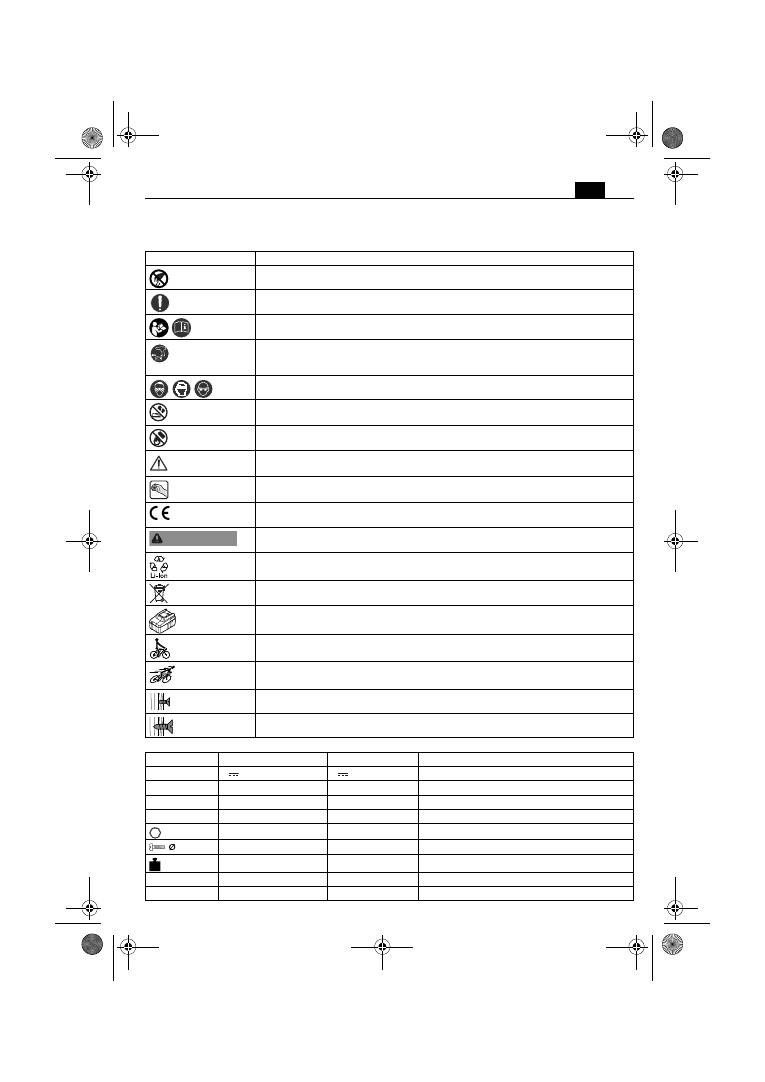
27
es
es
Manual original de atornilladora con acumulador.
Simbología, abreviaturas y términos empleados.
Símbolo
Definición
No tocar las piezas en rotación de la herramienta eléctrica.
¡Seguir las instrucciones indicadas al margen!
Es imprescindible leer los documentos que se adjuntan, como las instrucciones de servicio
y las instrucciones generales de seguridad.
Antes de efectuar el trabajo descrito retire primero el acumulador de la herramienta
eléctrica. De lo contrario, podría accidentarse al ponerse en marcha fortuitamente la
herramienta eléctrica.
Al trabajar protegerse los ojos.
No cargue baterías defectuosas.
No exponga el acumulador al fuego. Proteja el acumulador del calor, p. ej., de una expo-
sición prolongada al sol.
¡Seguir las instrucciones indicadas al margen!
Área de agarre
Atestigua la conformidad de la herramienta eléctrica con las directivas de la Comunidad
Europea.
Este símbolo advierte sobre una situación peligrosa que puede comportar lesiones graves
o mortales.
Símbolo de reciclaje: identifica los materiales reutilizables
Acumular por separado las herramientas eléctricas y demás productos electrotécnicos y
eléctricos inservibles y someterlos a un reciclaje ecológico.
Tipo de acumulador
Bajas revoluciones
Altas revoluciones
Reducción del par de apriete
Aumento del par de apriete
Símbolo
Unidad internacional
Unidad nacional
Definición
U
V
V
Tensión continua
n
0
/min, min
-1
, rpm, r/min
rpm
Revoluciones en vacío
n
1
/min, min
-1
, rpm, r/min
rpm
Revoluciones bajo carga
M...
Nm
Nm
Par de giro (unión atornillada rígida/blanda)
inch
Pulgada
Portaútiles con hexágono interior
mm
mm
Diámetro del tornillo
kg
kg
Peso según EPTA-Procedure 01/2003
L
pA
dB
dB
Nivel de presión sonora
L
wA
dB
dB
Nivel de potencia acústica
ADVERTENCIA
OBJ_BUCH-0000000072-001.book Page 27 Monday, June 18, 2012 8:40 AM

28
es
Para su seguridad.
Lea íntegramente estas adverten-
cias de peligro e instrucciones.
En
caso de no atenerse a las advertencias de seguridad
siguientes, ello puede ocasionar una descarga eléctrica, un
incendio y/o lesión grave.
Guardar todas las advertencias de peligro e instrucciones
para futuras consultas.
No utilice esta herramienta eléctrica sin haber leído
con detenimiento y haber entendido íntegramente
estas instrucciones de servicio, así como las “Ins-
trucciones generales de seguridad” (nº de documento
3 41 30 054 06 1) adjuntas. Guarde la documentación
citada para posteriores consultas y entrégueselas al usua-
rio en caso de prestar o vender la herramienta eléctrica.
Observe también las respectivas prescripciones contra
accidentes de trabajo vigentes en su país.
Utilización reglamentaria de la herramienta eléc-
trica:
atornilladora portátil especialmente desarrollada para
atornillar y aflojar en lugares cubiertos tornillos de mon-
taje rápido en aplicaciones para la construcción interior
con útiles y accesorios homologados por FEIN.
Instrucciones de seguridad especiales.
Sujete la herramienta eléctrica por las superficies de
agarre aisladas al realizar trabajos en los que el tornillo
pueda llegar a tocar conductores eléctricos ocultos.
El
contacto con conductores bajo tensión puede hacer que
las partes metálicas del aparato le provoquen una des-
carga eléctrica.
Preste atención a los conductores eléctricos y a las tube-
rías de agua y gas ocultas.
Antes de comenzar a trabajar
explore la zona de trabajo, p. ej., con un detector de
metales.
Asegure la pieza de trabajo.
Una pieza de trabajo queda
sujeta de forma mucho más segura con un dispositivo de
fijación que con la mano.
Sujete firmemente la herramienta eléctrica.
Pueden pre-
sentarse súbitamente unos altos pares de reacción.
No trabaje materiales que contengan amianto.
El amianto
es cancerígeno.
Esta prohibido fijar rótulos o señales a la herramienta
eléctrica con tornillos o remaches.
Un aislamiento daña-
do no le protege de una electrocución. Emplee etiquetas
autoadhesivas.
No use accesorios que no hayan sido especialmente
desarrollados u homologados por el fabricante de la
herramienta eléctrica.
El mero hecho de que sea monta-
ble un accesorio en su herramienta eléctrica no es garan-
tía de que su funcionamiento sea seguro.
Utilización y trato de acumuladores
(conjunto acumulador)
Para no exponerse a un riesgo de quemadura, incendio,
explosión, lesiones de la piel o de otro tipo, al manipular
acumuladores, aténgase a las siguientes indicaciones:
Los acumuladores no deben desarmarse, abrirse, ni frac-
cionarse. Evite golpear los acumuladores.
Si el acumula-
dor se daña o usa de forma inapropiada puede que se
emanen vapores nocivos o se fugue líquido. Los vapores
pueden irritar las vías respiratorias. El líquido del acumu-
lador puede irritar la piel o producir quemaduras.
Si el líquido que se ha fugado del acumulador ha conta-
minado las piezas adyacentes, controle dichas piezas y
límpielas o sustitúyalas, si procede.
No exponga el acumulador ni al calor ni al fuego. No
exponga el acumulador directamente al sol.
Únicamente saque el acumulador del embalaje original
en el momento que desee utilizarlo.
Desmonte el acumulador antes de manipular en la herra-
mienta eléctrica.
La puesta en marcha fortuita de la herra-
mienta eléctrica puede causar un accidente.
Solamente desmonte el acumulador estando desconec-
tada la herramienta eléctrica.
Mantenga los acumuladores fuera del alcance de los
niños.
Mantenga limpio el acumulador y protéjalo de la hume-
dad y del agua.
Si los contactos del acumulador y de la
herramienta eléctrica están sucios límpielos con un paño
seco y limpio.
Solamente use los acumuladores originales FEIN previs-
tos para su herramienta eléctrica.
Si se utilizan o recar-
gan acumuladores incorrectos, dañados, reparados,
recuperados, imitaciones o de otra marca, existe el riesgo
de incendio y/o de explosión.
Aténgase a las instrucciones de seguridad mencionadas
en las instrucciones de uso del cargador del acumulador.
Vibraciones en la mano/brazo
El nivel de vibraciones indicado en estas instrucciones ha
sido determinado según el procedimiento de medición
fijado en la norma EN 60745 y puede servir como base
de comparación con otras herramientas eléctricas. Tam-
bién es adecuado para estimar provisionalmente la emi-
sión de vibraciones.
L
pCpeak
dB
dB
Valor máx. de nivel sonoro
K...
Inseguridad
m/s
2
m/s
2
Valor de vibraciones emitidas según EN 60745
(suma vectorial de tres direcciones)
h
m/s
2
m/s
2
Nivel de vibraciones generadas (atornillado)
m, s, kg, A, mm, V,
W, Hz, N, °C, dB,
min, m/s
2
m, s, kg, A, mm, V,
W, Hz, N, °C, dB,
min, m/s
2
Unidades básicas y unidades derivadas del sistema
internacional de unidades
SI
.
Símbolo
Unidad internacional
Unidad nacional
Definición
ADVERTENCIA
OBJ_BUCH-0000000072-001.book Page 28 Monday, June 18, 2012 8:40 AM

29
es
El nivel de vibraciones indicado ha sido determinado para
las aplicaciones principales de la herramienta eléctrica.
Por ello, el nivel de vibraciones puede ser diferente si la
herramienta eléctrica se utiliza en otras aplicaciones, con
útiles diferentes, o si el mantenimiento de la misma fuese
deficiente. Ello puede suponer un aumento drástico de la
emisión de vibraciones durante el tiempo total de trabajo.
Para determinar con exactitud la emisión de las vibracio-
nes, es necesario considerar también aquellos tiempos en
los que el aparato esté desconectado, o bien, esté en fun-
cionamiento, pero sin ser utilizado realmente. Ello puede
suponer una disminución drástica de la emisión de vibra-
ciones durante el tiempo total de trabajo.
Fije unas medidas de seguridad adicionales para proteger
al usuario de los efectos por vibraciones, como por ejem-
plo: Mantenimiento de la herramienta eléctrica y de los
útiles, conservar calientes las manos, organización de las
secuencias de trabajo.
Indicaciones para el manejo.
Únicamente accione el selector del sentido de giro con el
motor detenido.
Coloque el selector de sentido de giro en la posición cen-
tral para evitar una puesta en marcha accidental, p. ej.,
durante el transporte.
En caso de sobrecalentamiento la herramienta eléctrica
funciona a impulsos breves de baja potencia. Deje funcio-
nar en vacío la herramienta eléctrica para que se enfríe.
ASCT14/ASCT14M/ASCT18/ASCT18M:
Los trabajos de
atornillado deberán llevarse a cabo utilizando el tope de
profundidad.
ASCT14M/ASCT14UM/ASCT18M/ASCT18UM:
El cargador
de tornillos solamente deberá operarse en la posición
“Sentido de giro a derechas”.
Ajuste del par de giro (ASCT14U/ASCT14UM/
ASCT18U/ASCT18UM) (ver página 7).
El ajuste de fábrica corresponde al margen para tornillos
pequeños a medianos.
El par de apriete alcanzado depende además de la fuerza
de aplicación con la que es presionada la herramienta
eléctrica contra el tornillo.
Trato del acumulador.
Únicamente utilice y cargue el acumulador si su tempera-
tura se encuentra dentro del margen de operación de
0 °C – 45 °C (32 °F – 113 °F). Al comenzar a cargar el acu-
mulador su temperatura deberá estar dentro del margen
especificado para su operación.
El porcentaje del estado de carga real del acumulador
solamente se indica estando detenido el motor de la
herramienta eléctrica.
Antes de que el acumulador llegue a descargarse excesi-
vamente, el sistema electrónico desconecta el motor de
forma automática.
Reparación y servicio técnico.
En caso de trabajar metales bajo unas condicio-
nes extremas puede llegar a depositarse polvo
conductor de corriente en el interior de la
herramienta eléctrica. Sople con frecuencia desde afuera
aire comprimido seco y exento de aceite por las rejillas
de refrigeración para limpiar el interior de la herramienta
eléctrica.
La lista de piezas de refacción actual para esta herramienta
eléctrica la encuentra en internet bajo www.fein.com.
Si fuese preciso, puede sustituir Ud. mismo las piezas
siguientes:
Útiles, tope de profundidad, acumulador,
enganche para andamios, cargador
Garantía.
La garantía del producto se realiza de acuerdo a las regu-
laciones legales vigentes en el país de adquisición. Adicio-
nalmente, FEIN ofrece una garantía ampliada de acuerdo
con la declaración de garantía del fabricante FEIN.
El material de serie suministrado con su herramienta eléc-
trica puede que no corresponda en su totalidad al mate-
rial descrito o mostrado en estas instrucciones de
servicio.
Declaración de conformidad.
La empresa FEIN declara bajo su propia responsabilidad
que este producto cumple con las disposiciones pertinen-
tes detalladas en la última página de estas instrucciones de
servicio.
Expediente técnico en: C. & E. FEIN GmbH, C-DB_IA,
D-73529 Schwäbisch Gmünd
Protección del medio ambiente,
eliminación.
Los embalajes, y las herramientas eléctricas y accesorios
inservibles deberán entregarse a los puntos de recogida
correspondientes para que puedan ser sometidos a un
reciclaje ecológico.
Únicamente entregue acumuladores que estén descarga-
dos a un punto de recogida regularizado.
Si los acumuladores no estuviesen totalmente descarga-
dos aisle sus contactos con cinta adhesiva para prevenir
un posible cortocircuito.
Indicador
LED
Significado
Acción
1 – 4 LED
verdes
Nivel porcen-
tual de carga
Operación
Luz roja
permanente
Acumulador
casi vacío
Cargar acumulador
Luz roja
intermi-
tente
El acumulador
no está listo
para funcionar
Procure que la tempera-
tura del acumulador se
encuentre dentro del
margen de operación, y
cárguelo a continuación
OBJ_BUCH-0000000072-001.book Page 29 Monday, June 18, 2012 8:40 AM
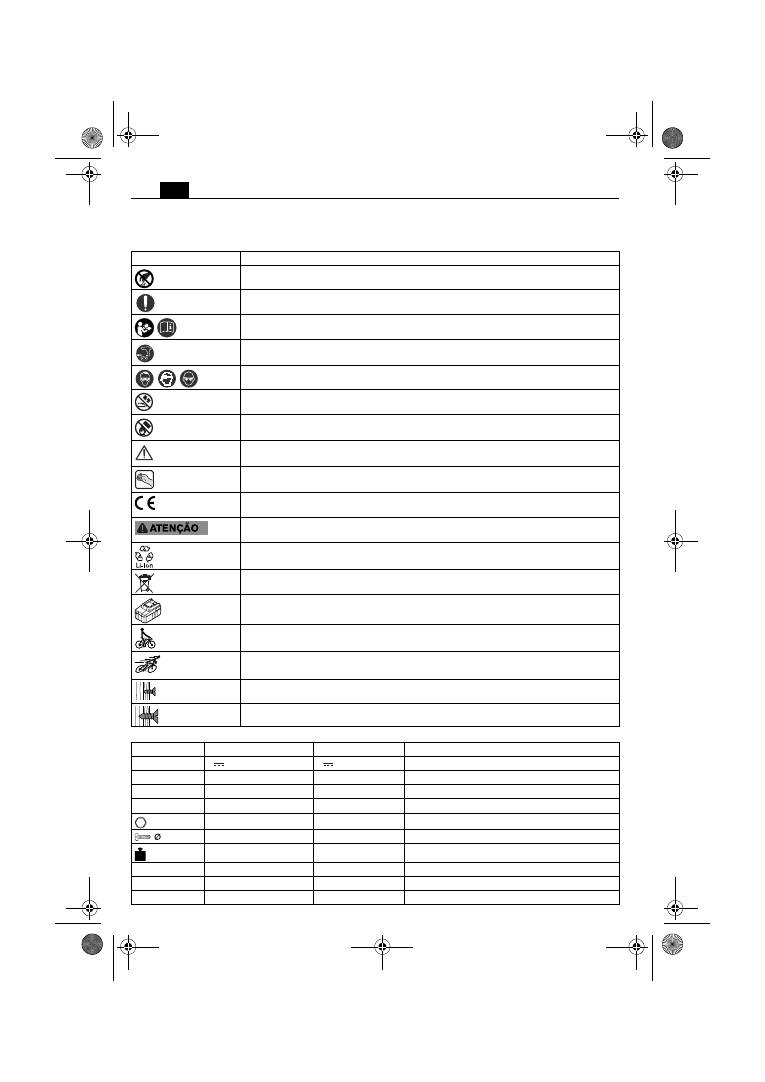
30
pt
pt
Instrução de serviço original da aparafusadora sem fio.
Símbolos utilizados, abreviações e termos.
Símbolo, sinal
Explicação
Não entrar em contacto com as peças em rotação da ferramenta eléctrica.
Trabalhar de acordo com as indicações dos textos ou dos gráficos ao lado!
É imprescindível ler os documentos em anexo, portanto a instrução de serviço e as indi-
cações gerais de segurança.
Remover o acumulador da ferramenta eléctrica antes desta etapa de trabalho. Caso con-
trário, há risco de lesões, devido a um arranque involuntário da ferramenta eléctrica.
Usar protecção para os olhos durante o trabalho.
Não carregar acumuladores danificados.
Não expor o acumulador ao fogo. Proteger o acumulador contra calor, p.ex. também con-
tra uma permanente radiação solar.
Observar as notas no texto adjacente!
Superfície de preensão
Autentica a conformidade da ferramenta eléctrica em relação às directivas da Comunidade
Européia.
Esta nota indica uma situação possivelmente perigosa, que pode levar a graves lesões ou
até à morte.
Símbolo de reciclagem: Materiais marcados como reutilizáveis
Ferramentas eléctricas velhas e outros produtos electrotécnicos e eléctricos devem ser
separados e reciclados de forma ecológica.
Tipo de acumulador
Pequeno n° de rotações
Grande n° de rotações
Reduzir o binário
Aumentar o binário
Sinal
Unidade internacional
Unidade nacional
Explicação
U
V
V
Tensão eléctrica contínua
n
0
/min, min
-1
, rpm, r/min
rpm
Número de rotações em vazio
n
1
/min, min
-1
, rpm, r/min
rpm
Velocidade de rotação em carga
M...
Nm
Nm
Binário (Aparafusamento duro/suave)
inch
polegadas
Fixação da ferramenta Sextavado interior
mm
mm
Diâmetro do parafuso
kg
kg
Peso conforme EPTA-Procedure 01/2003
L
pA
dB
dB
Nível de pressão acústica
L
wA
dB
dB
Nível da potência acústica
L
pCpeak
dB
dB
Máximo nível de pressão acústica
OBJ_BUCH-0000000072-001.book Page 30 Monday, June 18, 2012 8:40 AM
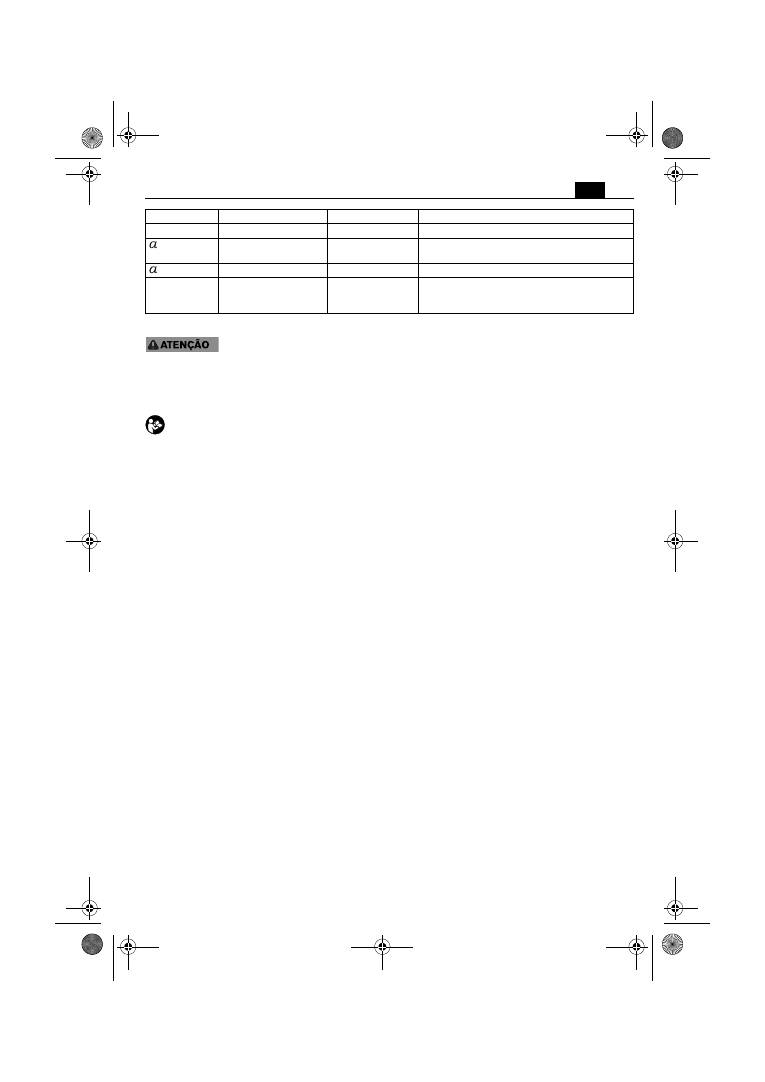
31
pt
Para a sua segurança.
Devem ser lidas todas as indicações
de advertência e todas as instruções.
O desrespeito às advertências e instruções apresentadas
abaixo pode causar choque eléctrico, incêndio e/ou gra-
ves lesões.
Guarde bem todas as advertências e instruções para
futura referência.
Não utilizar esta ferramenta eléctrica antes de ter
lido atentamente e compreendido a Instrução de
serviço e as “Indicações gerais de segurança”
(número de documento 3 41 30 054 06 1) fornecidas
com o aparelho. A documentação mencionada deve ser
guardada para futura referência e deve ser entregue com
a ferramenta eléctrica caso esta for passada a diante ou
vendida.
Observar também as respectivas directivas de protecção
de trabalho.
Finalidade da ferramenta:
aparafusadora manual para atarraxar e desatarraxar para-
fusos, especial para a aplicação em construções a seco,
com parafusos para construção a seco, com ferramentas
de trabalho e acessórios homologados pela FEIN, em áre-
as protegidas contra intempéries.
Indicações especiais de segurança.
Tenere l’apparecchio per le superfici isolate dell’impug-
natura qualora venissero effettuati lavori durante i quali
la vite potrebbe venire a contatto con cavi elettrici nas-
costi.
O contacto com um cabo sob tensão também pode
colocar sob tensão as peças metálicas do aparelho e levar
a um choque eléctrico.
Tenha atenção com cabos eléctricos, tubos de gás e de
água escondidos.
Controlar a área de trabalho com p. ex.
um detector de metal, antes de iniciar o trabalho.
Fixar a peça a ser trabalhada.
Uma peça a ser trabalhada
fixa através de um dispositivo de fixação está mais firme
do que segurado com as mãos.
Segurar a ferramenta eléctrica com firmeza.
Podem
ocorrer por instantes altos momentos de reacção.
Não processar material que contenha asbesto.
Asbesto é
considerado como sendo cancerígeno.
É proibido aparafusar ou rebitar placas e símbolos na fer-
ramenta eléctrica.
Um isolamento danificado não ofe-
rece qualquer protecção contra choques eléctricos.
Utilizar placas adesivas.
Não utilizar acessórios que não foram especialmente
desenvolvidos ou homologados pelo fabricante da ferra-
menta eléctrica.
Um funcionamento seguro não é asse-
gurado apenas por um acessório apropriado para a sua
ferramenta eléctrica.
Utilização e tratamento do acumulador (bloco de
acumulador)
Para evitar perigos como queimaduras, incêndio, explo-
são, lesões na pele e outras lesões durante o manuseio
do acumulador, devem ser observados as seguintes indi-
cações:
Os acumuladores não devem ser desmontados, abertos
nem decompostos. Os acumuladores não devem ser
expostos a golpes mecânicos.
Em caso de danos e de uti-
lização incorrecta do acumulador, podem escapar vapo-
res e líquidos nocivos. É possível que os vapores irritem
as vias respiratórias. Líquido do acumulador a escapar
pode levar a irritações da pele ou queimaduras.
Se o líquido que escapa do acumulador danificado entrar
em contacto com objectos que se encontrem por perto,
deverá controlar os devidos objectos e, se necessário,
limpá-los ou substituí-los.
Não expor o acumulador a calor nem a fogo. Não armaze-
nar o acumulador sob directa incidência de raios solares.
Só retirar o acumulador da embalagem original quando
ele for utilizado.
Antes de trabalhos na ferramenta eléctrica, deverá reti-
rar o acumulador da ferramenta eléctrica.
Há risco de
lesões, se a ferramenta eléctrica arrancar involuntaria-
mente.
Só retirar o acumulador com a ferramenta eléctrica des-
ligada.
Mantenha os acumuladores fora do alcance de crianças.
Manter o acumulador limpo e protegido contra humidade
e água.
Limpar as conexões sujas do acumulador e da fer-
ramenta eléctrica com um pano seco e limpo.
Só utilizar acumuladores FEIN originais intactos, destina-
dos para a sua ferramenta eléctrica.
Ao trabalhar ou ao
carregar com acumuladores falsos, danificados, reparados
ou restaurados, imitações e produtos de outras marcas há
perigo de incêndio e/ou de explosão.
Seguir as indicações de segurança que se encontram na
instrução de serviço do carregador do acumulador.
K...
Aceleração
m/s
2
m/s
2
Valor de emissão de oscilações conforme
EN 60745 (soma dos vectores das três direcções)
h
m/s
2
m/s
2
Valor de emissão de vibrações (aparafusar)
m, s, kg, A, mm, V,
W, Hz, N, °C, dB,
min, m/s
2
m, s, kg, A, mm, V,
W, Hz, N, °C, dB,
min, m/s
2
Unidades básicas e deduzidas do sistema de unida-
des internacional
SI
.
Sinal
Unidade internacional
Unidade nacional
Explicação
OBJ_BUCH-0000000072-001.book Page 31 Monday, June 18, 2012 8:40 AM

32
pt
Vibração da mão e do braço
O nível de oscilações indicado nestas instruções de servi-
ço foi medido de acordo com um processo de medição
normalizado pela norma EN 60745 e pode ser utilizado
para a comparação de aparelhos. Ele também é apro-
priado para uma avaliação preliminar da carga de vibra-
ções.
O nível de vibrações indicado representa as aplicações
principais da ferramenta eléctrica. Se a ferramenta eléctri-
ca for utilizada para outras aplicações, com outras ferra-
mentas de trabalho ou com manutenção insuficiente, é
possível que o nível de vibrações seja diferente. Isto pode
aumentar nitidamente o impacto de vibrações durante o
completo período de trabalho.
Para uma avaliação exacta do impacto de vibrações, tam-
bém deveriam ser considerados os períodos nos quais o
aparelho está desligado ou funciona sem estar realmente
a ser empregado. Isto pode reduzir nitidamente o
impacto de vibrações durante o completo período de tra-
balho.
Como medidas de segurança adicionais para a protecção
do operador contra o efeito das vibrações, deveria deter-
minar por exemplo: Manutenção de ferramentas eléctri-
cas e de ferramentas de trabalho, manter as mãos quentes
e organização dos processos de trabalho.
Instruções de serviço.
Só accionar o comutador do sentido de rotação com o
motor parado.
Colocar o comutador do sentido de rotação na posição
central, para evitar uma colocação em funcionamento
involuntária, por exemplo durante o transporte.
Em caso de sobrecarga, a ferramenta eléctrica funciona
com curtos impulsos de pouca potência. Deixar a ferra-
menta eléctrica funcionar na marcha em vazio.
ASCT14/ASCT14M/ASCT18/ASCT18M:
Os aparafusamen-
tos devem ser realizados com o limitador de profundi-
dade montado.
ASCT14M/ASCT14UM/ASCT18M/ASCT18UM:
O magazine
de aparafusamento só deve ser operado na posição “Sen-
tido de rotação à direita”.
Ajustar o binário (ASCT14U/ASCT14UM/ASCT18U/
ASCT18UM) (veja página 7).
O ajuste de fábrica corresponde à faixa para parafusos
pequenos a médios.
O binário de aperto também depende da força com a qual
a ferramenta eléctrica é pressionada contra o parafuso.
Manuseio com o acumulador.
O acumulador só deve ser utilizado e carregado numa
faixa de temperatura operacional de 0 °C – 45 °C (32 °F –
113 °F). Antes do processo de carga é necessário que a
temperatura do acumulador esteja na faixa de tempera-
tura operacional do acumulador.
O verdadeiro porcentual do estado de carga do acumula-
dor só é indicado quando o motor da ferramenta electrica
está parado.
Se houver uma descarga total do acumulador, a electró-
nica pára automaticamente o motor.
Manutenção e serviço pós-venda.
No caso de aplicações extremas, é possível que
durante o processamento de metais se depo-
site pó condutivo no interior da ferramenta
eléctrica. Soprar frequentemente o interior da ferra-
menta eléctrica, pelas aberturas de ventilação, com ar
comprimido seco e livre de óleo.
A actual lista de peças sobressalentes desta ferramenta
eléctrica se encontra na internet em www.fein.com.
As seguintes peças podem ser substituídas pelo utente:
Ferramentas de trabalho, limitador de profundidade, acu-
mulador, gancho para andaimes, cartucho
Garantia de evicção e garantia.
A garantia de evicção para este produto é válida con-
forme as regras legais no país onde é colocado em funcio-
namento. Além disso, a FEIN oferece uma garantia
conforme a declaração de garantia do fabricante FEIN.
É possível que o volume de fornecimento da sua ferra-
menta eléctrica só contenha uma parte dos acessórios
descritos ou ilustrados nesta instrução de serviço.
Declaração de conformidade.
A firma FEIN declara, em responsabilidade exclusiva, que
este produto corresponde às respectivas especificações
indicadas na última página desta instrução de serviço.
Documentação técnica em: C. & E. FEIN GmbH,
C-DB_IA, D-73529 Schwäbisch Gmünd
Protecção do meio ambiente, eliminação.
Embalagens, ferramentas eléctricas a serem deitadas fora
e acessórios velhos devem ser encaminhados a uma reci-
clagem ecológica.
Os acumuladores só devem ser eliminados correcta-
mente se estiverem completamente descarregados.
No caso de acumuladores que não estiverem completa-
mente descarregados, os contactos deverão ser isolados
preventivamente com fitas adesivas de modo que não
ocorram curto-circuitos.
Indicação LED
Significado
Ação
1 – 4 LEDs
verdes
Estado de
carga por-
centual
Funcionamento
Luz contínua
vermelha
O acumula-
dor está
quase vazio
Carregar o acumulador
Luz vermelha
intermitente
O acumula-
dor não está
pronto para
funcionar
O acumulador deve
estar na sua faixa de
temperatura operacio-
nal antes de ser carre-
gado
OBJ_BUCH-0000000072-001.book Page 32 Monday, June 18, 2012 8:40 AM

33
el
el
Πρωτότυπες οδηγίες χρήσης, μπουλονόκλειδο μπαταρίας.
Σύμβολα που χρησιμοποιούνται, συντμήσεις και όροι.
Σύμβολο, χαρακτήρας
Ερμηνεία
Μην αγγίζετε τα περιστρεφόμενα μέρη του ηλεκτρικού εργαλείου.
Ακολουθήστε τις οδηγίες στο διπλανό κείμενο ή στα γραφικά!
Να διαβάσετε οπωσδήποτε τα συνημμένα έγγραφα, τις οδηγίες χρήσης και τις
υποδείξεις ασφαλείας.
Αφαιρέστε την μπαταρία από το ηλεκτρικό εργαλείο πριν εκτελέσετε αυτό το βήμα
εργασίας. Διαφορετικά δημιουργείται κίνδυνος τραυματισμού από μια ενδεχόμενη
κατά λάθος εκκίνηση του ηλεκτρικού εργαλείου.
Φοράτε προστατευτικά γυαλιά κατά τη διάρκεια της εργασίας σας.
Μην φορτίσετε χαλασμένες μπαταρίες.
Μην εκθέσετε την μπαταρία σε φωτιά. Να προστατεύετε την μπαταρία από υψηλές
θερμοκρασίας, π.χ. ακόμη και από συνεχή ηλιακή ακτινοβολία.
Προσέξτε τις υποδείξεις στο διπλανό κείμενο!
Επιφάνεια συγκράτησης
Βεβαιώνει τη συμμόρφωση του ηλεκτρικού εργαλείου με τις οδηγίες της
Ευρωπαϊκής Κοινότητας.
Η υπόδειξη αυτή επισημαίνει μια πιθανή επικίνδυνη κατάσταση που μπορεί να
οδηγήσει σε σοβαρούς τραυματισμούς ή στο θάνατο.
Χαρακτηριστικό ανακύκλωσης: Χαρακτηρίζει ανακυκλώσιμα υλικά
Άχρηστα ηλεκτρικά εργαλεία και άλλα ηλεκτροτεχνικά και ηλεκτρικά προϊόντα
πρέπει να συλλέγονται ξεχωριστά και να ανακυκλώνονται με τρόπο φιλικό προς το
περιβάλλον.
Τύπος μπαταρίας
Μικρός αριθμός στροφών
Μεγάλος αριθμός στροφών
Μείωση ροπής στρέψης
Αύξηση ροπής στρέψης
Χαρακτήρας
Διεθνής μονάδα
Εθνική μονάδα
Ερμηνεία
U
V
V
συνεχής ηλεκτρική τάση
n
0
/min, min
-1
, rpm, r/min
min
-1
Αριθμός στροφών χωρίς φορτίο
n
1
/min, min
-1
, rpm, r/min
min
-1
Αριθμός στροφών υπό φορτίο
M...
Nm
Nm
Ροπή στρέψης (περίπτωση σκληρού/μαλακού
βιδώματος)
inch
inch
Υποδοχή εργαλείου εσωτερικό εξάγωνο
mm
mm
Διάμετρος βιδών
kg
kg
Βάρος σύμφωνα με EPTA-Procedure 01/2003
L
pA
dB
dB
Στάθμη ακουστικής πίεσης
OBJ_BUCH-0000000072-001.book Page 33 Monday, June 18, 2012 8:40 AM

34
el
Για την ασφάλειά σας.
Διαβάστε όλες τις υποδείξεις
ασφαλείας και τις οδηγίες.
Αμέλειες
κατά την τήρηση των προειδοποιητικών υποδείξεων
και οδηγιών μπορεί να προκαλέσουν ηλεκτροπληξία,
πυρκαγιά ή/και σοβαρούς τραυματισμούς.
Φυλάξτε όλες τις προειδοποιητικές υποδείξεις και οδηγίες
για κάθε μελλοντική χρήση.
Να μην χρησιμοποιήσετε το παρόν ηλεκτρικό
εργαλείο πριν διαβάσετε επιμελώς και
κατανοήσετε αυτές οδηγίες χρήσης καθώς και
τις συνημμένες «Γενικές υποδείξεις ασφαλείας»
(Αριθμός εγγράφου 3 41 30 054 06 1). Να
διαφυλάξετε τα παραπάνω έγγραφα για κάθε
ενδεχόμενη μελλοντική χρήση και να τα επισυνάψετε
στο ηλεκτρικό εργαλείο όταν το παραδώσετε ή το
πουλήσετε σε τρίτο άτομο.
Να τηρείτε επίσης και τις σχετικές εθνικές διατάξεις
για την προστασία της εργασίας.
Προορισμός του ηλεκτρικού εργαλείου:
με το χέρι οδηγούμενο μπουλονόκλειδο για χρήση με
εργαλεία και εξαρτήματα εγκριμένα από τη FEIN για
το βίδωμα και το ξεβίδωμα βιδών, ιδιαίτερα για
χρήση στις ξηρές κατασκευές με βίδες ταχείας
στερέωσης, σε περιβάλλον μη εκτεθειμένο στις
καιρικές συνθήκες.
Ειδικές υποδείξεις ασφαλείας.
Να πιάνετε τη συσκευή από τις μονωμένες επιφάνειες
πιασίματος όταν διεξάγετε εργασίες κατά τις οποίες
υπάρχει κίνδυνος η βίδα να έρθει σε επαφή με μη ορατούς
ηλεκτροφόρους αγωγούς.
Η επαφή με έναν
ηλεκτροφόρο αγωγό μπορεί να θέσει τα μεταλλικά
μέρη της συσκευής επίσης υπό τάση και να
προκαλέσει έτσι ηλεκτροπληξία.
Να προσέχετε μήπως υπάρχουν μη ορατοί ηλεκτρικοί
αγωγοί και σωλήνες φωταερίου (γκαζιού) ή νερού.
Πριν
αρχίσετε την εργασία σας ελέγξτε την περιοχή που
πρόκειται να εργαστείτε π. χ. με μια συσκευή
εντοπισμού μετάλλων.
Ασφαλίζετε το υπό κατεργασία τεμάχιο.
Ένα υπό
κατεργασία τεμάχιο που στερεώνεται με τη βοήθεια
μιας διάταξης σύσφιξης είναι στερεωμένο με
μεγαλύτερη ασφάλεια από ένα που συγκρατείται με το
χέρι.
Να κρατάτε γερά το ηλεκτρικό εργαλείο.
Μπορεί να
εμφανιστούν απότομες αντιδραστικές ροπές.
Μην κατεργάζεστε υλικά που περιέχουν αμίαντο.
Το
αμίαντο θεωρείται σαν καρκινογόνο υλικό.
Απαγορεύεται το πριτσίνωμα ή/και το βίδωμα πινακίδων και
συμβόλων επάνω στο ηλεκτρικό εργαλείο.
Μια τυχόν
χαλασμένη μόνωση δεν προσφέρει πλέον καμιά
προστασία κατά της ηλεκτροπληξίας.
Χρησιμοποιείτε αυτοκόλλητες πινακίδες.
Μη χρησιμοποιήσετε ποτέ εξαρτήματα που δεν έχουν
εξελιχτεί ή εγκριθεί από τον κατασκευαστή του
ηλεκτρικού εργαλείου ειδικά γι΄ αυτό.
Η ασφαλής
λειτουργία δεν εξασφαλίζεται μόνο και μόνο επειδή
ένα εξάρτημα ταιριάζει στο ηλεκτρικό σας εργαλείο.
Χρήση και μεταχείριση της μπαταρίας (του μπλοκ
μπαταριών)
Κατά τη μεταχείριση της μπαταρίας να τηρείτε τις
επόμενες υποδείξεις για να μη ριψοκινδυνέψετε, π.χ.
εγκαύματα, πυρκαγιά, έκρηξη, εκδορές και άλλους
τραυματισμούς:
Δεν επιτρέπεται ο διαμελισμός, το άνοιγμα ή ο τεμαχισμός
των μπαταριών. Να μην εκθέσετε τις μπαταρίες σε
μηχανικές κρούσεις.
Όταν η μπαταρία υποστεί βλάβη
καθώς και όταν χρησιμοποιηθεί αντικανονικά μπορεί
να διαφύγουν βλαβερές αναθυμιάσεις. Οι
αναθυμιάσεις μπορεί να ερεθίσουν τις αναπνευστικές
οδούς. Τυχόν διαρρέοντα υγρά μπαταρίας μπορεί να
προκαλέσουν ερεθισμούς του δέρματος ή εγκαύματα.
Σε περίπτωση που τα διαρρέοντα υγρά της χαλασμένης
μπαταρίας υγράνουν τυχόν γειτονικά αντικείμενα, τότε
ελέγξτε τα αντίστοιχα εξαρτήματα και, αν χρειαστεί,
αντικαταστήστε τα.
Να μην εκθέσετε την μπαταρία σε υψηλές θερμοκρασίες ή
σε φωτιά. Να μην αποθηκεύσετε την μπαταρία υπό άμεση
ηλιακή ακτινοβολία.
Να αφαιρέσετε την μπαταρία από τη συσκευασία του
κατασκευαστή μόνο όταν πρόκειται να την
χρησιμοποιήσετε άμεσα.
Να αφαιρείτε την μπαταρία από το ηλεκτρικό εργαλείο πριν
από οποιαδήποτε εργασία σ’ αυτό.
Δημιουργείται
κίνδυνος τραυματισμών σε περίπτωση που το
ηλεκτρικό εργαλείο μπει κατά λάθος σε λειτουργία.
Να αφαιρείτε την μπαταρία από το ηλεκτρικό εργαλείο
μόνο όταν αυτό είναι απενεργοποιημένο (off).
Να κρατάτε τα παιδιά μακριά από τις μπαταρίες.
L
wA
dB
dB
Στάθμη ακουστικής ισχύος
L
pCpeak
dB
dB
Ύψιστη στάθμη ακουστικής πίεσης
K...
Ανασφάλεια
m/s
2
m/s
2
Τιμή εκπομπής κραδασμών σύμφωνα με
EN 60745 (άθροισμα ανυσμάτων τριών
κατευθύνσεων)
h
m/s
2
m/s
2
Τιμή εκπομπής κραδασμών (βίδωμα)
m, s, kg, A, mm, V,
W, Hz, N, °C, dB,
min, m/s
2
m, s, kg, A, mm, V,
W, Hz, N, °C, dB,
min, m/s
2
Θεμελιώδεις και παράγωγες μονάδες από το
Διεθνές Σύστημα Μονάδων
SI
.
Χαρακτήρας
Διεθνής μονάδα
Εθνική μονάδα
Ερμηνεία
OBJ_BUCH-0000000072-001.book Page 34 Monday, June 18, 2012 8:40 AM
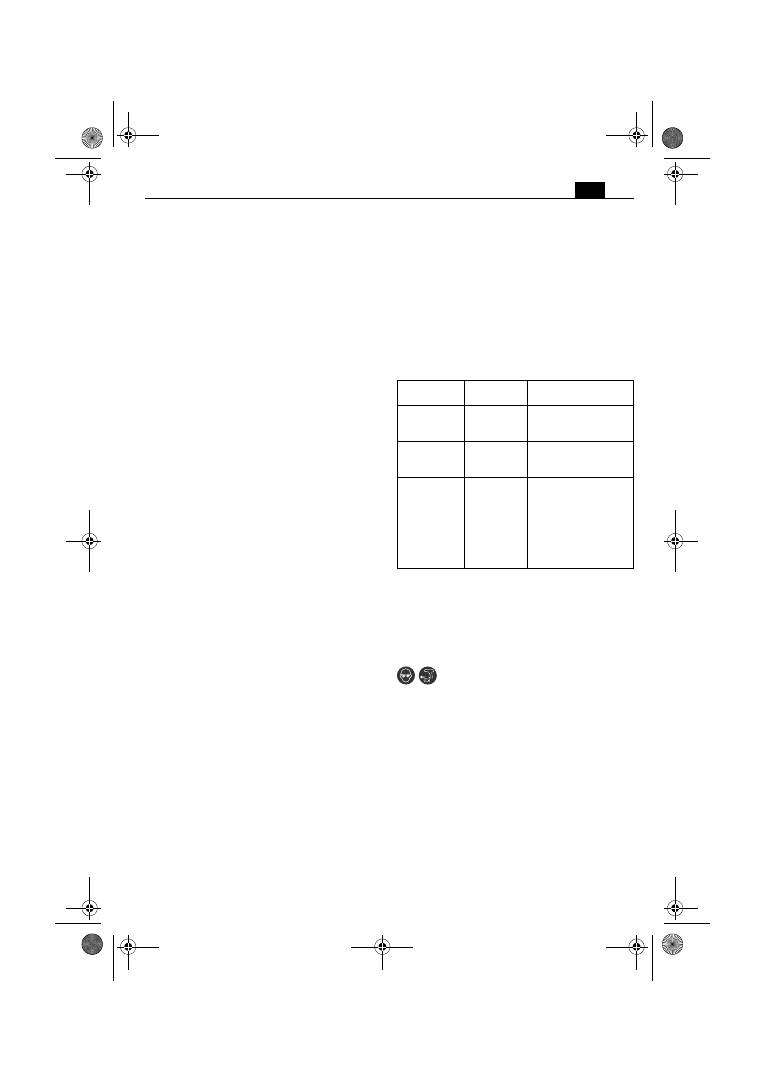
35
el
Να διατηρείτε την μπαταρία καθαρή και να την
προστατεύετε από υγρασία και νερά.
Να καθαρίζετε τις
λερωμένες συνδέσεις της μπαταρίας και του
ηλεκτρικού εργαλείου με ένα στεγνό, καθαρό πανί.
Να χρησιμοποιείτε μόνο αβλαβείς γνήσιες μπαταρίες της
FEIN που προορίζονται για το ηλεκτρικό σας εργαλείο.
Όταν χρησιμοποιήσετε ή φορτώσετε αντικανονικές,
χαλασμένες, επισκευασμένες, μεταποιημένες
μπαταρίες ή μπαταρίες ξένων κατασκευαστών και
απομιμήσεις δημιουργείται κίνδυνος πυρκαγιά ή/και
έκρηξης.
Να τηρείτε τις οδηγίες ασφαλείας στις οδηγίες χρήσης του
φορτιστή της μπαταρίας.
Κραδασμοί χεριού-μπράτσου
Η στάθμη κραδασμών που αναφέρεται σ΄ αυτές τις
οδηγίες έχει μετρηθεί σύμφωνα με μια διαδικασία
μέτρησης τυποποιημένη στο πλαίσιο του προτύπου
EN 60745 και μπορεί να χρησιμοποιηθεί στη
σύγκριση των διάφορων ηλεκτρικών εργαλείων. Είναι
επίσης κατάλληλη για τον προσωρινό υπολογισμό
της επιβάρυνσης από τους κραδασμούς.
Όταν, όμως, το ηλεκτρικό εργαλείο χρησιμοποιηθεί
με εργαλεία και παρελκόμενα που δεν προβλέπονται
γι’ αυτό ή χωρίς να έχει συντηρηθεί επαρκώς, η
στάθμη κραδασμών μπορεί να αποκλίνει. Αυτό μπορεί
να αυξήσει σημαντικά την επιβάρυνση από τους
κραδασμούς κατά τη διάρκεια του συνόλου του
χρονικού διαστήματος της εργασίας.
Για την ακριβή εκτίμηση της επιβάρυνσης από τους
κραδασμούς, κατά τη διάρκεια ενός ορισμένου
χρονικού διαστήματος εργασίας, θα πρέπει να
ληφθούν επίσης υπόψη και οι χρόνοι κατά τη διάρκεια
των οποίων το μηχάνημα βρίσκεται εκτός
λειτουργίας ή λειτουργεί χωρίς όμως στην
πραγματικότητα να χρησιμοποιείται. Αυτό μπορεί να
μειώσει σημαντικά την επιβάρυνση από τους
κραδασμούς κατά τη διάρκεια του συνόλου του
χρονικού διαστήματος της εργασίας.
Να καθορίζετε συμπληρωματικά μέτρα ασφαλείας για
την προστασία του χειριστή/της χειρίστριας από την
επίδραση των κραδασμών, για παράδειγμα:
συντήρηση των ηλεκτρικών εργαλείων και
παρελκομένων, ζέσταμα των χεριών, οργάνωση των
διαδικασιών εργασίας.
Υποδείξεις χειρισμού.
Ο χειρισμός του διακόπτη αλλαγής φοράς
περιστροφής επιτρέπεται μόνο όταν ο κινητήρας δεν
κινείται.
Για να αποφύγετε μια ακούσια εκκίνηση, π.χ. κατά τη
μεταφορά, να θέτετε το διακόπτη αλλαγής φοράς
περιστροφής στη μεσαία θέση.
Σε περίπτωση υπερθέρμανσης το ηλεκτρικό εργαλείο
λειτουργεί με σύντομους, μικρής ισχύος παλμούς.
Αφήστε το ηλεκτρικό εργαλείο να λειτουργήσει χωρίς
φορτίο για να κρυώσει.
ASCT14/ASCT14M/ASCT18/ASCT18M:
Τα βιδώματα
πρέπει να διεξάγονται με συναρμολογημένο τον
οδηγό βάθους.
ASCT14M/ASCT14UM/ASCT18M/ASCT18UM:
Η θήκη
βιδών πρέπει να χρησιμοποιείται μόνο στη θέση για
«δεξιόστροφη κίνηση».
Ρύθμιση ροπής στρέψης (ASCT14U/ASCT14UM/
ASCT18U/ASCT18UM) (βλέπε σελίδα 7).
Η ρύθμιση του κατασκευαστή αντιστοιχεί στην
περιοχή βιδών μικρού έως μέτριου μεγέθους.
Η ροπή σύσφιξης εξαρτάται από τη δύναμη με την
οποία πιέζεται το ηλεκτρικό εργαλείο επάνω στη βίδα.
Μεταχείριση της μπαταρίας.
Να χρησιμοποιείτε και να φορτίζετε την μπαταρία
μόνο εντός της εγκεκριμένης περιοχής θερμοκρασίας
λειτουργίας της μπαταρίας από 0 °C – 45 °C (32 °F –
113 °F). Όταν αρχίζει η φόρτιση η θερμοκρασία της
μπαταρίας πρέπει να βρίσκεται εντός της
εγκεκριμένης περιοχής θερμοκρασίας λειτουργίας
της μπαταρίας.
Η πραγματική ποσοστιαία στάθμη φόρτισης της
μπαταρίας δείχνεται μόνο όταν ο κινητήρας του
ηλεκτρικού εργαλείου είναι σταματημένος.
Όταν επίκειται η πλήρης εκφόρτιση της μπαταρίας η
ηλεκτρονική διακόπτει αυτόματα τη λειτουργία του
κινητήρα.
Συντήρηση και Service.
Υπό εξαιρετικά δυσμενείς συνθήκες
εργασίας μπορεί, όταν κατεργάζεστε
μέταλλα, να σχηματιστεί αγώγιμη σκόνη
στο εσωτερικό του ηλεκτρικού εργαλείου. Να
καθαρίζετε συχνά το εσωτερικό του ηλεκτρικού
εργαλείου με φύσημα ξηρού πεπιεσμένου αέρα χωρίς
λάδια μέσω των σχισμών αερισμού.
Τον τρέχοντα κατάλογο ανταλλακτικών γι’ αυτό το
ηλεκτρικό εργαλείο θα βρείτε στην ηλεκτρονική
σελίδα www.fein.com.
Αν χρειαστεί, μπορείτε να αντικαταστήσετε οι ίδιοι τα
παρακάτω εξαρτήματα:
Εξαρτήματα, οδηγό βάθους,
μπαταρία, γάντζο σκαλωσιάς, θήκη βιδών
Ένδειξη
φωτοδιόδου
Σημασία
Ενέργεια
πράσινες
φωτοδίοδοι
1 – 4
ποσοστιαία
κατάσταση
φόρτισης
Λειτουργία
διαρκές
κόκκινο φως
Η μπαταρία
είναι σχεδόν
άδεια
Φορτίστε την
μπαταρία
κόκκινο
αναβόσβημα
Η μπαταρία
δεν είναι
έτοιμη για
λειτουργία
Αφήστε τη
θερμοκρασία της
μπαταρίας να περιέλθει
στην εγκεκριμένη
περιοχή θερμοκρασίας
λειτουργίας της
μπαταρίας και
ακολούθως φορτίστε
OBJ_BUCH-0000000072-001.book Page 35 Monday, June 18, 2012 8:40 AM
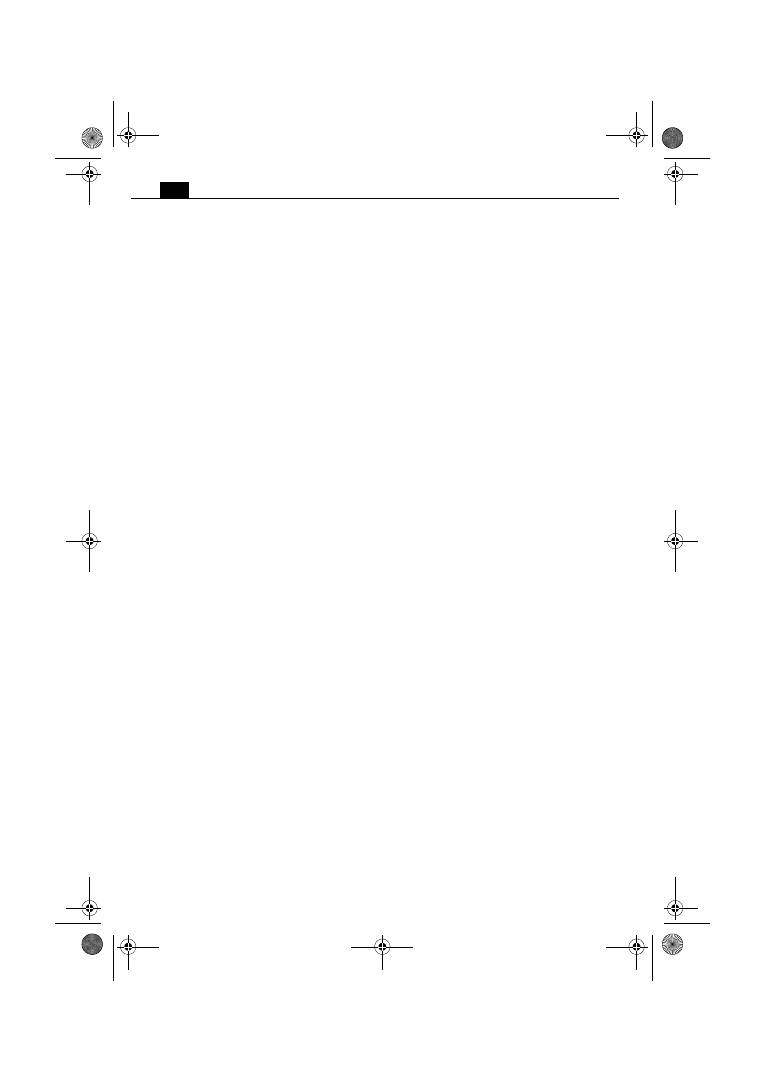
36
el
Εγγύηση.
Η εγγύηση για το προϊόν ισχύει σύμφωνα με τις
νομικές διατάξεις της χώρας στην οποία κυκλοφορεί.
Εκτός αυτού η FEIN σας παρέχει και μια επί πλέον
εγγύηση, ανάλογα με την εκάστοτε δήλωση
κατασκευαστή της FEIN.
Στη συσκευασία του ηλεκτρικού σας εργαλείου
μπορεί να περιέχεται μόνο ένα μέρος των
εξαρτημάτων που περιγράφονται ή απεικονίζονται σ’
αυτές τις οδηγίες χρήσης.
Δήλωση συμμόρφωσης.
Η εταιρία FEIN δηλώνει με αποκλειστική ευθύνη της
ότι αυτό το προϊόν ανταποκρίνεται πλήρως στους
σχετικούς κανονισμούς που αναφέρονται στην
τελευταία σελίδα αυτών των οδηγιών χρήσης.
Τεχνικά έγγραφα από: C. & E. FEIN GmbH, C-DB_IA,
D-73529 Schwäbisch Gmünd
Προστασία του περιβάλλοντος, απόσυρση.
Οι συσκευασίες, τα άχρηστα ηλεκτρικά εργαλεία και
τα εξαρτήματα πρέπει να ανακυκλώνονται με τρόπο
φιλικό προς το περιβάλλον.
Να αποσύρετε κανονικά τις μπαταρίες, μόνο όταν
αυτές είναι εκφορτισμένες.
Όταν οι μπαταρίες δεν είναι τελείως άδειες να τις
προστατεύετε από βραχυκυκλώματα μονώνοντας το
βύσμα με κολλητική ταινία. Διαβάστε όλες τις
προειδοποιητικές υποδείξεις.
OBJ_BUCH-0000000072-001.book Page 36 Monday, June 18, 2012 8:40 AM

37
da
da
Original brugsanvisning akku-skruemaskine.
Anvendte symboler, forkortelser og begreber.
Symbol, tegn
Forklaring
Berør ikke roterende dele på el-værktøjet.
Følg instruktionerne i efterfølgende tekst eller grafik!
Læs ubetinget vedlagte dokumenter som f.eks. brugsanvisning og almindelige sikkerheds-
råd.
Fjern akkuen fra el-værktøjet, før dette arbejdsskridt udføres. Ellers er der fare for kvæ-
stelser som følge af utilsigtet start af el-værktøjet.
Brug øjenbeskyttelse under arbejdet.
Oplad ikke beskadigede akkuer.
Udsæt ikke akkuen for ild. Beskyt akkuen mod varme f.eks. også mod vedvarende solstrå-
ler.
Overhold henvisningerne i teksten ved siden af!
Grebområde
Bekræfter at el-værktøjet er i overensstemmelse med gældende direktiver inden for det
europæiske fællesskab.
Denne henvisning viser en mulig farlig situation, der kan føre til alvorlige kvæstelser evt.
med døden til følge.
Genbrugstegn: Kendetegner materialer, der kan genbruges
Gammelt el-værktøj og andre elektrotekniske og elektriske produkter skal samles og afle-
veres separat til miljøvenlig genbrug.
Akkutype
Lille omdrejningstal
Stort omdrejningstal
Drejningsmoment reduceres
Drejningsmoment øges
Tegn
Enhed international
Enhed national
Forklaring
U
V
V
Elektrisk jævnspænding
n
0
/min, min
-1
, rpm, r/min
/min
Ubelastet omdrejningstal
n
1
/min, min
-1
, rpm, r/min
/min
Omdrejningstal under belastning
M...
Nm
Nm
Drejningsmoment (hårdt/blødt skruearbejde)
inch
inch
Værktøjsholder indvendig sekskant
mm
mm
Skruediameter
kg
kg
Vægt iht. EPTA-Procedure 01/2003
L
pA
dB
dB
Lydtrykniveau
L
wA
dB
dB
Lydeffektniveau
L
pCpeak
dB
dB
Top lydtrykniveau
OBJ_DOKU-0000002202-001.fm Page 37 Wednesday, June 20, 2012 8:06 AM
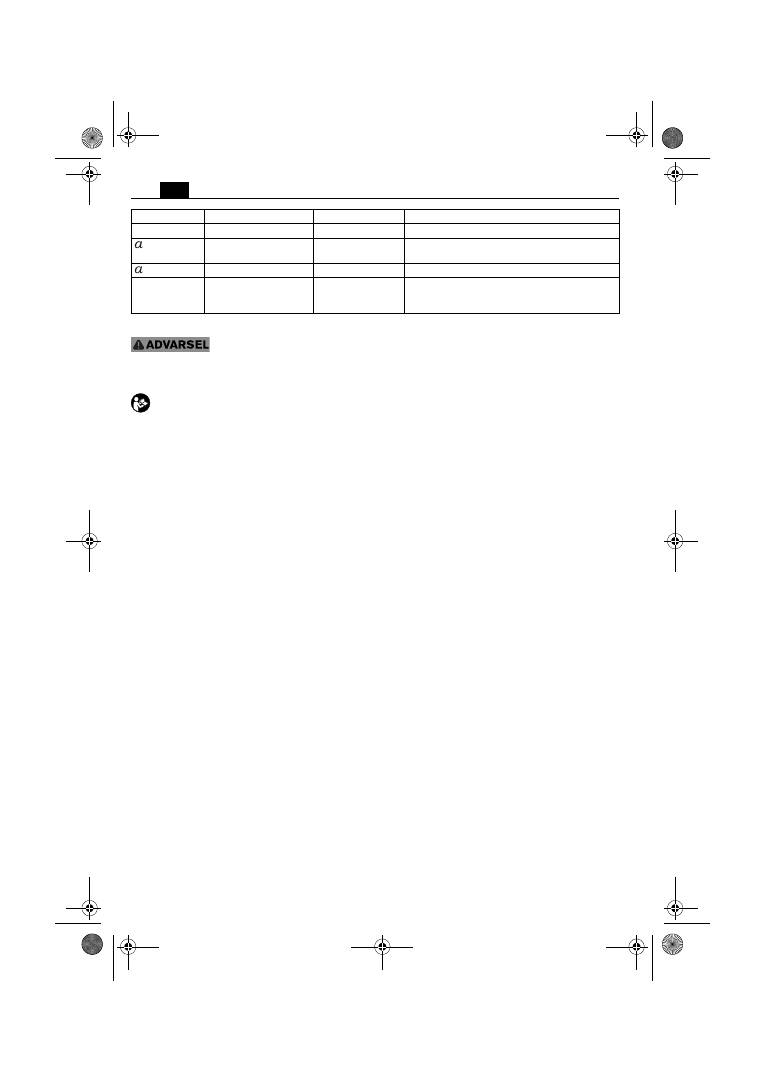
38
da
For din egen sikkerheds skyld.
Læs alle sikkerhedsråd og instruk-
ser.
I tilfælde af manglende overhol-
delse af sikkerhedsråd og instrukserne er der risiko for
elektrisk stød, brand og/eller alvorlige kvæstelser.
Opbevar alle sikkerhedsråd og instrukser til senere brug.
Anvend ikke dette el-værktøj, før du har læst nær-
værende brugsanvisning samt vedlagte „Alminde-
lige sikkerhedsråd“ (skriftnummer
3 41 30 054 06 1) nøje igennem og forstået det hele.
Opbevar nævnte materiale til senere brug og giv det
videre til en evt. ny ejer.
Læs og overhold ligeledes de gældende nationale arbejds-
beskyttende bestemmelser.
El-værktøjets formål:
håndført skruemaskine til iskruning og løsning af skruer,
specielt til brug i forbindelse med gipsarbejde med gips-
pladeskruer, med det af FEIN godkendte tilbehør i vejr-
beskyttede omgivelser.
Specielle sikkerhedsforskrifter.
Hold el-værktøjet i de isolerede gribeflader, når du udfø-
rer arbejde, hvor skruen kan ramme bøjede strømlednin-
ger.
Kontakten med en spændingsførende ledning kan
også sætte metalholdige værktøjsdele under spænding,
hvilket kan føre til elektrisk stød.
Hold øje med skjult liggende elektriske ledninger, gas- og
vandrør.
Kontrollér arbejdsområdet (f.eks. med en metal-
pejler), før arbejdet påbegyndes.
Sikre emnet.
Et emne, der holdes med en spændeanord-
ning, holdes mere sikkert end i hånden.
Hold godt fast i el-værktøjet.
Der kan opstå høje reakti-
onsmomenter for en kort tid.
Sav ikke i asbestholdigt materiale.
Asbest er registreret
som kræftfremkaldende.
Det er forbudt at skrue eller nitte skilte og tegn på el-
værktøjet.
En beskadiget isolering beskytter ikke mod
elektrisk stød. Anvend klæbeetiketter.
Anvend ikke tilbehør, hvis det ikke er udviklet eller frigi-
vet specielt af el-værktøjets fabrikant.
Sikker drift er ikke
kun givet ved, at tilbehøret passer til dit el-værktøj.
Brug og behandling af akkuen (akkublokke)
Overhold følgende henvisninger for at undgå farer som
forbrænding, brand, eksplosion, hudkvæstelser og andre
kvæstelser som følge af håndtering med akkuerne:
Akkuer må ikke skilles ad, åbnes eller hakkes itu. Udsæt
ikke akkuerne for mekaniske stød.
Beskadiges akkuen
eller anvendes den forkert, kan skadelige dampe og
væsker strømme ud. Dampene kan irritere luftvejene.
Udstrømmende akkuvæske kan føre til hudirritation eller
forbrændinger.
Hvis væske strømmer ud af den beskadigede akku og
fugter nærliggende genstande, kontroller da de pågæl-
dende dele, rengør dem eller udskift dem efter behov.
Udsæt ikke akkuen for varme eller ild. Opbevar ikke
akkuen i direkte solstråler.
Tag først akkuen ud af den originale emballage, når den
skal bruges.
Tag akkuen ud af el-værktøjet, før arbejde udføres på el-
værktøjet.
Går el-værktøjet utilsigtet i gang, kan man blive
kvæstet.
Fjern kun akkuen, når el-værktøjet er slukket.
Hold akkuer uden for børns rækkevidde.
Hold akkuen ren og beskyt den mod fugtighed og vand.
Rengør akkuens og el-værktøjets snavsede tilslutninger
med en tør, ren klud.
Brug kun intakte originale FEIN akkuer, der er beregnet til
dit el-værktøj.
Arbejde med og opladning af forkerte,
beskadigede eller reparerede akkuer, efterligninger og
fremmede fabrikater er forbundet med fare for brand
og/eller fare for eksplosion.
Følg sikkerhedsrådene i brugsanvisningen til akku-lade-
ren.
Hånd-arm-vibrationer
Vibrationsniveauet angivet i disse instruktioner er målt
jævnfør en måleprocedure, normeret i EN 60745, og kan
benyttes til indbyrdes sammenligning af el-værktøj. Den
egner sig desuden til en foreløbig vurdering af vibrations-
belastningen.
Det angivne vibrationsniveau repræsenterer el-værktø-
jets vigtigste anvendelsesformer. Men hvis el-værktøjet
benyttes på anden måde med ikke formålsbestemt tilbe-
hør eller ved utilstrækkelig vedligeholdelse, kan vibrati-
onsniveauet afvige. Derved kan vibrationsbelastningen i
hele arbejdsperioden forøges betydeligt.
Ved en nøjagtig vurdering af vibrationsbelastningen bør
der også tages højde for den tid, hvor værktøjet enten er
slukket eller fortsat er tændt, men ikke er i egentlig brug.
Det kan reducere vibrationsbelastningen i hele arbejds-
perioden betydeligt.
Fastlæg yderligere sikkerhedsforanstaltninger til beskyt-
telse af brugeren mod vibrationernes effekt som f.eks.:
Vedligeholdelse af el-værktøj og tilbehør, hold hænderne
varme, organisation af arbejdsprocedurer.
K...
Usikkerhed
m/s
2
m/s
2
Svingningsemissionsværdi iht. EN 60745
(vektorsum for tre retninger)
h
m/s
2
m/s
2
Svingningsemissionsværdi (skruer)
m, s, kg, A, mm, V,
W, Hz, N, °C, dB,
min, m/s
2
m, s, kg, A, mm, V,
W, Hz, N, °C, dB,
min, m/s
2
Basisenheder og afledte enheder fra det internati-
onale enhedssystem
SI
.
Tegn
Enhed international
Enhed national
Forklaring
OBJ_DOKU-0000002202-001.fm Page 38 Wednesday, June 20, 2012 8:06 AM
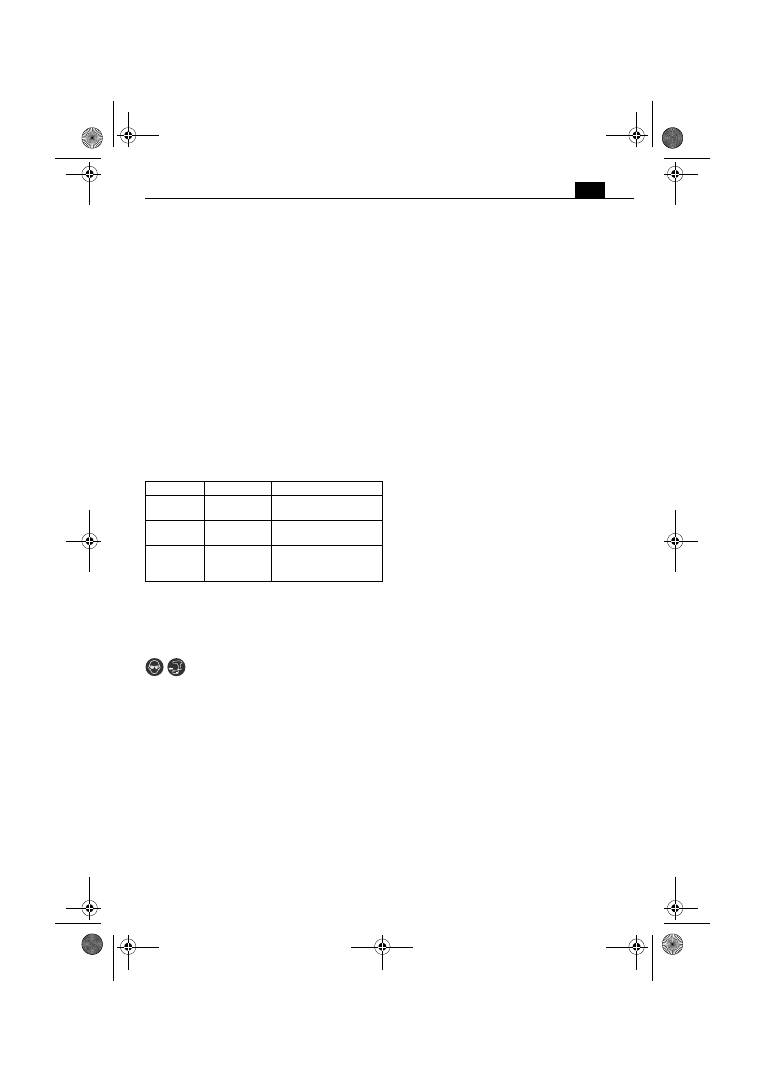
39
da
Betjeningsforskrifter.
Tryk kun på retningsomskifteren, når motoren står stille.
Stil retningsomskifteren i midten for at undgå utilsigtet
ibrugtagning f.eks. under transporten.
Ved overophedning kører el-værktøjet kun med korte,
ydelsesfattige impulser. Lad el-værktøjet afkøle i tom-
gang.
ASCT14/ASCT14M/ASCT18/ASCT18M:
Skruearbejdet skal
udføres med monteret dybdeanslag.
ASCT14M/ASCT14UM/ASCT18M/ASCT18UM:
Skruemaga-
sinet må kun køre i position „Drejeretning højre“.
Drejningsmoment indstilles (ASCT14U/ASCT14UM/
ASCT18U/ASCT18UM) (se side 7).
Fabriksindstillingen svarer til området for små og middel-
store skruer.
Tilspændingsmomentet afhænger også af den kraft, med
hvilken el-værktøjet trykkes mod skruen.
Håntering med akkuen.
Brug og lad kun akkuen i et akku-driftstemperatur-
område mellem 0 °C – 45 °C (32 °F – 113 °F). Akku-
temperaturen skal befinde sig i akku-driftstemperatur-
området, når opladningen går i gang.
Akkuens ægte procentuelle ladetilstand vises kun, når el-
værktøjets motor er stoppet.
Ved en forestående dyb afladning af akkuen stopper elek-
tronikken automatisk motoren.
Vedligeholdelse og kundeservice.
Under ekstreme brugsbetingelser kan bear-
bejdning af metal føre til aflejring af ledende
støv inde i el-værktøjet. Blæs hyppigt den ind-
vendige del af el-værktøjet med tør og oliefri trykluft gen-
nem ventilationsåbningerne.
Den aktuelle reservedelsliste til dette el-værktøj findes på
internettet under www.fein.com.
Følgende dele kan du selv udskifte efter behov:
Tilbehør,
dybdeanslag, akku, stilladskrog, magasin
Mangelsansvar/reklamationsret og
garanti.
Mangelsansvaret/reklamationsretten er fastlagt i de lovbe-
stemmelser, der gælder i det land, hvor maskinen mar-
kedsføres. Derudover yder FEIN garanti iht. FEIN
fabrikantens garantierklæring.
Det kan være, at el-værktøjet kun leveres med en del af
det tilbehør, der beskrives eller illustreres i brugsanvis-
ning.
Overensstemmelseserklæring.
Firmaet FEIN erklærer på eget ansvar, at dette produkt er
i overensstemmelse med de gældende bestemmelser, der
findes på den sidste side i denne brugsanvisning.
Teknisk materiale hos: C. & E. FEIN GmbH, C-DB_IA,
D-73529 Schwäbisch Gmünd
Miljøbeskyttelse, bortskaffelse.
Emballage, udtjent el-værktøj og tilbehør bedes afleveret
til miljøvenlig genbrug.
Akkuer skal være afladet, før de bortskaffes.
Ved ikke fuldstændigt afladede akkuer isoleres stikforbin-
delsen med tape for at beskytte mod kortslutning.
LED-lampe
Betydning
Aktion
1 – 4 grøn
LED-lampe
Procentuel
ladetilstand
Drift
rødt kon-
stant lys
Akku er
næsten tom
Akku lades
rødt blin-
kende lys
Akku er ikke
klar til drift
Akku stilles i akku-drifts-
temperaturområde, her-
efter lades den
OBJ_DOKU-0000002202-001.fm Page 39 Wednesday, June 20, 2012 8:06 AM
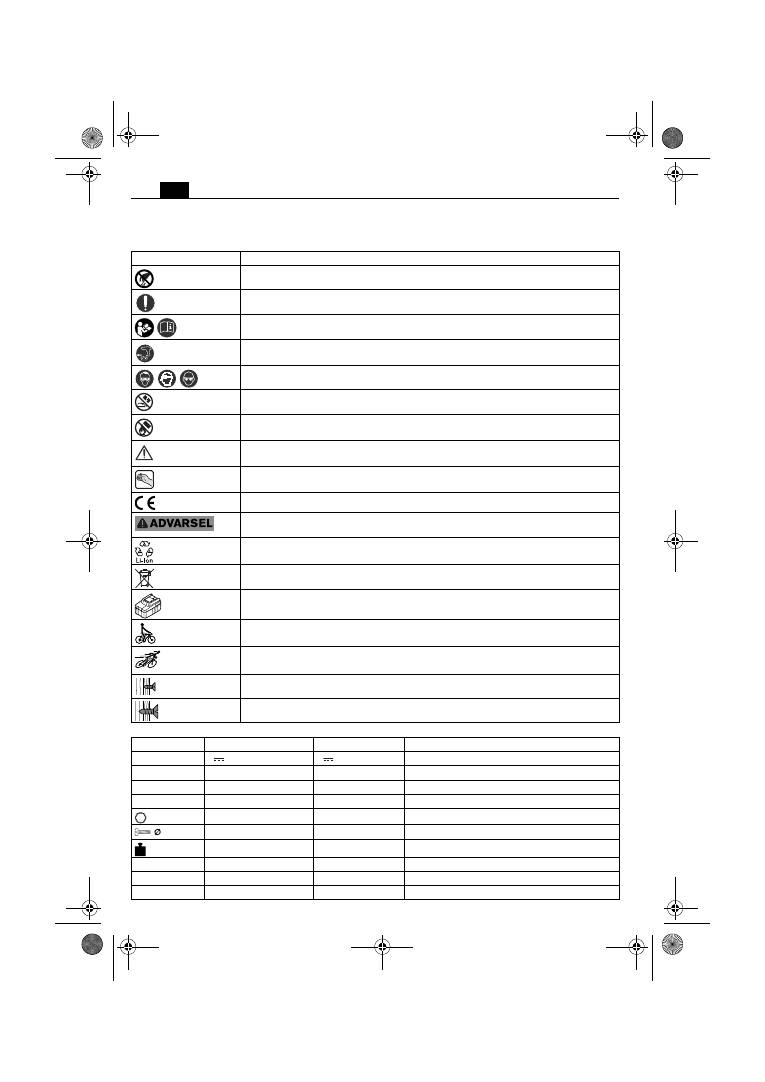
40
no
no
Original driftsinstruks batteri-skrutrekker.
Anvendte symboler, forkortelser og uttrykk.
Symbol, tegn
Forklaring
Ikke berør de roterende delene til elektroverktøyet.
Følg anvisningene i teksten eller bildet ved siden av!
Vedlagte dokumenter som driftsinstruks og generelle sikkerhetsinformasjoner må abso-
lutt leses.
Før dette gjøres må batteriet tas ut av elektroverktøyet. Ellers er det fare for skader ved
utilsiktet starting av elektroverktøyet.
Bruk øyebeskyttelse ved arbeid.
Ikke lad opp skadede batterier.
Ikke utsett batteriene for ild. Beskytt batteriet mot varme, f.eks. også mot permanent lag-
ring i direkte sollys.
Følg informasjonene i teksten ved siden av!
Gripeflate
Bekrefter at elektroverktøyet er i samsvar med direktivene til det Europeiske Forbund.
Denne informasjonen henviser til en mulig farlig situasjon som kan medføre alvorlige
skader eller død.
Resirkulerings-tegn: merker resirkulerbare materialer
Vrakede elektroverktøy og andre elektrotekniske og elektriske produkter må samles inn
hver for seg og leveres inn til en miljøvennlig resirkulering.
Batteritype
Lavt turtall
Høyt turtall
Reduksjon av dreiemomentet
Øking av dreiemomentet
Tegn
Enhet internasjonalt
Enhet nasjonalt
Forklaring
U
V
V
elektrisk likespenning
n
0
/min, min
-1
, rpm, r/min
min
-1
Turtall, ubelastet
n
1
/min, min
-1
, rpm, r/min
min
-1
Turtall, belastet
M...
Nm
Nm
Dreiemoment (hard/myk skruing)
inch
inch
Verktøyfeste med innvendig sekskant
mm
mm
Skruediameter
kg
kg
Vekt tilsvarende EPTA-Procedure 01/2003
L
pA
dB
dB
Lydtrykknivå
L
wA
dB
dB
Lydeffektnivå
L
pCpeak
dB
dB
Maksimalt lydtrykknivå
OBJ_BUCH-0000000072-001.book Page 40 Monday, June 18, 2012 8:40 AM

41
no
For din egen sikkerhet.
Les gjennom alle advarslene og
anvisningene.
Unnlatelse av å over-
holde advarslene og nedenstående anvisninger kan med-
føre elektriske støt, brann og/eller alvorlige skader.
Ta godt vare på alle advarslene og informasjonene.
Ikke bruk dette elektroverktøyet før du har lest og
forstått denne driftsinstruksen og de vedlagte
“Generelle sikkerhetsinformasjonene” (doku-
mentnummer 3 41 30 054 06 1). Oppbevar de angitte
papirene til senere bruk og overrekk disse sammen med
elektroverktøyet hvis det lånes bort eller selges videre.
Følg også de vanlige nasjonale arbeidsmiljøbestemmelse-
ne.
Elektroverktøyets formål:
Håndholdt skrutrekker til inn- og utskruing av skruer,
spesielt til bruk innen bygg og anlegg med selvborende
skruer, innsatsverktøy og tilbehør som er godkjent av
FEIN og til bruk i værbeskyttede omgivelser.
Spesielle sikkerhetsinformasjoner.
Hold elektroverktøyet på de isolerte gripeflatene, hvis du
utfører arbeid der skruen kan treffe på skjulte strømled-
ninger.
Kontakt mellom skruen og en spenningsførende
ledning kan også sette elektroverktøyets metalldeler
under spenning og føre til elektriske støt.
Pass på skjulte elektriske ledninger, gass- og vannrør.
Kontroller arbeidsområdet f. eks. med et metallsøkeap-
parat før arbeidet påbegynnes.
Sikre arbeidsstykket.
Et arbeidsstykke som holdes fast
med spenninnretninger, holdes sikrere enn med hånden.
Hold elektroverktøyet godt fast.
Det kan oppstå høye
reaksjonsmomenter i korte perioder.
Ikke bearbeid asbestholdig material.
Asbest kan frem-
kalle kreft.
Det er forbudt å skru eller nagle skilt eller tegn på elek-
troverktøyet.
En skadet isolasjon gir ingen beskyttelse
mot elektriske støt. Bruk klebeskilt.
Bruk kun reservedeler eller tilbehør som er levert og god-
kjent av produsenten.
En sikker bruk kan ikke garanteres
selv om annet tilbehør som passer til elektroverktøyet
blir benyttet.
Bruk og behandling av batteriet (batteriblokken)
Ta hensyn til følgende informasjoner for å unngå farer
som forbrenning, brann, eksplosjon, hudskader og andre
skader ved bruk av batteriet:
Batterier må ikke tas fra hverandre, åpnes eller hakkes
opp. Ikke utsett batteriene for mekaniske støt.
Ved ska-
der og usakkyndig bruk av batteriet kan det slippe ut ska-
delig damp og væske. Dampen kan irritere
åndedrettsorganene. Batterivæske som renner ut kan
føre til irritasjoner på huden eller forbrenninger.
Hvis det er kommet batterivæske på gjenstander, må
disse rengjøres eller eventuelt skiftes ut.
Ikke utsett batteriene for varme eller ild. Batteriene må
ikke lagres i direkte sol.
Ta batteriet først ut av originalemballasjen når det skal
brukes.
Ta batteriet ut av elektroverktøyet før det utføres arbeid
på elektroverktøyet.
Hvis elektroverktøyet starter utilsik-
tet, er det fare for skader.
Ta batteriet kun ut når elektroverktøyet er slått av.
Hold batteriet unna barn.
Hold batteriet rent og beskyttet mot fuktighet og vann.
Rengjør de tilsmussede kontaktene på batteriet og el-
verktøyet med en tørr, ren klut.
Bruk kun intakte originale FEIN-batterier, som er bereg-
net for dette el-verktøyet.
Ved arbeid eller opplading av
uoriginale, skadede, reparerte eller modifiserte batterier,
etterligninger og batterier fra andre produsenter er det
fare for brann og/eller eksplosjonsfare.
Følg sikkerhetsinformasjonene i driftsinstruksen for
batteri-laderen.
Hånd-arm-vibrasjoner
Vibrasjonsnivået som er angitt i disse anvisningene er
målt iht. en målemetode som er standardisert i EN 60745
og kan brukes til sammenligning av elektroverktøy med
hverandre. Den egner seg også til en foreløpig vurdering
av svingningsbelastningen.
Det angitte svingningsnivået representerer de vanlige
anvendelsene til elektro-verktøyet. Men hvis elektro-
verktøyet brukes til andre anvendelser, med avvikende
innsatsverktøy eller utilstrekkelig vedlikehold, kan sving-
ningsnivået avvike. Dette kan øke vibrasjonsbelastningen
tydelig for hele arbeidstiden.
Til en nøyaktig vurdering av vibrasjonsbelastningen bør
det også tas hensyn til tidene når maskinen var utkoblet
eller går, men ikke virkelig brukes. Dette kan redusere
vibrasjonsbelastningen tydelig for hele arbeidstiden.
Bestem ekstra sikkerhetstiltak for å beskytte brukeren
mot svingningsvirkninger som for eksempel: Vedlikehold
av elektroverktøy og innsatsverktøy, holde hendene
varme, organisere arbeidsforløpene.
K...
Usikkerhet
m/s
2
m/s
2
Svingningsemisjonsverdi iht. EN 60745
(vektorsum fra tre retninger)
h
m/s
2
m/s
2
Svingningsemisjonsverdi (skruer)
m, s, kg, A, mm, V,
W, Hz, N, °C, dB,
min, m/s
2
m, s, kg, A, mm, V,
W, Hz, N, °C, dB,
min, m/s
2
Basis- og avledede enheter fra det internasjonale
enhetssystemet
SI
.
Tegn
Enhet internasjonalt
Enhet nasjonalt
Forklaring
OBJ_BUCH-0000000072-001.book Page 41 Monday, June 18, 2012 8:40 AM
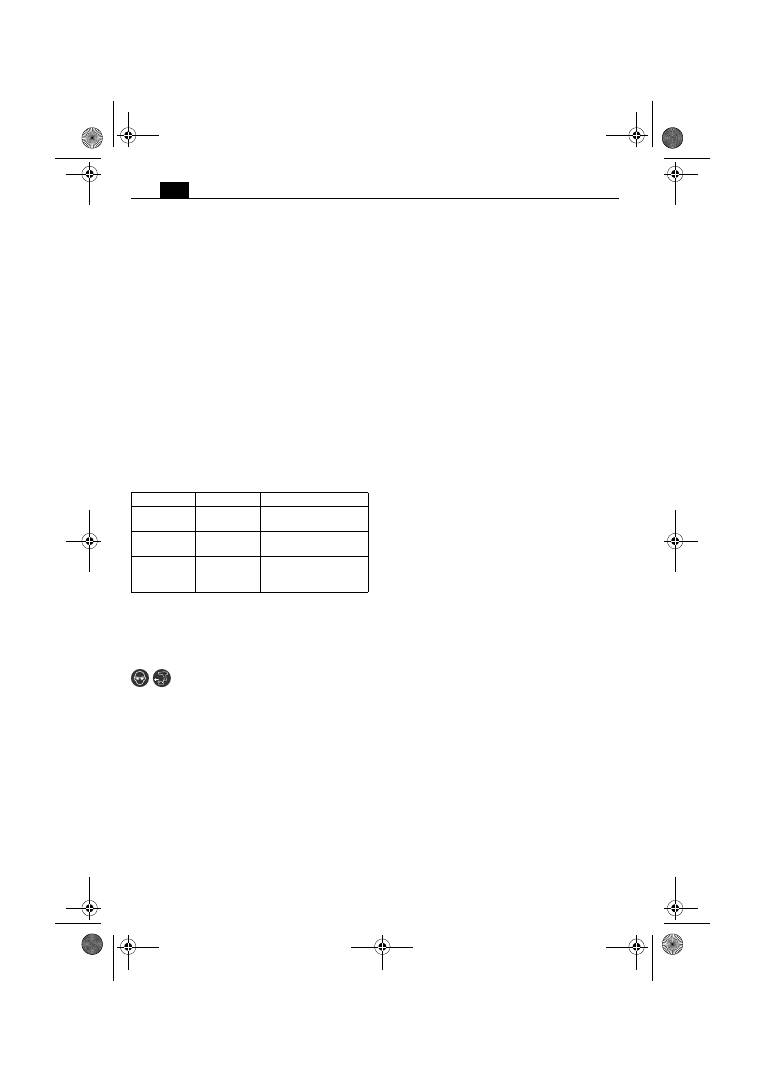
42
no
Bruksinformasjon.
Bruk høyre-/venstre-bryteren kun når motoren står
stille.
Sett høyre-/venstre-bryteren i midtstilling for å unngå en
utilsiktet start, f.eks. ved transport.
Ved overoppheting går elektroverktøyet med korte,
ytelsessvake impulser. La elektroverktøyet avkjøle ved å
kjøre maskinen uten belastning.
ASCT14/ASCT14M/ASCT18/ASCT18M:
Det skal skrues
med montert dybdeanslag.
ASCT14M/ASCT14UM/ASCT18M/ASCT18UM:
Skrumagasi-
net må kun brukes i stillingen «dreieretning mot høyre».
Innstilling av dreiemomentet (ASCT14U/
ASCT14UM/ASCT18U/ASCT18UM) (Se side 7).
Fabrikkinnstillingen tilsvarer området for mindre til mid-
dels store skruer.
Tiltrekkingsmomentet er også avhengig av kraften elek-
troverktøyet trykkes mot skruen med.
Håndtering av batteriet.
Bruk og lad batteriet kun opp i et batteri-driftstempera-
turomårde på 0 °C – 45 °C (32 °F – 113 °F). Batteri-tem-
peraturen må være i batteri-driftstemperaturområdet når
oppladingen påbegynnes.
Den ekte prosentuale ladetilstanden til batteriet anvises
kun når motoren på elektroverktøyet er stanset.
Motoren stoppes automatisk av elektronikken når batte-
riet er utladet.
Vedlikehold og kundeservice.
Ved ekstreme bruksvilkår kan det ved bearbei-
delse av metall sette seg metallstøv inne i elek-
troverktøyet. Dette kan forårsake kortslutning
eller overslag. Blås ofte gjennom de innvendige delene av
elektroverktøyet gjennom ventilasjonsspaltene med tørr
og oljefri trykkluft.
Den aktuelle reservedelslisten for dette elektroverktøyet
finner du på internettet under www.fein.com.
Følgende deler kan du skifte ut selv etter behov:
Innsats-
verktøy, dybdeanlegg, batteri, stativkrok, magasin
Reklamasjonsrett og garanti.
Reklamasjonsretten for produktet gjelder jf. de lovmes-
sige bestemmelsene i det landet produktet selges i. Ut
over dette yter FEIN garanti i henhold til FEIN-produsen-
tens garantierklæring.
Denne driftsinstruksen kan inneholde beskrivelser
og/eller illustrasjoner av tilbehør som ikke inngår i din
leveranse.
Samsvarserklæring.
Firmaet FEIN erklærer som eneansvarlig at dette produk-
tet stemmer overens med de vanlige bestemmelsene som
er oppført på siste side i denne driftsinstruksen.
Tekniske underlag hos: C. & E. FEIN GmbH, C-DB_IA,
D-73529 Schwäbisch Gmünd
Miljøvern, deponering.
Emballasjer, gammelt elektroverktøy og tilbehør må leve-
res inn til miljøvennlig resirkulering.
Batterier må kun leveres inn til korrekt deponering i utla-
det tilstand.
Hvis batteriene ikke er helt utladet må kontaktene isole-
res med tape, slik at det ikke oppstår en kortslutning.
LED-indikator Betydning
Aksjon
1 – 4 grønne
LED
Prosentual
ladetilstand
Drift
Rødt konti-
nuerlig lys
Batteriet er
nesten tomt
Lad opp batteriet
Rødt blinklys Batteriet er
ikke drifts-
klart
Få batteriet inn i batteri-
driftstemperaturområ-
det, lad deretter opp
OBJ_BUCH-0000000072-001.book Page 42 Monday, June 18, 2012 8:40 AM
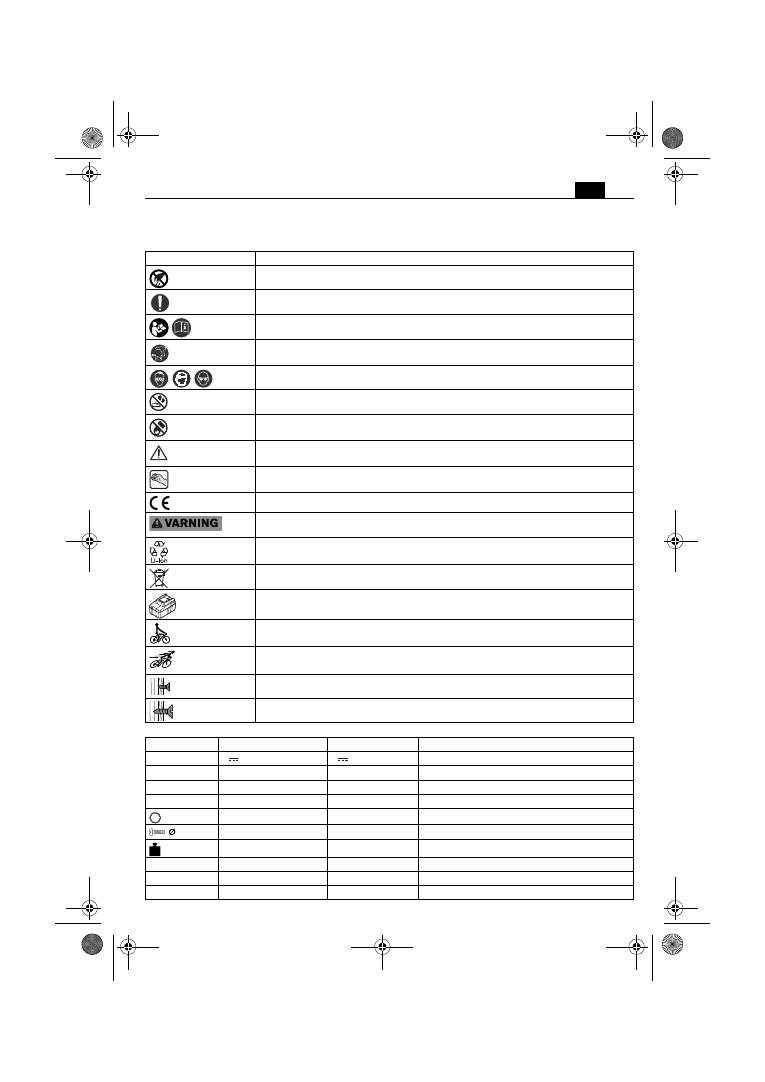
43
sv
sv
Bruksanvisning i original för sladdlös skruvdragare.
Använda symboler, förkortningar och begrepp.
Symbol, tecken
Förklaring
Berör inte elverktygets roterande delar.
Följ anvisningarna i texten eller grafiken!
Bifogad dokumentation som t.ex. bruksanvisningen och Allmänna säkerhetsanvisningarna
ska ovillkorligen läsas.
Före detta arbetsmoment ska batteriet tas ur elverktyget. I annat fall finns risk för att
elverktyget vid oavsiktlig start orsakar kroppsskada.
Vid arbetet ska ögonskydd användas.
Ladda inte batterier av främmande fabrikat.
Utsätt inte batteriet för eld. Skydda batteriet mot hög värme som t.ex. långtids solbestrål-
ning.
Beakta anvisningarna i intilliggande text!
Greppområde
Försäkrar om att elverktyget överensstämmer med Europeiska gemenskapens direktiv.
Denna anvisning hänvisar till en eventuellt farlig situation som kan leda till allvarliga per-
sonskador eller till död.
Återvinningsmärke: märket anger att materialet är återanvändbart
Kasserade elverktyg och andra elektrotekniska och elektriska produkter ska omhändertas
och hanteras på miljövänligt sätt.
Batterityp
Lågt varvtal
Högt varvtal
Reducera vridmomentet
Öka vridmomentet
Tecken
Internationell enhet
Nationell enhet
Förklaring
U
V
V
Elektrisk likspänning
n
0
/min, min
-1
, rpm, r/min
r/min
Tomgångsvarvtal
n
1
/min, min
-1
, rpm, r/min
r/min
Lastvarvtal
M...
Nm
Nm
Vridmoment (hårt/mjukt skruvförband)
inch
tum
Verktygsfäste med invändig sexkant
mm
mm
Skruvdiameter
kg
kg
Vikt enligt EPTA-Procedure 01/2003
L
pA
dB
dB
Ljudtrycksnivå
L
wA
dB
dB
Ljudeffektnivå
L
pCpeak
dB
dB
Toppljudtrycksnivå
OBJ_BUCH-0000000072-001.book Page 43 Monday, June 18, 2012 8:40 AM

44
sv
För din säkerhet.
Läs noga igenom alla säkerhetsanvis-
ningar och instruktioner.
Fel som upp-
står till följd av att säkerhetsanvisningarna och
instruktionerna inte följts kan orsaka elstöt, brand
och/eller allvarliga personskador.
Förvara alla varningar och anvisningar för framtida bruk.
Använd inte detta elverktyg innan du noggrant läst
och fullständigt förstått denna instruktionsbok
samt bifogade „Allmänna säkerhetsanvisningar“
(publikationsnummer 3 41 30 054 06 1). Dessa underlag
bör förvaras för senare användning och ska bifogas
elverktyget vid överlåtelse eller försäljning.
Beakta även tillämpliga nationella arbetarskyddsbestäm-
melser.
Avsedd användning av elverktyget:
handhållen skruvdragare för i- och urdragning av skruvar
med av FEIN godkända insatsverktyg och tillbehör i
väderskyddad omgivningen, speciellt lämplig för inred-
ningsarbeten med snabbyggskruvar.
Speciella säkerhetsanvisningar.
Håll i elverktyget endast vid de isolerade greppytorna när
arbeten utförs på ställen där skruven kan skada dolda
elledningar.
Kontakt med en spänningsförande ledning
kan sätta elverktygets metalldelar under spänning och
leda till elstöt.
Se upp för dolt liggande elledningar, gas- och vattenrör.
Kontrollera arbetsområdet t. ex. med en metalldetektor
innan arbetet påbörjas.
Säkra arbetsstycket.
Arbetsstycket ligger säkrare i en
uppspänningsanordning än i handen.
Håll stadigt tag i elverktyget.
Höga reaktionsmoment kan
kortvarigt uppstå.
Asbesthaltigt material får inte bearbetas.
Asbest anses
vara cancerframkallande.
Det är förbjudet att med skruvar eller nitar fästa brickor
och märken på elverktyget.
En skadad isolering skyddar
inte längre mot elstöt. Använd dekaler.
Använd endast tillbehör som speciellt tagits fram eller
godkänts av elverktygets tillverkare.
Användningen
behöver inte vara säker bara för att tillbehöret passar till
elverktyget.
Användning och hantering av batterier (batterimo-
duler)
För undvikande av faror som t.ex. brandskador, explo-
sion, hudskador och andra personskador vid hantering
med batterierna ska följande anvisningar följas:
Batterierna får inte tas isär och inte heller krossas. Utsätt
inte batterierna för mekaniska stötar.
Ett skadat eller
felanvänt batteri kan orsaka hälsovådliga ångor och väts-
kor. Ångorna kan leda till irritation i andningsvägarna.
Batterivätskan kan medföra hudirritation eller brännska-
da.
Om batterivätskan vätt intilliggande föremål, kontrollera
berörda delar, rengör eller byt dem vid behov.
Utsätt inte batteriet för hetta eller eld. Låt inte batteriet
ligga i solljus.
Plocka upp batteriet ur originalförpackningen först när
det ska användas.
För alla åtgärder på elverktyget ta batteriet ur elverkty-
get.
Om elverktyget startar oavsiktligt finns risk för
kroppsskada.
Frånkoppla först elverktyget innan batteriet tas ut.
Håll barn på betryggande avstånd från batterier.
Håll batteriet rent och skydda det mot fukt och vatten.
Rengör batteriets och elverktygets nedsmutsade anslut-
ningar med en torr, ren trasa.
Använd endast felfria original FEIN-batterier som är
avsedda för elverktyget.
Vid åtgärder på och laddning av
felaktiga, skadade, reparerade, renoverade, kopierade
batterier eller batterier av främmande fabrikat finns risk
för brand och/eller explosion.
Följ säkerhetsanvisningarna i batteriladdarens bruksan-
visning.
Hand-arm-vibrationer
Mätningen av den vibrationsnivå som anges i denna anvis-
ning har utförts enligt en mätmetod som är standardise-
rad i EN 60745 och kan användas vid jämförelse av olika
elverktyg. Den kan även tillämpas för preliminär bedöm-
ning av vibrationsbelastningen.
Den angivna vibrationsnivån representerar elverktygets
huvudsakliga användningsområden. Om däremot elverk-
tyget används för andra ändamål och med andra insats-
verktyg eller inte underhållits ordentligt kan
vibrationsnivån avvika. Detta kan öka vibrationsbelast-
ningen väsentligt under den totala tidsperioden.
För exakt värdering av vibrationsbelastningen under en
bestämd tidsperiod bör hänsyn även tas till den tid
elverktyget har varit avstängt eller gått utan att vara i
verkligt ingrepp. Detta kan minska vibrationsbelastningen
väsentligt under den totala tidsperioden.
Bestäm extra säkerhetsåtgärder för att skydda operatö-
ren mot vibrationernas inverkan, t. ex.: underhåll av
elverktyget och insatsverktygen, att hålla händerna
varma, organisera arbetsförloppen.
K...
Onoggrannhet
m/s
2
m/s
2
Vibrationsemissionsvärde enligt EN 60745
(vektorsumma i tre riktningar)
h
m/s
2
m/s
2
Vibrationsemissionsvärde (skruvdragning)
m, s, kg, A, mm, V,
W, Hz, N, °C, dB,
min, m/s
2
m, s, kg, A, mm, V,
W, Hz, N, °C, dB,
min, m/s
2
Bas- och härledda enheter från det Internationella
enhetssystemet
SI
.
Tecken
Internationell enhet
Nationell enhet
Förklaring
OBJ_BUCH-0000000072-001.book Page 44 Monday, June 18, 2012 8:40 AM
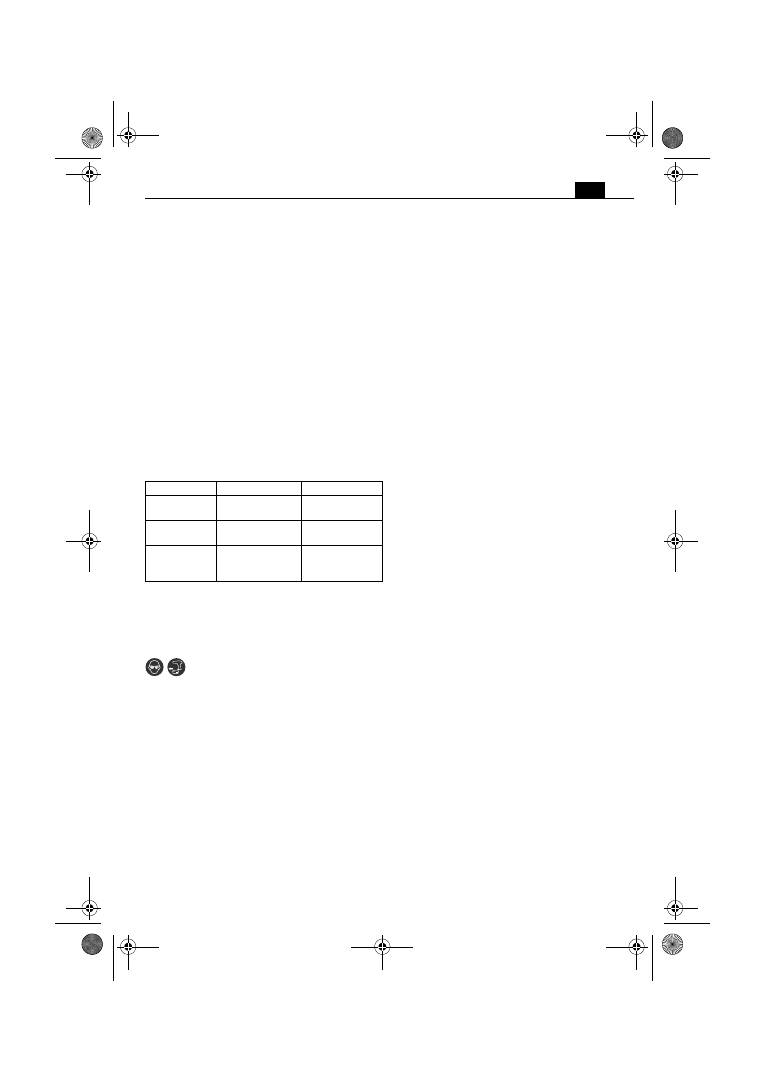
45
sv
Användningsinstruktioner.
Påverka riktningsomkopplaren endast på frånkopplad
motor.
Ställ riktningsomkopplaren i mittläge för att undvika oav-
siktlig driftstart, t.ex. vid transport.
Vid överhettning går elverktyget med korta, effektsvaga
impulser. Låt elverktyget svalna på tomgång.
ASCT14/ASCT14M/ASCT18/ASCT18M:
Skruvdragning ska
ske med monterat djupanslag.
ASCT14M/ASCT14UM/ASCT18M/ASCT18UM:
Skruvmaga-
sinet får endast drivas i läget ”Rotationsriktning höger”.
Inställning av vridmoment (ASCT14U/ASCT14UM/
ASCT18U/ASCT18UM) (se sidan 7).
Vid fabriken har skruvdragaren ställts in i läge för mindre
och medelstora skruvar.
Åtdragningsmomentet är även beroende av den kraft
med vilken elverktyget trycks mot skruven.
Hantering av batterier.
Använd och ladda batteriet endast inom temperaturom-
rådet 0 °C – 45 °C (32 °F – 113 °F). Batteriets temperatur
måste vid start av laddning ligga inom driftstemperatur-
området.
Batteriets faktiska laddningstillstånd indikeras endast när
elverktygets motor stängts av.
När en djupurladdning av batteriet hotar, stannar elektro-
niken automatiskt motorn.
Underhåll och kundservice.
Vid bearbetning av metall kan under extrema
betingelser ledande damm samlas i elverkty-
gets inre. Renblås ofta elverktygets inre genom
ventilationsöppningarna med torr och oljefri tryckluft.
Den aktuella reservdelslistan för detta elverktyg hittar du
i Internet på adress: www.fein.com.
Följande delar kan du vid behov själv byta ut:
Insatsverk-
tyg, djupanslag, batteri, ställkrok, magasin
Garanti och tilläggsgaranti.
Garanti lämnas på produkten enligt de lagbestämmelser
som gäller i aktuellt användningsland. Dessutom lämnar
FEIN en tilläggsgaranti enligt FEIN-tillverkargaranti-
förklaring.
Vid leverans av aktuellt elverktyg kan vissa delar saknas av
de tillbehör som beskrivs eller visas i bruksanvisningen.
Försäkran om överensstämmelse.
FEIN försäkrar under exklusivt ansvar att denna produkt
överensstämmer med de normativa dokument som anges
på instruktionsbokens sista sida.
Tekniska publikationer finns hos: C. & E. FEIN GmbH,
C-DB_IA, D-73529 Schwäbisch Gmünd
Miljöskydd, avfallshantering.
Förpackning, skrotade elverktyg och tillbehör ska hante-
ras på miljövänligt sätt.
Avfallshantera batterier endast i urladdat tillstånd.
Om batteriet inte är fullständigt urladdat, isolera stick-
kontakten med tejp för att undvika kortslutning.
LED-indikering
Betydelse
Aktion
1 – 4 gröna
LED
procentuellt ladd-
ningstillstånd
Drift
kontinuerligt
rött ljus
Batteriet är nästan
urladdat
Ladda batteriet
rött blinkljus
Batteriet är inte
driftklart
Låt batteriet anta
driftstemperatur
innan det laddas
OBJ_BUCH-0000000072-001.book Page 45 Monday, June 18, 2012 8:40 AM
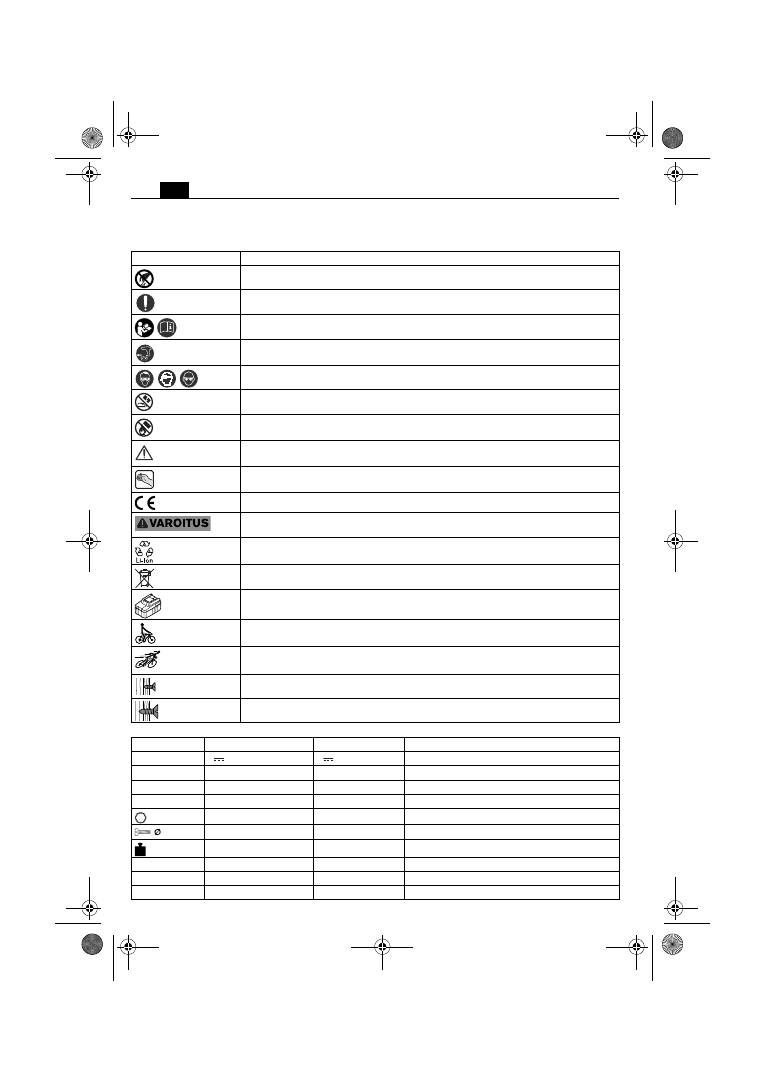
46
fi
fi
Alkuperäiset ohjeet - Akkuruuvinväännin.
Symbolit, lyhenteet ja erikoissanasto.
Piktogrammit
Selitys
Sähkötyökalun pyöriviin osiin ei saa koskea.
Noudata viereisen tekstin tai grafiikan ohjeita!
Oheisiin dokumentteihin sekä käyttöohjeisiin ja yleisiin turvaohjeisiin on ehdottomasti
perehdyttävä.
Ennen tätä työvaihetta akku on otettava irti sähkötyökalusta. Muutoin sähkötyökalu voi
käynnistyä itsestään ja aiheuttaa tapaturman.
Työstön aikana silmät on suojattava laseilla.
Vioittunutta akkua ei saa ladata.
Akkua ei saa viedä lähelle avotulta. Akku on suojattava kuumuudelta, esim. suoralta aurin-
gonpaisteelta.
Noudata viereisen tekstin ohjeita!
Kahvapinta
Vahvistaa, että sähkötyökalun rakenne vastaa EU-direktiivien suosituksia.
Teksti varoittaa mahdollisesta vaarallisesta tilanteesta, joka voi johtaa vakavaan työtapatur-
maan tai jopa hengenvaaraan.
Kierrätysmerkki: uusiokäyttöön kelpaavien materiaalien tunnistukseen
Vanhat, käytöstä poistetut sähkötyökalut ja muut sähkökäyttöiset laitteet on hävitettävä
ympäristöystävällisesti johtamalla ne kierrätykseen.
Akkutyyppi
Alhainen kierroslukualue
Korkea kierroslukualue
Kiristysmomentti pienemmälle
Kiristysmomentti suuremmalle
Merkki
Kansainvälinen yksikkö
Kansallinen yksikkö Selitys
U
V
V
Tasajännite
n
0
/min, min
-1
, rpm, r/min
min
-1
Joutokäyntinopeus
n
1
/min, min
-1
, rpm, r/min
min
-1
Kuormitusnopeus
M...
Nm
Nm
Vääntömomentti (kova/pehmeä materiaali)
inch
inch
Kiinnitysistukka, kuusiokolo
mm
mm
Ruuvin halkaisija
kg
kg
Paino vastaa EPTA-Procedure 01/2003-tietoja
L
pA
dB
dB
Äänen painetaso
L
wA
dB
dB
Äänitaso
L
pCpeak
dB
dB
Äänen painetason huippuarvo
OBJ_BUCH-0000000072-001.book Page 46 Monday, June 18, 2012 8:40 AM
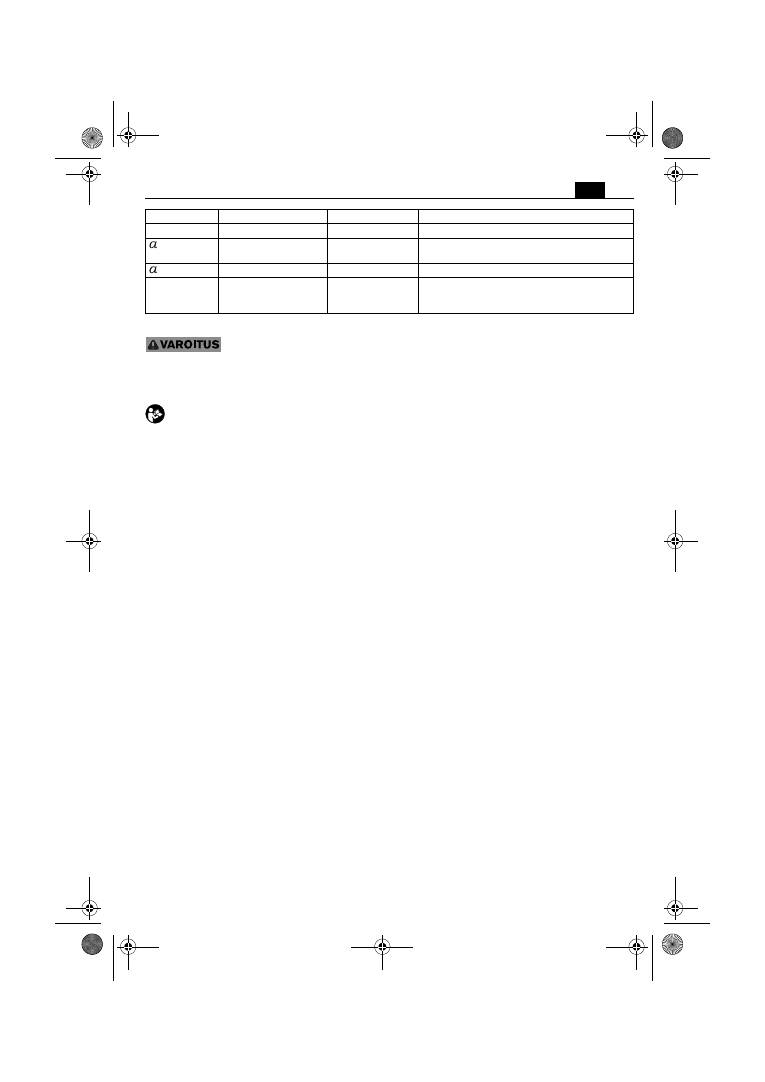
47
fi
Työturvallisuus.
Lue kaikki turvallisuus- ja muut
ohjeet.
Turvallisuusohjeiden laimin-
lyönti saattaa johtaa sähköiskuun, tulipaloon ja/tai vaka-
vaan loukkaantumiseen.
Säilytä kaikki turvallisuus- ja muut ohjeet tulevaisuutta
varten.
Sähkötyökalun saa ottaa käyttöön vasta sitten, kun
ensin on perehdytty käyttöohjeeseen sekä oheisiin
yleisiin turvaohjeisiin (julkaisunumero
3 41 30 054 06 1) niin, että niissä annetut ohjeet tulevat
ymmärretyiksi. Säilytä kyseiset dokumentit vastaisuuden
varalta ja anna ne mukaan, mikäli laite luovutetaan toisen
käyttöön tai myydään eteenpäin.
Niiden ohella on noudatettava voimassa olevia lakisäätei-
siä työturvallisuusmääräyksiä.
Sähkötyökalun käyttökohteet:
käsivarainen ruuvinväännin ruuvaukseen ja ruuvien irro-
tukseen säältä suojatuissa tiloissa, erityisesti kuiviin tiloi-
hin ja sisärakennukseen pikaruuveilla. Ruuvinvääntimessä
saa käyttää ainoastaan FEIN:in hyväksymiä työkaluja ja
lisätarvikkeita.
Erityiset varotoimenpiteet.
Pidä sähkötyökalua eristetyistä pinnoista, tehdessäsi
työtä, jossa ruuvi saattaisi osua piilossa olevaan sähkö-
johtoon.
Jos laite osuu jännitteelliseen johtoon, sen metal-
liset osat saattavat johtaa sähköä, mistä on seurauksena
sähköisku.
Varo rakenteissa olevia sähköjohtoja ja kaasu- ja vesi-
putkia.
Tarkasta ennen töiden aloittamista työkohde
esim. metallinilmaisimella.
Varmista työkappaleen asento.
Kun työkappale kiinnite-
tään sopivaan työpenkkiin, sitä on parempi käsitellä kuin
käsin kiinni pidettäessä.
Pidä työkalua tukevassa otteessa.
Reaktiomomentit voi-
vat lyhytaikaisesti olla erittäin korkeat.
Asbestipitoista materiaalia ei saa työstää.
Asbesti voi
aiheuttaa syöpää.
Sähkötyökaluun ei saa kiinnittää kilpiä tms. poraamalla
tai niittaamalla.
Jos koneen eristystä vioitetaan, seurauk-
sena voi olla sähköiskun vaara. Suositamme tarrakiinnit-
teisiä kilpiä.
Käytä ainoastaan lisävarusteita, jotka ovat joko sähkö-
työkalun valmistajan alkuperäisosia tai muutoin valmis-
tajan hyväksymiä.
Vaikka jokin vierasvalmisteinen
lisävaruste sopisikin sähkökoneeseen, se ei välttämättä
ole turvallinen käyttää.
Akkujen käyttö ja käsittely
Jotta akkuja käsiteltäessä vältetään vaarat ja riskit –
palon- tai räjähdyksen vaara, palovammat, ihovammat ja
muut tapaturmat –, on noudatettava seuraavia ohjeita:
Akkuja ei saa purkaa, avata eikä pilkkoa. Akkuihin ei saa
kohdistaa mekaanisia iskuja.
Väärän käsittelyn seurauk-
sena vioittuneesta akusta voi purkautua haitallista höyryä
ja akkunestettä. Akkunestehöyryt voivat ärsyttää hengi-
tysteitä. Iholle päässyt akkuneste voi ärstyttää tai syövyt-
tää ihoa.
Jos viallisesta akusta on virrannut ulos akkunestettä vie-
ressä olevien esineiden päälle, tarkista kyseiset kohdat
ja pese ne, tarvittaessa osat on vaihdettava uusiin.
Akkua ei saa viedä lähelle lämpölähteitä tai avotulta.
Akkua ei saa varastoida paikassa, mihin osuu auringon-
valo.
Ota akku ulos alkuperäispakkauksesta vasta sitten, kun
se otetaan käyttöön.
Irrota akku aina ensin sähkötyökalusta, ennen kuin ryh-
dyt valmistelemaan töitä.
Jos sähkötyökalu käynnistyy
vahingossa, se voi aiheuttaa tapaturman.
Sähkötyökalu on kytkettävä pois päältä, ennen kuin akku
irrotetaan.
Pidä akut poissa lasten ulottuvilta.
Akku on pidettävä puhtaana ja suojattava kosteudelta ja
vedeltä.
Puhdista lika akun ja sähkötyökalun liitännöistä
kuivalla, puhtaalla liinalla.
Käytä aina vain ehjiä, alkuperäisiä FEIN-akkuja, jotka on
suunniteltu kyseiseen sähkötyökaluun.
Mikäli koneessa
käytetään vääräntyyppisiä, vioittuneita, kunnostetttuja tai
kierrätettyjä akkuja, piraattituotteita tai vieraan valmista-
jan akkuja, ja tällaisia akkuja ladattaessa on olemassa tuli-
palon ja/tai räjähdyksen vaara.
Noudata latauslaitteen käyttöohjeessa annettuja turva-
ohjeita.
Käsiin ja käsivarsiin kohdistuva tärinä
Tässä ohjeessa ilmoitettu tärinätaso on mitattu standardin
EN 60745 mukaista mittausmenetelmää noudattaen ja
sitä voidaan soveltaa verrattaessa sähkötyökalujen arvoja
keskenään. Arvoa voidaan soveltaa myös arvioitaessa
alustavasti värinästä aiheutuvaa kuormitusta.
Ilmoitettu tärinätaso vastaa sähkötyökalun pääasiallisia
käyttösovelluksia. Mikäli sähkötyökalua käytetään muihin
tarkoituksiin tai siinä käytetään muita lisätarvikkeita tai
mikäli työkalun huolto on puutteellinen, tärinätaso saat-
taa poiketa tässä ilmoitetusta. Siinä tapauksessa tärinätaso
voi nousta selvästi koko työkohteessa.
K...
Epävarmuustekijä
m/s
2
m/s
2
Tärinäarvo vastaa standardia EN 60745 (vektori-
summa, kolmiulotteinen)
h
m/s
2
m/s
2
Värähtelytasoarvo (ruuvit)
m, s, kg, A, mm, V,
W, Hz, N, °C, dB,
min, m/s
2
m, s, kg, A, mm, V,
W, Hz, N, °C, dB,
min, m/s
2
Kansainväliseen
SI
-järjestelmään sisältyvät perus-
yksiköt ja sen johdannaisyksiköt.
Merkki
Kansainvälinen yksikkö
Kansallinen yksikkö Selitys
OBJ_BUCH-0000000072-001.book Page 47 Monday, June 18, 2012 8:40 AM
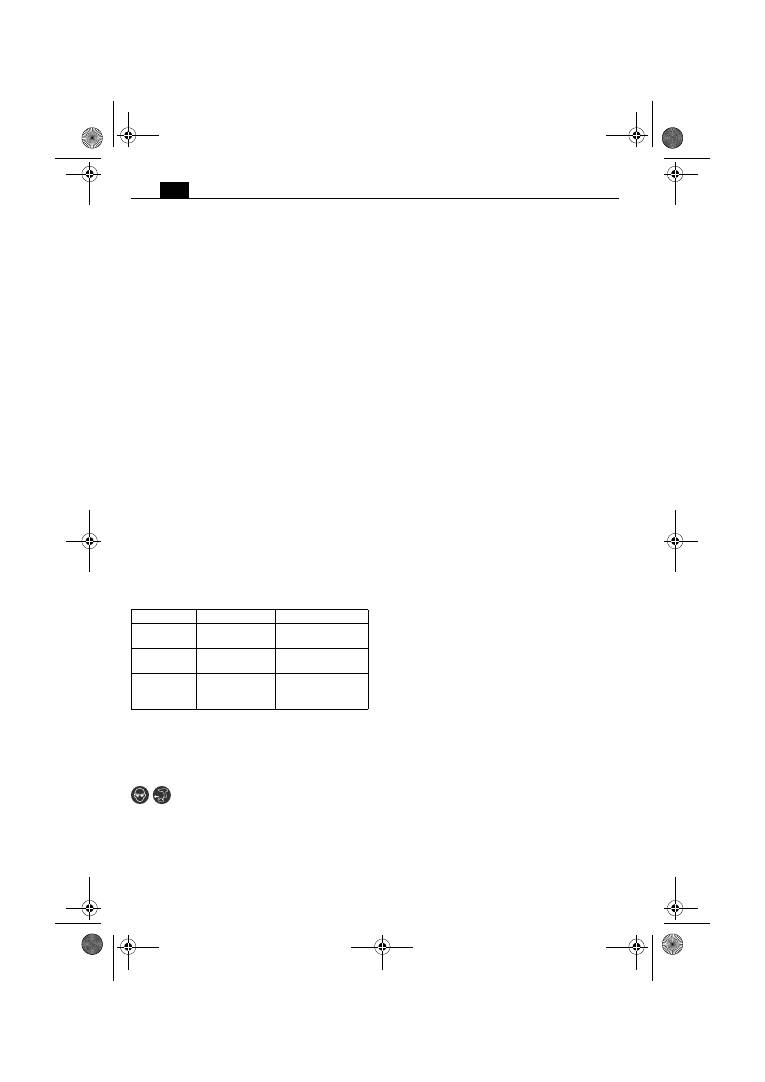
48
fi
Tärinätason tarkan arvioinnin kannalta on tärkeää ottaa
huomioon myös ne ajat, jolloin sähkötyökalu on kytketty
pois päältä sekä ajat, jolloin työkalu on käynnissä, mutta
sillä ei työstetä materiaalia. Siinä tapauksessa tärinätaso
voi nousta selvästi koko työkohteessa.
Jotta koneen käyttäjä välttyisi tärinän aiheuttamilta hai-
toilta, on hyvä sopia ylimääräisistä turvajärjestelyistä,
esim. laatia ohjeet sähkökoneen ja sen työkalujen huol-
losta, työvaiheiden organisoinnista ja työturvallisuudesta.
Työstöohjeita.
Pyörimissuunnan saa vaihtaa vasta kun moottori on
pysähtynyt.
Jotta kone ei voi epähuomiossa käynnistyä (esim. kulje-
tuksen aikana), pyörimissuunnan valitsin on hyvä asettaa
keskiasentoon.
Sähkötyökalun ylikuumenemisen tunnistaa siitä, että sen
impulssit ovat lyhyitä ja vajaatehoisia. Anna silloin työka-
lun jäähtyä käyttämällä sitä joutokäynnillä.
ASCT14/ASCT14M/ASCT18/ASCT18M:
Kierreliitoksia teh-
täessä on aina käytettävä syvyysrajoitinta.
ASCT14M/ASCT14UM/ASCT18M/ASCT18UM:
Ruuvausma-
kasiinia saa käyttää vain silloin, kun on valittu ”pyörimis-
suunta oikealle”.
Kiristysmomentin säätö (ASCT14U/ASCT14UM/
ASCT18U/ASCT18UM) (ks. sivu 7).
Tehdasasetus vastaa aluetta pienikokoisista keskikokoi-
siin ruuveihin.
Kiristysmomenttiin vaikuttaa myös voima, jolla työkalua
painetaan ruuvia vasten.
Akkujen asianmukainen käsittely.
Akkua saa käyttää ja ladata sen vain käyttölämpötiloissa
0 °C – 45 °C (32 °F – 113 °F). Latausta aloitettaessa on
akun lämpötilan oltava sallitulla käyttölämpötila-alueella.
Akun prosentuaalinen latausaste näkyy vain silloin, kun
sähkökoneen moottori on pysäytetty.
Jos akun varaustila laskee liikaa, elektroninen valvontapiiri
pysäyttää moottorin automaattisesti.
Kunnossapito, huolto.
Raskaissa käyttöolosuhteissa voi metalleja
työstettäessä koneen sisään kerääntyä sähköä
johtavaa metallipölyä. Sähkökone on siksi hyvä
puhdistaa sisältä säännöllisin välein puhaltamalla kuivaa,
öljytöntä paineilmaa koneen ilmanvaihtoaukkoihin.
Tähän sähkötyökaluun kuuluvan varaosaluettelon voi
hakea internet-osoitteesta www.fein.com.
Seuraavat osat voi tarvittaessa vaihtaa itse:
Työstötyö-
kalut, syvyysrajoitin, akku, ripustuskoukku, makasiini
Takuu.
Tuotteeseen pätee takuu, joka vaaditaan sen tuonti-
maassa. Sen ohella pätee FEINin takuuehdoissa määrittä-
mä valmistajakohtainen takuu.
Kaikki tässä käyttöohjeessa mainitut tai kuvissa esitetyt
lisätarvikkeet eivät välttämättä kuulu sähkötyökalun toi-
mitussisältöön.
EU-vastaavuus.
Tmi. FEIN vakuuttaa ja vastaa yksin siitä, että tämä tuote
on käyttöohjeen viimeisellä sivulla mainittujen määräys-
ten ja standardien mukainen.
Teknisen dokumentaation laatinut: C. & E. FEIN GmbH,
C-DB_IA, D-73529 Schwäbisch Gmünd
Ympäristönsuojelu, jätehuolto.
Pakkausmateriaalit, käytöstä poistetut sähkötyökalut sekä
lisävarusteet on johdettava kierrätykseen.
Käytettyjen akkujen on oltava purkautuneessa tilassa, kun
ne hävitetään.
Jos akku ei ole täysin tyhjä, sen liitin on eristettävä tarra-
nauhalla oikosulkujen välttämiseksi.
LED-valo
Merkitys
Toimenpide
1 – 4 vihreä
LED
prosentuaalinen
varaustila
Käyttötila
punainen
jatkuva valo
Akku on lähes
tyhjä
Akku ladattava
punainen
vilkkuvalo
Akku ei ole käyt-
tövalmiudessa
Anna akun lämmetä
käyttölämpötilaan ja
lataa se sitten
OBJ_BUCH-0000000072-001.book Page 48 Monday, June 18, 2012 8:40 AM
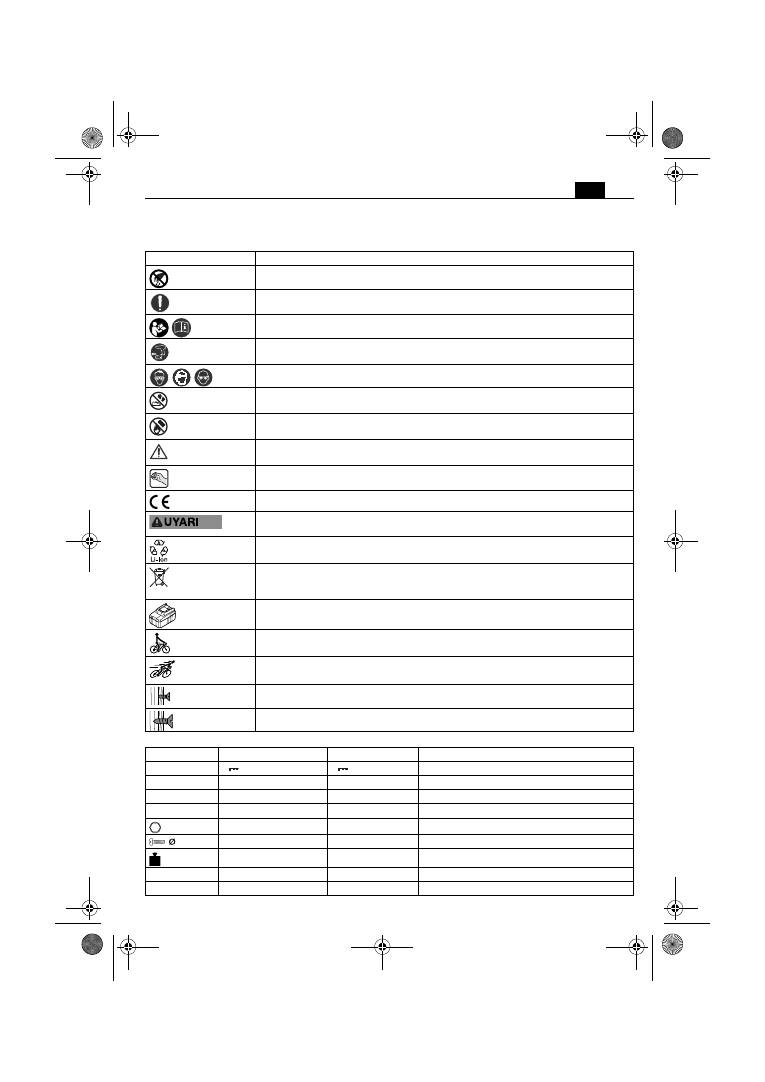
49
tr
tr
Akülü vidalama makinesi orijinal kullanma kılavuzu.
Kullanılan semboller, kısaltmalar ve kavramlar.
Sembol, işaret
Açıklama
Elektrikli el aletinin dönen parçalarına dokunmayın.
Yandaki metin veya grafikteki talimata uyun!
Kullanma kılavuzu ve genel güvenlik talimatı gibi ekteki belgeleri mutlaka okuyun.
Bu iş aşamasına başlamadan önce aküyü elektrikli el aletinden çakarın. Aksi takdirde
elektrikli el aletinin istenmeden çalışması durumunda yaralanma tehlikesi vardır.
Çalışırken koruyucu gözlük kullanın.
Hasarlı aküleri şarj etmeyin.
Aküyü ateşe yaklaştırmayın. Aküyü aşırı sıcağa, örneğin sürekli gelen güneş ışınına karşı
koruyun.
Yandaki metinde bulunan uyarılara uyun!
Tutma yüzeyi
Elektrikli el aletinin Avrupa Birliği yönetmeliklerine uyumlu olduğunu onaylar.
Bu uyarı, ciddi yaralanmalara veya ölüme neden olabilecek muhtemel tehlikeli bir durumu
gösterir.
Recycling işareti: Tekrar kullanılabilen malzemeyi gösterir
Kullanım ömrünü tamamlamış elektrikli el aletleri ve diğer elektro teknik ve elektrikli
ürünler ayrı ayrı toplanmak ve çevre dostu geri kazanım merkezlerine gönderilmek
zorundadır.
Akü tipi
Düşük devir sayısı
Yüksek devir sayısı
Tork küçültme
Tork büyütme
Sembol
Uluslar arası birim
Ulusal birim
Açıklama
U
V
V
Elektriksel doğru akım
n
0
/min, min
-1
, rpm, r/min
/dak
Boştaki devir sayısı
n
1
/min, min
-1
, rpm, r/min
/dak
Yükteki devir sayısı
M...
Nm
Nm
Tork(sert/yumuşak vidalama)
inch
İnç
İç altıgen uç kuvanı
mm
mm
Vida çapı
kg
kg
Ağırlığı EPTA-Procedure 01/2003’e uygun
L
pA
dB
dB
Ses basıncı seviyesi
L
wA
dB
dB
Gürültü emisyonu seviyesi
OBJ_BUCH-0000000072-001.book Page 49 Monday, June 18, 2012 8:40 AM
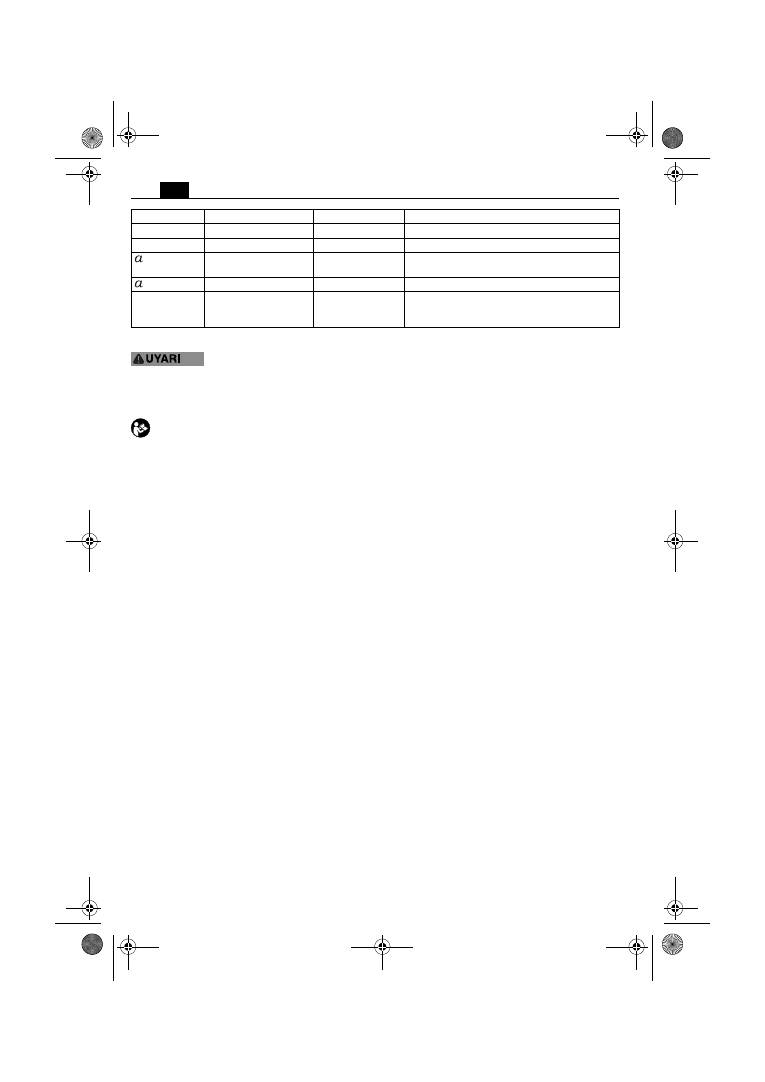
50
tr
Güvenliğiniz için.
Bütün güvenlik talimat ve uyarılarını
okuyun.
Güvenlik talimat ve
uyarılarına uyulmadığı takdirde elektrik çarpması, yangın
ve/veya ağır yaralanmalara neden olunabilir.
Bütün güvenlik talimatı ve uyarılarını ilerde kullanmak
üzere saklayın.
Bu kullanma kılavuzunu ve ekteki “Genel güvenlik
talimatı” ’nı (ürün kodu 3 41 30 054 06 1) esaslı
biçimde okuyup tam olarak anlamadan bu elektrikli
el aletini kullanmayın. Anılan belgeleri ileride kullanmak
üzere saklayın ve elektrikli el aletini başkalarına
verdiğinizde veya devrettiğinizde bu belgeleri de verin.
İlgili ulusal çalışma hükümlerine de uyun.
Elektrikli el aletinin tanımı:
hava koşullarına karşı korunmalı ortamlarda, FEIN
tarafından müsaade edilen uçlarla, özellikle hızlı yapı
vidalarının kullanıldığı kuru yapılarda kullanım için
öngörülen, elle yönlendirilen vida takma ve sökme
makinesi.
Özel güvenlik talimatı.
Vidan n görünmeyen elektrik kablolar na veya aletin
kendi şebeke bağlant kablosuna rastlama olası lı ğı
bulunan işleri yaparken elektrikli el aletini izolasyonlu
tutamağı ndan tutun.
Aletin ucu gerilim altındaki
kablolara temas edecek olursa aletin metal parçaları da
gerilime maruz kalabilir ve kullanıcı elektrik çarpma
tehlikesi ile karşı karşıya kalabilir.
Görünmeyen elektrik kablolarına, gaz ve su borularına
dikkat edin.
Çalışmaya başlamadan önce delme
yapacağınız alanı örneğin bir metal tarama cihazı ile
kontrol edin.
İş parçasını emniyete alın.
Bir germe donanımı ile
emniyete alınmış iş parçası elle tutmaya oranla daha
güvenli işlenir.
Çalışırken elektrikli el aletini sıkıca tutun.
Kısa süreli
reaksiyon momentleri ortaya çıkabilir.
Asbest içeren malzemeyi işlemeyin.
Asbest kanserojen
madde kabul edilir.
Elektrikli el aletinin üstüne etiket ve işaretlerin
vidalanması veya perçinlenmesi yasaktır.
Hasar gören
izolasyon elektrik çarpmasına karşı koruma sağlamaz.
Yapışıcı etiketler kullanın.
Elektrikli el aletinin üreticisi tarafından özel olarak
geliştirilmemiş veya onaylanmamış aksesuar
kullanmayın.
Herhangi bir aksesuarın elektrikli el aletinize
uyması güvenli işletme için tek başına yeterli değildir.
Akünün (akü bloğu) kullanımı ve bakımı
Akü ile çalışırken yanma, yangın, patlama, cilt
yaralanması veya benzeri yaralanmalardan kaçınmak
için aşağıdaki uyarılara uyun:
Aküler açılmamalı, dağıtılmamalı veya kırılmamalıdır.
Aküleri mekanik çarpma ve darbelere karşı koruyun.
Aküler hasar gördüğü veya usulüne aykırı biçimde
kullanıldığı takdirde zararlı buhar veya sıvılar dışarı
çıkarabilirler. Bu buharlar solunum yollarını tahriş
edebilir. Dışarı çıkan akü sıvısı cilt tahrişlerine veya
yanmalara neden olabilir.
Aküden dışarı sızan sıvı yakınınızdaki nesnelere ulaşacak
olursa, bunları kontrol edin ve sıvının temas ettiği yüzeyi
temizleyin ve gerektiğinde nesneyi değiştirin.
Aküyü sıcağa veya ateşe maruz bırakmayın. Aküyü
doğrudan güneş ışını alan yerlerde saklamayın.
Aküyü ancak kullanacağınız zaman orijinal ambalajından
çıkarın.
Elektrikli el aletinin kendinde bir çalışma yapmadan önce
aküyü aletten çıkarın.
Elektrikli el aleti yanlışlıkla çalışacak
olursa yaralanma tehlikesi ortaya çıkar.
Aküyü sadece elektrikli el aleti kapalı durumda iken
çıkarın.
Aküyü çocuklardan uzak tutun.
Aküyü temiz tutun ve neme ve suya karşı koruyun.
Akünün ve elektrikli el aletinin kirlenen bağlantı yerlerini
kuru ve temiz bir bezle temizleyin.
Sadece elektrikli el aletiniz için tasarlanmış sağlam ve
çalışır durumdaki FEIN akülerini kullanın.
Yanış, hasarlı,
onarım görmüş, modifike edilmiş, taklit veya değişik
marka akülerle çalışmak ve bunları şarj etmek yangın
ve/veya patlamalara neden olabilir.
Akü şarj cihazının kullanım kılavuzundaki güvenlik
talimatı hükümlerine uyun.
El kol titreşimi
Bu talimatta belirtilen titreşim seviyesi EN 60745’e uygun
bir ölçme yöntemi ile belirlenmiş olup, elektrikli el
aletlerinin mukayesesinde kullanılabilir. Bu değer ayrıca
kullanıcıya binen titreşim yükünün geçici olarak tahmin
edilmesine de uygundur.
Belirtilen titreşim seviyesi elektrikli el aletinin temel
kullanımlarına aittir. Ancak elektrikli el aleti farklı uçlar
veya yetersiz bakımla farklı işlerde kullanılacak olursa,
titreşim seviyesinde farklılıklar ortaya çıkabilir. Bu da
toplam çalışma süresinde kullanıcıya binen titreşim
yükünü önemli ölçüde artırabilir.
L
pCpeak
dB
dB
En yüksek ses basıncı seviyesi
K...
Tolerans
m/s
2
m/s
2
Titreşim emisyon değeri EN 60745’e göre
(üç yönün vektör toplamı)
h
m/s
2
m/s
2
Titreşim emisyon değeri (vidalama)
m, s, kg, A, mm, V,
W, Hz, N, °C, dB,
min, m/s
2
m, s, kg, A, mm, V,
W, Hz, N, °C, dB,
dak, m/s
2
Temel ve türetilen değerler uluslar arası birimler
sistemi
SI
’den alınmıştır.
Sembol
Uluslar arası birim
Ulusal birim
Açıklama
OBJ_BUCH-0000000072-001.book Page 50 Monday, June 18, 2012 8:40 AM
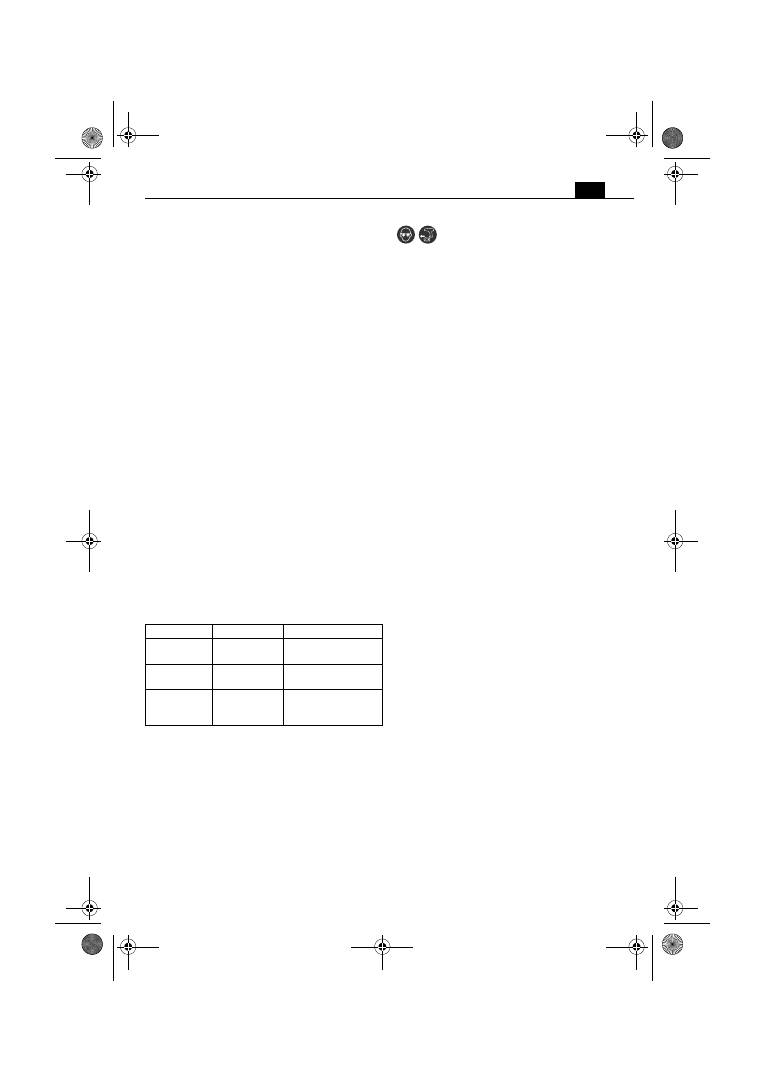
51
tr
Kullanıcıya binen titreşim yükünü tam olarak tahmin
edebilmek için, aletin kapalı veya açık olduğu halde
gerçekten kullanımda olmadığı süreler de dikkate
alınmalıdır. Bu, toplam çalışma süresinde kullanıcıya binen
titreşim yükünü önemli ölçüde azaltabilir.
Kullanıcıyı titreşim etkilerine karşı korumak üzere ek
güvenlik önlemleri tespit edin; örneğin: Elektrikli el
aletinin ve uçların bakımı, ellerin sıcak tutulması, iş
süreçlerinin organize edilmesi.
Çalışırken dikkat edilmesi gereken
hususlar.
Dönme yönü değiştirme şalterini sadece motor dururken
kullanın.
Örneğin taşıma esnasında yanlışlıkla çalıştırmayı önlemek
için dönme yönü değiştirme şalterini orta konuma getirin.
Aşırı ısınma durumunda elektrikli el aleti kısa ve düşük
performanslı impulslarla çalışır. Elektrikli el aletini boşta
çalıştırarak soğutun.
ASCT14/ASCT14M/ASCT18/ASCT18M:
Vidalama işleri
derinlik mesnedi takılı durumda yapılmalıdır.
ASCT14M/ASCT14UM/ASCT18M/ASCT18UM:
Vida
magazini sadece “dönme yönü sağ” konumunda
kullanılabilir.
Tork ayarı (ASCT14U/ASCT14UM/ASCT18U/
ASCT18UM) (Bakınız: Sayfa 7).
Aletin fabrikasyon ayarı küçük ve orta büyüklükte
vidalara göredir.
Sıkma torku aynı zamanda elektrikli el aletinin vidaya
doğru bastırılma kuvvetine de bağlıdır.
Akünün bakımı.
Aküyü sadece 0 °C – 45 °C (32 °F – 113 °F) arasındaki
akü işletme sıcaklığı arasında çalıştırın ve şarj edin. Akü
sıcaklığı şarj işlemi başladığında akü işletme sıcaklığı
arasında olmalıdır.
Akünün yüzde olarak gerçek şarj durumu sadece
elektrikli el aletinin motoru dorurken gösterilir.
Akü derin deşarj durumunda ise elektronik sistem
motoru otomatik olarak durdurur.
Bakım ve müşteri servisi.
Aşırı kullanım koşullarında metaller işlenirken
elektrikli el aletinin içinde iletken toz
birikebilir. Havalandırma aralıklarından kuru ve
yağsız basınçlı hava ile elektrikli el aletinin iç kısmını sık sık
temizleyin.
Bu elektrikli el aletinin güncel yedek parça listesini
İnternette www.fein.com. sayfasında bulabilirsiniz.
Aşağıdaki parçaları gerektiğinde kendiniz de
değiştirebilirsiniz:
Uçlar, derinlik mesnedi, akü, iskele
kancası, magazin
Teminat ve garanti.
Ürüne ilişkin teminat piyasaya sunulduğu ülkenin yasal
düzenlemeleri çerçevesinde geçerlidir. Ayrıca FEIN, FEIN
üretici garanti beyanına uygun bir garanti sağlar.
Elektrikli el aletinizin teslimat kapsamında bu kullanma
kılavuzunda tanımlanan veya şekli gösterilen aksesuarın
sadece bir parçası da bulunabilir.
Uyumluluk beyanı.
FEIN firması tek sorumlu olarak bu ürünün bu kullanım
kılavuzunun son sayfasında belirtilen ilgili koşullara uygun
olduğunu beyan eder.
Teknik belgelerin bulunduğu merkez: C. & E. FEIN
GmbH, C-DB_IA, D-73529 Schwäbisch Gmünd
Çevre koruma, tasfiye.
Ambalaj malzemesi, kullanım ömrünü tamamlamış
elektrikli el aletleri ve aksesuar çevre dostu geri kazanım
merkezine gönderilmelidir.
Aküleri sadece deşarj olmuş durumda ve çevre koruma
hükümlerine uygun olarak tasfiye yapacak bir merkeze
gönderin.
Tam olarak deşarj olmamış akülerde kısa devre tehlikesini
önlemek üzere bağlantı fişini yapışkan bantla izole edin.
LED gösterge
Anlamı
İşlem
1 – 4 yeşil
LED
Yüzde olarak
şarj durumu
İşletme
Sürekli
kırmızı ışık
Akü hemen
hemen boş
Aküyü şarj edin
Yanıp sönen
kırmızı ışık
Akü işletmeye
hazır değil
Aküyü akü işletme
sıcaklığı aralağına
getirin, sonra şarj edin
OBJ_BUCH-0000000072-001.book Page 51 Monday, June 18, 2012 8:40 AM
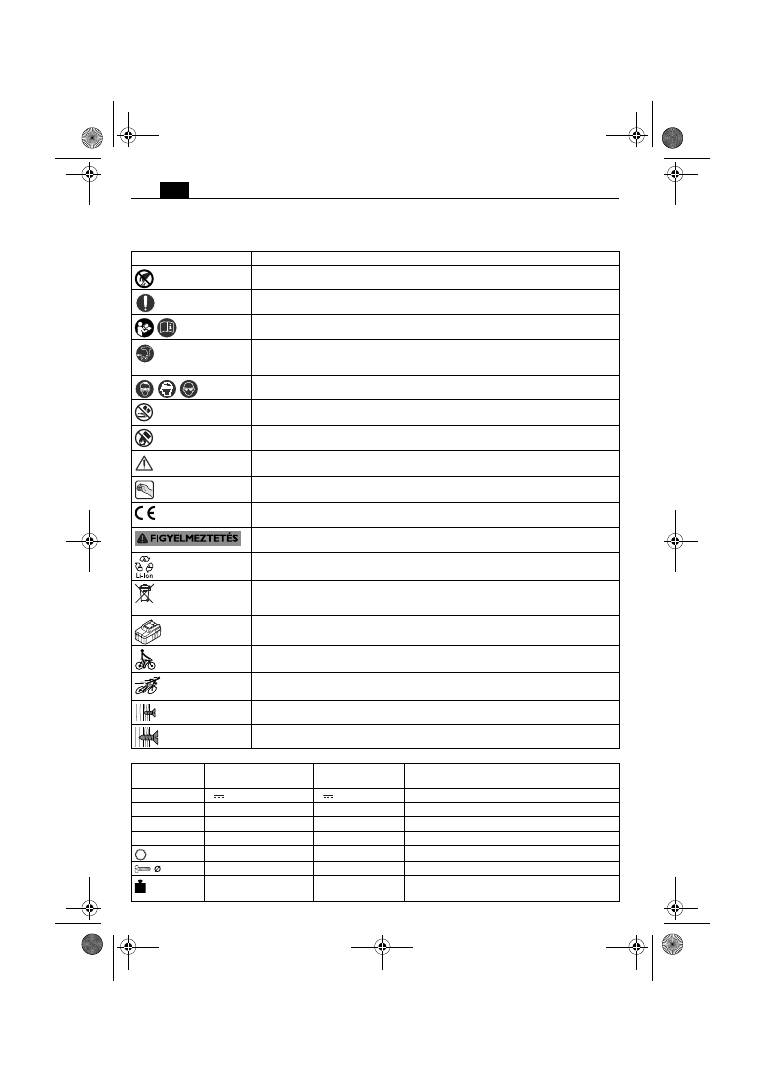
52
hu
hu
Akkumulátoros csavarozógép eredeti kezelési útmutató.
A használt jelölések és fogalmak.
Szimbólumok, jelek
Magyarázat
Ne érjen hozzá az elektromos kéziszerszám forgó alkatrészeihez.
Tartsa be az oldalsó szövegben vagy ábrán található utasításokat!
Mindenképpen olvassa el a mellékelt dokumentációt, mint például a kezelési útmutatót
és a biztonsági tájékoztatót.
Ezelőtt a lépés előtt távolítsa el az akkumulátort az elektromos kéziszerszámból.
Ellenkező esetben az elektromos kéziszerszám akaratlan elindulása sérüléseket
okozhat.
A munkák közben használjon védőszemüveget.
Ne töltsön fel megrongálódott akkumulátorokat.
Ne tegye ki az akkumulátort tűz hatásának. Óvja meg az akkumulátort a forróságtól,
például a tartós napsugárzástól.
Ügyeljen a jel mellett álló szövegben található tájékoztatásra!
Fogantyú-felület
A CE-jel igazolja, hogy az elektromos kéziszerszám megfelel az Európai Unió
irányelveinek.
Ez a tájékozató egy lehetséges veszélyes helyzetre figyelmeztet, amely súlyos vagy
halálos sérüléshez vezethet.
Újrafeldolgozás jel: az újraértékesíthető anyagokat jelöli
A használaton kívül helyezett elektromos kéziszerszámokat és egyéb elektrotechnikai
és elektromos termékeket külön össze kell gyűjteni és a környezetvédelmi
szempontoknak megfelelő újrafelhasználásra kell leadni.
Akkumulátor típus
Alacsony fordulatszám
Magas fordulatszám
A forgatónyomaték csökkentése
A forgatónyomaték növelése
Jel
Nemzetközi egység
Magyarországon
használatos egység
Magyarázat
U
V
V
Elektromos egyenfeszültség
n
0
/min, min
-1
, rpm, r/min
/perc
Üresjárati fordulatszám
n
1
/min, min
-1
, rpm, r/min
/perc
Fordulatszám terhelés alatt
M...
Nm
Nm
Forgatónyomaték (kemény/lágy csavarozás)
inch
coll
Belső hatlapos szerszámbefogó egység
mm
mm
Csavarátmérő
kg
kg
Súly az „EPTA-Procedure 01/2003” (2003/01
EPTA-szabvány) szerint
OBJ_BUCH-0000000072-001.book Page 52 Monday, June 18, 2012 8:40 AM

53
hu
Az Ön biztonsága érdekében.
Olvassa el az összes
biztonsági figyelmeztetést és
előírást.
A következőkben leírt előírások betartásának
elmulasztása áramütésekhez, tűzhöz és/vagy súlyos testi
sérülésekhez vezethet.
Kérjük a későbbi használatra gondosan őrizze meg ezeket
az előírásokat.
Ne használja ezt az elektromos kéziszerszámot,
mielőtt gondosan el nem olvasta és meg nem
értette ezt a kezelési útmutatót és a mellékelt
„Általános biztonsági tájékoztatót” (dokumentáció
száma: 3 41 30 054 06 1). A fent megnevezett
dokumentációt a későbbi használathoz őrizze meg és az
elektromos kéziszerszám továbbadása vagy eladása
esetén adja tovább az új tulajdonosnak.
Ugyanígy tartsa be az idevonatkozó helyi munkavédelmi
rendelkezéseket.
Az elektromos kéziszerszám rendeltetése:
ez a kézzel vezetett csavarozógép az időjárás hatásaitól
védett helyen a FEIN cég által engedélyezett
szerszámokkal és tartozékokkal, csavarok be- és
kihajtására, speciálisan a száraz építésnél gyors
építőanyagcsavarok be- és kihajtására szolgál.
Biztonsági információk.
Az elektromos kéziszerszámot csak a szigetelt
fogantyúfelületeknél fogva tartsa, ha olyan munkát
végez, amelynek során a csavar feszültség alatt álló,
kívülről nem látható vezetékekhez érhet.
Ha a
berendezés egy feszültség alatt álló vezetékhez ér, az
elektromos kéziszerszám fémrészei szintén feszültség alá
kerülhetnek és áramütéshez vezethetnek.
Ügyeljen a munkaterület alatt fekvő rejtett elektromos
vezetékekre, gáz- és vízcsövekre.
Ellenőrizze a munka
megkezdése előtt a munkaterületet, használjon ehhez
például egy fémkereső készüléket.
A megmunkálásra kerülő munkadarabot megfelelően
rögzítse.
Egy befogó szerkezettel rögzített munkadarab
biztonságosabban van rögzítve, mintha csak a kezével
tartaná.
Tartsa szorosan az elektromos kéziszerszámot.
Rövid
időre igen nagy nyomaték léphet fel.
Ne munkáljon meg a berendezéssel azbesztet tartalmazó
anyagokat.
Az azbesztnek rákkeltő hatása van.
Az elektromos kéziszerszámra táblákat és jeleket
csavarokkal vagy szegecsekkel felerősíteni tilos.
Egy
megrongálódott szigetelés már nem nyújt védelmet az
áramütés ellen. Használjon öntapadós matricákat.
Ne használjon olyan tartozékokat, amelyeket nem az
elektromos kéziszerszámot gyártó cég fejlesztett ki, vagy
amelynek használatát az nem engedélyezte.
Biztonságos
üzemelést csak úgy lehet elérni, ha a tartozék pontosan
hozzáillik az Ön elektromos kéziszerszámához.
Az akkumulátor (akkumulátor-blokk)
felhasználása és kezelése
Az akkumulátor kezelése során a veszélyeztetések, mint
égési sérülések, tűz, robbanás, bőrsérülések és egyéb
sérülések elkerülésére vegye tekintetbe az alábbi
előírásokat:
Az akkumulátorokat nem szabad szétszerelni, kinyítani
vagy feldarabolni. Ne tegye ki az akkumulátort
mechanikus lökéseknek.
Az akkumulátor
megrongálódása és szakszerűtlen használata esetén abból
káros gőzők és folyadékok léphetnek ki. A gőzök
ingerelhetik a légzőutakat. A kilépő akkumulátorfolyadék
bőrirritációkat vagy égéses bőrsérüléseket okozhat.
Ha az akkkumulátorból kilépő folyadék a szomszédos
tárgyakat benedvesíti, ellenőrizze és tisztítsa meg, illetve
szükség esetén cserélje ki ezeket a tárgyakat.
Ne tegye ki az akkumulátort héhatásnak, illetve tűz
behatásának. Ne tárolja az akkumulátort közvetlen
napsütésben.
Az akkumulátort csak akkor vegye ki az eredeti
csomagolásból, ha használni akarja.
Az elektromos kéziszerszámon végzendő bármely munka
megkezdése előtt vegye ki az akkumulátort az
elektromos kéziszerszámból.
Ha az elektromos
kéziszerszám akaratlanul elindul, sérülésveszély áll fenn.
Az akkumulátort csak kikapcsolt állapotú elektromos
kéziszerszámból vegye ki.
Tartsa távol az akkumulátort a gyerekektől.
Tartsa tisztán és folyadékoktól és víztől védve az
akkumulátort.
Az akkumulátor és az elektromos
kéziszerszám elszennyeződött csatlakozásait egy tiszta,
száraz kendővel tisztítsa meg.
L
pA
dB
dB
Hangnyomás szint
L
wA
dB
dB
Hangteljesítmény szint
L
pCpeak
dB
dB
Hangnyomásszint csúcsérték
K...
Szórás
m/s
2
m/s
2
A rezgéskibocsátási összérték (a három irányban
mért rezgés vektorösszege) az EN 60745
szabványnak megfelelően
h
m/s
2
m/s
2
Rezgéskibocsátási érték (csavarozás)
m, s, kg, A, mm, V,
W, Hz, N, °C, dB,
min, m/s
2
m, s, kg, A, mm, V,
W, Hz, N, °C, dB,
perc, m/s
2
Az
SI
nemzetközi egységrendszer alapegységei és
levezetett egységei.
Jel
Nemzetközi egység
Magyarországon
használatos egység
Magyarázat
OBJ_BUCH-0000000072-001.book Page 53 Monday, June 18, 2012 8:40 AM
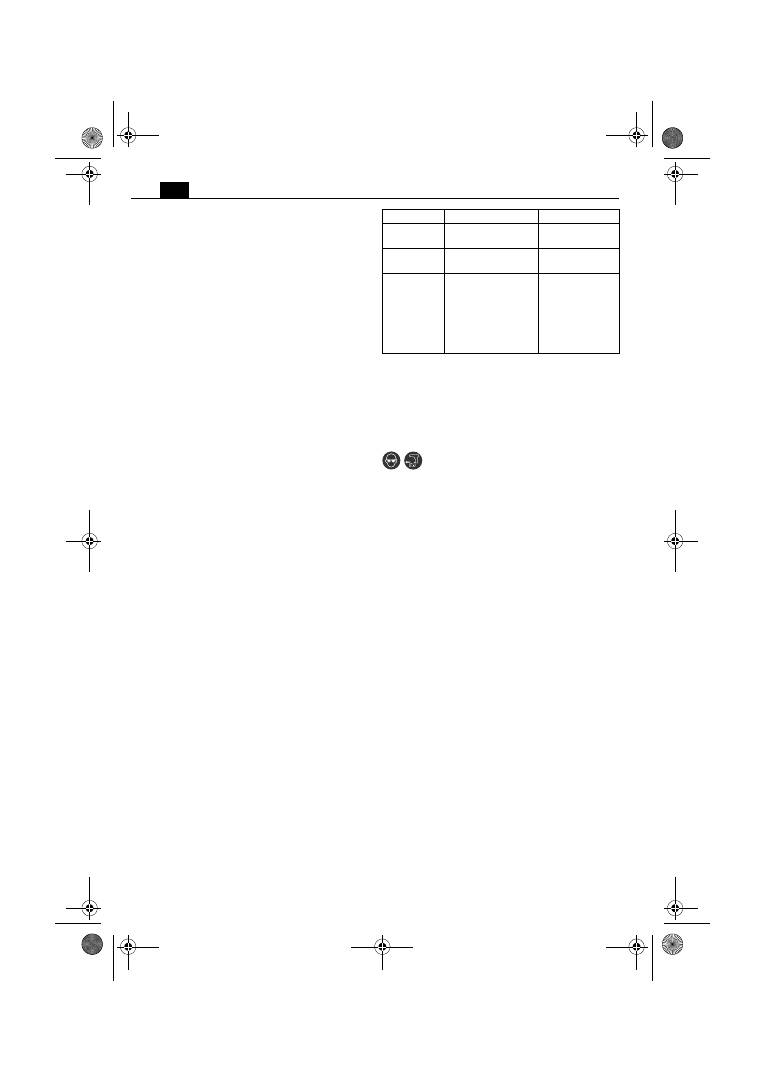
54
hu
Csak kifogástalan állapotú, eredeti FEIN akkumulátorokat
használjon, amelyek az Ön elektromos kéziszerszámához
vannak előirányzova.
A nem az elektromos
kéziszerszámhoz való, megrongálódott, javított vagy
újrafeldolgozott akkumulátorokkal, utánzatokkal és
idegen gyártmányú akkumulátorokkal végzett munka,
illetve az ilyen akkumulátorok feltöltése tűz- és/vagy
robbanásveszélyes.
Tartsa be az akkumulátor töltőkészülék kezelési
utasításában található biztonsági előírásokat.
Kéz-kar vibráció
Az ezen előírásokban megadott rezgésszint az EN 60745
szabványban rögzített mérési módszerrel került
meghatározásra és a készülékek összehasonlítására ez az
érték felhasználható. Az érték a rezgési terhelés
ideiglenes megbecsülésére is alkalmazható.
A megadott rezgésszint az elektromos kéziszerszám fő
alkalmazási területeire vonatkozik. Ha az elektromos
kéziszerszámot más célokra, eltérő szerszámokkal, vagy
nem kielégítő karbantartás mellett használják, a
rezgésszint a fenti értékektől eltérhet. Ez az egész
munkaidőre vonatkozó rezgési terhelést lényeges
mértékben megnövelheti.
A rezgési terhelés pontos megbecsüléséhez figyelembe
kell venni azokat az időszakokat is, amikor a berendezés
kikapcsolt állapotban van, vagy amikor be van ugyan
kapcsolva, de nem kerül ténylegesen használatra. Ez az
egész munkaidőre vonatkozó rezgési terhelést lényeges
mértékben csökkentheti.
Hozzon kiegészítő biztonsági intézkedéseket a
kezelőnek a rezgések hatása elleni védelmére, például: az
elektromos kéziszerszám és a szerszámok megfelelő
karbantartása, a kezek melegen tartása, a
munkafolyamatok átgondolt megszervezése.
Kezelési tájékoztató.
Az irányváltót csak álló motor mellett szabad átkapcsolni.
Állítsa a forgásirány-átkapcsolót a középső helyzetbe,
hogy például egy szállításnál elkerülje az akaratlan
üzembe helyezést.
Túlmelegedés esetén az elektromos kéziszerszám rövid,
alacsony teljesítményű impulzusokkal fut. Hagyja
alapjáratban lehűlni az elektromos kéziszerszámot.
ASCT14/ASCT14M/ASCT18/ASCT18M:
A csavarokat egy
felszerelt mélységhatároló alkalmazásával kell
becsavarozni.
ASCT14M/ASCT14UM/ASCT18M/ASCT18UM:
A
csavartárat csak a „jobbraforgási” helyzetben szabad
üzemeltetni.
A nyomaték beállítása (ASCT14U/ASCT14UM/
ASCT18U/ASCT18UM) (lásd a 7 oldalon).
A gyári beállítás a kisebbtől közepesig terjedő
csavarokhoz szükséges tartománynak felel meg.
A meghúzási nyomaték attól az erőtől is függ, amellyel az
elektromos kéziszerszámot rányomja a csavarra.
Az akkumulátor kezelése.
Az akkumulátort csak a 0 °C – 45 °C (32 °F – 113 °F)
hőmérséklet tartományban szabad üzemeltetni és tárolni.
Az akkumulátor hőmérsékletének a töltési folyamat
kezdetén az akkumulátor megengedett üzemeltetési
hőmérséklet tartományában kell lennie.
Az akkumulátor tényleges, százalékban megadott
feltöltési szintje csak az elektromos kéziszerszám álló
motorja mellett kerül kijelzésre.
Mielőtt az akkumulátor mélykisülése bekövetkezne, az
elektronika automatikusan kikapcsolja az elektromos
kéziszerszámot.
Üzemben tartás és vevőszolgálat.
Különösen hátrányos körülmények fennállása
esetén fémek megmunkálásakor az elektromos
kéziszerszám belsejébe elektromosan
vezetőképes por rakódhat le. Fújja ki gyakran az
elektromos kéziszerszám belső terét a szellőzőnyíláson
keresztül száraz és olajmentes préslevegővel.
Ennek az elektromos kéziszerszámnak a pillanatnyilag
érvényes pótalkatrész-listáját az Internetből a
www.fein.com címen találhatja meg.
A következő alkatrészeket szükség esetén Ön saját maga
is kicserélheti:
Szerszámok, mélységi ütköző,
akkumulátor, kampó, magazin
Jótállás és szavatosság.
A termékre vonatkozó jótállás a forgalomba hozási
országban érvényes törvényes rendelkezéseknek
megfelelően érvényes. Termékeinket ezen túlmenően a
FEIN jótállási nyilatkozatában leírtaknak megfelelő
kiterjesztett garanciával szállítjuk.
Az elektromos kéziszerszám szállítási terjedelmében
lehet, hogy az ezen kezelési útmutatóban leírásra vagy
ábrázolásra került tartozékoknak csak egy része található
meg.
Megfelelőségi nyilatkozat.
A FEIN egyedüli felelőséggel kijelenti, hogy ez a termék
megfelel az ezen kezelési útmutató utolsó oldalán
megadott idevonatkozó előírásoknak.
A műszaki dokumentáció a következő helyen található:
C. & E. FEIN GmbH, C-DB_IA,
D-73529 Schwäbisch Gmünd
Környezetvédelem, hulladékkezelés.
A csomagolásokat, a selejtes elektromos
kéziszerszámokat és tartozékokat a környezetvédelmi
szempontoknak megfelelően kell újra felhasználni.
Az akkumulátorokat csak kisütött állapotban adja le a
megfelelő mentesítésre.
Nem teljesen kisütött akkumulátorok esetén ragassza le
elővigyázatosságból, a rövidzárlatok megakadályozására a
dugós csatlakozó érintkezőit.
LED-kijelző
Magyarázat
Művelet
1 – 4 zöld
LED
Töltési szint kijelzés
százalékban
Üzemeltetés
piros tartós
fény
Az akkumulátor
majdnem üres
Töltse fel az
akkumulátort
piros villogó
fény
Az akkumulátor
nem üzemkész
Hozza az
akkumulátort a
megengedett
üzemeltetési
hőmérséklet
tartományba,
majd töltse fel
OBJ_BUCH-0000000072-001.book Page 54 Monday, June 18, 2012 8:40 AM

55
cs
cs
Původní návod k obsluze akumulátorového šroubováku.
Použité symboly, zkratky a pojmy.
Symbol, značka
Vysvětlení
Nedotýkejte se rotujících dílů elektronářadí.
Uposlechněte pokynů ve vedle stojícím textu nebo grafice!
Nezbytně čtěte přiložené dokumenty jako návod k obsluze a všeobecná bezpečnostní
upozornění.
Před tímto pracovním krokem odstraňte z elektronářadí akumulátor. Jinak existuje
nebezpečí poranění dané neúmyslným rozběhem elektronářadí.
Při práci použijte ochranu očí.
Nenabíjejte žádné poškozené akumulátory.
Nevystavujte akumulátor ohni. Akumulátor chraňte před horkem, např. i před trvalým
slunečním zářením.
Dbejte upozornění ve vedlejším textu!
Oblast uchopení
Potvrzuje shodu elektronářadí se směrnicemi evropského společenství.
Toto upozornění ukazuje možnou nebezpečnou situaci, která může vést k vážným
poraněním nebo smrti.
Značka recyklace: označuje recyklovatelné materiály
Vyřazené elektronářadí a další elektrotechnické a elektrické výrobky rozebrané
shromážděte a dodejte k opětovnému zhodnocení nepoškozujícímu životní prostředí.
Typ akumulátoru
Malý počet otáček
Velký počet otáček
Zmenšení kroutícího momentu
Zvětšení kroutícího momentu
Značka
Jednotka mezinárodní
Jednotka národní
Vysvětlení
U
V
V
Elektrické stejnosměrné napětí
n
0
/min, min
-1
, rpm, r/min
min
-1
Otáčky naprázdno
n
1
/min, min
-1
, rpm, r/min
min
-1
Počet otáček při zatížení
M...
Nm
Nm
Kroutící moment (tvrdý/měkký šroubový spoj)
inch
palec
Nástrojový držák vnitřní šestihran
mm
mm
Průměr šroubu
kg
kg
Hmotnost podle EPTA-Procedure 01/2003
L
pA
dB
dB
Hladina akustického tlaku
L
wA
dB
dB
Hladina akustického výkonu
L
pCpeak
dB
dB
Špičková hladina akustického tlaku
OBJ_BUCH-0000000072-001.book Page 55 Monday, June 18, 2012 8:40 AM
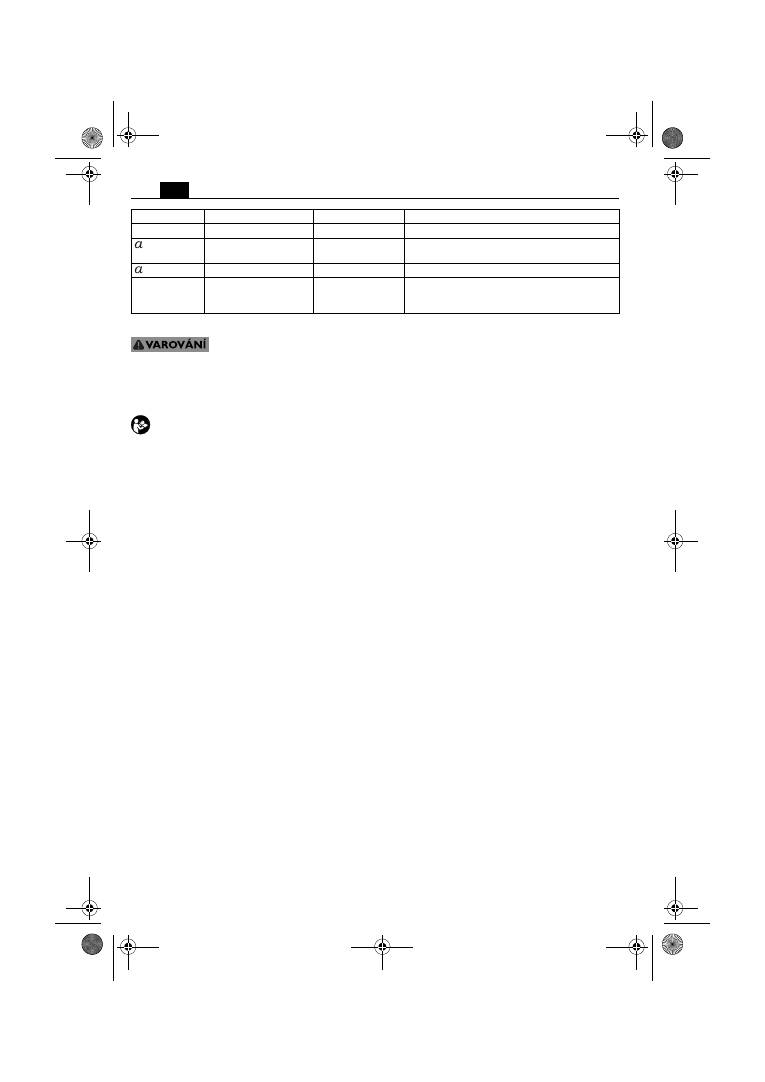
56
cs
Pro Vaši bezpečnost.
Čtěte všechna varovná upozornění a
pokyny.
Zanedbání při dodržování
varovných upozornění a pokynů mohou mít za následek
zásah elektrickým proudem, požár a/nebo těžká
poranění.
Všechna varovná upozornění a pokyny do budoucna
uschovejte.
Toto elektronářadí nepoužívejte, dokud jste si
důkladně nepřečetli a zcela neporozuměli tomuto
návodu k obsluze a též přiloženým „Všeobecným
bezpečnostním upozorněním“ (číslo spisu
3 41 30 054 06 1). Uchovejte uvedené podklady k
pozdějšímu použití a předejte je při zapůjčení nebo
prodeji elektronářadí.
Dbejte rovněž příslušných národních ustanovení ochrany
při práci.
Určení elektronářadí:
ruční šroubovák k zašroubování a vyšroubování šroubů,
speciálně pro nasazení v suchém zdění s rychlovývrtnými
šrouby, pomocí firmou FEIN schválených pracovních
nástrojů a příslušenstvím, v prostředí chráněném před
povětrnostními vlivy.
Speciální bezpečnostní předpisy.
Pokud provádíte práce, při kterých může šroub zasáhnout
skrytá elektrická vedení, pak držte elektronářadí na
izolovaných plochách rukojeti.
Kontakt s elektrickým
vedením pod napětím může přivést napětí i na kovové
části stroje a vést k zásahu elektrickým proudem.
Dbejte na skrytě položené elektrické vedení, plynové a
vodovodní potrubí.
Před začátkem práce zkontrolujte
pracovní oblast např. přístrojem na zjišťování kovů.
Zajistěte obrobek.
Obrobek držený upínacím přípravkem
je držen bezpečněji než ve Vaší ruce.
Držte elektronářadí dobře a pevně.
Krátkodobě mohou
nastat vysoké reakční momenty.
Neopracovávejte žádný materiál obsahující azbest.
Azbest je karcinogenní.
Je zakázáno šroubovat nebo nýtovat na elektronářadí
štítky nebo značky.
Poškozená izolace nenabízí žádnou
ochranu proti úderu elektrickým proudem. Použijte
nalepovací štítky.
Nepoužívejte žádné příslušenství, které nebylo speciálně
vyvinuto nebo povoleno výrobcem elektronářadí.
Bezpečný provoz není dán sám od sebe tím, že
příslušenství lícuje na Vaše elektronářadí.
Používání a zacházení s akumulátorem
(akumulátorovým blokem)
Pro zabránění rizikům, jako spáleniny, požár, výbuch,
poranění kůže a další zranění, dbejte při zacházení s
akumulátory následujících upozornění:
Akumulátory nesmějí být rozebírány, otevírány nebo
rozdrcovány. Nevystavujte akumulátory žádným
mechanickým rázům.
Při poškození a neurčeném použití
akumulátoru mohou vystupovat škodlivé výpary a
vytékat kapaliny. Výpary mohou dráždit dýchací cesty.
Vytékající kapalina akumulátoru může vést k
podrážděním kůže nebo popáleninám.
Pokud kapalina vytékající z poškozeného akumulátoru
potřísnila sousední předměty, zkontrolujte dotčené díly,
vyčistěte je nebo je popř. vyměňte.
Akumulátor nevystavujte horku ani ohni. Neuskladňujte
akumulátor na přímém slunečním světle.
Akumulátor vyjměte z originálního obalu až tehdy, když se
má použít.
Před prací na elektronářadí vyjměte z elektronářadí
akumulátor.
Pokud se elektronářadí neúmyslně
rozeběhne, existuje nebezpečí zranění.
Akumulátor odejměte pouze při vypnutém elektronářadí.
Udržujte akumulátory daleko od dětí.
Udržujte akumulátor čistý a chráněný před vlhkostí a
vodou.
Znečištěné přípojky akumulátoru a elektronářadí
vyčistěte pomocí suchého, čistého hadříku.
Používejte pouze neporušené, originální akumulátory
FEIN, jež jsou určeny pro Vaše elektronářadí.
Při nabíjení
a práci s nesprávným, poškozeným, opravovaným nebo
dotvářeným akumulátorem, s napodobeninami a cizími
výrobky existuje nebezpečí požáru a/nebo výbuchu.
Uposlechněte bezpečnostní upozornění v návodu k
obsluze nabíječky akumulátoru.
Vibrace rukou či paží
V těchto pokynech uvedená úroveň vibrací byla změřena
podle měřících metod normovaných v EN 60745 a může
být použita pro vzájemné porovnání elektronářadí. Hodí
se i pro předběžný odhad zatížení vibracemi.
Uvedená úroveň vibrací reprezentuje hlavní použití
elektronářadí. Pokud ovšem bude elektronářadí
nasazeno pro jiná použití, s odlišnými nasazovacími
nástroji nebo s nedostatečnou údržbou, může se úroveň
vibrací lišit. To může zatíženi vibracemi po celou
pracovní dobu zřetelně zvýšit.
K...
Nepřesnost
m/s
2
m/s
2
Hodnota emise vibrací podle EN 60745
(vektorový součet tří os)
h
m/s
2
m/s
2
Hodnota emise vibrací (šroubování)
m, s, kg, A, mm, V,
W, Hz, N, °C, dB,
min, m/s
2
m, s, kg, A, mm, V,
W, Hz, N, °C, dB,
min, m/s
2
Základní a odvozené jednotky z mezinárodní
soustavy jednotek
SI
.
Značka
Jednotka mezinárodní
Jednotka národní
Vysvětlení
OBJ_BUCH-0000000072-001.book Page 56 Monday, June 18, 2012 8:40 AM
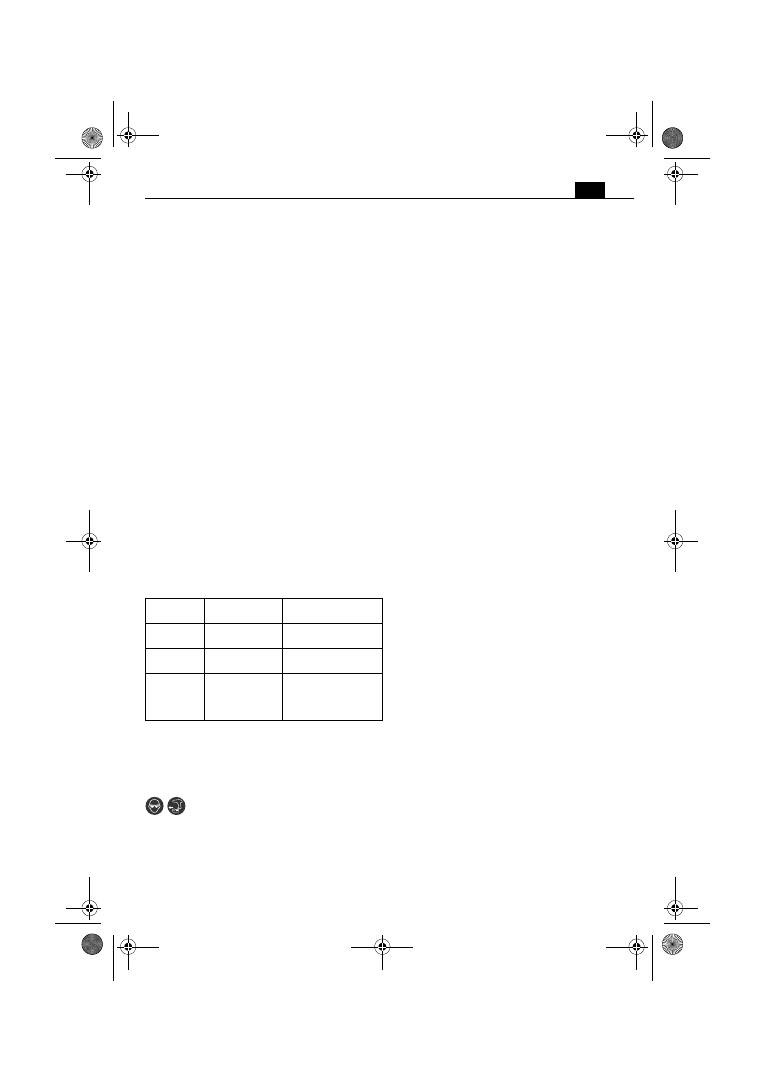
57
cs
Pro přesný odhad zatížení vibracemi by měly být
zohledněny i doby, v nichž je stroj vypnutý nebo sice
běží, ale fakticky není nasazen. To může zatíženi
vibracemi po celou pracovní dobu zřetelně zredukovat.
Stanovte dodatečná bezpečnostní opatření k ochraně
obsluhy před účinkem vibrací jako např.: údržba
elektronářadí a nasazovacích nástrojů, udržování teplých
rukou, organizace pracovních procesů.
Pokyny k obsluze.
Přepínač směru otáčení ovládejte pouze za stavu klidu
motoru.
Aby se zabránilo neúmyslnému uvedení do provozu,
např. při přepravě, dejte přepínač směru otáčení do
střední polohy.
Při přehřátí běží stroj s krátkými, nízkovýkonnými
impulsy. Elektronářadí nechte v běhu naprázdno ochladit.
ASCT14/ASCT14M/ASCT18/ASCT18M:
zašroubování
provádějte s namontovaným hloubkovým dorazem.
ASCT14M/ASCT14UM/ASCT18M/ASCT18UM:
zásobník
šroubů smí být provozován pouze v poloze „směr
otáčení vpravo“.
Nastavení kroutícího momentu (ASCT14U/
ASCT14UM/ASCT18U/ASCT18UM) (viz strana 7).
Nastavení z výroby odpovídá rozsahu pro menší až
středně velké šrouby.
Utahovací moment je závislý i na síle, kterou je
elektronářadí tlačeno proti šroubu.
Zacházení s akumulátorem.
Provozujte a nabíjejte akumulátor pouze v rozsahu
provozní teploty akumulátoru 0 °C – 45 °C (32 °F –
113 °F). Teplota akumulátoru musí být na začátku
procesu nabíjení v rozsahu provozní teploty.
Skutečný procentuální stav nabití akumulátoru se zobrazí
pouze při zastaveném motoru elektronářadí.
Při blížícím se hlubokém vybití akumulátoru zastaví
elektronika automaticky motor.
Údržba a servis.
Při extrémních podmínkách nasazení se může
při opracování kovů usazovat uvnitř
elektronářadí vodivý prach. Často vyfukujte
vnitřní prostor elektronářadí skrz větrací otvory suchým
tlakovým vzduchem bez oleje.
Aktuální seznam náhradních dílů tohoto elektronářadí
naleznete na internetu na www.fein.com.
Následující díly můžete, je-li třeba, vyměnit sami:
pracovní nástroje, hloubkový doraz, akumulátor, závěs,
zásobník
Záruka a ručení.
Záruka na výrobek platí podle zákonných ustanovení
země uvedení do provozu. Nad to navíc poskytuje firma
FEIN záruku podle prohlášení o záruce výrobce FEIN.
V obsahu dodávky Vašeho elektronářadí může být
obsažen i jen jeden díl příslušenství popsaného nebo
zobrazeného v tomto návodu k obsluze.
Prohlášení o shodě.
Firma FEIN prohlašuje ve výhradní zodpovědnosti, že
tento výrobek odpovídá příslušným ustanovením
uvedeným na poslední straně tohoto návodu k obsluze.
Technické podklady u: C. & E. FEIN GmbH, C-DB_IA,
D-73529 Schwäbisch Gmünd
Ochrana životního prostředí, likvidace.
Obaly, vyřazené elektronářadí a příslušenství dodejte k
opětovnému zhodnocení nepoškozujícímu životní
prostředí.
Akumulátory odevzdejte k řádné likvidaci pouze ve
vybitém stavu.
U ne zcela vybitých akumulátorů zaizolujte konektor
preventivně proti zkratu pomocí lepící pásky.
Ukazatel
LED
Význam
Akce
1 – 4 zelené
LED
Procentuální stav
nabití
Provoz
Červené
trvalé světlo
Akumulátor je
téměř prázdný
Akumulátor nabijte
Červené
blikající
světlo
Akumulátor není
připravený k
provozu
Akumulátor uveďte
do rozsahu provozní
teploty akumulátoru,
poté nabijte
OBJ_BUCH-0000000072-001.book Page 57 Monday, June 18, 2012 8:40 AM
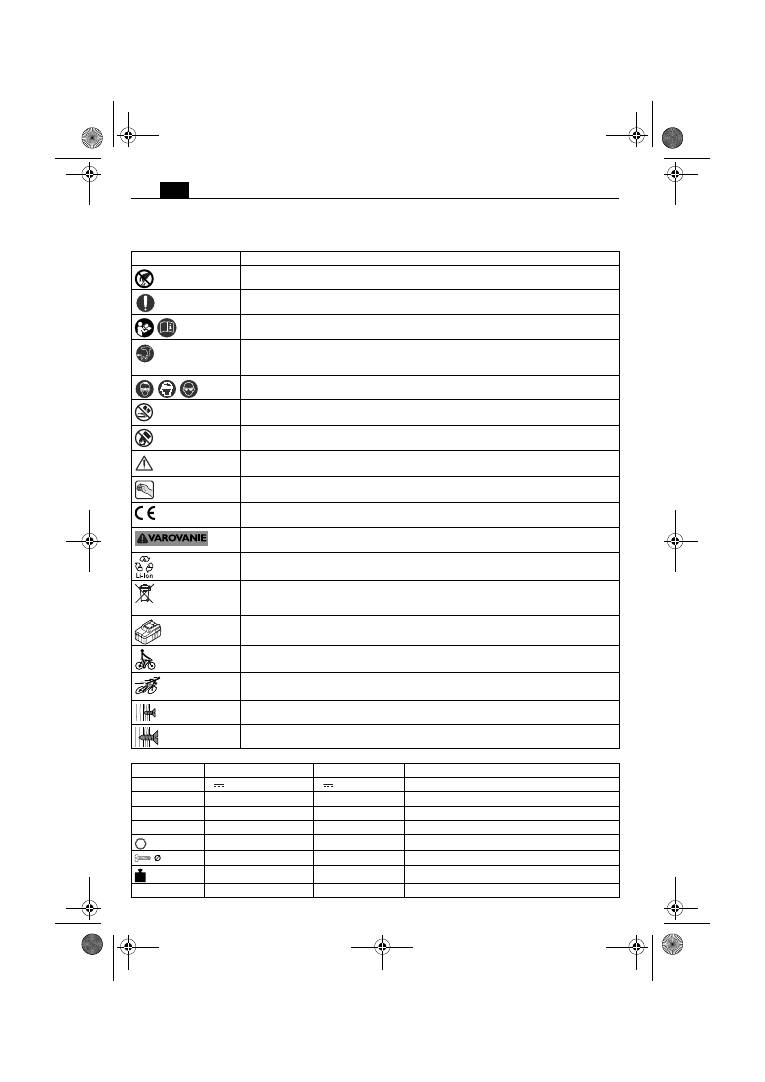
58
sk
sk
Originálny návod na použitie pre akumulátorový skrutkovač.
Používané symboly, skratky a pojmy.
Symbol, značka
Vysvetlenie
Nedotýkajte sa rotujúcich súčiastok ručného elektrického náradia.
Dodržiavajte pokyny uvedené v priloženom texte alebo na obrázkoch!
Bezpodmienečne si prečítajte priloženú dokumentáciu ako Návod na použitie a
Všeobecné bezpečnostné predpisy.
Pred týmto pracovným úkonom vyberte z ručného elektrického náradia akumulátor. Inak
hrozí následkom neúmyselného rozbehnutia ručného elektrického náradia
nebezpečenstvo poranenia.
Pri práci používajte pomôcku na ochranu zraku.
Nenabíjajte žiadne akumulátory, ktoré sú poškodené.
Nevystavujte akumulátor ohňu. Chráňte akumulátor pred horúčavou, napr. aj pred
trvalým slnečným žiarením.
Dodržiavajte upozornenia uvedené vo vedľajšom texte!
Uchopovacia časť náradia
Potvrdzuje konformitu ručného elektrického náradia so smernicami Európskeho
spoločenstva.
Toto upozornenie poukazuje na možnú nebezpečnú situáciu, ktorá môže viesť k vážnym
poraneniam alebo môže spôsobiť smrť.
Recyklovacia značka: označuje opätovne použiteľné materiály
Vyradené ručné elektrické náradie a iné elektrické a elektrotechnické výrobky zbierajte
ako triedený odpad a dajte ich na recykláciu zodpovedajúcu ochrane životného
prostredia.
Typ akumulátora
Nízky počet obrátok
Vysoký počet obrátok
Zmenšiť krútiaci moment
Zväčšiť krútiaci moment
Značka
Medzinárodná jednotka
Národná jednotka
Vysvetlenie
U
V
V
Jednosmerné elektrické napätie
n
0
/min, min
-1
, rpm, r/min
min
-1
Počet voľnobežných obrátok
n
1
/min, min
-1
, rpm, r/min
min
-1
Počet obrátok pri zaťažení
M...
Nm
Nm
Krútiaci moment (tvrdý/mäkký skrutkový spoj)
inch
inch
Upínací mechanizmus vnútorný šesťhran
mm
mm
Priemer skrutky
kg
kg
Hmotnosť podľa EPTA-Procedure 01/2003
L
pA
dB
dB
Hladina zvukového tlaku
OBJ_BUCH-0000000072-001.book Page 58 Monday, June 18, 2012 8:40 AM
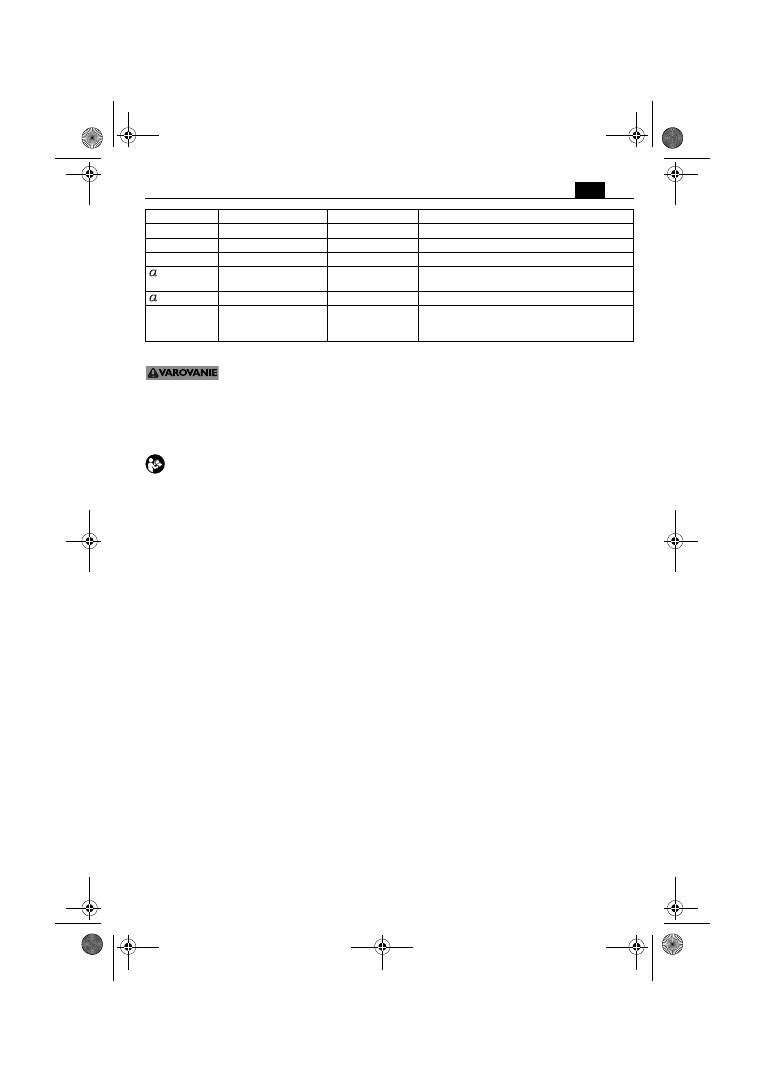
59
sk
Pre Vašu bezpečnosť.
Prečítajte si všetky Výstražné
upozornenia a bezpečnostné pokyny.
Zanedbanie dodržiavania Výstražných upozornení a
pokynov uvedených v nasledujúcom texte môže mať za
následok zásah elektrickým prúdom, spôsobiť požiar
a/alebo ťažké poranenie.
Tieto Výstražné upozornenia a bezpečnostné pokyny
starostlivo uschovajte na budúce použitie.
Nepoužívajte toto ručné elektrické náradie
predtým, ako si dôkladne prečítate tento Návod na
používanie ako aj priložené „Všeobecné
bezpečnostné pokyny“ (spisové číslo 3 41 30 054 06 1)
a kým úplne neporozumiete ich obsahu. Uvedené
podklady si dobre uschovajte na neskoršie použitie a v
prípade odovzdania ručného elektrického náradia alebo
predaja inej osobe ich odovzdajte s náradím.
Rovnako dodržiavajte aj príslušné národné ustanovenia o
ochrane zdravia pri práci.
Určenie ručného elektrického náradia:
ručne vedený skrutkovač na zaskrutkovávanie a
vyskrutkovávanie skrutiek, špeciálne pre suchú stavbu
pomocou rýchlomontážnych skrutiek v pásovom
zásobníku, pomocou pracovných nástrojov, ktoré
schválila firma FEIN, v prostredí chránenom pred vplyvmi
počasia.
Špeciálne bezpečnostné pokyny.
Držte ručné elektrické náradie len za izolované plochy
rukovätí, ak vykonávate takú prácu, pri ktorej by mohla
skrutka natrafiť na skryté elektrické vedenia.
Kontakt s
elektrickým vedením, ktoré je pod napätím, môže dostať
pod napätie aj kovové súčiastky náradia a spôsobiť zásah
elektrickým prúdom.
Dávajte pozor na skryté elektrické vedenia, plynové a
vodovodné potrubia.
Pred začiatkom práce
prekontrolujte priestor práce napr. pomocou hľadača
kovov.
Zabezpečte obrobok.
Obrobok upnutý pomocou
upínacieho zariadenia je bezpečnejší ako ten, ktorý
pridržiavate rukou.
Pri práci ručné elektrické náradie dobre držte.
Krátkodobo môžu vznikať veľké reakčné momenty.
Neobrábajte žiaden materiál, ktorý obsahuje azbest.
Azbest sa považuje za rakovinotvorný.
Je zakázané skrutkovať alebo nitovať na ručné elektrické
náradie nejaké štítky alebo značky.
Poškodená izolácia
neposkytuje žiadnu ochranu pred zásahom elektrickým
prúdom. Používajte samolepiace štítky.
Nepoužívajte žiadne príslušenstvo, ktoré nebolo
špeciálne vyvinuté alebo schválené výrobcom ručného
elektrického náradia.
Bezpečná prevádzka nie je
zaručená iba tým, že sa určité príslušenstvo na Vaše ručné
elektrické náradie hodí.
Používanie akumulátorov (akumulátorových
blokov) a manipulácia s nimi
Aby ste sa pri zaobchádzaní s akumulátormi vyhli
nebezpečenstvám ohrozenia zdravia ako popáleniny,
požiar, výbuch, poranenia kože a iné poranenia,
dodržiavajte nasledujúce pokyny:
Akumulátory sa nesmú rozoberať, otvárať ani deliť na
menšie kusy. Nevystavujte akumulátory žiadnym
mechanickým nárazom.
V prípade poškodenia alebo
neodborného používania akumulátora môžu z neho
vystupovať zdraviu škodlivé výpary alebo unikať
kvapaliny. Tieto výpary môžu podráždiť dýchacie cesty.
Unikajúca kvapalina z akumulátora môže mať za následok
podráždenie pokožky alebo spôsobiť popáleniny.
Ak kvapalina vytečená z akumulátora zasiahla aj okolité
predmety a súčiastky, zasiahnuté súčiastky skontrolujte
a v prípade potreby ich vyčistite alebo vymeňte.
Nevystavujte akumulátor horúčave alebo ohňu.
Neskladujte akumulátor na priamom slnečnom svetle.
Akumulátor vyberte z originálneho obalu až vtedy, keď ho
bude treba použiť.
Pred každou prácou na ručnom elektrickom náradí
vyberte z náradia akumulátor.
Ak by sa ručné elektrické
náradie nekontrolovane rozbehlo, hrozí nebezpečenstvo
poranenia.
Akumulátor vyberajte z ručného elektrického náradia iba
vtedy, keď je náradie vypnuté.
Akumulátory uschovávajte tak, aby k nim nemali prístup
deti.
Akumulátor udržiavajte v čistote a uschovávajte tak, aby
bol chránený pred vlhkosťou a vodou.
Znečistené prívody
(kontakty) akumulátora a ručného elektrického náradia
vyčistite suchou a čistou handričkou.
L
wA
dB
dB
Hladina akustického tlaku
L
pCpeak
dB
dB
Špičková hodnota hladiny akustického tlaku
K...
Nepresnosť merania
m/s
2
m/s
2
Hodnota emisie vibrácií podľa normy EN 60745
(súčet vektorov troch smerov)
h
m/s
2
m/s
2
Hodnota emisie vibrácií (skrutkovanie)
m, s, kg, A, mm, V,
W, Hz, N, °C, dB,
min, m/s
2
m, s, kg, A, mm, V,
W, Hz, N, °C, dB,
min, m/s
2
Základné a odvodené jednotky Medzinárodného
systému jednotiek
SI
.
Značka
Medzinárodná jednotka
Národná jednotka
Vysvetlenie
OBJ_BUCH-0000000072-001.book Page 59 Monday, June 18, 2012 8:40 AM
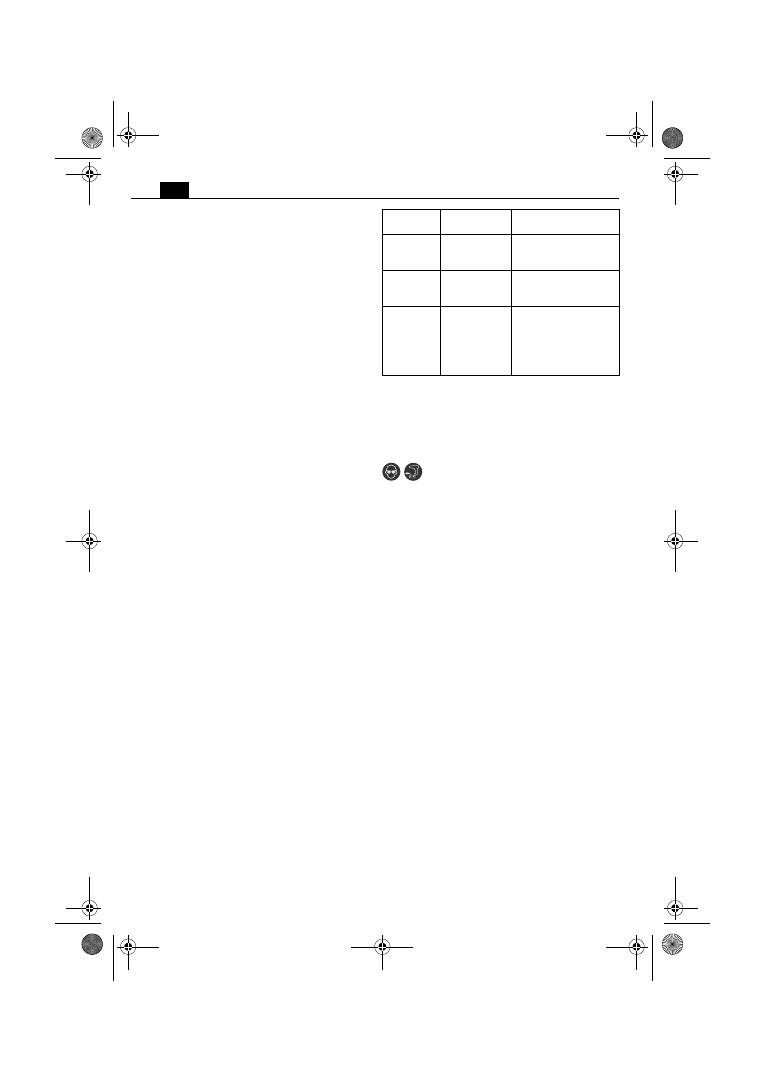
60
sk
Používajte len originálne akumulátory firmy FEIN, ktoré sú
určené do Vášho ručného elektrického náradia.
V prípade
používania a nabíjania nevhodných, poškodených,
opravovaných alebo upravovaných akumulátorov,
rôznych napodobnenín alebo výrobkov iných firiem,
hrozí nebezpečenstvo požiaru a/alebo výbuchu.
Dodržiavajte bezpečnostné pokyny uvedené v Návode na
používanie nabíjačky akumulátorov.
Vibrácie ruky a predlaktia
Úroveň vibrácií uvedená v týchto pokynoch bola
nameraná podľa meracieho postupu uvedeného v norme
EN 60745 a možno ju používať na vzájomné
porovnávanie rôznych typov ručného elektrického
náradia. Hodí sa aj na predbežný odhad zaťaženia
vibráciami.
Uvedená hladina zaťaženia vibráciami reprezentuje
hlavné druhy používania tohto ručného elektrického
náradia. Avšak v takých prípadoch, keď sa toto ručné
elektrické náradie využíva na iné druhy použitia, s
odlišnými pracovnými nástrojmi, alebo ak sa podrobuje
nedostatočnej údržbe, môže sa hladina zaťaženia
vibráciami od týchto hodnôt odlišovať. To môže výrazne
zvýšiť zaťaženie vibráciami počas celej pracovnej doby.
Na presný odhad zaťaženia vibráciami počas určitého
časového úseku práce s náradím treba zohľadniť doby,
počas ktorých je ručné elektrické náradie vypnuté alebo
doby, keď je náradie síce zapnuté a beží, ale v skutočnosti
nepracuje. Táto okolnosť môže výrazne redukovať
zaťaženie vibráciami počas celej pracovnej doby.
Na ochranu osoby pracujúcej s náradím pred účinkami
zaťaženia vibráciami vykonajte ďalšie bezpečnostné
opatrenia, ako sú napríklad: Údržba ručného
elektrického náradia a používaných pracovných
nástrojov, zabezpečenie zachovania teploty rúk,
organizácia jednotlivých pracovných úkonov.
Návod na používanie.
S prepínačom smeru otáčania manipulujte len vtedy, keď
je motor náradia vypnutý.
Nastavte prepínač smeru otáčania do strednej polohy,
aby ste zabránili prípadnému neúmyselnému zapnutiu
ručného elektrického náradia, napríklad pri transporte.
Pri prehriatí beží ručné elektrické náradie iba v krátkych
impulzoch so slabým výkonom.
ASCT14/ASCT14M/ASCT18/ASCT18M:
Skrutkové spoje
vykonávajte s namontovaným hĺbkovým dorazom.
ASCT14M/ASCT14UM/ASCT18M/ASCT18UM:
Pásový
zásobník na skrutky sa smie používať len v polohe „Smer
otáčania doprava“.
Nastavenie krútiaceho momentu (ASCT14U/
ASCT14UM/ASCT18U/ASCT18UM) (pozri strana 7).
Nastavenie z výrobného závodu zodpovedá rozsahu pre
malé až stredne veľké skrutky.
Uťahovací moment závisí aj od sily, ktorou je ručné
elektrické náradie pritláčané na skrutku.
Manipulácia s akumulátorom.
Akumulátor používajte a nabíjajte len v pri teplotách
v rámci rozsahu prevádzkových teplôt akumulátora
0 °C – 45 °C (32 °F – 113 °F). Na začiatku nabíjania musí
byť teplota akumulátora v rámci rozsahu prevádzkových
teplôt akumulátora.
Skutočný stav nabitia akumulátora v percentách sa
zobrazí iba pri zastavenom motore ručného elektrického
náradia.
Ak by malo nastať hlboké vybitie akumulátora,
integrovaná elektronika motor automaticky zastaví.
Údržba a autorizované servisné stredisko.
Pri extrémnych prevádzkových podmienkach
sa môže pri obrábaní kovov vo vnútri ručného
elektrického náradia usádzať jemný dobre
vodivý prach. Vnútorný priestor ručného elektrického
náradia často pravidelne prefúkajte cez vetracie otvory
suchým tlakovým vzduchom, ktorý neobsahuje olej.
Aktuálny zoznam náhradných súčiastok pre toto ručné
elektrické náradie nájdete na Internete na domovskej
stránke www.fein.com.
V prípade potreby vymeňte nasledujúce súčiastky:
Pracovné nástroje, hĺbkový doraz, akumulátor, hák na
upevnenie na lešenie, zásobník
Zákonná záruka a záruka výrobcu.
Zákonná záruka na produkt platí podľa zákonných
predpisov v krajine uvedenia do prevádzky. Firma FEIN
okrem toho poskytuje záruku podľa vyhlásenia výrobcu
FEIN o záruke.
V základnej výbave Vášho ručného elektrického náradia
sa môže nachádzať len časť príslušenstva popísaného
alebo zobrazeného v tomto Návode na používanie.
Vyhlásenie o konformite.
Firma FEIN vyhlasuje na svoju výlučnú zodpovednosť, že
tento produkt sa zhoduje s príslušnými normatívnymi
dokumentmi uvedenými na poslednej strane tohto
Návodu na používanie.
Technické podklady sa nachádzajú na adrese:
C. & E. FEIN GmbH, C-DB_IA,
D-73529 Schwäbisch Gmünd
Ochrana životného prostredia, likvidácia.
Obaly, výrobky, ktoré doslúžili, a príslušenstvo dajte na
recykláciu zodpovedajúcu ochrane životného prostredia.
Akumulátory dávajte na predpísanú likvidáciu len vo
vybitom stave.
V takom prípade, keď nie sú akumulátory úplne vybité, na
zabránenie proti skratom zaizolujte ich kontakty
pomocou izolačnej pásky.
Indikácia
LED
Význam
Akcia
1 – 4
Zelené
diódy LED
percentuálny
stav nabitia
Používanie (prevádzka)
Trvalé
červené
svetlo
Akumulátor je
takmer
prázdny
Akumulátor nabíjajte
Červené
blikajúce
svetlo
Akumulátor
nie je
pripravený na
používanie
Zabezpečte teplotu
akumulátora v rámci
teplotách v rámci
rozsahu prevádzkových
teplôt akumulátora,
potom ho nabíjajte
OBJ_BUCH-0000000072-001.book Page 60 Monday, June 18, 2012 8:40 AM
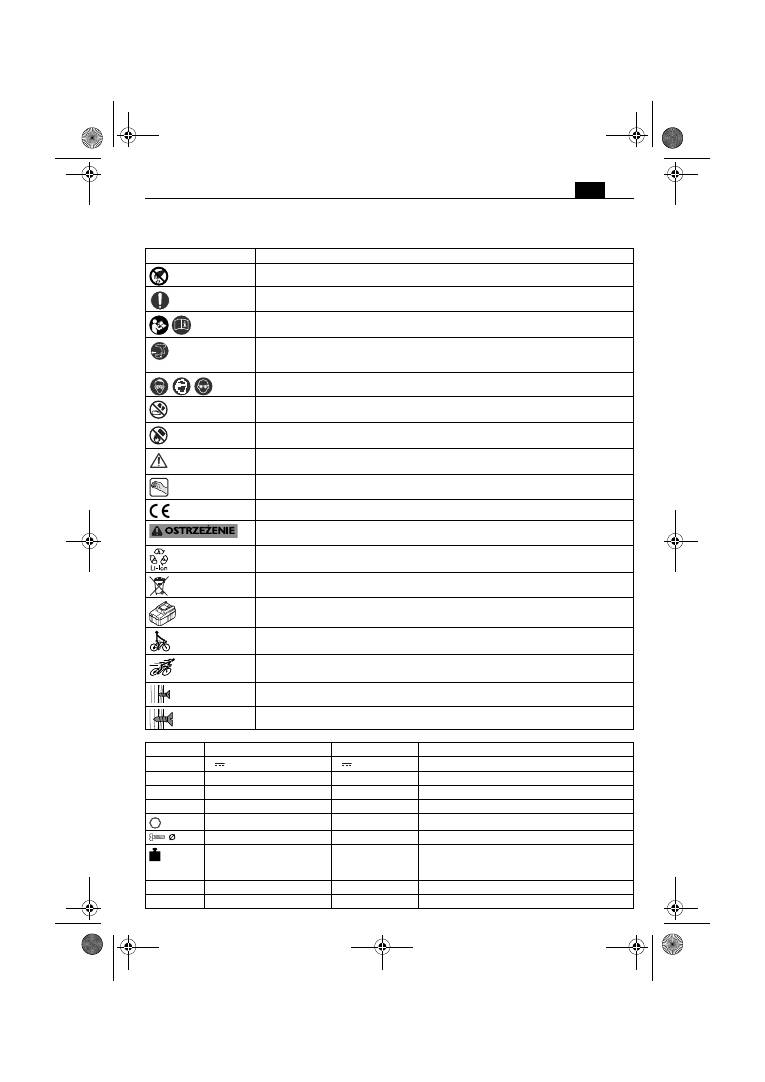
61
pl
pl
Instrukcja oryginalna eksploatacji wkrętarek akumulatorowych.
Użyte symbole, skróty i pojęcia.
Symbol, znak
Objaśnienie
Nie należy dotykać części elektronarzędzia będących w ruchu.
Należy stosować się do zaleceń zawartych w znajdującym się obok tekście lub na rysunku!
Załączone dokumenty, tzn. instrukcję eksploatacji i ogólne wskazówki bezpieczeństwa
należy koniecznie przeczytać.
Przed przystąpieniem do tych czynności należy usunąć akumulator z elektronarzędzia. W
przeciwnym wypadku istnieje niebezpieczeństwo obrażeń przez niezamierzony rozruch
elektronarzędzia.
Podczas pracy należy używać środków ochrony oczu.
Nie wolno ładować uszkodzonych akumulatorów.
Nie wolno zbliżać akumulatora do ognia. Akumulatory należy chronić przed wysokimi
temperaturami, np. przed stałym nasłonecznieniem.
Należy przestrzegać wskazówek w tekście obok!
Zakres chwytania
Potwierdza zgodność budowy elektronarzędzia z wytycznymi Wspólnoty Europejskiej.
Nieprzestrzeganie tej wskazówki może doprowadzić do poważnych urazów ciała lub
nawet utraty życia.
Znaczek recyklingu: oznacza przydatność materiałów do ponownego przetwórstwa
Wyeliminowane elektronarzędzia i inne produkty elektrotechniczne i elektryczne należy
zbierać oddzielnie i poddać utylizacji zgodnie z zasadami ochrony środowiska.
Rodzaj akumulatora
Niska prędkość obrotowa
Wysoka prędkość obrotowa
Zmniejszanie momentu obrotowego
Zwiększanie momentu obrotowego
Znak
Jednostka międzynarodowa
Jednostka lokalna
Objaśnienie
U
V
V
Elektryczne napięcie stałe
n
0
/min, min
-1
, rpm, r/min
/min.
Prędkość obrotowa bez obciążenia
n
1
/min, min
-1
, rpm, r/min
/min.
Prędkość obrotowa pod obciążeniem
M...
Nm
Nm
Moment obrotowy (wkręcanie twarde/miękkie)
inch
inch (cal)
Uchwyt narzędziowy z gniazdem sześciokątnym
mm
mm
Średnica śrub i wkrętów
kg
kg
Ciężar zgodny z EPTA-Procedure 01/2003
(= z metodą Europejskiej Parlamentarnej
Weryfikacji Technologii)
L
pA
dB
dB
Poziom hałasu
L
wA
dB
dB
Poziom mocy akustycznej
OBJ_BUCH-0000000072-001.book Page 61 Monday, June 18, 2012 8:40 AM

62
pl
Dla własnego bezpieczeństwa.
Należy przeczytać wszystkie
wskazówki i przepisy.
Błędy w
przestrzeganiu poniższych wskazówek mogą spowodować
porażenie prądem, pożar i/lub ciężkie obrażenia ciała.
Należy starannie przechowywać wszystkie przepisy i
wskazówki bezpieczeństwa dla dalszego zastosowania.
Nie należy używać elektronarzędzia przed
uważnym przeczytaniem i zrozumieniem niniejszej
instrukcji eksploatacji, jak również załączonych
„Ogólnych wskazówek bezpieczeństwa“ (numer
3 41 30 054 06 1). Dokumenty te należy zachować do
dalszych zastosowań i przekazać je oddając lub
sprzedając elektronarzędzie.
Należy przestrzegać również odpowiednich przepisów
krajowych w zakresie bezpieczeństwa elektrycznego i
higieny pracy.
Przeznaczenie elektronarzędzia:
ręczna wkrętarka, przeznaczona do wkręcania i
wykręcania śrub i wkrętów, w szczególności do
skręcania prefabrykatów za pomocą śrub szybkiego
montażu, w odpowiednich warunkach atmosferycznych i
przy zastosowaniu zatwierdzonych przez firmę FEIN
narzędzi roboczych i osprzętu.
Szczególne przepisy bezpieczeństwa.
Podczas wykonywania prac, przy których śruba mogłaby
natrafić na ukryte przewody elektryczne,
elektronarzędzie należy trzymać wyłącznie za izolowane
powierzchnie rękojeści.
Kontakt z przewodem sieci
zasilającej może spowodować przekazanie napięcia na
części metalowe urządzenia, co mogłoby spowodować
porażenie prądem elektrycznym.
Należy uważać na leżące w ukryciu przewody
elektryczne, rury gazowe i wodociągowe.
Przed
rozpoczęciem pracy należy skontrolować zakres pracy,
np. używając urządzenia do wykrywania metalu.
Należy używać urządzeń mocujących lub imadła do
zamocowania obrabianego przedmiotu.
W przypadku,
gdy obrabiany przedmiot trzymany jest w ręku,
bezpieczna obsługa urządzenia jest niemożliwa.
Elektronarzędzie należy mocno trzymać.
Możliwe jest
wystąpienie krótkotrwałych wysokich momentów
odrzutu.
Nie należy obrabiać materiału zawierającego azbest.
Azbest jest rakotwórczy.
Zabronione jest przykręcanie lub nitowanie tabliczek i
znaków na elektronarzędziu.
Uszkodzona izolacja nie
daje żadnej ochrony przed porażeniem prądem. Należy
używać naklejek.
Nie należy używać osprzętu, który nie został
wyprodukowany lub dopuszczony przez producenta
elektronarzędzia.
Fakt, iż dany osprzęt pasuje na
elektronarzędzie nie gwarantuje bezpieczeństwa pracy.
Zastosowanie i obsługa akumulatora (akumulatora
blokowego)
Aby uniknąć zagrożeń takich jak pożar, wybuch,
obrażenia skóry lub inne skaleczenia, należy obchodzić
się z akumulatorem przestrzegając następujących
wskazówek:
Nie wolno rozkładać, otwierać lub przycinać
akumulatorów. Należy chronić akumulatory przed
mechanicznymi uderzeniami.
Uszkodzenie akumulatora
lub zastosowanie go w sposób niezgodny z
przeznaczeniem może doprowadzić do wystąpienia
niebezpiecznych oparów lub wycieku niebezpiecznych
substancji. Opary mogą podrażnić drogi oddechowe.
Wyciekający elektrolit może doprowadzić do
podrażnienia skóry lub oparzeń.
Jeżeli wyciekający elektrolit zamoczył znajdujące się w
pobliżu elementy, należy skontrolować zamoczone
elementy, oczyścić je lub w razie potrzeby wymienić.
Akumulator należy chronić przed wysokimi
temperaturami i przed ogniem. Akumulatora nie wolno
przechowywać w nasłonecznionym miejscu.
Akumulator należy wyjmować z oryginalnego opakowania
krótko przed przystąpieniem do jego eksploatacji.
Przed przystąpieniem do jakichkolwiek prac przy
elektronarzędziu należy wyjąć z niego akumulator.
Niezamierzone uruchomienie elektronarzędzia niesie za
sobą niebezpieczeństwo skaleczenia.
Akumulator wyjmować wolno wyłącznie przy wyłączonym
elektronarzędziu.
Akumulatory należy trzymać z dala od dzieci.
Akumulator należy utrzymywać w czystości i chronić go
przed wilgocią i kontaktem z wodą.
Zabrudzone styki
akumulatora i elektronarzędzia należy czyścić suchą i
czystą szmatką.
Stosować należy wyłącznie oryginalne akumulatory firmy
FEIN, przeznaczone do danego rodzaju elektronarzędzia.
Podczas pracy z niewłaściwymi, uszkodzonymi,
reperowanymi lub przerabianymi akumulatorami, a także
z podróbkami lub akumulatorami innych producentów,
oraz podczas ich ładowania może dojść do pożaru lub
eksplozji.
Należy stosować się do wskazówek bezpieczeństwa
znajdujących się w instrukcji użytkowania ładowarki
akumulatorów.
L
pCpeak
dB
dB
Szczytowy poziom emisji ciśnienia akustycznego
K...
Niepewność
m/s
2
m/s
2
Wartości łączne drgań (suma wektorowa z trzech
kierunków) oznaczone zgodnie z EN 60745
h
m/s
2
m/s
2
Wartości łączne drgań (wkręcanie)
m, s, kg, A, mm, V,
W, Hz, N, °C, dB,
min, m/s
2
m, s, kg, A, mm, V,
W, Hz, N, °C, dB,
min, m/s
2
Jednostki podstawowe i jednostki pochodne wg
Międzynarodowego Układu Jednostek Miar
SI
.
Znak
Jednostka międzynarodowa
Jednostka lokalna
Objaśnienie
OBJ_BUCH-0000000072-001.book Page 62 Monday, June 18, 2012 8:40 AM

63
pl
Drgania działające na organizm człowieka przez
kończyny górne
Podany w niniejszej instrukcji poziom drgań pomierzony
został zgodnie z określoną przez normę EN 60745
procedurą pomiarową i może zostać użyty do
porównywania elektronarzędzi. Można go też użyć do
wstępnej oceny ekspozycji na drgania.
Podany poziom drgań jest reprezentatywny dla
podstawowych zastosowań elektronarzędzia. Jeżeli
elektronarzędzie użyte zostanie do innych zastosowań
lub z innymi narzędziami roboczymi, a także, jeśli nie
będzie wystarczająco konserwowane, poziom drgań
może odbiegać od podanego. Podane powyżej
przyczyny mogą spowodować podwyższenie ekspozycji
na drgania podczas całego czasu pracy.
Aby dokładnie ocenić ekspozycję na drgania, trzeba
wziąć pod uwagę także okresy, gdy urządzenie jest
wyłączone lub, gdy jest wprawdzie włączone, ale nie jest
używane do pracy. W ten sposób łączna (obliczana na
pełny wymiar czasu pracy) ekspozycja na drgania może
okazać się znacznie niższa.
Należy wprowadzić dodatkowe środki bezpieczeństwa,
mające na celu ochronę operatora przed skutkami
ekspozycji na drgania, np.: konserwacja elektronarzędzia
i narzędzi roboczych, zabezpieczenie odpowiedniej
temperatury rąk, ustalenie kolejności operacji roboczych.
Wskazówki dotyczące obsługi.
Przełącznik kierunku obrotów uruchamiać wolno
wyłącznie przy wyłączonym silniku.
Ustawić przełącznik kierunku obrotów w położeniu
środkowym, aby uniknąć niezamierzonego
uruchomienia narzędzia, np. podczas transportu.
Przegrzane elektronarzędzie pracuje krótkimi małowy-
dajnymi impulsami Należy doprowadzić do schłodzenia
elektronarzędzia, puszczając go na biegu jałowym.
ASCT14/ASCT14M/ASCT18/ASCT18M:
Połączeń
śrubowych należy dokonywać z zamocowanym
ogranicznikiem głębokości.
ASCT14M/ASCT14UM/ASCT18M/ASCT18UM:
Magazynek
na śruby można stosować tylko w pozycji „kierunek
obrotów w prawo“.
Ustawianie momentu obrotowego (ASCT14U/
ASCT14UM/ASCT18U/ASCT18UM) (zob. str. 7).
Elektronarzędzie zostało ustawione fabrycznie do
wkręcania mniejszych i średniej wielkości śrub.
Moment obrotowy jest uzależniony też od siły, z jaką
elektronarzędzie przyciśnięte zostanie do śruby.
Obchodzenie się z akumulatorami.
Użytkowanie i ładowanie akumulatora dozwolone jest
tylko wówczas, gdy akumulator znajduje się w zakresie
temperatur roboczych leżącym między 0 °C – 45 °C
(32 °F – 113 °F). Temperatura akumulatora na początku
ładowania musi znajdować się w zakresie temperatur
roboczych akumulatora.
Prawdziwy stan naładowania akumulatora ukazany
zostanie w procentach tylko przy wyłączonym silniku
elektronarzędzia.
Przed zbliżającym się głębokim wyładowaniem się
akumulatora, układ elektroniczny elektronarzędzia
automatycznie wyłącza silnik.
Konserwacja i serwisowanie.
Obróbka metali w ekstremalnych warunkach
może spowodować osadzenie się wewnątrz
elektronarzędzia pyłu metalicznego, będącego
w stanie przewodzić prąd. Należy często przedmuchiwać
wnętrze elektronarzędzia (przez otwory wentylacyjne)
za pomocą suchego i bezolejowego powietrza
sprężonego.
Aktualna lista części zamiennych dla niniejszego
elektronarzędzia znajduje się pod adresem
internetowym www.fein.com.
W razie potrzeby możliwa jest wymiana we własnym
zakresie następujących elementów:
Narzędzia robocze,
ogranicznik głębokości, akumulator, hak mocujący,
magazynek
Rękojmia i gwarancja.
Rękojmia na produkt jest ważna zgodnie z ustawowymi
przepisami regulującymi w kraju, w którym produkt
został wprowadzony do obrotu. Oprócz tego produkt
objęty jest gwarancją firmy FEIN, zgodnie z deklaracją
gwarancyjną producenta.
W zakres dostawy nabytego elektronarzędzia może
wchodzić tylko część ukazanego na rysunkach lub
opisanego w instrukcji eksploatacji osprzętu.
Oświadczenie o zgodności.
Firma FEIN oświadcza z pełną odpowiedzialnością, że
niniejszy produkt zgodny jest z odpowiednimi
postanowieniami podanymi na ostatniej stronie niniejszej
instrukcji eksploatacji.
Dokumentacja techniczna: C. & E. FEIN GmbH,
C-DB_IA, D-73529 Schwäbisch Gmünd
Ochrona środowiska, usuwanie odpadów.
Opakowanie, zużyte elektronarzędzia i osprzęt należy
dostarczyć do utylizacji zgodnie z przepisami z ochrony
środowiska.
Akumulatory należy oddawać do punktu utylizacji w
stanie rozładowanym.
Jeżeli akumulator nie rozładował się całkowicie, styki
należy zakleić taśmą izolującą, w celu uniknięcia zwarcia.
Wskaźnik LED Znaczenie
Akcja
1 – 4 zielone
diody LED
Procentualny
stan stopnia
naładowania
akumulatora
Eksploatacja
Czerwone
światło ciągłe
Akumulator
jest prawie
całkowicie
rozładowany
Naładować
akumulator
Czerwone
światło
migające
Akumulator
nie jest
gotowy do
eksploatacji
Przed przystąpieniem
do ładowania
akumulator musi
mieścić się w zakresie
temperatur roboczych
akumulatora
Wskaźnik LED Znaczenie
Akcja
OBJ_BUCH-0000000072-001.book Page 63 Monday, June 18, 2012 8:40 AM
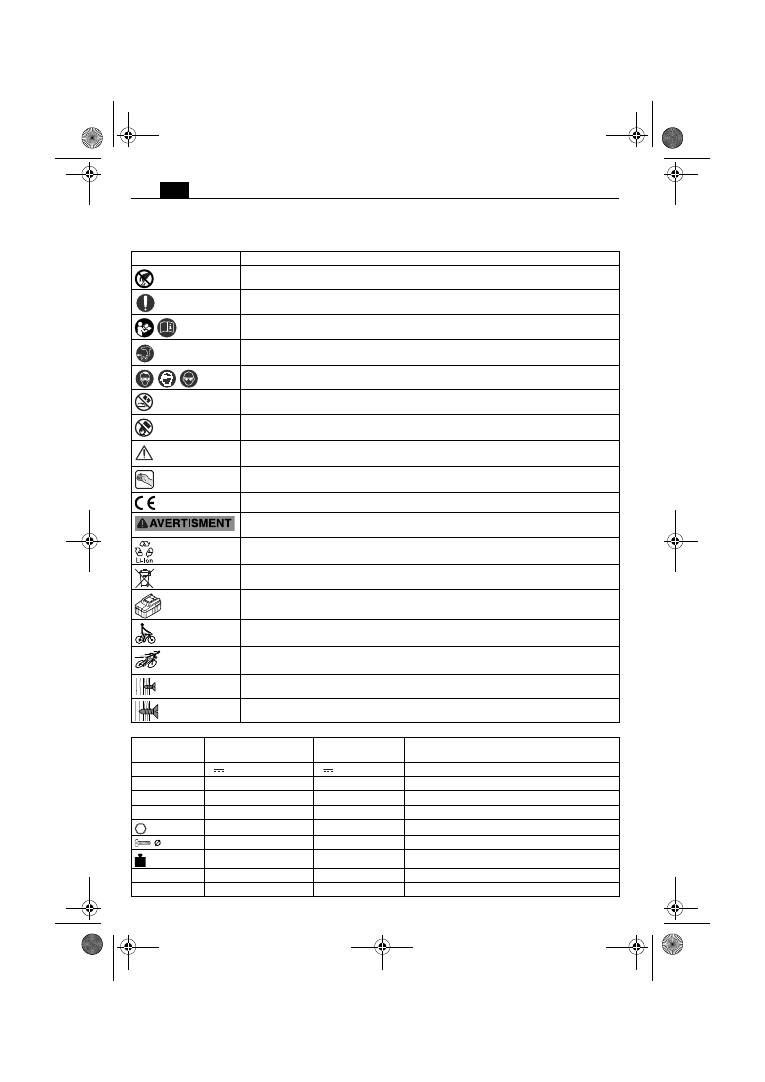
64
ro
ro
Instrucţiuni de utilizare originale pentru şurubelniţa cu acumulator.
Simboluri, prescurtări şi termeni utilizaţi.
Simbol, semn
Explicaţie
Nu atingeţi componentele sculei electrice care se rotesc.
Respectaţi instrucţiunile din textul sau schiţa alăturată!
Citiţi neapărat documentele alăturate precum instrucţiunile de utilizare şi indicaţiile de
ordin general privind siguranţa şi potecţia muncii.
Înaintea acestei etape de lucru, scoateţi acumulatorul de pe maşina electrică. În caz contrar
pornirea accidentală a sculei electrice poate provoca leziuni.
În timpul lucrului folosiţi ochelari de protecţie.
Nu puneţi la încărcat acumulatori defecţi.
Nu expuneţi acumulatorul la foc. Protejaţi acumulatorul împotriva căldurii, de exemplu
împotriva expunerii permanente la radiaţii solare.
Respectaţi indicaţiile din textul alăturat!
Suprafaţă de prindere
Certifică conformitatea sculei electrice cu Normele Comunităţii Europene.
Această indicaţie avertizează asupra posibilităţii de producere a unei situaţii periculoase
care poate duce la accidentare.
Simbol pentru reciclare: marchează materialele reciclabile
Colectaţi separat sculele electrice şi alte produse electronice şi electrice scoase din uz şi
direcţionaţi-le către o staţie de reciclare ecologică.
Tip acumulator
Turaţie mică
Turaţie mare
Reduceţi momentul de torsiune
Măriţi momentul de torsiune
Simbol
Unitate de măsură
internaţională
Unitate de măsură
naţională
Explicaţie
U
V
V
Curent electric continuu
n
0
/min, min
-1
, rpm, r/min
rot/min
Turaţie de mers în gol
n
1
/min, min
-1
, rpm, r/min
rot/min
Turaţie în sarcină
M...
Nm
Nm
Moment de torsiune (înşurubare dură/moale)
inch
inch
Sistem de prindere accesorii cu hexagon interior
mm
mm
Diametru şuruburi
kg
kg
Greutate conform EPTA-Procedure 01/2003
L
pA
dB
dB
Nivel presiune sonoră
L
wA
dB
dB
Nivel putere sonoră
OBJ_BUCH-0000000072-001.book Page 64 Monday, June 18, 2012 8:40 AM
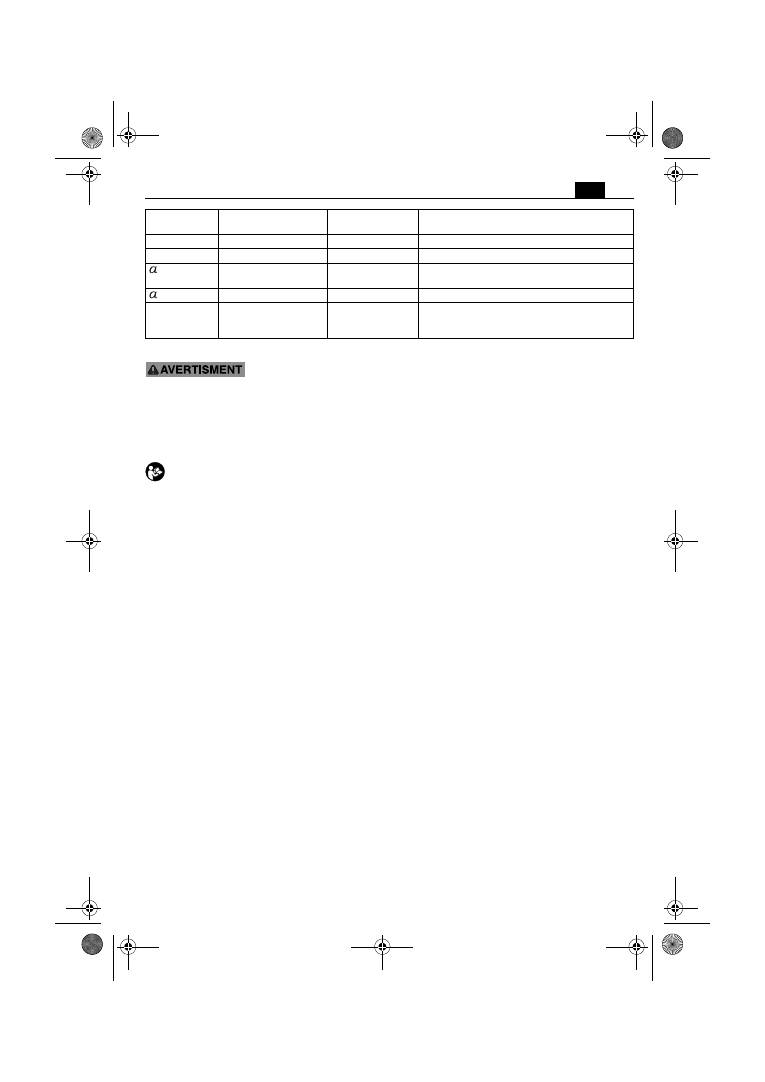
65
ro
Pentru siguranţa dumneavoastră.
Citiţi toate instrucţiunile şi
indicaţiile privind siguranţa şi
protecţia muncii.
Nerespectarea instrucţiunilor şi
indicaţiilor privind siguranţa şi protecţia muncii poate
duce la electrocutare, incendiu şi/sau provoca leziuni
grave.
Păstraţi în vederea unei utilizări viitoare toate
instrucţiunile şi indicaţiile privind siguranţa şi protecţia
muncii.
Nu folosiţi această sculă electrică înainte de a citi
temeinic şi a înţelege în întregime prezentele
instrucţiuni de utilizare cât şi „Instrucţiunile de
ordin general privind siguranţa şi protecţia muncii“
(număr document 3 41 30 054 06 1) alăturate. Păstraţi
documentaţia amintită în vederea unei utilizări ulterioare
şi transmiteţi-le mai departe în cazul predării sau
înstrăinării sculei electrice.
Respectaţi deasemenea normele naţionale de protecţia
muncii.
Destinaţia sculei electrice:
şurubelniţă manuală pentru înşurubarea şi deşurubarea
de şuruburi, adecvată în special pentru prinderea
şuruburilor cu filet rapid în gips carton, cu ajutorul
accesoriilor admise de FEIN, în mediu protejat împotriva
intemperiilor.
Instrucţiuni speciale privind siguranţa şi protecţia
muncii.
Prindeţi scula electrică de mânerele izolate atunci când
executaţi operaţii în cursul cărora dispozitivul de fixare
poate atinge conductori ascunşi.
Contactul cu un
conductor aflat sub tensiune poate pune sub tensiune şi
componentele metalice ale sculei electrice şi provoca
electrocutare.
Aveţi grijă la conductorii electrici ascunşi, conductele de
gaz şi de apă ascunse.
Înainte de a începe lucrul
controlaţi, de ex. cu un detector de metale, sectorul de
lucru.
Asiguraţi piesa de lucru.
O piesă de lucru fixată cu un
dispozitiv de prindere este ţinută mai sigur decât atunci
când o prindeţi numai cu mâna.
Prindeţi strâns scula electrică.
Pentru scurt timp pot
apărea forţe de reacţie puternice.
Nu prelucraţi materiale care conţin azbest.
Azbestul se
consideră a fi cancerigen.
Este interzisă înşurubarea sau nituirea de plăcuţe şi
embleme pe scula electrică.
O izolaţie deteriorată nu
oferă protecţie împotriva electrocutării. Folosiţi etichete
autocolante.
Nu folosiţi accesorii care nu au fost realizate sau
autorizate în mod special de fabricantul sculei electrice.
Utilizarea în condiţii de siguranţă nu este garantată numai
prin faptul că accesoriul resprectiv se potriveşte la scula
dumneavoastră electrică.
Utilizarea şi manevrarea acumulatorului
(pachetului de acumulatori)
Pentru evitarea situaţiilor periculoase cum ar fi arsurile,
incendiul, explozia, răniri ale pielii şi alte răniri în timpul
manipulării acumulatorilor, vă rugăm să respectaţi
următoarele indicaţii:
Nu este permisă demontarea, deschiderea şi
dezasamblarea acumulatorilor. Nu expuneţi acumulatorii
şocurilor mecanice.
În caz de deteriorare a
acumulatorului şi utilizare neconformă destinaţiei, din
acesta se pot degaja vapori şi se pot scurge lichide nocive.
Vaporii pot irita căile respiratorii. Lichidul scurs din
acumulator poate duce la iritaţii sau arsuri ale pielii.
În cazul în care lichidul scurs din acumulatorul deteriorat
a umectat obiectele învecinate, verificaţi piesele
respective, curăţaţi-le sau, dacă este necesar, înlocuiţi-le.
Nu expuneţi acumulatorul la căldură sau la foc. Nu
depozitaţi acumulatorul în lumina directă a soarelui.
Înainte de a-l utiliza, extrageţi acumulatorul din
ambalajul său original.
Înaintea oricăror intervenţii asupra sculei electrice,
detaşaţi acumulatorul de pe aceasta.
În cazul în care
scula electrică porneşte accidental, există pericol de
rănire.
Detaşaţi acumulatorul de pe scula electrică numai după
ce în prealabil aţi oprit-o.
Ţineţi acumulatorii la loc inaccesibil copiilor.
Păstraţi acumulatorul curat şi protejaţi-l de umezeală şi
apă.
Curăţaţi contactele murdare ale acumulatorului şi ale
sculei electrice cu o lavetă uscată, curată.
Folosiţi numai acumulatori intacţi, originali FEIN, destinaţi
sculei dumneavoastră electrice.
În timpul lucrului şi la
încărcarea unor acumulatori deterioraţi, reparaţi sau
modificaţi, a unor produse contrafăcute şi de fabricaţie
străină, există pericol de incendiu şi/sau explozie.
Respectaţi indicaţiile privind siguranţa cuprinse în
instrucţiunile de utilizare ale încărcătorului.
L
pCpeak
dB
dB
Nivel maxim putere sonoră
K...
Incertitudine
m/s
2
m/s
2
Valoarea vibraţiilor emise conform EN 60745
(suma vectorială a trei direcţii)
h
m/s
2
m/s
2
Valoarea vibraţiilor emise (înşurubare)
m, s, kg, A, mm, V,
W, Hz, N, °C, dB,
min, m/s
2
m, s, kg, A, mm, V,
W, Hz, N, °C, dB,
min, m/s
2
Unităţi de măsură de bază sau derivate din
Sistemul Internaţional
SI
.
Simbol
Unitate de măsură
internaţională
Unitate de măsură
naţională
Explicaţie
OBJ_BUCH-0000000072-001.book Page 65 Monday, June 18, 2012 8:40 AM
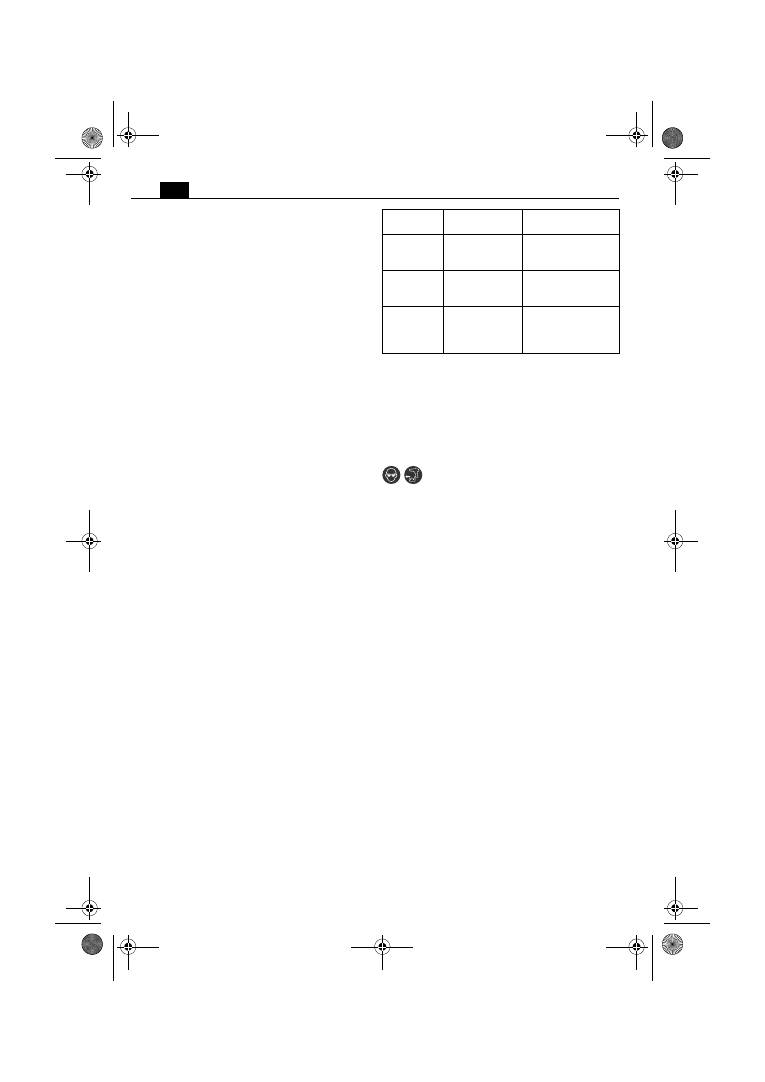
66
ro
Vibraţii mână-braţ
Nivelul vibraţiilor specificat în prezentele instrucţiuni a
fost măsurat conform unei proceduri de măsurare
standardizate în EN 60745 şi poate fi utilizat la
compararea sculelor electrice între ele.
Nivelul specificat al vibraţiilor se referă la utilizările
principale ale sculei electrice. Desigur în cazul în care
scula electrică va fi folosită pentru alte utilizări, cu
dispozitive de lucru neautorizate sau nu va beneficia de o
întreţinere corespunzătoare, nivelul vibraţiilor poate fi
diferit. Aceasta poate mări considerabil expunerea la
vibraţii calculată pe tot intervalul de lucru.
Pentru o evaluare precisă a expunerii la vibraţii ar trebui
luate în considerare şi perioadele de timp în care scula
electrică este oprită sau este în funcţiune dar nu este
folosită efectiv. Aceasta ar putea reduce semnificativ
expunerea la vibraţii calculată cumulativ pe întregul
interval de lucru.
Adoptaţi măsuri suplimentare privind siguranţa, pentru a
proteja operatorul împotriva efectelor vibraţiilor, ca de
exemplu: întreţinerea sculei electrice şi a dispozitivelor
de lucru, menţinerea la cald a mâinilor, organizarea
raţională a proceselor de lucru.
Instrucţiuni de utilizare.
Acţionaţi comutatorul direcţiei de rotaţie numai când
motorul este oprit.
Aduceţi comutatorul sensului de rotaţie în poziţia din
mijloc pentru a evita pornirea involuntară a sculei
electrice, de exemplu în timpul transportului.
În caz de supraîncălzire, scula electrică funcţionează cu
impulsuri scurte de putere redusă. Lăsaţi scula electrică să
meargă în gol pentru a se răci.
ASCT14/ASCT14M/ASCT18/ASCT18M:
Înşurubările se vor
efectua cu limitatorul de reglare a adâncimii montat.
ASCT14M/ASCT14UM/ASCT18M/ASCT18UM:
Magazia de
şuruburi poate fi utilizată numai poziţia corespunzătoare
direcţiei spre dreapta a rotaţiei.
Reglarea momentului de torsiune (ASCT14U/
ASCT14UM/ASCT18U/ASCT18UM) (vezi pagina 7).
Reglajul din fabrică corespunde domeniului adecvat
şuruburilor de dimensiuni mai mici până la medii.
Momentul de strângere depinde şi de forţa cu care se
apasă scula electrică pe şurub.
Manipularea acumulatorului.
Folosiţi şi încărcaţi acumulatorul numai în domeniul
temperaturiloir de lucru de 0 °C – 45 °C (32 °F – 113 °F).
În momentul începerii procesului de încărcare,
temperatura acumulatorului trebuie să fie în domeniul
temperaturilor de lucru ale acumulatorului.
Nivelul procentual real de încărcare a acumulatorului este
afişat numai atunci când motorul sculei electrice este
oprit.
Înainte de a se ajunge la descărcarea profundă a
acumulatorului, sistemul electronic opreşte automat
motorul.
Întreţinere şi asistenţă service
post-vânzări.
În cazul unor condiţii de utilizare extrem de
grele, la prelucrarea metalelor, în interiorul
sculei electrice se poate depune praf bun
conducător electric. Suflaţi frecvent aer comprimat uscat
şi fără ulei prin orificiile de aerisire în interiorul sculei
electrice.
Găsiţi lista actuală de piese de schimb pentru această sculă
electrică pe internet, la www.fein.com.
Puteţi schimba şi singuri, dacă este necesar, următoarele
piese:
accesorii, limitator de reglare a adâncimii,
acumulator, cârlig prindere pe schelă, magazie
Garanţia legală de conformitate şi
garanţia comercială.
Garanţia legală de conformitate a produsului se acordă
conform reglementărilor legale din ţara punerii în
circulaţie a acestuia. În plus, FEIN acordă o garanţie
comercială conform certificatului de garanţie al
producătorului FEIN.
Setul de livrare al sculei dumneavoastră electrice poate să
cuprindă numai o parte a accesoriilor descrise sau
ilustrate în prezentele instrucţiuni de folosire.
Declaraţie de conformitate.
Firma FEIN declară pe proprie răspundere că acest
produs corespunde prevederilor specificate la ultima
pagină a prezentelor instrucţiuni de utilizare.
Documentaţie tehnică la: C. & E. FEIN GmbH, C-DB_IA,
D-73529 Schwäbisch Gmünd
Protecţia mediului înconjurător,
eliminare.
Ambalajele, sculele electrice şi accesoriile scoase din uz
trebuie direcţionate către o staţie de reciclare ecologică.
După ce mai întâi i-aţi descărcat, direcţionaţi acumulatorii
către un punct de colectare a deşeurilor sortate.
În cazul în care acumulatorii nu sunt complet descărcaţi,
ca o măsură preventivă, izolaţi conectorii acestuia cu
bandă adezivă.
Indicator cu
LED-uri
Semnificaţie
Acţiune
LED verde
1 – 4
nivel de
încărcare în
procente
Funcţionare
lumină roşie
continuă
Acumulatorul
este aproape
descărcat
Încărcaţi
acumulatorul
lumină roşie
intermitentă
Acumulatorul nu
este pregătit de
funcţionare
Aduceţi acumulatorul
în domeniul
temperaturilor de
lucru, apoi încărcaţi-l
OBJ_BUCH-0000000072-001.book Page 66 Monday, June 18, 2012 8:40 AM
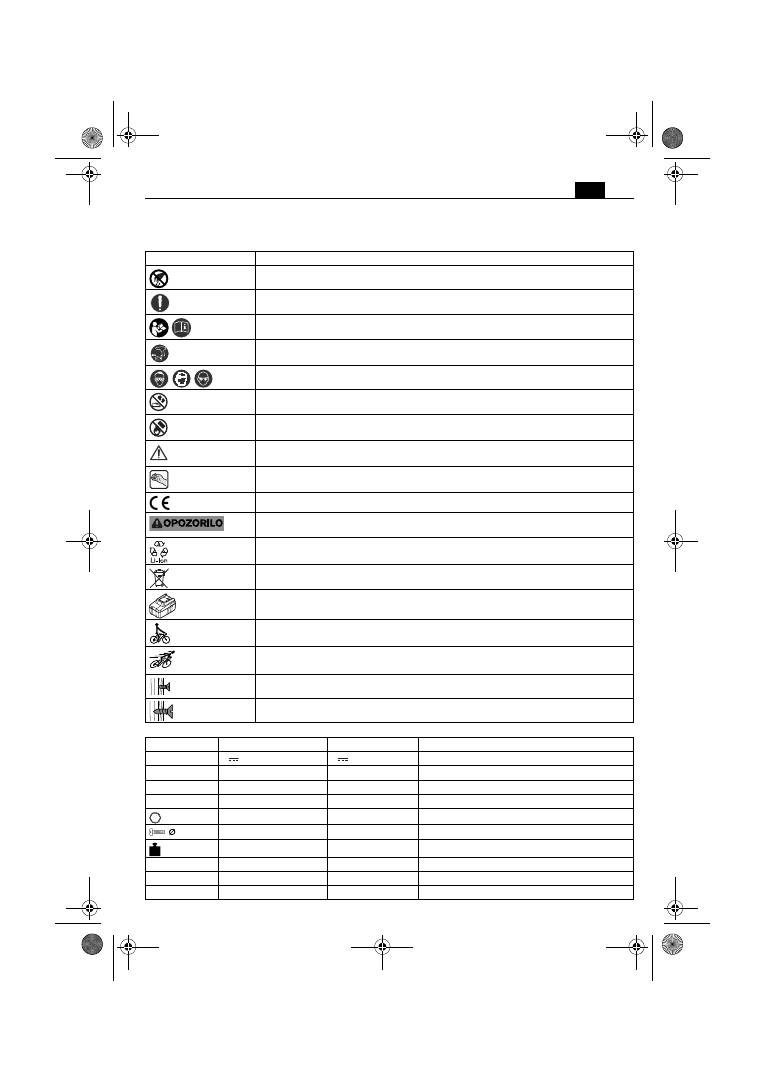
67
sl
sl
Originalno navodilo za obratovanje akumulatorskega vijačnika.
Uporabljeni simboli, kratice in pojmi.
Simbol, znaki
Razlaga
Ne dotikajte se rotirajočih delov električnega orodja.
Sledite navodilom bližnjega besedila ali slike!
Nujno preberite priloženo dokumentacijo, kot je to Navodilo za obratovanje in Splošna
varnostna navodila.
Pred tem delovnim korakom odstranite akumulatorsko baterijo iz električnega orodja.
Sicer obstaja nevarnost poškodb zaradi nenamernega vklopa električnega orodja.
Pri delu morate uporabljati zaščito za oči.
Ne smete polniti poškodovanih akumulatorskih baterij.
Zavarujte akumulatorsko baterijo pred ognjem. Zaščitite akumulatorsko baterijo pred
vročino, npr. tudi pred stalno izpostavljenostjo soncu.
Upoštevajte opozorila, ki se nahajajo zraven!
Področje držala
Potrdilo o skladnosti električnega orodja z direktivami Evropske skupnosti.
To opozorilo prikazuje možno nevarno situacijo, ki lahko privede do resnih poškodb ali
smrti.
Znak za reciklažo: označuje materiale, ki jih je možno reciklirati.
Ločeno zbirajte električna orodja in druge elektrotehnične in električne proizvode in
poskrbite za njihovo okolju prijazno recikliranje.
Tip akumulatorske baterije
Majhno število vrtljajev
Veliko število vrtljajev
Zmanjšanje vrtilnega momenta
Povečanje vrtilnega momenta
Znaki
Mednarodna enota
Nacionalna enota
Razlaga
U
V
V
Električna enosmerna napetost
n
0
/min, min
-1
, rpm, r/min
/min
Število vrtljajev pri prostem teku
n
1
/min, min
-1
, rpm, r/min
/min
Število vrtljajev med obremenitvijo
M...
Nm
Nm
Vrtilni moment (trd/mehki primer vijačenja)
inch
palec, col
Šestrobno prijemalo orodja
mm
mm
Premer vijaka
kg
kg
Teža v skladu z EPTA-Procedure 01/2003
L
pA
dB
dB
Nivo hrupa
L
wA
dB
dB
Moč hrupa
L
pCpeak
dB
dB
Najvišji nivo hrupa
OBJ_BUCH-0000000072-001.book Page 67 Monday, June 18, 2012 8:40 AM
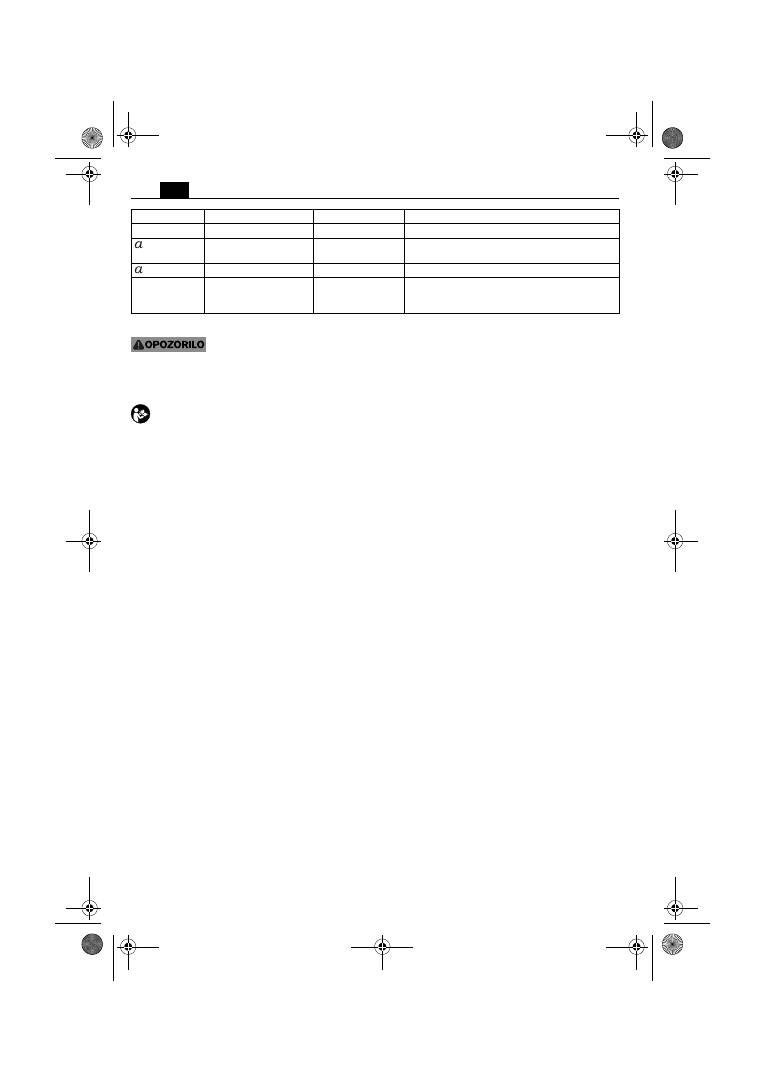
68
sl
Za vašo varnost.
Preberite vsa varnostna opozorila in
navodila.
Neupoštevanje varnostnih
navodil in napotkov lahko povzroči električni udar, požar
in/ali težke poškodbe.
Shranite vsa varnostna opozorila in navodila za
prihodnost.
Tega električnega orodja ne uporabljajte tako
dolgo, preden niste temeljito prebrali tega navodila
za uporabo ter priloženih „Splošnih varnostnih
opozoril“ (številka spisa 3 41 30 054 06 1) in jih v celoti
razumeli. Navedeno dokumentacijo shranite za kasnejšo
uporabo in jo izročite naprej pri posredovanju ali
odsvojitvi električnega orodja.
Prav tako upoštevajte zadevne nacionalne predpise
varstva pri delu.
Namembnost električnega orodja:
ročno voden vijačnik za privijanje in odvijanje vijakov,
posebej primeren za uporabo pri suhi gradnji z vijaki za
hitro gradnjo in z vstavnimi orodji ter priborom,
atestiranim s strani FEIN v okolju, ki je zaščiteno pred
vremenskimi vplivi.
Posebna varnostna navodila.
Električno orodje smete držati le na izoliranem ročaju, če
delate na območju, kjer lahko vijak pride v stik s skritimi
omrežnimi napeljavami.
Stik z napeljavo pod napetostjo
povzroči, da so tudi kovinski deli naprave pod napetostjo
in to posledično povzroči električni udar.
Pazite na skrite električne vodnike, plinski in vodovodni
cevovod.
Pred pričetkom dela kontrolirajte delovno
območje npr. z lokatorjem kovine.
Zavarujte obdelovanec.
Varneje je, da držite obdelovanec
z vpenjalno napravo, kot pa z roko.
Električno orodje morate trdno držati v roki.
Kratkoročno
lahko pride do visokih reakcijskih momentov.
Ne obdelujte materiala, ki vsebuje azbest.
Azbest je
kancerogen.
Prepovedano je privijačenje ali kovičenje ploščic in
znakov na električno orodje.
Poškodovana izolacija ne
nudi zaščite proti električnemu udaru. Uporabljajte
lepilne ploščice.
Ne uporabljajte pribora, ki ga proizvajalec električnega
orodja ni razvil in sprostil.
Varno obratovanje ne morete
zagotoviti s tem, da se pribor prilega električnemu
orodju.
Uporaba akumulatorske baterije
(akumulatorskega bloka) in način ravnanja z njo
Da bi preprečili nevarnosti kot opekline, požar,
eksplozije, poškodbe kože in druge poškodbe pri
rokovanju z akumulatorskimi baterijami, prosimo
upoštevajte naslednja opozorila:
Akumulatorskih baterij ne smete razstaviti, odpreti ali
razkosati. Akumulatorskih baterij ne smete izpostavljati
mehanskim udarcem.
Pri poškodbi in nepravilni uporabi
akumulatorske baterije lahko izstopijo škodljive pare in
tekočine. Te pare lahko povzročijo draženje dihalnih
poti. Izstopajoča tekočina akumulatorske baterije lahko
povzroči draženje kože ali opekline.
V primeru, da bi tekočina, ki bi izstopila iz poškodovane
akumulatorske baterije, oškropila predmete v okolici,
morate te predmete preveriti, jih očistiti in jih po potrebi
zamenjati.
Zavarujte akumulatorsko baterijo pred vročino ali
ognjem. Akumulatorske baterije ne hranite na direktni
sončni svetlobi.
Akumulatorsko baterijo vzemite šele takrat iz originalne
embalaže, ko jo želite uporabiti.
Pred pričetkom del, ki jih opravljate neposredno na
električnem orodju, vzemite akumulatorsko baterijo iz
električnega orodja.
Če se električno orodje nenamerno
zažene, obstaja nevarnost poškodb.
Akumulatorsko baterijo snemite le, ko je električno
orodje izklopljeno.
Poskrbite, da otroci ne bodo prišli v stik z akumulatorsko
baterijo.
Poskrbite za čistočo akumulatorske baterije in jo
zaščitite pred vlago in vodo.
Očistite umazane priključke
akumulatorske baterije in električnega orodja s suho,
čisto krpo.
Uporabljajte le brezhibne originalne akumulatorske
baterije FEIN, ki so primerne za vaše električno orodje.
Pri polnjenju in delu z neustreznimi, poškodovanimi,
popravljenimi ali predelanimi akumulatorskimi baterijami,
ponaredki in akumulatorskimi baterijami tujih znamk
obstaja nevarnost požara in/ali eksplozije.
Upoštevajte varnostna navodila, ki so opisana v navodilu
za obratovanje akumulatorske polnilne naprave.
Vibracije rok
Podane vrednosti nivoja vibracij v teh navodilih so se
izmerile v skladu s standardiziranim merilnim postopkom
po EN 60745 in se lahko uporabljajo za primerjavo
električnih orodij med seboj. Primeren je tudi za začasno
oceno obremenjenosti z vibracijami.
K...
Negotovost
m/s
2
m/s
2
Emisijske vrednosti vibracij v skladu z EN 60745
(vektorska vsota treh smeri)
h
m/s
2
m/s
2
Emisijska vrednost vibracij (vijačenje)
m, s, kg, A, mm, V,
W, Hz, N, °C, dB,
min, m/s
2
m, s, kg, A, mm, V,
W, Hz, N, °C, dB,
min, m/s
2
Osnovne in izpeljane enote iz mednarodnega
merskega sestava
SI
.
Znaki
Mednarodna enota
Nacionalna enota
Razlaga
OBJ_BUCH-0000000072-001.book Page 68 Monday, June 18, 2012 8:40 AM
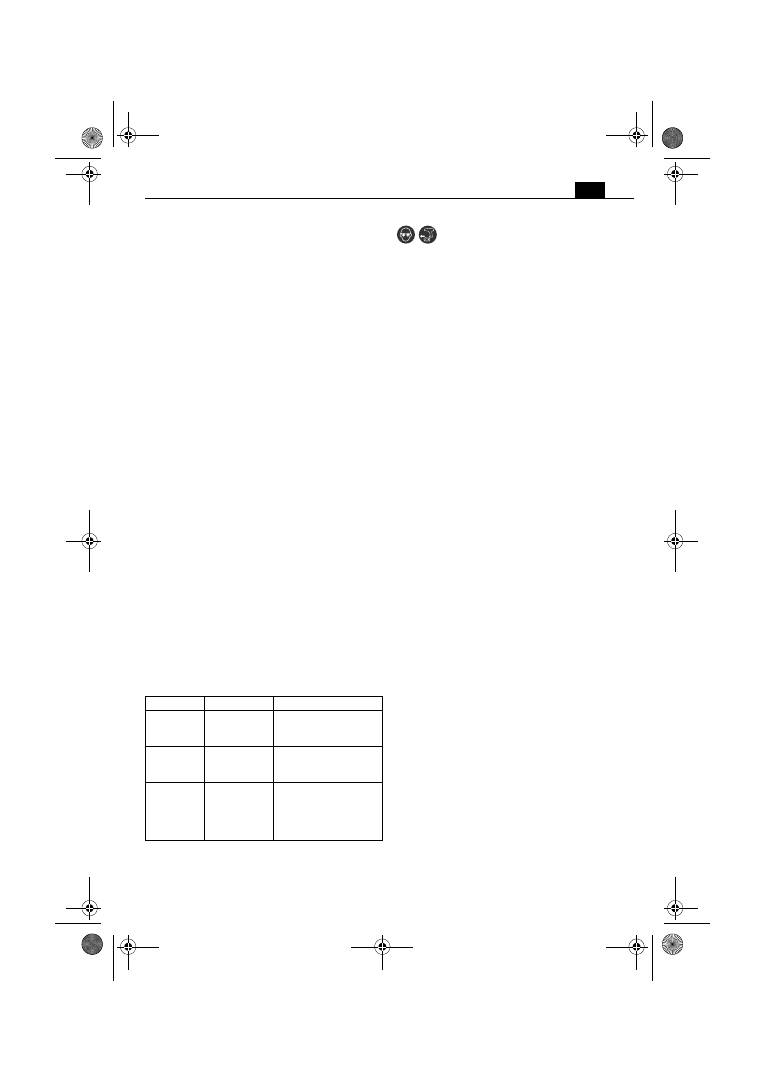
69
sl
Naveden nivo vibracij reprezentira glavne uporabe
električnega orodja. Če pa električno orodje uporabljate
še v druge namene, z odstopajočimi vstavnimi orodji ali
pri nezadostnem vzdrževanju, lahko nivo vibracij
odstopa. To lahko obremenjenosti z vibracijami med
določenim obdobjem uporabe občutno poveča.
Za natančnejšo oceno obremenjenosti z vibracijami
morate upoštevati tudi tisti čas, ko je naprava izklopljena
in sicer teče, vendar dejansko ni v uporabi. To lahko
ombremenjenost z vibracijami preko celotnega obdobja
dela občutno zmanjša.
Določite dodatne varnostne ukrepe za zaščito
uporabnika pred vpljivi vibracij, npr. vzdrževanje
električnega orodja in vstavnih orodij, segrevanje rok,
organizacija delovnih postopkov.
Navodila za uporabo.
Stikalo za preklop smeri vrtenja pritisnite samo pri
mirovanju motorja.
Nastavite preklopno stikalo smeri vrtenja v srednji
položaj in s tem zavarujte pred nenamernim vklopom,
npr. med transportom.
Pri pregretju deluje električno orodje s kratkimi, šibkimi
impulzi. Pustite, da se električno orodje ohladi med
praznim tekom.
ASCT14/ASCT14M/ASCT18/ASCT18M:
Vijačne zveze
morate izvesti z montiranim globinskim omejilom.
ASCT14M/ASCT14UM/ASCT18M/ASCT18UM:
Magazin
vijakov smete uporabljati samo v položaju „smer vrtenja
desno“.
Nastavitev vrtilnega momenta (ASCT14U/
ASCT14UM/ASCT18U/ASCT18UM) (glejte stran 7).
Tovarniška nastavitev ustreza območju za majhne do
srednje velike vijake.
Pritezni moment je odvisen tudi od moči, s katero
pritisnete električno orodje na vijak.
Rokovanje z akumulatorsko baterijo.
Uporabljajte in polnite akumulatorsko baterijo izključno
v območju delovne temperature 0 °C – 45 °C (32 °F –
113 °F). Temperatura akumulatorske baterije se mora na
začetku polnilnega postopka nahajati v območju delovne
temperature.
Le ko je motor električnega orodja ustavljen, se bo
prikazal pravilni delež napolnjenosti akum. baterije v
odstodkih.
Ko se bliža globinska izpraznitev akumulatorske baterije,
elektronika avtomatsko ustavi motor.
Vzdrževanje in servis.
Pri ekstremnih pogojih uporabe se lahko
prevodni prah, ki nastane pri obdelavi kovin,
usede v notranjosti električnega orodja. Iz
notranjosti električnega orodja pogosto izpihavajte
prezračevalne zareze s suhim in neoljnatim stisnjenim
zrakom.
Aktualni seznam nadomestnih delov se nahaja na spletni
strani pod www.fein.com.
Naslednje dele lahko po potrebi samostojno zamenjajte:
vstavna orodja, globinsko omejilo, akumulatorsko
baterijo, kavelj za obesit na delovni oder, vlagalnik
Jamstvo in garancija.
Jamstvo za izdelek velja v skladu z zakonskimi pravili v
državi, kjer se je izdelek dal v promet. Poleg tega vam daje
FEIN garancijo v skladu z izjavo proizvajalca FEIN.
V obsegu dobave električnega orodja se lahko nahaja tudi
le del pribora, ki je opisan ali naslikan v tem navodilu za
obratovanje.
Izjava o skladnosti.
Podjetje FEIN izjavlja pod izključno odgovornostjo, da ta
izdelek ustreza navedenim zadevnim določilom, ki so
opisana na zadnji strani tega navodila za obratovanje.
Tehnična dokumentacija se nahaja pri:
C. & E. FEIN GmbH, C-DB_IA,
D-73529 Schwäbisch Gmünd
Varstvo okolja, odstranitev odpadkov.
Embalaže, odpadna električnega orodja in pribor morate
reciklirati v skladu z varstvom okolja.
Akumulatorske baterije smete samo v praznem stanju
odvreči med recikliran odpad.
Pri nepopolno izpraznjenih akumulatorskih baterijah
zaradi preprečevanja kratkega stika izolirajte povezovalni
vtič z lepilnim trakom.
LED-prikaz
Pomen
Akcija
1 – 4 zelena
LED
Stanje
napolnjenosti
v odstotkih
Delovanje
Rdeča trajna
luč
Akumulatorsk
a baterija je
skoraj prazna
Napolnite
akumulatorsko baterijo
Rdeča
utripajoča
luč
Akumulatorsk
a baterija ni
pripravljeno
za uporabo
Akumulatorska baterija
se mora nahajati v
območju delovne
temperature, nato jo
napolnite
OBJ_BUCH-0000000072-001.book Page 69 Monday, June 18, 2012 8:40 AM

70
sr
sr
Originalno uputstvo za rad Akku-uvrtača.
Upotrebljeni simboli, skraćenice i pojmovi.
Simbol, znak
Objašnjenje
Rotirajuće delove električnog alata ne dodirivati.
Sledite uputstva u sledećem tekstu ili grafici!
Neizostavno čitajte priložena dokumenta kao uputstvo za rad i opšta sigurnosna
upozorenja.
Pre ovoga radnog zahvata ukloniti akumulator iz električnog alata. Inače postoji opasnost
od povredjivanja nenamernim kretanjem električnog alata.
Pri radu koristite zaštitu za oči.
Ne punite oštećene akumulatore.
Ne izlažite akumulator vatri. Zaštitite akumulator od toplote, na. primer i od trajnog
sunčevog zračenja.
Obratite pažnju na uputstva u sledećem tekstu!
Podruèje zahvata
Potvrdjuje usaglašenost električnog alata sa smernicama Evropske Zajednice.
Ovo upozorenje pokazuje moguću opasnu situaciju, koja može uticati na najozbiljnije
povrede ili smrt.
Recycling-Znak: označava materijale koji se mogu reciklirati
Prikazane električne alate i druge elektrotehničke i električne proizvode sakupljajte
odvojeno i odvozite na reciklažu koja odgovara zaštiti čovekove okoline.
Tip akumulatora
Bez broja obrtaja
Veliki broj obrtaja
Smanjivanje obrtnog momenta
Povećavanje obrtnog momenta
Znak
Jedinica internacionalna
Jedinica nacionalna
Objašnjenje
U
V
V
Električni jednosmerni napon
n
0
/min, min
-1
, rpm, r/min
/min
Broj obrtaja na prazno
n
1
/min, min
-1
, rpm, r/min
/min
Broj obrtaja pod opterećenjem
M...
Nm
Nm
Obrtni momenat (tvrdji/mekši slučaj zavrtnja)
inch
inch
Prihvat alata unutrašnji šestougao
mm
mm
Presek zavrtanja
kg
kg
Težina prema EPTA-Procedure 01/2003
L
pA
dB
dB
Nivo zvučnog pritiska
L
wA
dB
dB
Brzi nivo snage
L
pCpeak
dB
dB
Vršni nivo zvučnog pritiska
OBJ_BUCH-0000000072-001.book Page 70 Monday, June 18, 2012 8:40 AM
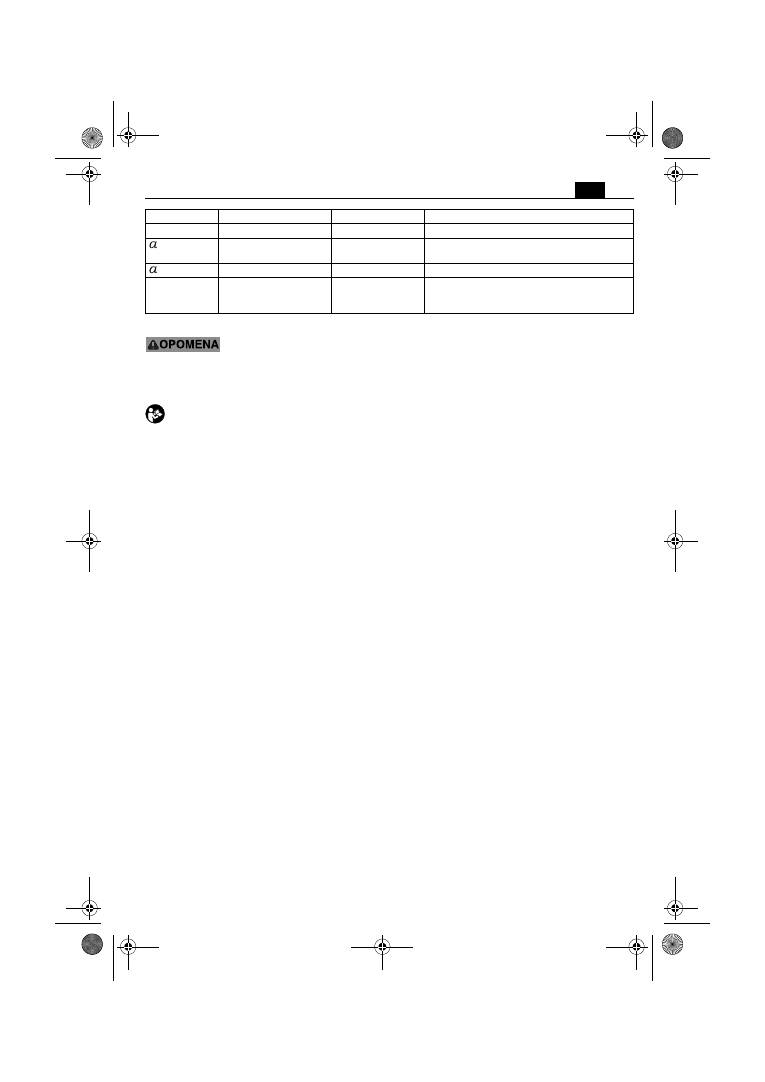
71
sr
Za Vašu sigurnost.
Čitajte sva sigurnosna upozorenja i
uputstva.
Propusti kod održavanja
sigurnosnih upozorenja i uputstava mogu prouzrokovati
električni udar, požar i/ili teške povrede.
Čuvajte sva sigurnosna upozorenja i uputstva za
budućnost.
Ne upotrebljavajte ovaj električni alat, pre nego što
temeljno ne pročitate i potpuno razumete ovo
uputstvo za rad kao i priložena „Opšta sigurnosna
upozorenja“ (broj spisa 3 41 30 054 06 1). Čuvajte
navedenu dokumentaciju za kasniju upotrebu i predajte
je kod nekog otudjenja ili davanja električnog alata.
Pazite isto tako na važeće nacionalne propise o zaštiti na
radu.
Odredjivanje električnog alata:
uvrtač sa ručnim vodjenjem za uvrtanje i odvrtanje
zavrtanja, specijalno za upotrebu u suvoj gradnji sa
zavrtnjima za brzu gradnju, sa alatima i priborom koje
dozvoljava FEIN u okolini zaštićenoj o vremena.
Specijalna sigurnosna upozorenja.
Držite uredjaj za izolovane hvataljke, ako izvodite radove,
pri kojima zavrtanj može sresti skrivene vodove struje.
Kontakt sa vodom koji može provoditi struju može
staviti pod napon i metalne delove uredjaja i uticati na
električni udar.
Pazite na skrivene postavljene električne vodove,
gasovode i vodovodne cevi.
Konrolišite pre početka rada
radno područje na primer sa nekim uredjajem za potragu
metala.
Obezbedite radni komad.
Radni komad koji drži neki
zatezni uredjaj se sigurnije drži nego sa Vašom rukom.
Dobro i čvrsto držite električni alat.
Mogu na kratko
nastupiti veliki reakcioni momenti.
Ne obradjujte nikakav materijal koji sadrži azbest.
Azbest
važi kao izazivač raka.
Zabranjeno je zavrtati tablice i znake na električni alat ili
ih nitovati.
Oštećena izolacija ne pruža neku zaštitu
protiv električnog udara. Upotrebljavajte lepljive tablice.
Ne upotrebljavajte neki pribor koji nije specijalno
proizveden od proizvodjača električnog alata ili odobren.
Siguran rad nije samo zbog toga, što neki pribor odgovara
Vašem električnom alatu.
Upotreba i rad sa akumulatorom
(akumulatorski blok)
Da bi izbegli opasnosti kao što su opekotine, požar,
eksploziju, povrede kože i druge povrede pri ophodjenju
sa akumulatorom, obratite pažnju na sledeća uputstva:
Akumulatori se ne smeju rastavljati, otvarati ili
smanjivati. Ne izlažite akumulatore mehaničkim udarima.
Pri oštećenju i nestručnoj upotrebi akumulatora mogu
izlaziti štetna isparenja i tečnosti. Isparenja mogu
nadraživati disajne puteve. Tečnost akumulatora koja
izlazi može uticati na nadražaje kože ili opekotine na
koži.
U slučaju da iz oštećenog akumulatora izadje tečnost i
ovlaži ivične predmete, prekontrolišite odgovarajuće
delove, očistitre ih ili ih u datom slučaju zamenite.
Ne izlažite akumulator toploti ili vatri. Ne čuvajte
akumulator na sunčevom svetlu.
Izvadite akumulator tek onda iz njegovog originalnog
pakovanja, kada treba da se koristi.
Izvadite akumulator pre rada na električnom alatu iz
električnog alata.
Ako električni alat krene slučajno,
postoji opasnost od povreda.
Izvadite akumulator samo pri isključenom električnom
alatu.
Držite akumulatore što dalje od dece.
Držite akumulator čist i zaštićen od vlage i vode.
Čistite
zaprljane priključke akumulatora i električnog alata sa
nekom suvom, čistom krpom.
Upotrebljavajte samo neoštećene originalne FEIN-
akumulatore, koji su odredjeni za Vaš električni alat.
Pri
radu sa i punjenju pogrešnih, oštećenih, popravljanih ili
doradjenih akumulatora, imitacija i stranih fabrikata
postoji opasnost od požara i/ili opasnost od eksplozije.
Sledite sigurnosne savete u uputstvu za rad uredjaja za
punjenje akumulatora.
Vibracije ruke i šake
Nivo vibracija naveden u ovim upozorenjima je izmeren
prema jednom mernom postupku koji je standardizovan
u EN 60745 i može se upotrebiti za poredjenje
električnih alata jedan sa drugim. Pogodno je i za
privremenu procenu opterećenja vibracijama.
Navedeni nivo vibracija predstavlja glavne primene
električnog alata. Ako se svakako električni alat
upotrebljava za druge namene, sa upotrebljenim alatima
koji odstupaju ili nedovoljnim održavanjem, može nivo
vibracija odstupati. Ovo može opterećenje vibracijama
značajno povećati preko celog radnog vremena.
K...
Nesigurnost
m/s
2
m/s
2
Emisiona vrednost vibracija je prema EN 60745
(Zbir vektora tri pravca)
h
m/s
2
m/s
2
Emisiona vredost vibracija (zavrtnji)
m, s, kg, A, mm, V,
W, Hz, N, °C, dB,
min, m/s
2
m, s, kg, A, mm, V,
W, Hz, N, °C, dB,
min, m/s
2
Bazne i izvedene jedinice iz internacionalnog
sistema jedinica
SI
.
Znak
Jedinica internacionalna
Jedinica nacionalna
Objašnjenje
OBJ_BUCH-0000000072-001.book Page 71 Monday, June 18, 2012 8:40 AM
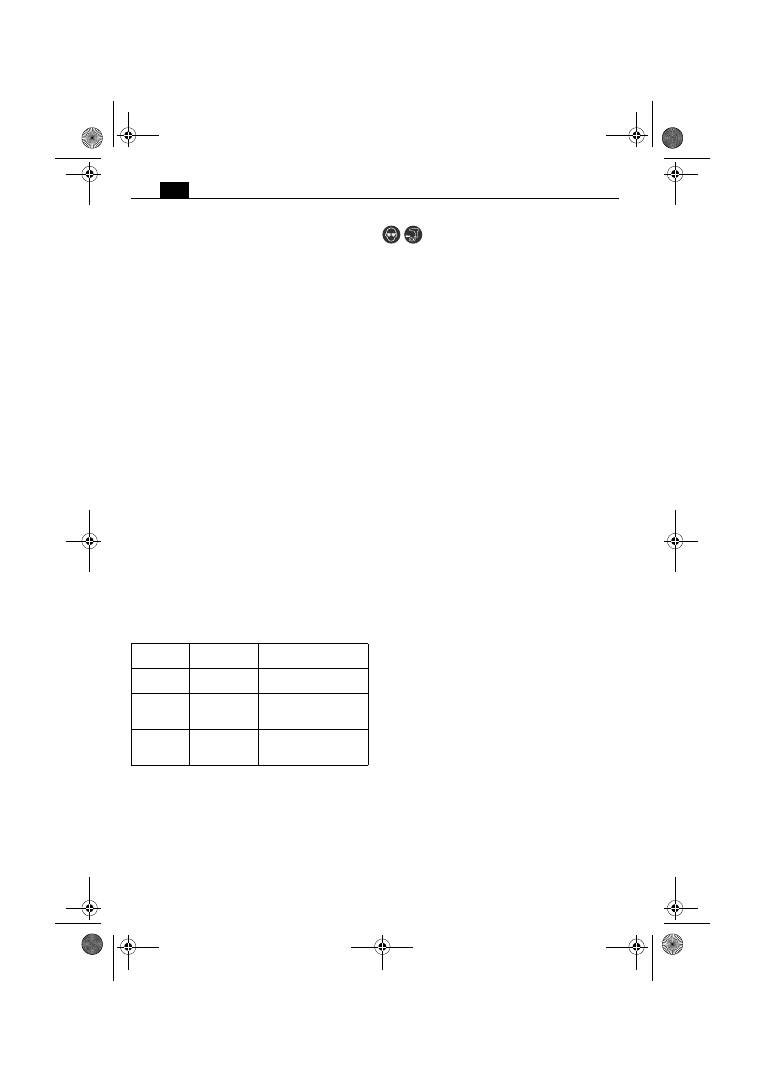
72
sr
Za neku tačnu procenu opterećenja vibracijama trebalo bi
uzeti u obzir i vreme, u kojem je uredjaj isključen, ili
doduše radi, medjutim nije stvarno u upotrebi. Ovo
može značajno redukovati opterećenje vibracijama preko
celog radnog vremena.
Utvrdite dodatne sigurnosne mere za zaštitu radnika pre
delovanja vibracija kao na primer: Održavanje električnih
alata i alata za upotrebu, održavajte ruke tople,
organizacija radnog postupka.
Uputstva za rad.
Aktivirajte prekidač za smer okretanja samo u stanju
mirovanja motora.
Dovedite preklopnik smera okretanja u srednju poziciju
da bi izbegli slučajno puštanje u rad, na primer pri
transportu.
Kod pregrevanja radi električni alat sa kraćim impulsima
koji su siromašni snagom. Ostavite električni alat u
praznom hodu da se ohladi.
ASCT14/ASCT14M/ASCT18/ASCT18M:
Spajanje zavrtanja
treba izvoditi sa montiranim dubinskim graničnikom.
ASCT14M/ASCT14UM/ASCT18M/ASCT18UM:
Magacin sa
zavrtnjima sme da radi samo u položaju „Smer okretanja
desni“.
Podešavanje obrtnog momenta (ASCT14U/
ASCT14UM/ASCT18U/ASCT18UM) (pogledajte
stranu 7).
Podešavanje u fabrici odgovara području za manje
zavrtnje i do zavrtanja srednje veličine.
Zatezni momenat zavisi od sile, sa kojom se pritiska
električni alat na zavrtanj.
Ophodjenje sa akumulatorom.
Radite sa akumulatorom i punite ga samo u radnom
temperaturnom području akumulatora od 0 °C – 45 °C
(32 °F – 113 °F). Temperatura akumulatora mora na
početku radnje punjenja biti u radnom temperaturnom
području akumulatora.
Pravo procentualno stanje punjenja akumulatora
prikazuje se samo pri zaustavljenom motoru električnog
alata.
Kod predstojećeg dubokog pražnjenja akumulatora
elektronika automatski zaustavlja motor.
Održavanje i servis.
Kod ekstremnih uslova korišćenja može se pri
obradi metala nataložiti lagana prašina u
unutrašnjosti električnog alata. Izduvavajte
često unutrašnjost električnog alata kroz proreze za
ventilaciju sa suvim i komprimovanim vazduhom bez
pritiska.
Aktuelna lista rezervnih delova ovoga električnog alata
naći ćete na Internetu pod www.fein.com.
Sledeće delove možete pri potrebi sami zameniti:
Upotrebljeni alati, dubinski graničnik, akumulator, kuka
za skelu, magacin
Jemstvo i garancija.
Garancija na proizvod važi prema zakonskim
regulativama u zemlji gde se pušta u rad. Pored toga daje
FEIN garanciju prema FEIN garantnoj izjavi proizvodjača.
U obimu isporuke Vašeg električnog alata može biti čak
samo jedan deo pribora koji je opisan u uputstvu za rad
ili koji je prikazan na slikama.
Izjava o usaglašenosti.
Firma FEIN izjavljuje na vlastitu odgovornost, da ovaj
proizvod odgovara važećim propisima koji su navedeni
na poslednjoj stranici ovoga uputstva za rad.
Tehnička dokumentacija kod: C. & E. FEIN GmbH,
C-DB_IA, D-73529 Schwäbisch Gmünd
Zaštita čovekove okoline, uklanjanje
djubreta.
Pakovanja, sortirani električni alati i pribor odvozite
nekoj reciklaži koja odgovara zaštiti čovekove okoline.
Odvozite akumulatore samo u ispražnjenom stanju nekoj
propisanoj reciklaži.
Kod nepotpuno ispražnjenih akumulatora da bi se
obezbedili od kratkih spojeva izolirajtre utičnice sa
lepljivom trakom.
LED-
pokazivač
Značenje
Akcija
1 – 4 zeleni
LED
procentualno
stanje punjenja
Rad
cveno
trajno
svetlo
Akumulator je
skoro prazan
Napuniti akumulator
crveno
trepćuće
svetlo
Akumulator
nije spreman
za rad
Dovesti akumulator u
radno temperaturno
područje, potom puniti
OBJ_BUCH-0000000072-001.book Page 72 Monday, June 18, 2012 8:40 AM

73
hr
hr
Originalne upute za uporabu aku-odvijača.
Korišteni simboli, kratice i pojmovi.
Simbol, znak
Objašnjenje
Ne dodirivati rotirajuće dijelove električnog alata.
Treba se pridržavati uputa u tekstu ili na slikama!
Neizostavno treba pročitati priložene dokumente, kao što su upute za rukovanje i opće
napomene za sigurnost.
Prije ove radne operacije aku-bateriju treba izvaditi iz električnog alata. Inače postoji
opasnost od ozljeda zbog nehotičnog pokretanja električnog alata.
Kod rada treba nositi zaštitne naočale.
Ne punite oštećenu aku-bateriju.
Aku-bateriju ne bacajte u vatre. Aku-bateriju zaštitite od djelovanja topline, npr. i od
stalnog Sunčevog zračenja.
Treba se pridržavati uputa u tekstu!
Površina zahvata
Potvrđuje usklađenost električnog alata sa smjernicama Europske unije.
Ove upute pokazuju moguće opasne situacije koje mogu dovesti do ozbiljnih ozljeda ili
do smrtnog slučaja.
Znak reciklaže: označava materijale koji se mogu reciklirati
Neuporabive električne alate i ostale elektrotehničke i električne proizvode treba
odvojeno sakupiti i dovesti na ekološki prihvatljivo recikliranje.
Tip aku-baterije
Mali broj okretaja
Veliki broj okretaja
Smanjenje okretnog momenta
Povećanje okretnog momenta
Znak
Međunarodna jedinica
Nacionalna jedinica Objašnjenje
U
V
V
Električni istosmjerni napon
n
0
/min, min
-1
, rpm, r/min
/min
Broj okretaja pri praznom hodu
n
1
/min, min
-1
, rpm, r/min
/min
Broj okretaja pri opterećenju
M...
Nm
Nm
Okretni moment (tvrđeg/mekšeg slučaja uvijanja)
inch
inch
Unutarnji šesterokut stezača alata
mm
mm
Promjer vijaka
kg
kg
Težina prema EPTA postupku 01/2003
L
pA
dB
dB
Razina zvučnog tlaka
L
wA
dB
dB
Razina učinka buke
L
pCpeak
dB
dB
Razina max. zvučnog tlaka
OBJ_BUCH-0000000072-001.book Page 73 Monday, June 18, 2012 8:40 AM
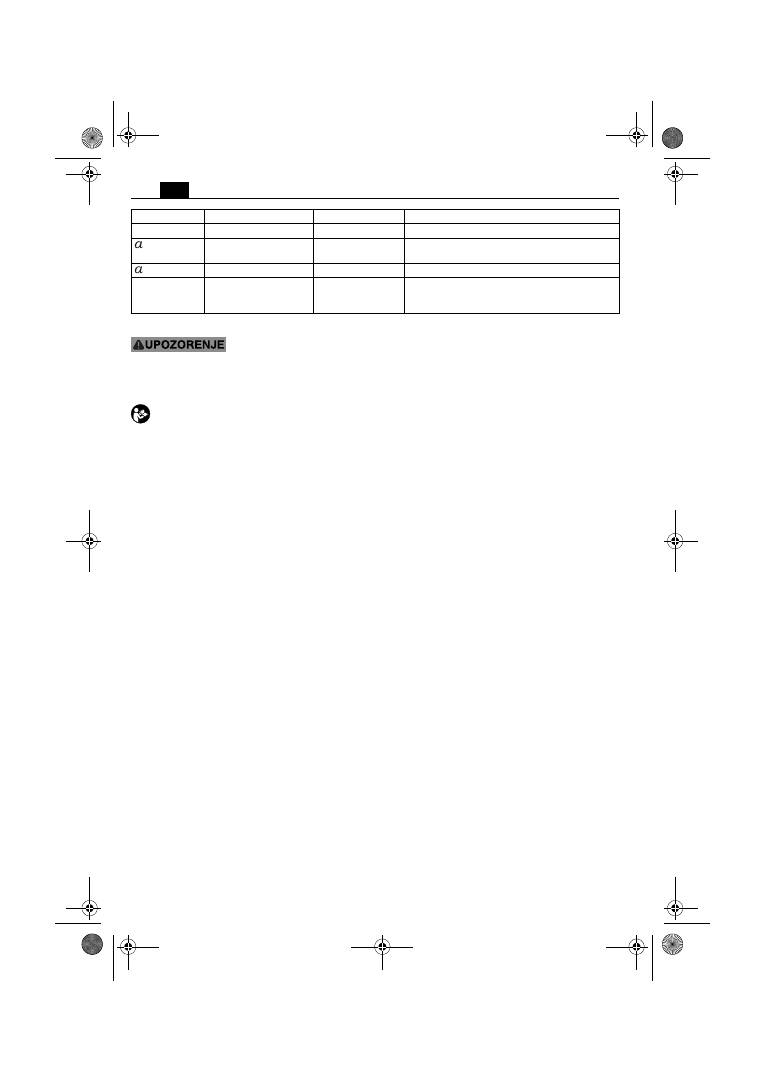
74
hr
Za vašu sigurnost.
Pročitajte sve upute za sigurnost
i upute za uporabu.
Propusti kod
poštivanja napomena za sigurnost i uputa mogu
prouzročiti strujni udar, požar i/ili teške ozljede.
Sve napomene za sigurnost i upute spremite za buduću
uporabu.
Ovaj električni alat ne koristite prije nego što ste
temeljito pročitali i razumjeli ove upute za
rukovanje kao i priložene „Opće napomene za
sigurnost“ (br. tiska. 3 41 30 054 06 1). Spomenutu
dokumentaciju spremite za kasniju uporabu i predajte je
novom vlasniku kod predaje ili prodaje električnog alata.
Također, pridržavajte se važećih nacionalnih propisa
zaštite pri radu.
Definicija električnog alata:
ručno vođeni odvijač za uvijanje i odvijanje vijaka,
posebno za primjenu u suhoj gradnji, sa brzim građevnim
vijcima, sa radnim alatima i priborom odobrenim od
FEIN, u okolini zaštićenoj od vremenskih nepogoda.
Posebne napomene za sigurnost.
Kada radite na mjestima gdje bi vijak mogao oštetiti
skrivene električne kablove, električni alat držite na
izoliranim površinama zahvata.
Kontakt sa vodom pod
naponom može i metalne dijelove uređaja staviti pod
napon i dovesti do strujnog udara.
Pazite na skrivene električne kablove, plinske i
vodovodne cijevi.
Prije početka rada kontrolirajte radno
područje, npr. sa uređajem za lociranje metala.
Osigurajte izradak.
Izradak koji se drži sa steznom
napravom sigurnije se drži nego sa rukom.
Električni alat držite čvrsto.
Kratkotrajno se mogu
pojaviti visoki momenti reakcije.
Ne obrađujte materijal koji sadrži azbest.
Azbest se
smatra kancerogenim.
Zabranjeno je natpise i znakove pričvršćivati na električni
alat vijcima ili zakovicama.
Oštećena izolacija ne pruža
nikakvu zaštitu od strujnog udara. U tu svrhu koristite
naljepnice.
Ne koristite pribor koji nije proizveo ili odobrio proizvođač
električnog alata.
Siguran rad se ne postiže samo ako
pribor odgovara vašem električnom alatu.
Primjena i tretman aku-baterija (aku-blokova)
Kako bi se izbjegle opasnosti, kao što su opekline, požar,
eksplozija, ozljede kože i ostale ozljede kod rukovanja sa
aku-baterijom, treba se pridržavati slijedećih napomena:
Aku-baterije se ne smiju rastavljati, otvarati ili drobiti.
Aku-baterije ne izlažite mehaničkim udarima.
Kod
oštećenja i nestručne uporabe aku-baterije, iz nje mogu
izaći štetne pare i tekućine. Pare mogu nadražiti dišne
putove. Istekla tekućina iz aku-baterije može dovesti do
nadražaja kože ili opeklina.
Ako bi tekućina istekla iz oštećene aku-baterije nakvasila
okolne predmete, nakon toga kontrolirajte takove
dijelove, očistite ih ili prema potrebi zamijenite.
Aku-bateriju ne izlažite djelovanju topline ili vatre. Aku-
bateriju ne spremajte na mjestima izloženim izravnom
djelovanju Sunčevih zraka.
Aku-bateriju izvadite iz originalne ambalaže tek kada
ćete je koristiti.
Aku-bateriju prije radova na električnom alatu izvadite iz
električnog alata.
Ako bi se električni alat nehotično
pokrenuo, postoji opasnost od ozljeda.
Aku-bateriju izvadite samo kod isključenog električnog
alata.
Aku bateriju držite dalje od dosega djece.
Aku-bateriju održavajte u čistom stanju i zaštitite je od
vlage i vode.
Zaprljane priključke aku-baterije i
električnog alata očistite sa suhom čistom krpom.
Koristite samo ispravne, originalne FEIN aku-baterije
predviđene za vaš električni alat.
Kod radova i punjenja
pogrešnih, oštećenih, popravljanih ili prerađenih aku-
baterija, imitacija i proizvoda drugih proizvođača, postoji
opasnost od požara i/ili eksplozije.
Pridržavajte se uputa za sigurnost u uputama za uporabu
punjača aku-baterija.
Vibracije ruke i šake
Prag vibracija naveden u ovim uputama izmjeren je
postupkom mjerenja propisanom u EN 60745 i može se
primijeniti za međusobnu usporedbu električnih alata.
Prikladan je i za privremenu procjenu opterećenja od
vibracija.
Navedeni prag vibracija predstavlja glavne primjene
električnog alata. Ako se ustvari električni alat koristi za
druge primjene sa radnim alatima koji odstupaju od
navedenih ili se nedovoljno održavaju, prag vibracija
može odstupati. Na taj se način može osjetno povećati
opterećenje od vibracija tijekom čitavog vremenskog
perioda rada.
Za točnu procjenu opterećenja od vibracija trebaju se
uzeti u obzir i vremena u kojima je uređaj isključen, ili
doduše radi ali stvarno nije u primjeni. Na taj se način
može osjetno smanjiti opterećenje od vibracija tijekom
čitavog vremenskog perioda rada.
Prije djelovanja vibracija utvrdite dodatne mjere
sigurnosti za zaštitu korisnika, kao npr.: održavanje
električnog alata i radnih alata, kao i organiziranje radnih
operacija.
K...
Nesigurnost
m/s
2
m/s
2
Vrijednost emisija vibracija prema EN 60745
(vektorski zbroj u tri smjera)
h
m/s
2
m/s
2
Vrijednost emisija vibracija (uvijanje vijaka)
m, s, kg, A, mm, V,
W, Hz, N, °C, dB,
min, m/s
2
m, s, kg, A, mm, V,
W, Hz, N, °C, dB,
min, m/s
2
Osnovne i izvedene jedinice iz Međunarodnog
sustava jedinica
SI
.
Znak
Međunarodna jedinica
Nacionalna jedinica Objašnjenje
OBJ_BUCH-0000000072-001.book Page 74 Monday, June 18, 2012 8:40 AM

75
hr
Upute za rukovanje.
Preklopku smjera rotacije pritisnite samo u staju
mirovanja elektromotora.
Kako bi se izbjeglo nehotično puštanje u rad, npr. pri
transportu, preklopku smjera rotacije prebacite u srednji
položaj.
Kod pregrijanja će električni alat raditi sa kratkim
impulsima male snage. Ostavite da se električni alat ohladi
pri praznom hodu.
ASCT14/ASCT14M/ASCT18/ASCT18M:
Vijčani spojevi se
izvode sa montiranim graničnikom dubine.
ASCT14M/ASCT14UM/ASCT18M/ASCT18UM:
Magazin za
vijke smije raditi samo u položaju „smjera rotacije u
desno“.
Namještanje okretnog momenta
(ASCT14U/ASCT14UM/ASCT18U/ASCT18UM)
(vidjeti stranicu 7).
Tvorničko namještanje odgovara području za manje do
srednje velike vijke.
Moment pritezanja također je ovisan od sile kojom se
električni alat pritišće na vijak.
Rukovanje sa aku-baterijom.
Aku-bateriju koristite i punite samo u području radnih
temperatura aku-baterije od 0 °C – 45 °C (32 °F – 113 °F).
Temperatura aku-baterije na početku procesa punjenja
mora biti u području radnih temperatura aku-baterije.
Ispravno procentualno stanje napunjenosti aku-baterije
pokazat će se samo u stanju isključenog elektromotora
električnog alata.
Ako bi se prethodno aku-baterija dubinski ispraznila,
elektronika će automatski zaustaviti motor.
Održavanje i servisiranje.
Kod ekstremnih uvjeta primjene kod obrade
metala, u unutrašnjosti električnog alata može
se nakupiti električno vodljiva prašina. Sa
suhim komprimiranim zrakom i bez sadržaja ulja često
ispuhujte unutrašnjost električnog alata kroz otvore za
hlađenje.
Najnoviji popis rezervnih dijelova ovog električnog alata
možete naći na internetu, na adresi www.fein.com.
Sljedeće dijelove možete prema potrebi sami zamijeniti:
radne alate, graničnik dubine, aku-bateriju, kuku skele,
magazin.
Jamstvo.
Jamstvo za proizvod vrijedi prema zakonskim propisima
u zemlji korisnika električnog alata. Tvrtka FEIN daje
jamstvo prema FEIN izjavi proizvođača o jamstvu.
U opsegu isporuke vašeg električnog alata može biti
sadržan i samo jedan dio pribora opisanog ili prikazanog
u ovim uputama za rukovanje.
Izjava o usklađenosti.
Tvrtka FEIN izjavljuje uz punu odgovornost da ovaj
proizvod prikazan na zadnjoj stranici ovih uputa za
rukovanje odgovara navedenim važećim propisima.
Tehnička dokumentacija se može zatražiti od:
C. & E. FEIN GmbH, C-DB_IA,
D-73529 Schwäbisch Gmünd
Zaštita okoliša, zbrinjavanje u otpad.
Ambalažu, neuporabive električne alate i pribor treba
dovesti na ekološki prihvatljivo recikliranje.
Aku-bateriju zbrinuti u otpad samo u ispražnjenom
stanju.
Za slučaj nepotpuno ispražnjenih aku-baterija, kao mjeru
zaštite od kratkih spojeva, utičnu spojnicu izolirajte sa
ljepljivim trakama.
LED-pokazivač
Značenje
Aktivnost
1 – 4 zelena
LED
postotak
napunjenosti
Rad
crveno stalno
svjetlo
Aku-baterija je
gotovo prazna
Punjenje baterije
crveno
treperavo
svjetlo
Aku-baterija
nije spremna za
rad
Aku-bateriju dovesti
u područje radnih
temperatura aku-
baterije i nakon toga
je napuniti
OBJ_BUCH-0000000072-001.book Page 75 Monday, June 18, 2012 8:40 AM
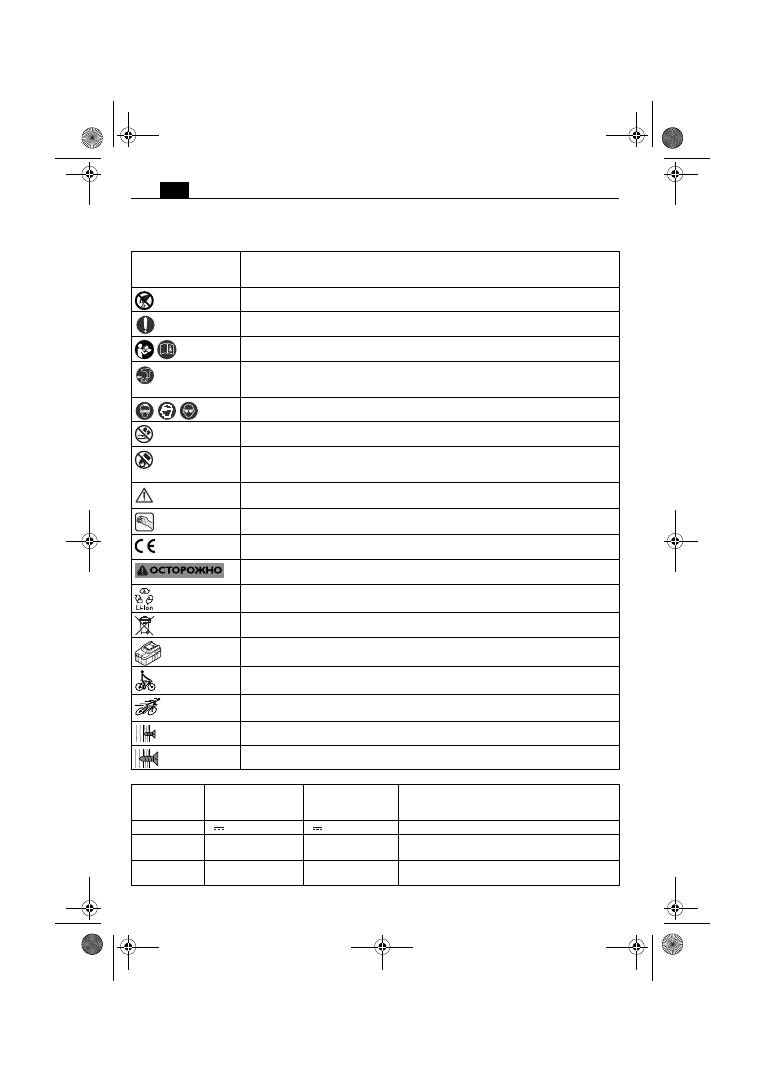
76
ru
ru
Оригинал инструкции по эксплуатации аккумуляторного шуруповерта.
Использованные условные обозначения, сокращения и понятия.
Символическое
изображение,
условный знак
Пояснение
Не прикасайтесь к вращающимся частям.
Соблюдайте указания, содержащиеся в тексте и на рисунке рядом!
Обязательно прочтите прилагаемые документы, такие как руководство по
эксплуатации и общие инструкции по безопасности.
Перед выполнением этой операции выньте аккумулятор из электроинструмента. В
противном случае возможно получение травм при непреднамеренном включении
электроинструмента.
При работе использовать средства защиты глаз.
Не заряжайте поврежденные аккумуляторные батареи.
Не подвергайте аккумуляторную батарею воздействию огня. Защищайте
аккумуляторную батарею от высоких температур, напр., от длительного
нагревания на солнце.
Соблюдайте приведенные рядом указания!
Зона удержания
Подтверждает соответствие электроинструмента директивам Европейского
Сообщества.
Это указание предупреждает о возможной опасной ситуации, которая может
привести к серьезным травмам или смерти.
Знак вторичной переработки: обозначает пригодные для повторного
использования материалы
Отработавшие свой ресурс электрические изделия следует собирать и сдавать
отдельно на экологически чистую переработку.
Тип аккумулятора
Низкое число оборотов
Высокое число оборотов
Уменьшение величины крутящего момента
Увеличение величины крутящего момента
Условный знак Eдиница измерения,
международное
обозначение
Eдиница
измерения, русское
обозначение
Пояснение
U
V
В
Электрическое напряжение постоянного тока
n
0
/min, min
-1
, rpm,
r/min
/мин
Число оборотов холостого хода
n
1
/min, min
-1
, rpm,
r/min
/мин
Число оборотов под нагрузкой
OBJ_BUCH-0000000072-001.book Page 76 Monday, June 18, 2012 8:40 AM

77
ru
Для Вашей безопасности.
Прочтите все указания и
инструкции по технике
безопасности.
Упущения, допущенные при
соблюдении указаний и инструкций по технике
безопасности, могут стать причиной поражения
электрическим током, пожара и тяжелых травм.
Сохраняйте эти инструкции и указания для будущего
использования.
Не применяйте настоящий
электроинструмент, предварительно не изучив
основательно и полностью не усвоив это
руководство по эксплуатации, а также приложенные
«Общие указания по технике безопасности» (номер
публикации 3 41 30 054 06 1). Сохраняйте
названные документы для дальнейшего
использования и приложите их к
электроинструменту при его передаче другому лицу
или при его продаже.
Учитывайте также соответствующие национальные
правила по охране труда.
Назначение электроинструмента:
pучной шуруповерт для завинчивания и
отвинчивания шурупов, особенно для
завинчивания/отвинчивания саморезов в
гипсокартонных плитах, для использования в
закрытых помещениях с допущенными фирмой FEIN
рабочими инструментами и принадлежностями.
Специальные указания по технике
безопасности.
При выполнении работ, при которых шуруп может
задеть скрытую электропроводку, держите
электроинструмент за изолированные ручки.
Контакт
с находящейся под напряжением проводкой может
привести к поражению электрическим током.
Следите за скрытой электрической проводкой,
газопроводом и водопроводом.
До начала работы
проверить рабочий участок, например,
металлоискателем.
Закрепляйте обрабатываемую деталь.
Закрепленная,
например, в тисках деталь удерживается надежнне,
чем в Вашей руке.
Крепко держите электроинструмент в руках.
Не
исключено возникновение отдачи.
Не обрабатывайте материалы с содержанием асбеста.
Aсбест является возбудителем рака.
Запрещается закреплять на электроинструменте
таблички и обозначения с помощью винтов и
заклепок.
Поврежденная изоляция не защищает от
поражения электрическим током. Применять
приклеиваемые таблички.
Не применяйте принадлежности, которые не были
специально сконструированы изготовителем
электроинструмента или на применение которых нет
разрешения изготовителя.
Безопасная эксплуатация
не обеспечивается только тем, что принадлежности
подходят к Вашему электроинструменту.
Использование и обращение с аккумуляторами
(аккумуляторными блоками)
В целях исключения при обращении с
аккумуляторами таких опасностей, как получение
ожогов, возгорание, взрыв, повреждение кожи и
получение других травм, соблюдайте следующие
указания:
Аккумуляторы нельзя разбирать, открывать или
раскалывать. Не подвергайте аккумуляторы
механическим ударам.
При повреждении
аккумулятора и ненадлежащем его использовании
возможно выделение паров и жидкостей. Вдыхание
паров может привести к раздражению дыхательных
путей. Вылившаяся аккумуляторная жидкость
способна вызвать кожные раздражения и ожоги.
M...
Nm
Нм
Крутящий момент (завинчивание в твердые/
мягкие материалы)
inch
дюйм
Шестигранный патрон
mm
мм
Диаметр шурупа
kg
кг
Вес согласно EPTA-Procedure 01/2003
L
pA
dB
дБ
Уровень звукового давления
L
wA
dB
дБ
Уровень звуковой мощности
L
pCpeak
dB
дБ
Макс. уровень звукового давления
K...
Погрешность
m/s
2
м/с
2
Вибрация в соответствии с EN 60745
(векторная сумма трех направлений)
h
m/s
2
м/с
2
Вибрация (завинчивание/отвинчивание)
m, s, kg, A, mm, V,
W, Hz, N, °C, dB,
min, m/s
2
м, с, кг, A, мм, В,
Вт, Гц, Н, °C, дБ,
мин., м/с
2
Основные и производные единицы измерения
Международной системы единиц
СИ
.
Условный знак Eдиница измерения,
международное
обозначение
Eдиница
измерения, русское
обозначение
Пояснение
OBJ_BUCH-0000000072-001.book Page 77 Monday, June 18, 2012 8:40 AM
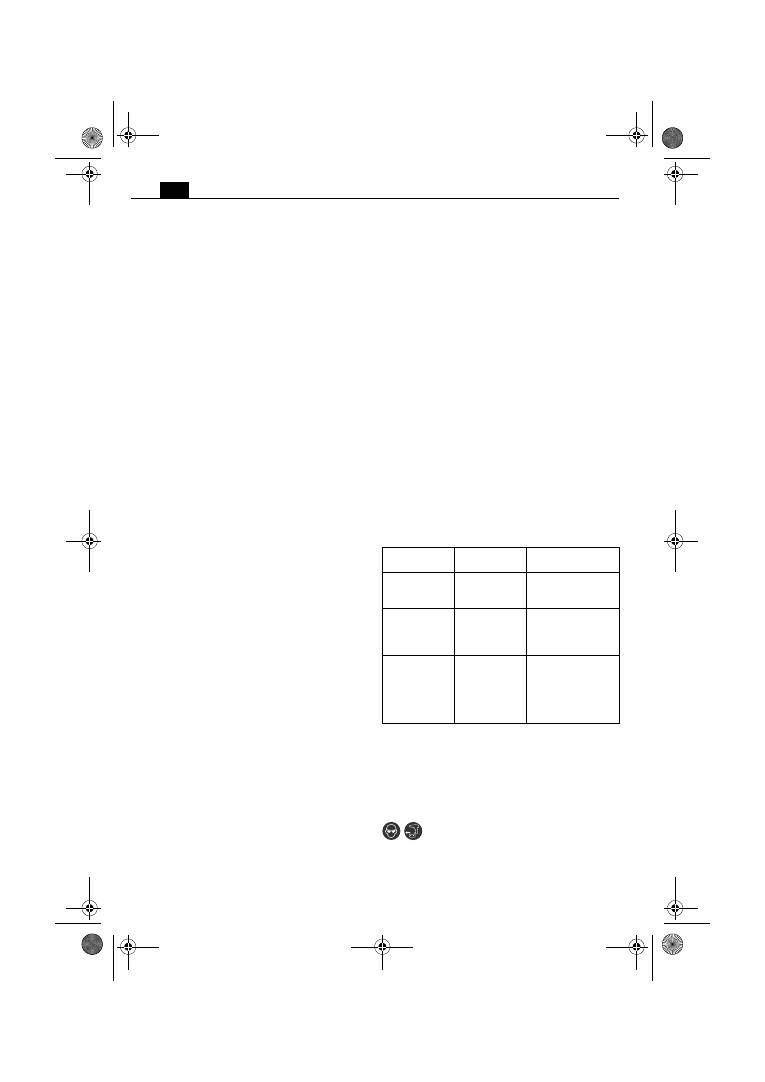
78
ru
Если вылившаяся из поврежденного аккумулятора
жидкость попадет на окружающие предметы и
детали, проверьте их, очистите и при необходимости
поменяйте.
Не подвергайте аккумуляторную батарею
воздействию тепла и огня. Не храните аккумуляторы
под прямыми солнечными лучами.
Вынимайте аккумуляторы из оригинальной упаковки
только лишь непосредственно перед их
использованием.
Перед выполнением любых манипуляций с
электроинструментом извлекайте из него
аккумуляторную батарею.
Самопроизвольное
включение электроинструмента чревато опасностью
травм.
Вынимайте аккумулятор только при выключенном
электроинструменте.
Не допускайте попадания аккумуляторов в руки
детей.
Содержите аккумуляторы в чистоте, защищайте их от
воздействия влаги и попадания на них воды.
Очищайте загрязненные контакты аккумулятора и
электроинструмента сухой, чистой тряпкой.
Используйте только исправные оригинальные
аккумуляторы фирмы FEIN, предназначенные для
данного электроинструмента.
При работе с
неподходящими, поврежденными,
отремонтированными или восстановленными
аккумуляторами, подделками или аккумуляторами
других производителей, а также при их зарядке
существует опасность возгорания и/или взрыва.
Соблюдайте указания по технике безопасности,
содержащиеся в руководстве по эксплуатации
зарядного устройства для аккумуляторов.
Вибрация, действующая на кисть-руку
Указанный в этих инструкциях уровень вибрации
определен в соответствии с методикой измерений,
предписанной EN 60745, и может использоваться
для сравнения электроинструментов. Он пригоден
также для предварительной оценки вибрационной
нагрузки.
Уровень вибрации указан для основных областей
применения электроинструмента. Он может
отличаться при использовании электроинструмента
для других применений, использовании иных
рабочих инструментов или недостаточном
техобслуживании. Следствием может явиться
значительное увеличение вибрационной нагрузки в
течение всей продолжительности работы.
Для точной оценки вибрационной нагрузки нужно
учитывать также и время, когда инструмент
выключен или, хоть и включен, но не находится в
работе. Это может снизить среднюю вибрационную
нагрузку в течение всей продолжительности
работы.
Предусмотрите дополнительные меры
предосторожности для защиты пользователя от
воздействия вибрации, как напр.: техобслуживание
электроинструмента и принадлежностей, теплые
руки, организация труда.
Указания по пользованию.
Приводите в действие переключатель направления
вращения только при остановленном двигателе.
Установите переключатель направления вращения в
среднее положение, чтобы избежать
непреднамеренного включения, напр., при
транспортировке.
При перегреве электроинструмент работает с
короткими, слабыми рывками. Дайте
электроинструменту остыть на холостом ходу.
ASCT14/ASCT14M/ASCT18/ASCT18M:
При
завинчивании должен быть монтирован
ограничитель глубины.
ASCT14M/ASCT14UM/ASCT18M/ASCT18UM:
Магазином
для шурупов можно пользоваться только при
«правом направлении вращения».
Настройка крутящего момента (ASCT14U/
ASCT14UM/ASCT18U/ASCT18UM) (см. стр. 7).
Заводская настройка рассчитана на небольшие и
средние шурупы.
Крутящий момент зависит также и от силы, с
которой электроинструмент прижимается к шурупу.
Обращение с аккумулятором.
Пользуйтесь аккумулятором и заряжайте его только
в диапазоне рабочей температуры аккумулятора
0 °C – 45 °C (32 °F – 113 °F). В начале процесса зарядки
температура аккумулятора должна находиться в
рабочем диапазоне.
Действительная степень зарядки аккумулятора в
процентах отображается только при остановленном
двигателе электроинструмента.
Прежде чем аккумулятор сможет достичь состояния
глубокой разрядки, электроника автоматически
выключает двигатель.
Техобслуживание и сервисная служба.
В экстремальных условиях работы при
обработке металлов внутри
электроинструмента может собираться
токопроводящая пыль. Регулярно продувайте
внутреннюю полость электроинструмента через
вентиляционные щели сухим и не содержащим
масла сжатым воздухом.
Светодиодный
индикатор
Значение
Действие
1 – 4 зеленых
светодиода
степень
зарядки в
процентах
Эксплуатация
красный
немигающий
световой
сигнал
Аккумулятор
почти
разряжен
Зарядите
аккумулятор
красный
мигающий
световой
сигнал
Аккумулятор
не готов к
работе
Подождите, пока
аккумулятор не
достигнет
диапазона рабочей
температуры, и
затем зарядите
OBJ_BUCH-0000000072-001.book Page 78 Monday, June 18, 2012 8:40 AM
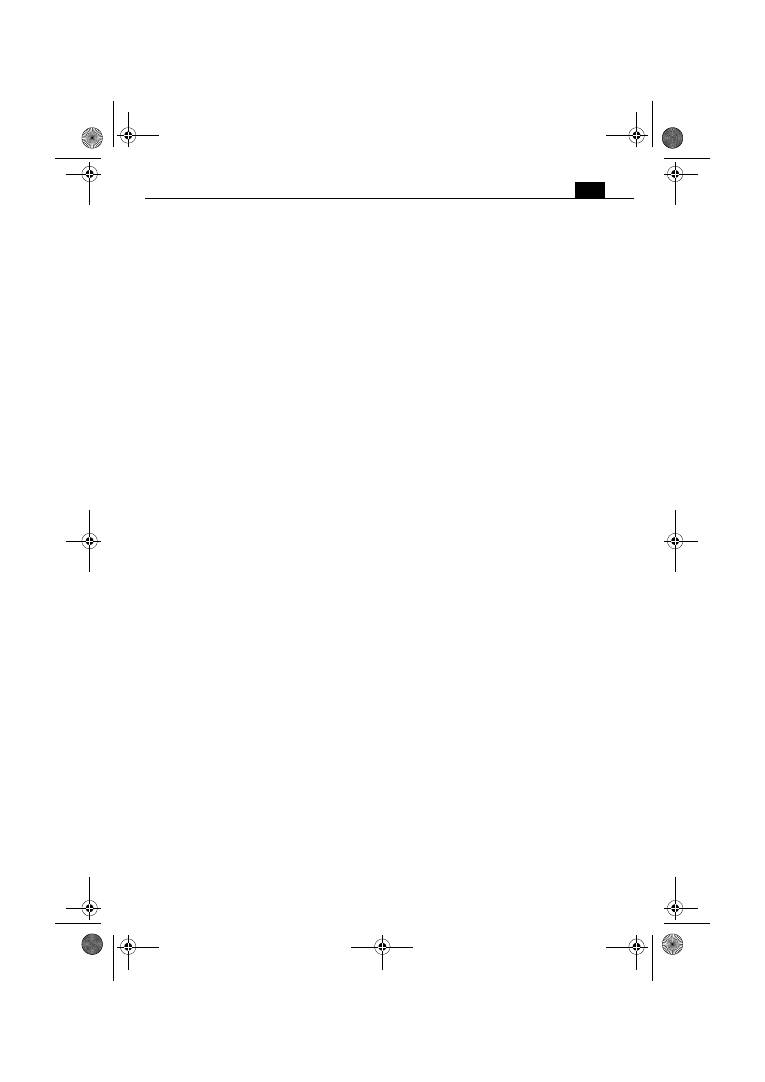
79
ru
Актуальный список запчастей к этому
электроинструменту Вы найдете в Интернете по
адресу: www.fein.com.
При необходимости Вы можете самостоятельно
заменить следующие части:
сменные рабочие
инструменты, ограничитель глубины, аккумулятор,
крючок для подвески на лесах, магазин
Обязательная гарантия и
дополнительная гарантия
изготовителя.
Обязательная гарантия на изделие предоставляется
в соответствии с законоположениями в стране
пользователя. Сверх этого, FEIN предоставляет
дополнительную гарантию в соответствии с
гарантийным обязательством изготовителя FEIN.
Комплект поставки Вашего электроинструмента
может не включать весь набор описанных или
изображенных в этом руководстве по эксплуатации
принадлежностей.
Декларация соответствия.
С исключительной ответственностью фирма FEIN
заявляет, что настоящее изделие соответствует
нормативным документам, приведенным на
последней странице настоящего руководства по
эксплуатации.
Техническая документация: C. & E. FEIN GmbH,
C-DB_IA, D-73529 Schwäbisch Gmünd
Охрана окружающей среды,
утилизация.
Упаковку, пришедшие в негодность
электроинструменты и принадлежности следует
собирать для экологически чистой утилизации.
Сдавайте аккумуляторы на утилизацию только в
разряженном состоянии.
Для предотвращения коротких замыканий в
неполностью разряженных аккумуляторах
изолируйте штекерные соединения клейкой лентой.
OBJ_BUCH-0000000072-001.book Page 79 Monday, June 18, 2012 8:40 AM
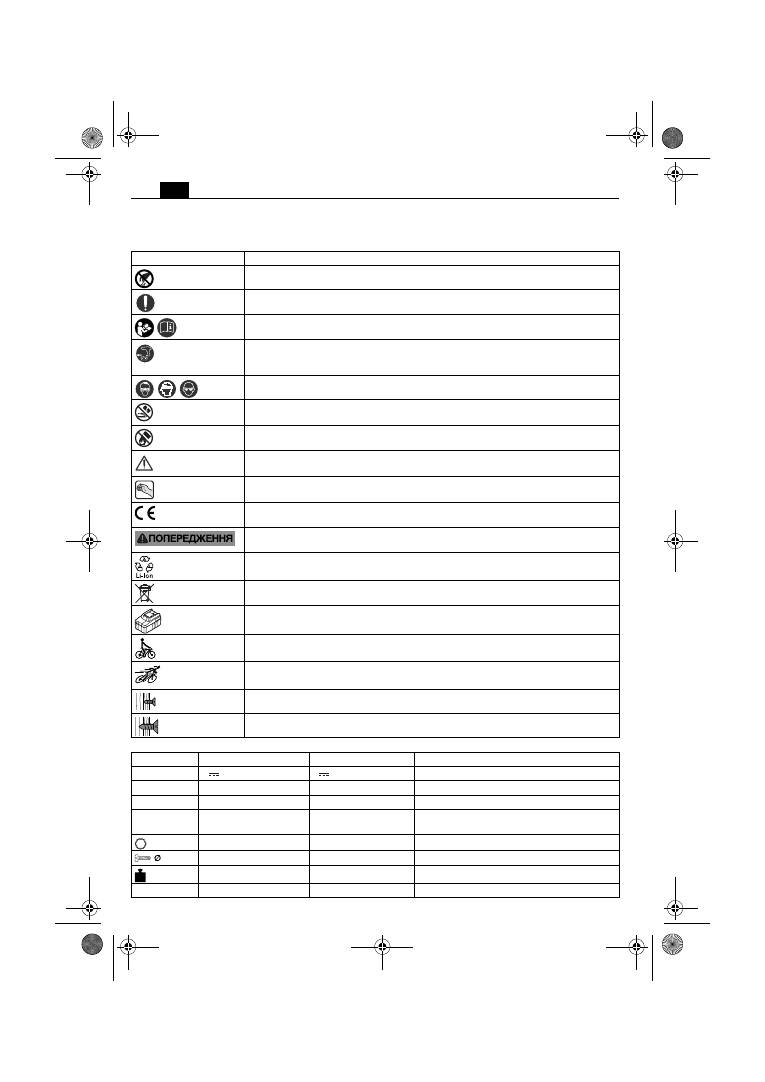
80
uk
uk
Оригінальна інструкція з експлуатації акумуляторного шуруповерта.
Використані символи, скорочення та поняття.
Символ, позначка
Пояснення
Не торкайтеся до деталей електроінструменту, що обертаються.
Дотримуйтеся інструкцій, які містяться в тексті та на малюнку поруч!
Обов’язково прочитайте додані документи, напр., інструкцію з експлуатації та
загальні вказівки з техніки безпеки.
Перед виконанням цієї робочої операції витягніть акумуляторну батарею із
електроінструменту. Інакше виникне небезпека поранення внаслідок
ненавмисного запуску електроінструменту.
Під час роботи одягайте захисні окуляри.
Не заряджайте пошкоджені акумуляторні батареї.
Захищайте акумуляторну батарею від вогню. Захищайте акумуляторну батарею
від тепла, напр., від тривалого нагрівання на сонці.
Дотримуйтеся вказівок, що зазначені поруч!
Зона тримання
Підтвердження відповідності електроінструменту положенням директив
Європейського Співтовариства.
Ця вказівка повідомляє про можливість виникнення небезпечної ситуації, яка
може привести до серйозних травм або смерті.
Знак вторинної переробки: позначає матеріали, що придатні для повторного
використання
Відпрацьовані електроінструменти та інші електротехнічні і електронні вироби
повинні здаватися окремо і утилізуватися екологічно чистим способом.
Тип акумуляторної батареї
Мала кількість обертів
Велика кількість обертів
Зменшення обертального моменту
Збільшення обертального моменту
Позначка
Міжнародна одиниця
Національна одиниця
Пояснення
U
V
В
Електрична напруга постійного струму
n
0
/min, min
-1
, rpm, r/min
/хвил.
Кількість обертів холостого ходу
n
1
/min, min
-1
, rpm, r/min
/хвил.
Кількість обертів під навантаженням
M...
Nm
Нм
Обертальний момент (закручування в
тверді/м’які матеріали)
inch
дюйм
Шестигранний патрон
mm
мм
Діаметр шурупа
kg
кг
Вага відповідно до EPTA-Procedure 01/2003
L
pA
dB
дБ
Рівень звукового тиску
OBJ_BUCH-0000000072-001.book Page 80 Monday, June 18, 2012 8:40 AM
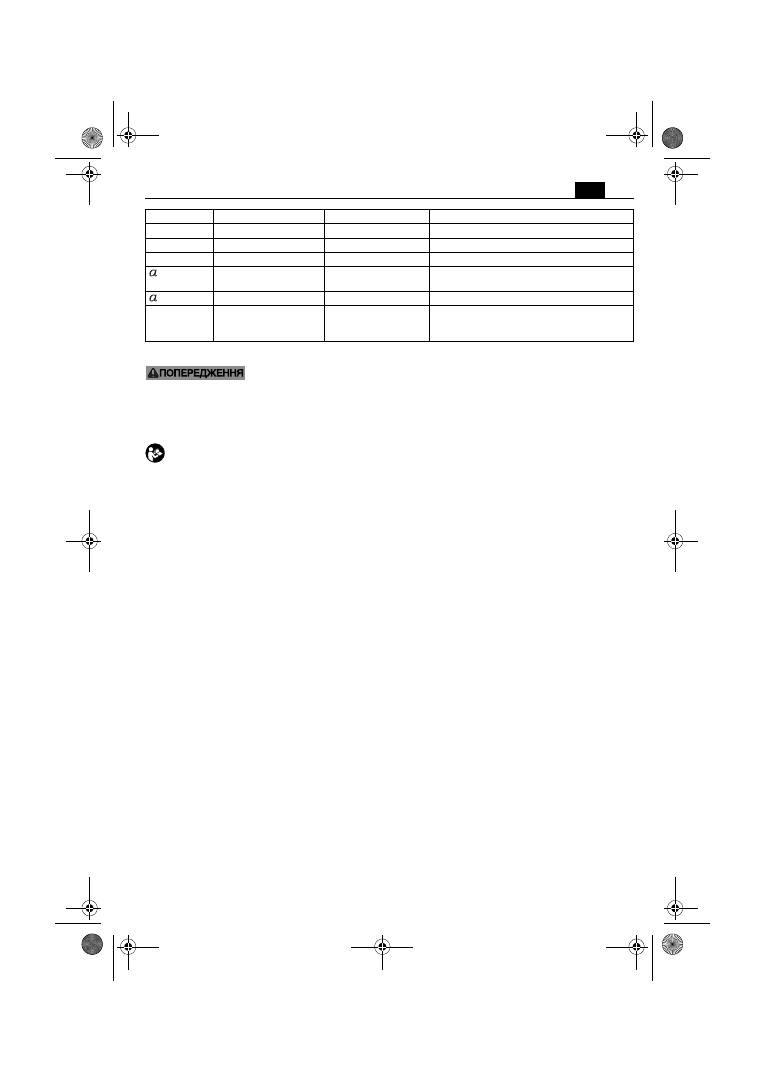
81
uk
Для Вашої безпеки.
Прочитайте всі правила з
техніки безпеки і вказівки.
Невиконання правил з техніки безпеки і вказівок
може призводити до удару електричним струмом,
пожежі та/або важких травм.
Зберігайте всі правила з техніки безпеки і вказівки на
майбутнє.
Не застосовуйте цей електроінструмент, не
прочитавши уважно та не зрозумівши дану
інструкцію з експлуатації та додані «Загальні
вказівки з техніки безпеки» (номер документа
3 41 30 054 06 1). Зберігайте названі документи для
подальшого використання та додавайте їх до
електроінструменту при його передачі в
користування або при продажу.
Зважайте також на чинні національні приписи з
охорони праці.
Призначення електроінструменту:
pучний шуруповерт для закручування та
відкручування шурупів, особливо для
закручування/відкручування саморізів в
гіпсокартонних плитах, для роботи в закритих
приміщеннях з допущеними фірмою FEIN робочими
інструментами та приладдям.
Специфічні вказівки з техніки безпеки.
При роботах, коли гвинт може зачепити заховану
електропроводку, тримайте електроінструмент за
ізольовані рукоятки.
Зачеплення проводки, що
знаходиться під напругою, може заряджувати також
і металеві частини електроінструмента та
призводити до ураження електричним струмом.
Звертайте увагу на приховану електропроводку,
газопроводи та водопроводи.
Перед початком
роботи перевірте зону роботи, напр., за допомогою
металошукача.
Фіксуйте оброблювану деталь.
Закріплена в
затискному пристрої деталь утримується надійніше,
ніж у Вашій руці.
Добре тримайте електроінструмент.
Можливі короткі,
але сильні реакційні моменти.
Не обробляйте матеріали, що містять азбест.
Азбест
вважається канцерогенним.
Забороняється закріплювати на електроінструменті
таблички та позначки за допомогою гвинтів або
заклепок.
Пошкоджена ізоляція не захищає від
ураження електричним струмом. Таблички треба
приклеювати.
Не використовуйте приладдя, яке не було
сконструйоване виробником електроінструменту саме
для даного електроінструменту або на застосування
якого немає дозволу виробника.
Сама лише
можливість закріплення приладдя на Вашому
електроінструменті не є гарантією його безпечної
експлуатації.
Використання та поводження з акумуляторними
батареями (акумуляторними блоками)
Для уникнення небезпек, таких, напр., як опіків,
пожеж, вибухів, пошкоджень шкіряного покриву та
інших травм, що можуть виникнути при використанні
акумуляторних батарей, дотримуйтеся наступних
вказівок:
Не розбирайте, не відкривайте і не розколюйте
акумуляторні батареї. Не піддавайте акумуляторні
батареї впливу механічних ударів.
При пошкодженні
або неправильній експлуатації акумуляторних
батарей може виходити шкідливий пар або рідина.
Пар може подразнювати дихальні шляхи. Витекла
рідина з акумуляторної батареї може викликати
подразнення шкіри або хімічні опіки.
Якщо рідина, що витекла із пошкодженої
акумуляторної батареї, потрапила на оточуючі
предмети, огляньте ці предмети, за необхідністю
очистіть їх або замініть.
Не піддавайте акумуляторну батарею впливу високих
температур або вогню. Не зберігайте акумуляторну
батарею під впливом прямих сонячних променів.
Виймайте акумуляторну батарею із оригінальної
упаковки лише перед її безпосереднім
використанням.
Перед будь-якими маніпуляціями з електро-
інструментом виймайте акумуляторну батарею з
електроінструменту.
При самовільному увімкненні
електроінструменту існує небезпека поранення.
Виймайте акумуляторну батарею лише тоді, коли
електроінструмент вимкнений.
Зберігайте акумуляторні батареї в недосяжному для
дітей місці.
Тримайте акумуляторну батарею в чистоті і захищайте
її від вологи та води.
Очищайте забруднені контакти
акумуляторної батареї та електроінструменту сухою,
чистою ганчіркою.
L
wA
dB
дБ
Рівень звукової потужності
L
pCpeak
dB
дБ
Піковий рівень звукового тиску
K...
Похибка
m/s
2
м/с
2
Вібрація у відповідності до EN 60745
(сума векторів трьох напрямків)
h
m/s
2
м/с
2
Вібрація (закручування/відкручування)
m, s, kg, A, mm, V,
W, Hz, N, °C, dB,
min, m/s
2
м, с, кг, A, мм, В,
Вт, Гц, Н, °C, дБ,
хвил., м/с
2
Основні та похідні одиниці Міжнародної
системи одиниць
SI
.
Позначка
Міжнародна одиниця
Національна одиниця
Пояснення
OBJ_BUCH-0000000072-001.book Page 81 Monday, June 18, 2012 8:40 AM
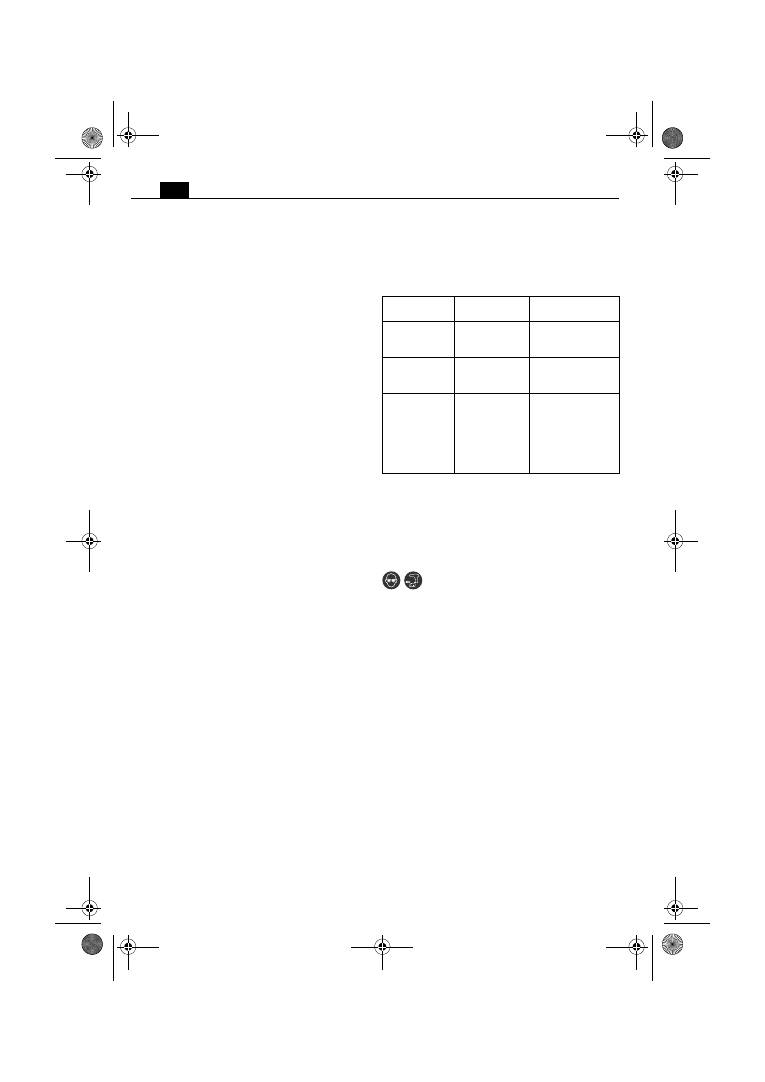
82
uk
Використовуйте лише справні оригінальні
акумуляторні батареї фірми FEIN, які передбачені для
Вашого електроінструменту.
При використанні та
заряджанні невідповідних, пошкоджених,
відремонтованих або відновлених акумуляторних
батарей, підробок та акумуляторних батарей інших
виробників існує небезпека пожежі та/або вибуху
акумуляторної батареї.
Дотримуйтеся вказівок з техніки безпеки, які описані
в інструкції з експлуатації зарядного пристрою
акумуляторної батареї.
Вібрація руки
Зазначений в цих вказівках рівень вібрації
вимірювався за процедурою, визначеною в
EN 60745; нею можна користуватися для порівняння
приладів. Цією цифрою можна користуватися також
і для попередньої оцінки вібраційного
навантаження.
Зазначений рівень вібрації стосується головних
робіт, на які розрахований електроінструмент.
Однак при застосуванні електроінструменту для
інших робіт, роботі з іншими робочими
інструментами або при недостатньому технічному
обслуговуванні рівень вібрації може бути іншим. Це
може значно збільшити вібраційне навантаження
протягом всього часу роботи.
Для точної оцінки вібраційного навантаження треба
ураховувати також і інтервали, коли прилад
вимкнутий або коли він хоч і увімкнутий, але не
використовується. Це може значно зменшити
вібраційне навантаження протягом всього часу
роботи.
Визначте додаткові заходи безпеки для захисту від
вібрації працюючого з інструментом, як напр.:
технічне обслуговування електроінструменту і
робочих інструментів, тримання рук у теплі,
організація робочих процесів.
Вказівки з експлуатації.
Приводьте в дію перемикач напрямку обертання
лише при зупиненому двигуні.
Установіть перемикач напрямку обертання в середнє
положення, щоб запобігти ненавмисному вмиканню,
напр., під час транспортування.
При перегріванні електроприлад працює з
короткими, слабкими ривками. Дайте
електроприладу охолонути на холостому ходу.
ASCT14/ASCT14M/ASCT18/ASCT18M:
При закручуванні
шурупів має бути монтований обмежувач глибини.
ASCT14M/ASCT14UM/ASCT18M/ASCT18UM:
Застосовуйте магазин для шурупів лише при
«правому напрямку обертання».
Регулювання обертального моменту (ASCT14U/
ASCT14UM/ASCT18U/ASCT18UM) (див. стор. 7).
Заводські настройки розраховані на шурупи
невеликого та середнього розміру.
Момент затягування залежить також і від сили, з
якою електроприлад притискується до шурупа.
Поводження із акумуляторною батареєю.
Користуйтеся акумуляторною батареєю і
заряджайте її лише в діапазоні робочої температури
акумуляторної батареї 0 °C – 45 °C (32 °F – 113 °F).
На початку процесу заряджання температура
акумуляторної батареї повинна знаходитися в
робочому діапазоні.
Дійсний ступінь зарядженості акумуляторної батареї
у відсотках відображається лише при зупиненому
двигунові електроінструменту.
Якщо акумуляторна батарея починає сідати,
електроніка електроінструменту автоматично
зупиняє двигун.
Ремонт та сервісні послуги.
В екстремальних умовах застосування для
обробки металів усередині
електроінструменту може осідати
електропровідний пил. Часто продувайте внутрішні
частини інструменту через вентиляційні щілини
сухим та нежирним стисненим повітрям.
Актуальний перелік запчастин до цього
електроінструменту Ви знайдете в Інтернеті за
адресою: www.fein.com.
За необхідністю Ви можете самостійно замінити
наступні деталі:
робочі інструменти, обмежувач
глибини, акумулятор, гачок для підвішування на
риштуванні, магазин
Гарантія.
Гарантія на виріб надається відповідно до
законодавчих правил країни збуту. Крім цього, фірма
FEIN надає заводську гарантію відповідно до
гарантійного талона виробника.
Можливо, що в обсяг поставки Вашого електро-
інструменту входить не все описане або зображене в
даній інструкції з експлуатації приладдя.
Заява про відповідність.
Фірма FEIN заявляє під свою особисту
відповідальність, що цей виріб відповідає чинним
приписам, викладеним на останній сторінці цієї
інструкції з експлуатації.
Технічна документація: C. & E. FEIN GmbH, C-DB_IA,
D-73529 Schwäbisch Gmünd
Світлодіодний
індикатор
Значення
Дія
1 – 4 зелені
світлодіоди
ступінь
зарядженості у
відсотках
Експлуатація
світіння
червоного
світлодіода
Акумуляторна
батарея майже
розрядилася
Зарядіть
акумуляторну
батарею
мигання
червоного
світлодіода
Акумуляторна
батарея не
готова до
роботи
Зачекайте, поки
акумуляторна
батарея не
досягне діапазону
робочої
температури, і
потім зарядіть її
OBJ_BUCH-0000000072-001.book Page 82 Monday, June 18, 2012 8:40 AM
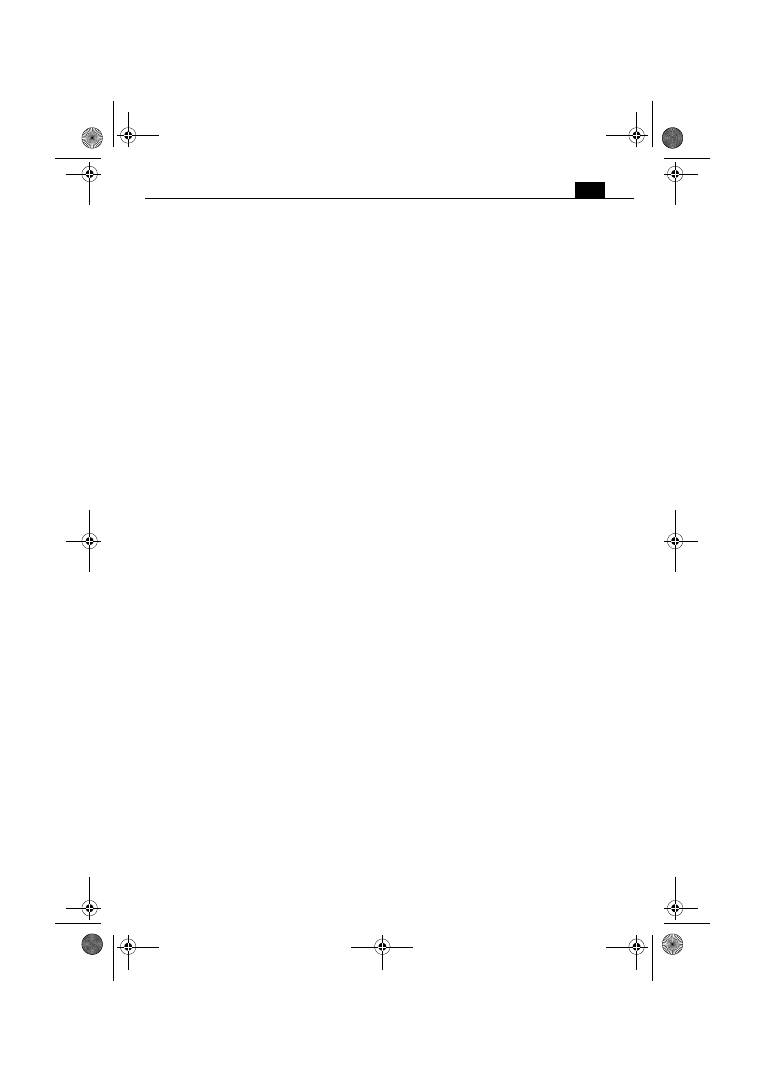
83
uk
Захист навколишнього середовища,
утилізація.
Упаковку, відпрацьовані електроінструменти та
приладдя потрібно утилізувати екологічно чистим
способом.
Здавайте акумуляторні батареї на відповідну
утилізацію лише в розрядженому стані.
Для уникнення коротких замикань в неповністю
розряджених акумуляторних батареях ізолюйте
штекерні роз’єми клейкою стрічкою.
OBJ_BUCH-0000000072-001.book Page 83 Monday, June 18, 2012 8:40 AM
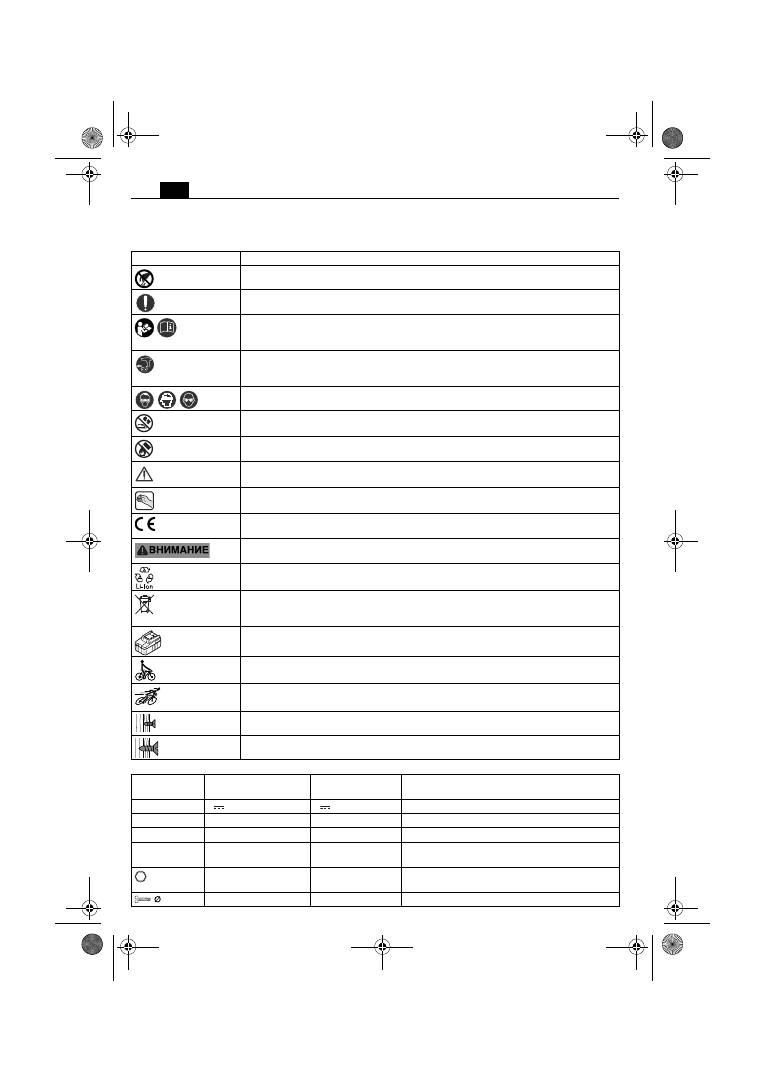
84
bg
bg
Оригинално ръководство за експлоатация на акумулаторен винтоверт.
Използвани символи, съкращения и термини.
Символ, означение
Пояснение
Не допирайте въртящите се детайли на електроинструмента.
Следвайте указанията на текста, респ. фигурите в съседство!
Непременно прочетете всички включени в окомплектовката на
електроинструмента документи, като ръководство за експлоатация и общи
указания за безопасна работа.
Преди тази стъпка извадете акумулаторната батерия от електроинструмента. В
противен случай съществува опасност от нараняване вследствие на неволно
включване на електроинструмента.
Работете с предпазни очила.
Не зареждайте повредени акумулаторни батерии.
Не оставяйте акумулаторната батерия в близост до открит огън. Предпазвайте я от
нагряване, напр. също и от продължително въздействие на преки слънчеви лъчи.
Спазвайте стриктно указанията в съседния текст!
Зона на ръкохватката
Удостоверява съответствието на електроинструмента на директиви на
Европейския съюз.
Този знак указва възможна опасна ситуация, която може да предизвика тежки
травми или смърт.
Знак за рециклиране: обозначава рециклируеми материали
Амортизирани електроинструменти и други електронни и електрически продукти
трябва да бъдат събирани отделно от битовите отпадъци и да бъдат предавани за
вторична преработка на съдържащите се в тях суровини.
Тип на акумулаторната батерия
Ниска скорост на въртене
Висока скорост на въртене
Намаляване на въртящия момент
Увеличаване на въртящия момент
Символ
Международно
означение
Национално
означение
Пояснение
U
V
V
Електрическо напрежение
n
0
/min, min
-1
, rpm, r/min /min
Скорост на въртене на празен ход
n
1
/min, min
-1
, rpm, r/min /min
Скорост на въртене под натоварване
M...
Nm
Nm
Въртящ момент (твърдо/меко винтово
съединение)
inch
инч
Гнездо за работни инструменти вътрешен
шестостен
mm
mm
Диаметър на винт
OBJ_BUCH-0000000072-001.book Page 84 Monday, June 18, 2012 8:40 AM
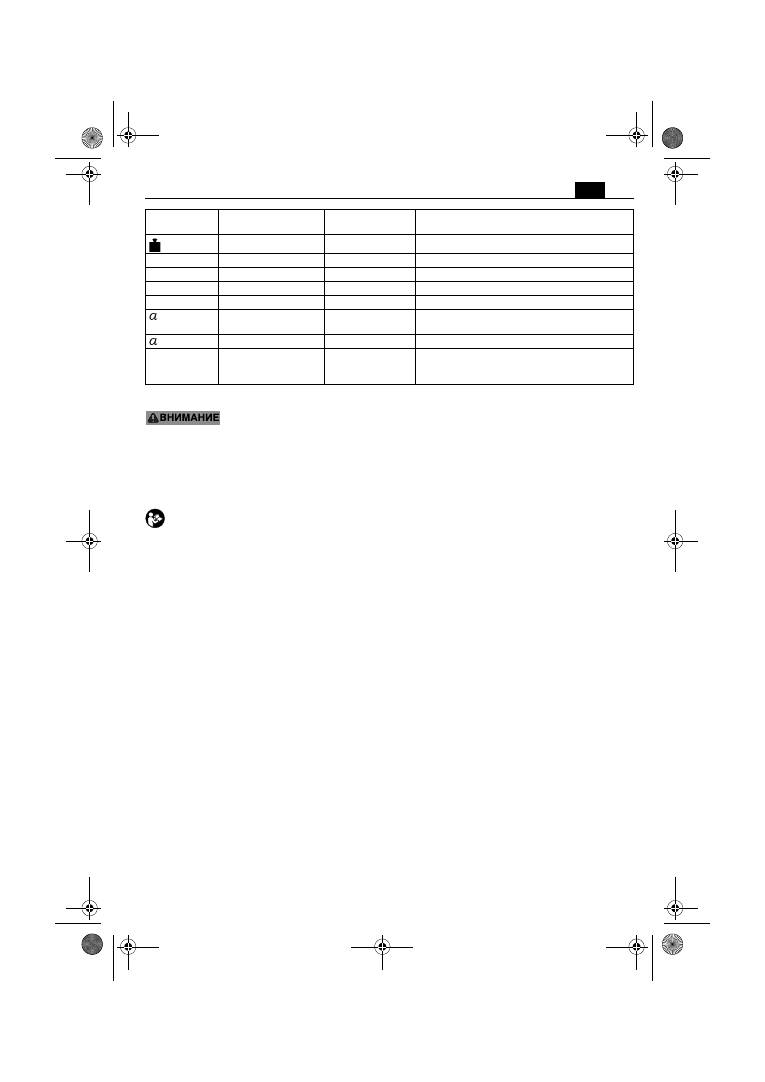
85
bg
За Вашата сигурност.
Прочетете всички указания за
безопасна работа и за работа с
електроинструмента.
Пропуски при спазването на
указанията за безопасна работа и за работа с
електроинструмента могат да предизвикат токов
удар, пожар и/или тежки травми.
Съхранявайте всички указания за безопасна работа и
за работа с електроинструмента за ползване в
бъдеще.
Не използвайте този електроинструмент,
преди внимателно да прочетете и напълно да
разберете това ръководство за експлоатация,
както и приложените «Общи указания за безопасна
работа» (Номер на публикация 3 41 30 054 06 1).
Съхранявайте посочените материали за ползване по-
късно и при продажба на електроинструмента или
когато го давате за ползване от други лица ги
предавайте заедно с него.
Съблюдавайте също валидните национални
разпоредби по охрана на труда.
Предназначение на електроинструмента:
pъчен винтоверт за завиване и развиване на винтове,
специално предназначен за използване при сухо
строителство с рапидни винтове, с допуснати от
FEIN работни инструменти и допълнителни
приспособления и в закрити помещения.
Специални указания за безопасна работа.
Когато съществува опасност по време на работа
винтът да засегне скрити под повърхността
проводници под напрежение, допирайте
електроинструмента само до изолираните ръкохватки.
При съприкосновение с проводник под напрежение
то може да се предаде и по металните повърхности
на електроинструмента и това да предизвика токов
удар.
Внимавайте за скрити под повърхността електрически
проводници, газопроводни и водопроводни тръби.
Преди да започнете работа проверявайте работната
зона, напр. с металотърсач.
Осигурявайте добре обработвания детайл.
Детайл,
захванат с подходящо приспособление, се държи
по-сигурно и безопасно, отколкото, ако го държите
с ръка.
Дръжте електроинструмента здраво.
Съществува
опасност от внезапното възникване на силни
краткотрайни реакционни моменти.
Не обработвайте съдържащ азбест материал.
Азбестът се счита за канцерогенен.
Забранява се захващането към корпуса на
електроинструмента на табелки или знаци с винтове
или нитове.
Повредена изолация не осигурява защита
от токов удар. Използвайте самозалепващи се
табелки.
Не използвайте допълнителни приспособления, които
не са изрично проектирани или допуснати за употреба
от производителя на електроинструмента.
Фактът, че
дадено приспособление може да бъде монтирано
към електроинструмента, не означава, че ползването
му е безопасно.
Работа с и ползване на акумулаторни батерии
За да избягвате опасности като изгаряния, пожар,
експлозия, кожни рани и други наранявания при
работа с акумулаторни батерии, спазвайте следните
указания:
Не се допуска отварянето, разглобяването или
разчупването на акумулаторните батерии. Не
излагайте акумулаторните батерии на силни
механични въздействия.
При повреждане и
неправилна експлоатация на акумулаторните
батерии могат да се отделят вредни пари и течности.
Парите могат да раздразнят дихателните пътища.
Изтичащ от акумулаторната батерия електролит
може да предизвика зачервяване на кожата или
изгаряния.
Ако изтичащият от повредена акумулаторна батерия
електролит е намокрил съседни елементи, ги
прегледайте внимателно, почистете ги, а при
необходимост ги заменете.
Не излагайте акумулаторната батерия на прякото
въздействие на отоплителни тела или огън. Не я
оставяйте на директна слънчева светлина.
Изваждайте акумулаторната батерия от оригиналната
й опаковка едва когато трябва да я използвате.
kg
kg
Маса съгласно EPTA-Procedure 01/2003
L
pA
dB
dB
Равнище на звуковото налягане
L
wA
dB
dB
Равнище на мощността на звука
L
pCpeak
dB
dB
Пиково равнище на звуковото налягане
K...
Неопределеност
m/s
2
m/s
2
Генерирани вибрации съгласно EN 60745
(векторна сума по трите направления)
h
m/s
2
m/s
2
Генерирани вибрации (завиване/развиване)
m, s, kg, A, mm, V, W,
Hz, N, °C, dB, min,
m/s
2
m, s, kg, A, mm, V,
W, Hz, N, °C, dB,
min, m/s
2
Основни и производни единици от
Международната система за мерни единици
SI
.
Символ
Международно
означение
Национално
означение
Пояснение
OBJ_BUCH-0000000072-001.book Page 85 Monday, June 18, 2012 8:40 AM
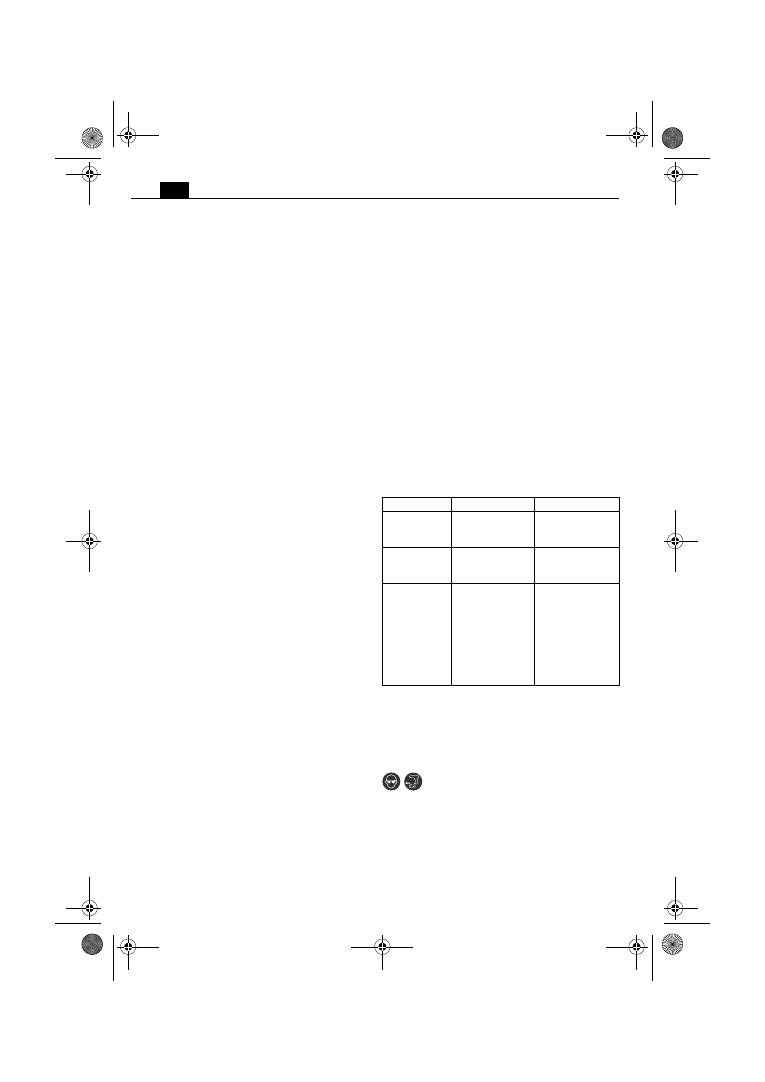
86
bg
Преди да извършвате каквито и да е дейности по
електроинструмента, изваждайте акумулаторната
батерия.
Ако включите неволно
електроинструмента, съществува опасност от
нараняване.
Изваждайте акумулаторната батерия само когато
електроинструментът е изключен.
Дръжте акумулаторната батерия далеч за деца.
Поддържайте акумулаторната батерия чиста и я
предпазвайте от овлажняване.
Почиствайте
замърсени контакти на акумулаторната батерия и на
електроинструмента с чиста суха кърпа.
Използвайте само изправни акумулаторни батерии на
FEIN, които са предназначени за електроинструмента.
При работа с и при зареждане на акумулаторни
батерии, които са неподходящи, повредени, били са
ремонтирани или са т.нар. «съвместими» и чуждо
производство съществува опасност от пожар и/или
експлозия.
Спазвайте указанията в ръководството за
експлоатация на акумулаторната батерия.
Предавани на ръцете вибрации
Посоченото в това ръководство за експлоатация
равнище на вибрациите е определено съгласно
процедура, посочена в стандарта EN 60745, и може
да бъде използвана за сравняване на различни
електроинструменти. То е подходящо също и за
груба предварителна оценка на натоварването от
вибрации.
Посоченото равнище на вибрациите е
представително за най-често срещаните
приложения на електроинструмента. Ако обаче
електроинструментът се използва при други
работни условия и за други приложения, с различни
работни инструменти или ако не бъде поддържан в
изрядно състояние, равнището на вибрациите може
да се отличава съществено от посоченото. Това би
могло значително да увеличи натоварването от
вибрации за целия производствен цикъл.
За точната преценка на натоварването от вибрации
трябва да се отчитат и интервалите от време, през
които електроинструментът е изключен или работи,
но не се използва. Това може значително да намали
натоварването от вибрации за целия производствен
цикъл.
Взимайте допълнителни мерки за предпазване на
работещия с електроинструмента от влиянието на
вибрациите, напр.: поддържане на
електроинструмента и работните инструменти в
изрядно състояние, подгряване и поддържане на
ръцете топли, подходяща организация на
последователността на работните цикли.
Указания за ползване.
Задействайте превключвателя за посоката на
въртене само когато електродвигателят е спрял.
Поставете превключвателя за посоката на въртене в
средно положение, за да предотвратите опасността
от включване на електроинструмента по
невнимание, напр. при пренасяне.
При прегряване електроинструментът работи с къси
слаби импулси. Оставете електроинструментът да
работи на празен ход, за да се охлади.
ASCT14/ASCT14M/ASCT18/ASCT18M:
Завиването
трябва да се извършва с дълбочинен ограничител.
ASCT14M/ASCT14UM/ASCT18M/ASCT18UM:
Магазинът
за винтове може да се използва само когато
превключвателят за посоката на въртене е в позиция
«въртене надясно».
Регулиране на въртящия момент
(ASCT14U/ASCT14UM/ASCT18U/ASCT18UM)
(вижте страница 7).
Настройката в завода-производител съответства на
диапазона за малки до средно големи винтове.
Въртящият момент на затягане зависи също и от
силата, с която електроинструментът се притиска
към винта.
Работа с акумулаторната батерия.
Ползвайте акумулаторната батерия и я зареждайте
само когато температурата й е в допустимия работен
интервал от 0 °C – 45 °C (32 °F – 113 °F). В началото на
процеса на зареждане температурата на
акумулаторната батерия трябва да е в рамките на
допустимия температурен интервал.
Реалният процент на зареденост на батерията се
показва само когато електродвигателят не работи.
Ако съществува опасност от дълбоко разреждане на
акумулаторната батерия, електронното управление
спира електродвигателя автоматично.
Поддържане и сервиз.
При екстремно тежки работни условия
при обработване на метали по вътрешните
повърхности на корпуса на
електроинструмента може да се отложи
токопровеждащ прах. Продухвайте често
вътрешното пространство на електроинструмента
със сух и обезмаслен сгъстен въздух.
Актуален списък с резервни части за този
електроинструмент можете да намерите в интернет
на адрес www.fein.com.
Светодиод
Значение
Действие
1 – 4 зелени
светодиода
процентна
степен на
зареденост
Работа
червена
непрекъсната
светлина
Акумулаторната
батерия е почти
празна
Заредете
аукмулаторната
батерия
червена
мигаща
светлина
Акумулаторната
батерия не е
готова за работа
Изчакайте
температурата на
акумулаторната
батерия да
достигне
допустимия
работен
интервал и след
това я заредете
OBJ_BUCH-0000000072-001.book Page 86 Monday, June 18, 2012 8:40 AM
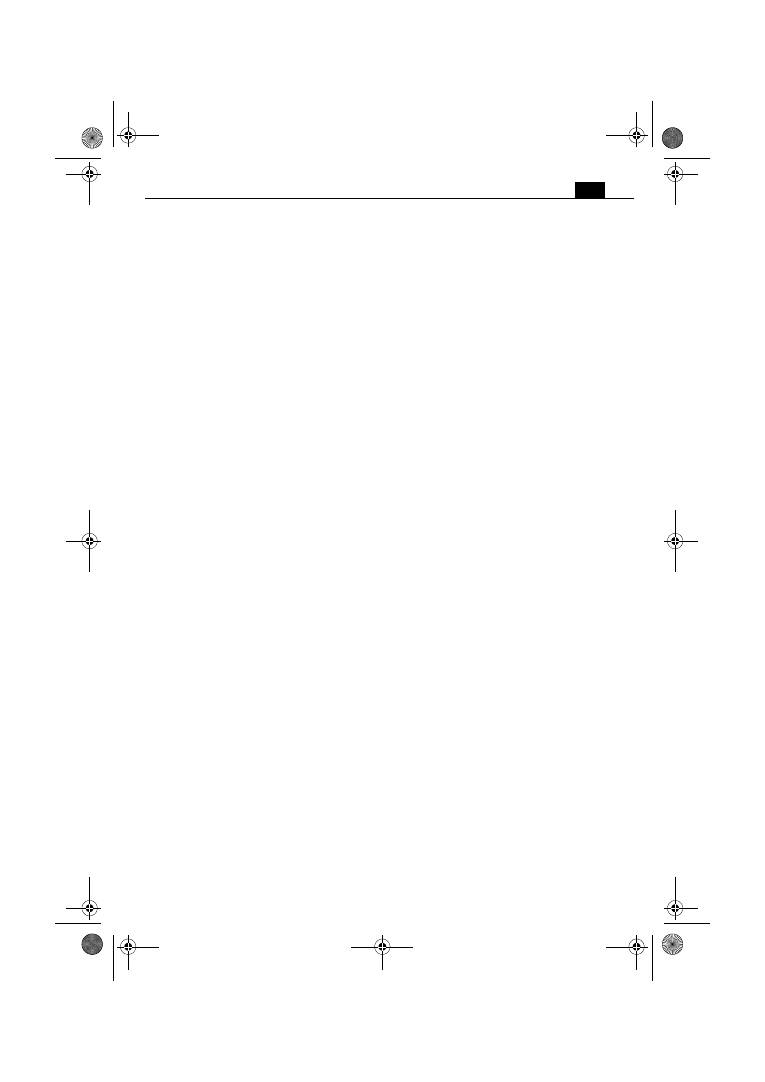
87
bg
При необходимост можете сами да замените следните
елементи:
Работни инструменти, дълбочинен
ограничител, акумулаторна батерия, кука за
окачване, магазин
Гаранция и гаранционно обслужване.
Гаранционното обслужване на електроинструмента
е съгласно законовите разпоредби в страната-
вносител. Освен това фирма FEIN осигурява
гаранционно обслужване съгласно Гаранционната
декларация на производителя на FEIN.
В окомплектовката на Вашия електроинструмент
може да са включени само част от описаните в това
ръководство и изобразени на фигурите
допълнителни приспособления.
Декларация за съответствие.
Фирма FEIN гарантира с пълна отговорност, че този
продукт съответства на валидните нормативни
документи, посочени на последната страница на
това ръководство за експлоатация.
Техническа документация при: C. & E. FEIN GmbH,
C-DB_IA, D-73529 Schwäbisch Gmünd
Опазване на околната среда,
бракуване.
Опаковките, излезлите от употреба
електроинструменти и допълнителни
приспособления трябва да се предават за
оползотворяване на съдържащите се в тях суровини.
Предавайте повредени акумулаторни батерии за
вторична преработка само напълно разредени.
Когато акумулаторната батерия не е напълно
разредена, като предпазна мярка срещу къси
съединения облепяйте контактите с изолираща
лента.
OBJ_BUCH-0000000072-001.book Page 87 Monday, June 18, 2012 8:40 AM
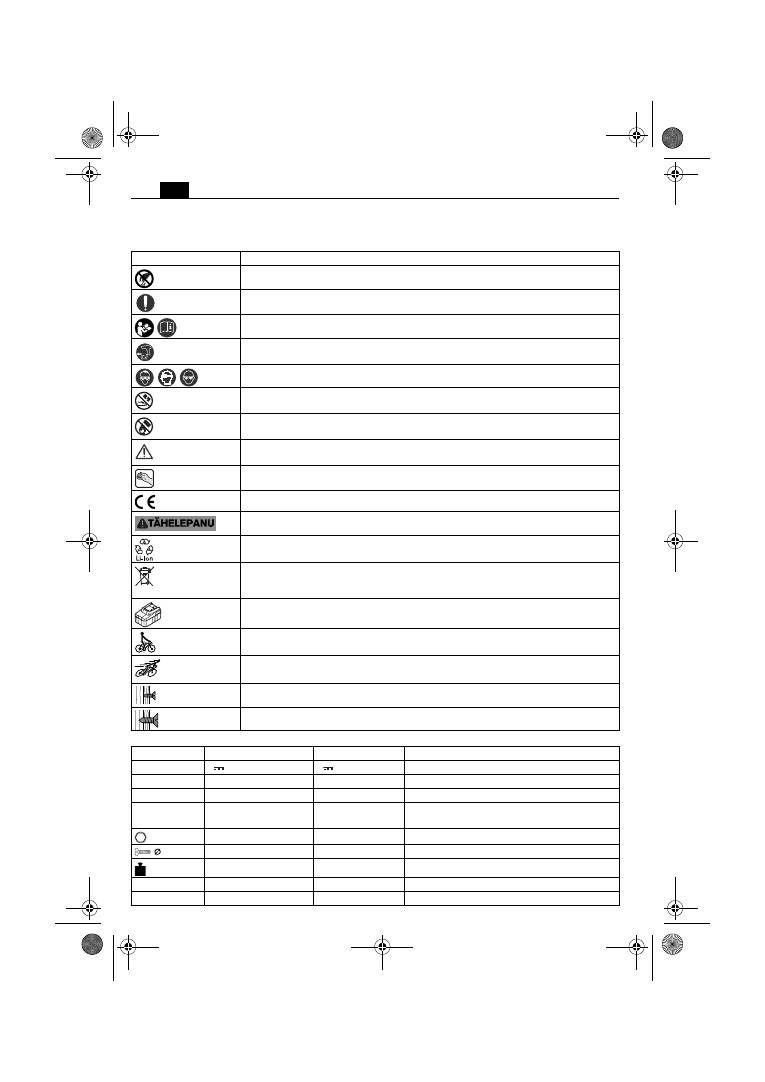
88
et
et
Algupärane kasutusjuhend: akukruvikeeraja.
Kasutatud sümbolid, lühendid ja mõisted.
Sümbol, tähis
Selgitus
Ärge puudutage elektrilise tööriista pöörlevaid osi.
Järgige kõrvaltoodud tekstis või joonisel sisalduvaid juhiseid!
Lugege tingimata läbi seadmele lisatud kasutusjuhend ja üldised ohutusnõuded.
Enne selle tööoperatsiooni tegemist eemaldage seadmest aku. Vastasel korral võib
elektriline tööriist soovimatult käivituda ja kasutajat vigastada.
Töötades kandke kaitseprille.
Ärge laadige vigastatud akusid.
Ärge jätke akut tule kätte. Kaitske akut kuumuse, sealhulgas pideva päikesekiirguse eest.
Järgige kõrvaltoodud tekstis sisalduvaid juhiseid!
Haardepiirkond
Kinnitab elektrilise tööriista vastavust Euroopa Liidu direktiividele.
Märkus viitab võimalikule ohuolukorrale, mis võib kaasa tuua tõsised vigastused või surma.
Ringlussevõtu tähis: tähistab korduskasutatavaid materjale
Kasutusressursi ammendanud elektrilised tööriistad ja teised elektrotehnilised ja
elektrilised seadmed tuleb sorteeritult kokku koguda ja keskkonnahoidlikult ringlusse
võtta.
Aku tüüp
Madalad pöörded
Kõrged pöörded
Pöördemomendi vähendamine
Pöördemomendi suurendamine
Tähis
Rahvusvaheline ühik
Riiklik ühik
Selgitus
U
V
V
Alalispinge
n
0
/min, min
-1
, rpm, r/min
/min
Tühikäigupöörded
n
1
/min, min
-1
, rpm, r/min
/min
Pöörete arv koormusel
M...
Nm
Nm
Pöördemoment (tugev/nõrk
kruvikeeramisrežiim)
inch
inch
Tarvikukinnitus: sisekuuskant
mm
mm
Kruvi läbimõõt
kg
kg
Kaal EPTA-Procedure 01/2003 järgi
L
pA
dB
dB
Helirõhu tase
L
wA
dB
dB
Helivõimsuse tase
OBJ_BUCH-0000000072-001.book Page 88 Monday, June 18, 2012 8:40 AM
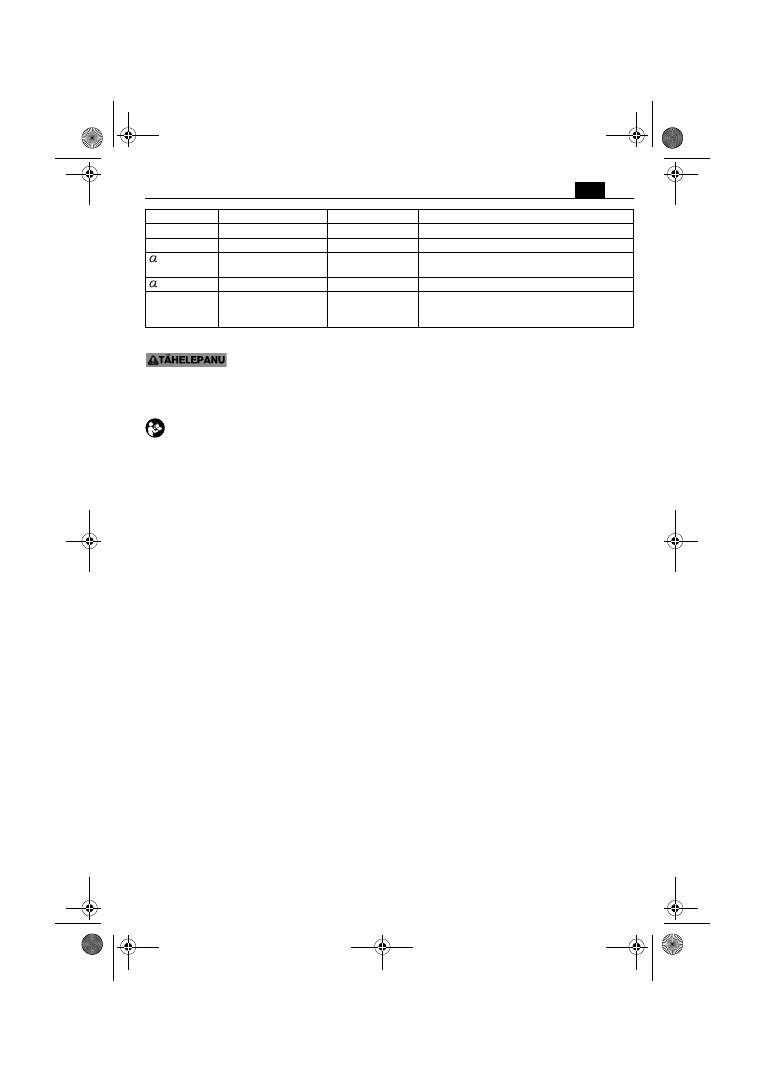
89
et
Tööohutus.
Lugege läbi kõik ohutusnõuded ja
juhised.
Ohutusnõuete ja juhiste
eiramine võib tuua kaasa elektrilöögi, tulekahju ja/või
rasked vigastused.
Hoidke kõik ohutusnõuded ja juhised edaspidiseks
kasutamiseks alles.
Enne elektrlise tööriista kasutuselevõttu lugege
põhjalikult läbi kasutusjuhend ja juurdekuuluvad
üldised ohutusnõuded (dokumendi nr
3 41 30 054 06 1). Hoidke kõik juhised edaspidiseks
kasutamiseks alles ja elektrilise tööriista edastamisel
kolmandatele isikutele pange kaasa ka nimetatud
dokumendid.
Pidage kinni ka asjaomastest siseriiklikest
töökaitsenõuetest.
Elektrilise tööriista otstarve:
käsitsi juhitav kruvikeeraja kruvide sisse- ja
väljakeeramiseks, sobib eeskätt sisetingimustes
kiirkinnituskruvide keeramiseks kergmaterjalidesse,
nõutav FEIN heakskiidetud tarvikute ja lisavarustuse
kasutamine.
Ohutusalased erinõuded.
Kui teostate töid, mille puhul võib kruvi tabada varjatud
elektrijuhtmeid, hoidke seadet ainult isoleeritud
käepidemetest.
Kontakt pinge all oleva elektrijuhtmega
võib pingestada seadme metallosad ja põhjustada
elektrilöögi.
Pöörake tähelepanu varjatult paiknevatele
elektrijuhtmetele, gaasi- ja veetorudele.
Enne töö algust
kontrollige tööpiirkond üle nt metalliotsijaga.
Kinnitage töödeldav toorik.
Kinnitusvahendite abil
kinnitatud toorik püsib paremini paigal kui käega hoides.
Hoidke elektrilist tööriista kindlalt käes.
Lühiajaliselt võib
tekkida suuri reaktsioonimomente.
Asbesti sisaldava materjali töötlemine on keelatud.
Asbest võib tekitada vähki.
Elektrilisele tööriistale ei tohi kruvide või neetidega
kinnitada silte ja märgiseid.
Kahjustatud isolatsioon ei
taga kaitset elektrilöögi eest. Kasutage kleebiseid.
Ärge kasutage teiste tootjate tarvikuid, mida elektrilise
tööriista tootja ei ole heaks kiitnud.
Asjaolu, et tarvikut
saab tööriista külge kinnitada, ei taga veel tööriista ohutut
tööd.
Aku kasutamine ja käsitsemine (akud)
Selleks et vältida akude käsitsemisest tingitud põletusi,
tulekahju, plahvatust, nahavigastusi ja teisi vigastusi,
pidage kinni järgmistest juhistest:
Akusid ei tohi lahti võtta, avada aga tükeldada. Akudele
ei tohi avalduda mehaanilised mõjutused, nt löögid.
Aku
vigastamisel ja ebaõigel käsitsemisel võib akust eralduda
kahjulikke aure ja vedelikke. Aurud võivad ärritada
hingamisteid. Väljavoolav akuvedelik võib põhjustada
nahaärritust või söövitust.
Kui vigastatud akust väljavoolanud vedelik on puutunud
kokku läheduses olevate esemetega, kontrollige
asjaomased detailid üle, puhastage ja vahetage vajaduse
korral välja.
Ärge jätke akut kuumuse või tule kätte. Ärge hoidke akut
otsese päikesekiirguse käes.
Võtke aku originaalpakendist välja alles vahetult enne
kasutuselevõttu.
Enne mis tahes tööde teostamist elektrilise tööriista
kallal eemaldage aku.
Elektrilise tööriista soovimatu
käivitumise korral tekib vigastuste oht.
Eemaldage aku üksnes siis, kui elektriline tööriist on
välja lülitatud.
Tõkestage laste ligipääs akudele.
Hoidke aku puhas ja kaitske akut niiskuse ja vee eest.
Aku ja elektrilise tööriista määrdunud kontakte puhastage
kuiva puhta lapiga.
Kasutage ainult veatuid FEIN originaalakusid, mis on ette
nähtud Teie elektrilise tööriista jaoks.
Valede,
kahjustatud, parandatud või muudetud akude, samuti
järeletehtud akude või teiste tootjate akude kasutamisel
tekib tulekahju ja/või plahvatuse oht.
Järgige akulaadija kasutusjuhendis toodud
ohutusnõudeid.
Käe-randme-vibratsioon
Käesolevas juhendis toodud vibratsioon on mõõdetud
standardi EN 60745 kohase mõõtemeetodi järgi ja seda
saab kasutada elektriliste tööriistade omavaheliseks
võrdlemiseks. See sobib ka vibratsiooni esialgseks
hindamiseks.
Toodud vibratsioonitase kehtib tööriista kasutamisel
ettenähtud otstarbel. Kui aga elektrilist tööriista
kasutatakse muudeks töödeks, rakendatakse teisi
tarvikuid või kui tööriista hooldus pole piisav, võib
vibratsioonitase kõikuda. See võib vibratsiooni töö
koguperioodi jooksul tunduvalt suurendada.
L
pCpeak
dB
dB
Helirõhu maksimaalne tase
K...
Mõõtemääramatus
m/s
2
m/s
2
Vibratsioonitase EN 60745 järgi (kolme suuna
vektorsumma)
h
m/s
2
m/s
2
Vibratsioonitase (kruvikeeramine)
m, s, kg, A, mm, V,
W, Hz, N, °C, dB,
min, m/s
2
m, s, kg, A, mm, V,
W, Hz, N, °C, dB,
min, m/s
2
Rahvusvahelise mõõtühikute süsteemi
SI
põhiühikud ja tuletatud ühikud.
Tähis
Rahvusvaheline ühik
Riiklik ühik
Selgitus
OBJ_BUCH-0000000072-001.book Page 89 Monday, June 18, 2012 8:40 AM

90
et
Vibratsiooni täpseks hindamiseks tuleks arvesse võtta ka
aega, mil seade oli välja lülitatud või küll sisse lülitatud,
kuid tegelikult tööle rakendamata. See võib vibratsiooni
töö koguperioodi jooksul tunduvalt vähendada.
Kasutaja kaitsmiseks vibratsiooni eest võtke tarvitusele
täiendavad ohutusabinõud, näiteks: hooldage tööriistu ja
tarvikuid piisavalt, hoidke käed soojas, tagage sujuv
töökorraldus.
Tööjuhised.
Reverslülitit käsitsege ainult siis, kui mootor ei tööta.
Viige reverslüliti keskasendisse, et vältida seadme
soovimatut käivitumist näiteks transportimisel.
Ülekoormuse korral töötab elektriline tööriist lühikeste
nõrkade impulssidena. Laske elektrilisel tööriistal
tühikäigul maha jahtuda.
ASCT14/ASCT14M/ASCT18/ASCT18M:
Kruvide
keeramisel peab olema seadme külge kinnitatud
sügavuspiirik.
ASCT14M/ASCT14UM/ASCT18M/ASCT18UM:
Kruvimagasini võib kasutada üksnes siis, kui välja on
reguleeritud „parem käik“.
Pöördemomendi seadistamine (ASCT14U/
ASCT14UM/ASCT18U/ASCT18UM) (vt lk 7).
Vaikimisi on seadistatud väikestele kuni keskmise
suurusega kruvidele sobiv pöördemoment.
Pöördemoment sõltub ka jõust, millega seade vastu kruvi
surutakse.
Aku käsitsemine.
Käsitsege ja laadige akut üksnes siis, kui aku temperatuur
on vahemikus 0 °C – 45 °C (32 °F – 113 °F).
Laadimisprotsessi alguses peab aku temperatuur olema
ettenähtud vahemikus.
Aku tegelikku laetuse astet näidatakse vaid siis, kui
elektrilise tööriista mootor ei tööta.
Enne aku täielikku tühjenemist seiskab elektroonika
mootori automaatselt.
Korrashoid ja hooldus.
Äärmuslike töötingimuste korral võib
metallide töötlemisel koguneda seadmesse
elektrit juhtivat tolmu. Puhastage tööriista
sisemust ventilatsiooniavade kaudu korrapäraselt kuiva ja
õlivaba suruõhuga.
Elektrilise tööriista varuosade ajakohastatud loetelu leiate
Internetist veebilehelt www.fein.com.
Vajaduse korral võite ise välja vahetada järgmisi detaile:
tarvikud, sügavuspiirik, aku, tellingukonks, magasin
Garantii.
Tootele antakse garantii vastavalt maaletooja riigis
kehtivatele nõuetele. Lisaks sellele annab FEIN garantii
vastavalt FEIN tootjavastutuse deklaratsioonile.
Elektrilise tööriista tarnekomplekt ei pruugi sisaldada
kõiki käesolevas kasutusjuhendis kirjeldatud või
kujutatud tarvikuid.
Vastavusdeklaratsioon.
Firma FEIN kinnitab ainuvastutusel, et käesolev toode
vastab kasutusjuhendi viimasel leheküljel toodud
asjaomastele nõuetele.
Tehnilised dokumendid on saadaval aadressil:
C. & E. FEIN GmbH, C-DB_IA,
D-73529 Schwäbisch Gmünd
Keskkonnakaitse, utiliseerimine.
Pakendid, kasutusressursi ammendanud elektrilised
tööriistad ja tarvikud tuleb keskkonnahoidlikult ümber
töödelda ja ringlusse võtta.
Viige kogumispunkti ainult täiesti tühjad akud.
Kui akud ei ole täiesti tühjad, isoleerige pistik
lühiühinduse vältimiseks teibiga.
LED-tuli
Tähendus
Toiming
1 – 4 rohelist
LED-tuld
protsentuaalne
laetuse aste
Töötamine
punane pidev
tuli
Aku on
peaaegu tühi
Laadige aku täis
punane
vilkuv tuli
Aku ei ole
töövalmis
Laske akul soojeneda
või jahtuda, kuni aku
temperatuur on
ettenähtud vahemikus,
seejärel laadige
OBJ_BUCH-0000000072-001.book Page 90 Monday, June 18, 2012 8:40 AM

91
lt
lt
Akumuliatorinio suktuvo originali naudojimo instrukcija.
Naudojami simboliai, trumpiniai ir terminai.
Simbolis, ženklas
Paaiškinimas
Nelieskite besisukančių elektrinio įrankio dalių.
Laikykitės šalia esančiame tekste ar grafiniame vaizde pateiktų reikalavimų!
Būtinai perskaitykite pridėtus dokumentus, pvz., naudojimo instrukciją ir bendrąsias
saugos nuorodas.
Prieš pradėdami šį darbo žingsnį, iš elektrinio įrankio išimkite akumuliatorių. Priešingu
atveju, elektriniam įrankiui netikėtai įsijungus iškyla sužalojimo pavojus.
Dirbkite su akių apsaugos priemonėmis.
Nekraukite pažeistų akumuliatorių.
Saugokite akumuliatorių nuo ugnies. Saugokite akumuliatorių nuo karščio, pvz., taip pat ir
nuo nuolatinio saulės spindulių poveikio.
Laikykitės šalia esančiame tekste pateiktų reikalavimų!
Laikymo sritis
Patvirtina elektrinio įrankio atitiktį Europos Bendrijos direktyvoms.
Ši nuoroda įspėja apie galimą pavojingą situaciją, kuriai susidarius galima sunkiai ar mirtinai
susižaloti.
Utilizavimo ženklas: ženklina pakartotinai panaudojamas medžiagas.
Nebetinkamus naudoti elektrinius įrankius bei kitus elektrinius ir elektroninius gaminius
surinkite atskirai ir nugabenkite į antrinių žaliavų tvarkymo vietas perdirbti aplinkai
nekenksmingu būdu.
Akumuliatoriaus tipas
Mažas sūkių skaičius
Didelis sūkių skaičius
Sukimo momentą mažinti
Sukimo momentą didinti
Ženklas
Tarptautinis vienetas
Nacionalinis vienetas
Paaiškinimas
U
V
V
Elektros nuolatinė įtampa
n
0
/min, min
-1
, rpm, r/min
/min
Tuščiosios eigos sūkių skaičius
n
1
/min, min
-1
, rpm, r/min
/min
Sūkių skaičius esant apkrovai
M...
Nm
Nm
Sukimo momentas (standžioji/tamprioji
jungtis)
inch
coliai
Įrankių įtvaras su vidiniu šešiabriauniu
mm
mm
Varžtų skersmuo
kg
kg
Masė pagal „EPTA-Procedure 01/2003“
L
pA
dB
dB
Garso slėgio lygis
L
wA
dB
dB
Garso galios lygis
OBJ_BUCH-0000000072-001.book Page 91 Monday, June 18, 2012 8:40 AM

92
lt
Jūsų saugumui.
Perskaitykite visas saugos nuorodas
ir reikalavimus.
Nesilaikant saugos
nuorodų ir reikalavimų gali trenkti elektros smūgis, kilti
gaisras, galima susižaloti ar sužaloti kitus asmenis.
Išsaugokite šią instrukciją, kad ir ateityje galėtumėte ja
pasinaudoti.
Nepradėkite naudoti šio elektrinio įrankio, kol
atidžiai neperskaitėte ir gerai nesupratote šios
naudojimo instrukcijos bei pridėtų „Bendrųjų
saugos nuorodų“ (leidinio numeris 3 41 30 054 06 1).
Išsaugokite išvardytus dokumentus, kad ir ateityje
galėtumėte jais pasinaudoti, ir atiduokite juos kartu su
elektriniu įrankiu, jei perduodate ar parduodate jį kitam
savininkui.
Taip pat laikykitės specialiųjų nacionalinių darbo saugos
reikalavimų.
Elektrinio įrankio paskirtis:
Rankomis valdomas suktuvas varžtams įsukti ir išsukti,
specialiai skirtas naudoti su FEIN aprobuotais darbo
įrankiais ir papildoma įranga sausosios statybos darbams
su greitosios statybos varžtais nuo atmosferos poveikio
apsaugotoje aplinkoje.
Specialiosios saugos nuorodos.
Jei atliekate darbus, kurių metu varžtas gali kliudyti
paslėptus elektros laidus, tai elektrinį įrankį laikykite už
izoliuotų rankenų.
Prisilietus prie laido, kuriuo teka
elektros srovė, metalinėse prietaiso dalyse gali atsirasti
įtampa ir trenkti elektros smūgis.
Atkreipkite dėmesį į paslėptus elektros laidus, dujų
vamzdynus ir vandentiekio vamzdžius.
Prieš pradėdami
dirbti, darbo sritį patikrinkite, pvz., metalo ieškikliu.
Įtvirtinkite ruošinį.
Saugiau dirbti, kai ruošinys įtvirtintas
veržimo įrangoje nei laikomas rankoje.
Tvirtai laikykite elektrinį įrankį.
Galimas trumpalaikis
didelis reakcijos jėgų momentas.
Neapdorokite medžiagų, kurių sudėtyje yra asbesto.
Asbestas yra vėžį sukelianti medžiaga.
Draudžiama prie elektrinio įrankio prisukti ar prikniedyti
lenteles ar ženklus.
Pažeista izoliacija neapsaugo nuo
elektros smūgio. Naudokite klijuojamuosius ženklus.
Nenaudokite jokios papildomos įrangos, kurios specialiai
nesukūrė arba neaprobavo elektrinio įrankio gamintojas.
Tai, kad papildomą įrangą galima pritvirtinti prie įrankio,
nereiškia, kad bus saugu naudoti.
Akumuliatoriaus (akumuliatorių bloko) naudojimas
Kad dirbdami su akumuliatoriais išvengtumėte
nudegimo, gaisro, sprogimo, odos sužalojimo ir kitokių
pavojų, laikykitės šių nuorodų:
Akumuliatorius išardyti, atidaryti ar pjaustyti
draudžiama. Saugokite akumuliatorius nuo mechaninių
smūgių.
Pažeidus akumuliatorių ar netinkamai jį
naudojant, gali susidaryti kenksmingi garai ir ištekėti
skystis. Garai gali sudirginti kvėpavimo takus. Ištekėjęs
akumuliatoriaus skystis gali sudirginti arba nudeginti odą.
Jei iš pažeisto akumuliatoriaus ištekėjęs skystis apliejo
šalia esančius daiktus, užterštas dalis patikrinkite,
nuvalykite arba, jei reikia, pakeiskite.
Saugokite akumuliatorių nuo karščio ir ugnies.
Nelaikykite akumuliatoriaus tiesioginiuose saulės
spinduliuose.
Akumuliatorių iš originalios pakuotės išimkite tik tada,
kai jį reikia naudoti.
Prieš pradėdami elektrinio įrankio priežiūros ar remonto
darbus, išimkite iš jo akumuliatorių.
Netikėtai įsijungus
elektriniam įrankiui, iškyla sužalojimo pavojus.
Akumuliatorių išimkite tik tada, kai elektrinis įrankis
išjungtas.
Akumuliatorius saugokite nuo vaikų.
Akumuliatorių laikykite švarų ir apsaugotą nuo drėgmės
bei vandens.
Užterštas akumuliatoriaus ir elektrinio
įrankio jungtis nuvalykite sausu, švariu skudurėliu.
Naudokite tik nepažeistus originalius FEIN
akumuliatorius, skirtus jūsų elektriniam įrankiui.
Dirbant
su netinkamais, pažeistais, remontuotais, perdarytais,
falsifikuotais ar kitų gamintojų akumuliatoriais arba tokius
akumuliatorius kraunant, iškyla gaisro ir (arba) sprogimo
pavojus.
Laikykitės akumuliatoriaus kroviklio naudojimo
instrukcijoje pateiktų saugos nuorodų.
Plaštakas ir rankas veikianti vibracija
Šioje instrukcijoje pateiktas vibracijos lygis buvo
išmatuotas pagal EN 60745 normoje standartizuotą
matavimo metodą, ir lyginant elektrinius įrankius jį galima
naudoti. Jis skirtas vibracijos poveikiui laikinai įvertinti.
Nurodytas vibracijos lygis atspindi pagrindinius elektrinio
įrankio naudojimo atvejus. Tačiau jeigu elektrinis įrankis
naudojamas kitokiai paskirčiai, su kitokiais darbo įrankiais
arba jeigu jis nepakankamai techniškai prižiūrimas,
vibracijos lygis gali kisti. Tokiu atveju vibracijos poveikis
per visą darbo laikotarpį gali žymiai padidėti.
L
pCpeak
dB
dB
Aukščiausias garso slėgio lygis
K...
Paklaida
m/s
2
m/s
2
Vibracijos emisijos vertė pagal EN 60745
(trijų krypčių atstojamasis vektorius)
h
m/s
2
m/s
2
Vibracijos emisijos vertė (sukimas)
m, s, kg, A, mm, V,
W, Hz, N, °C, dB,
min, m/s
2
m, s, kg, A, mm, V,
W, Hz, N, °C, dB,
min, m/s
2
Tarptautinės matavimo vienetų sistemos
SI
baziniai ir išvestiniai vienetai.
Ženklas
Tarptautinis vienetas
Nacionalinis vienetas
Paaiškinimas
OBJ_BUCH-0000000072-001.book Page 92 Monday, June 18, 2012 8:40 AM
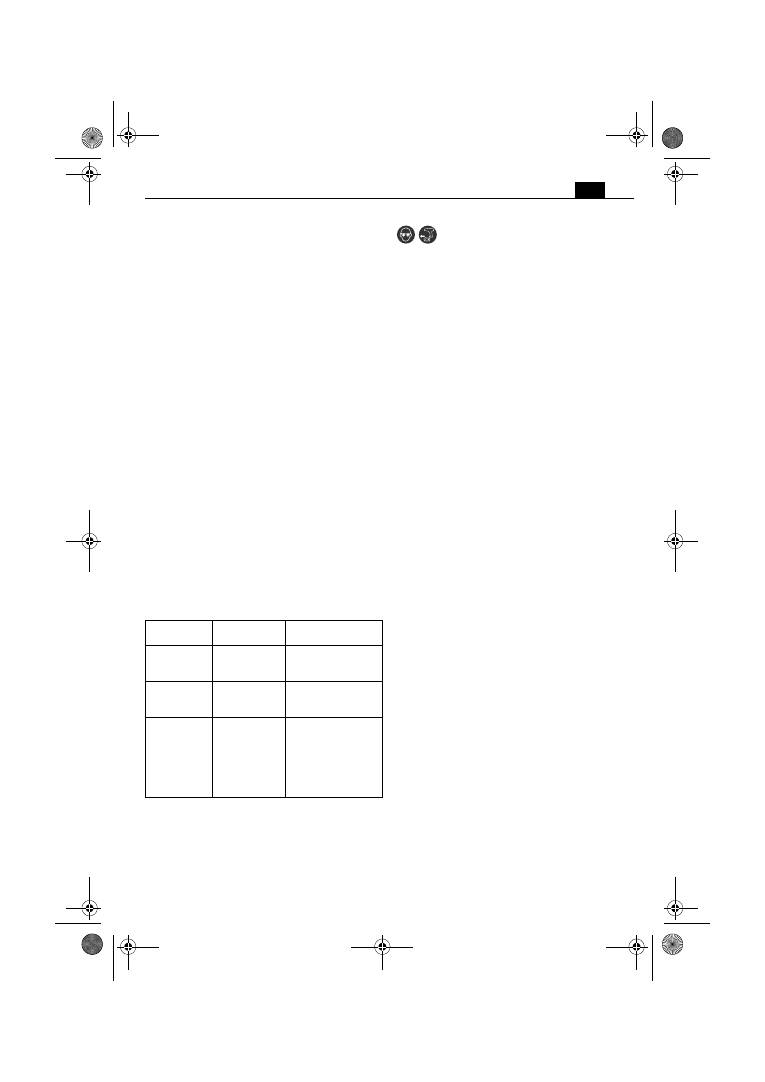
93
lt
Norint tiksliai įvertinti vibracijos poveikį, reikia atsižvelgti
ir į laiką, per kurį prietaisas buvo išjungtas arba, nors ir
veikė, bet nebuvo naudojamas. Tai įvertinus, vibracijos
poveikis per visą darbo laiką žymiai sumažės.
Dirbančiajam nuo vibracijos poveikio apsaugoti paskirkite
papildomas apsaugos priemones, pvz.: elektrinių ir darbo
įrankių techninę priežiūrą, rankų šildymą, darbo eigos
organizavimą.
Valdymo nuorodos.
Sukimosi krypties perjungiklį junkite tik tada, kai variklis
nesisuka.
Sukimosi krypties perjungiklį nustatykite į vidurinę
padėtį, kad, pvz., transportuodami, išvengtumėte
netikėto įjungimo.
Perkaitęs elektrinis įrankis veikia trumpais, silpnais
impulsais. Palaukite, kol tuščiąja eiga veikiantis elektrinis
įrankis atvės.
ASCT14/ASCT14M/ASCT18/ASCT18M:
sukti reikia tik
pritvirtinus gylio ribotuvą.
ASCT14M/ASCT14UM/ASCT18M/ASCT18UM:
varžtų
apkabą leidžiama naudoti tik padėtyje „Sukimosi kryptis į
dešinę“.
Sukimo momento nustatymas (ASCT14U/
ASCT14UM/ASCT18U/ASCT18UM) (žr. 7 psl.).
Gamykloje nustatytas sukimo momentas skirtas mažiems
ir vidutinio dydžio varžtams sukti.
Užveržimo momentas taip pat priklauso nuo jėgos, kuria
elektrinis įrankis spaudžiamas į varžtą.
Kaip elgtis su akumuliatoriumi
Akumuliatorių naudokite ir kraukite tik akumuliatoriaus
temperatūrai esant eksploatavimo temperatūros ribose
nuo 0 °C iki 45 °C (nuo 32 °F iki 113 °F). Akumuliatoriaus
temperatūra įkrovimo operacijos pradžioje turi būti
eksploatavimo temperatūros ribose.
Tikroji akumuliatoriaus įkrovos būklė procentais rodoma
tik esant sustabdytam elektrinio įrankio varikliui.
Nustačius, kad netrukus akumuliatorius visiškai išsikraus,
elektroninis įtaisas automatiškai išjungia variklį.
Techninė priežiūra ir remonto dirbtuvės.
Esant ekstremalioms eksploatavimo sąlygoms,
apdorojant metalus elektrinio įrankio viduje
gali susikaupti laidžių dulkių. Elektrinio įrankio
vidų per ventiliacines angas dažnai prapūskite sausu
suslėgtu oru, kuriame nėra alyvos.
Šio elektrinio įrankio atsarginių dalių naujausią sąrašą
rasite internete www.fein.com.
Šias dalis, jei reikia, galite pakeisti patys:
Darbo įrankius,
gylio ribotuvą, akumuliatorių, tvirtinimo kablį, varžtų
juostą.
Įstatyminė garantija ir savanoriška
gamintojo garantija.
Gaminiui įstatyminė garantija suteikiama pagal šalyje,
kurioje buvo pateiktas rinkai, galiojančius įstatyminius
aktus. Be to, FEIN suteikia garantiją pagal FEIN gamintojo
garantinį raštą.
Jūsų elektrinio įrankio tiekiamame komplekte gali būti tik
dalis šioje naudojimo instrukcijoje aprašytos ar
pavaizduotos papildomos įrangos.
Atitikties deklaracija.
Firma FEIN savo atsakomybės ribose patvirtina, kad šis
produktas atitinka šios instrukcijos paskutiniame
puslapyje nurodytus specialiuosius reikalavimus.
Techninė byla laikoma: C. & E. FEIN GmbH, C-DB_IA,
D-73529 Schwäbisch Gmünd
Aplinkosauga, šalinimas.
Pakuotės, nebetinkami naudoti elektriniai įrankiai ir
papildoma įranga turi būti perdirbami aplinkai
nekenksmingu būdu.
Utilizuoti atiduokite tik išsikrovusius akumuliatorius.
Jei akumuliatoriai nėra visiškai išsikrovę, kad
apsaugotumėte nuo trumpojo jungimo, kištukines jungtis
izoliuokite lipniąja juosta.
Šviesadiodis
indikatorius
Reikšmė
Operacija
1 – 4 žali
šviesadiodžiai
indikatoriai
Procentinė
įkrova
Eksploatavimas
Raudona
nuolatinė
šviesa
Akumuliatorius
beveik
išsikrovęs
Akumuliatorių
įkraukite
Raudona
mirksinti
šviesa
Akumuliatorius
nėra paruoštas
naudoti
Palaukite, kol
akumuliatoriaus
temperatūra pasieks
eksploatavimo
temperatūros ribas,
ir akumuliatorių
įkraukite
OBJ_BUCH-0000000072-001.book Page 93 Monday, June 18, 2012 8:40 AM
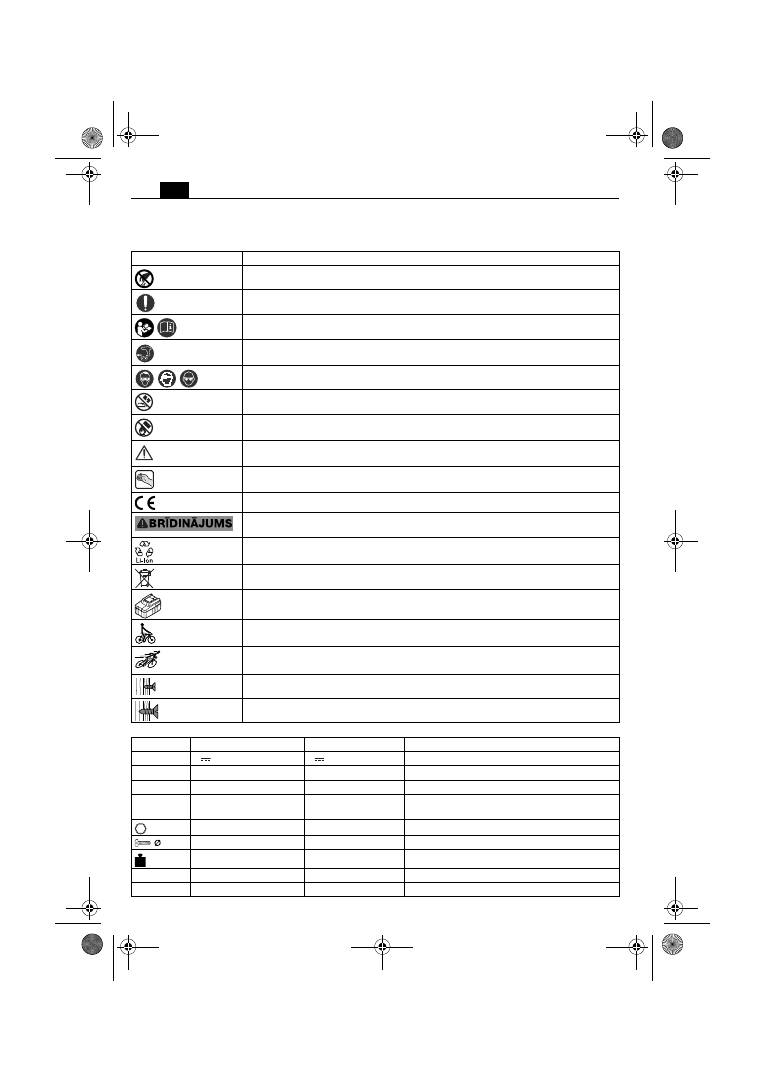
94
lv
lv
Oriģinālā lietošanas pamācība akumulatora skrūvgriezim.
Lietotie simboli, saīsinājumi un jēdzieni.
Simbols, apzīmējums
Izskaidrojums
Nepieskarieties elektroinstrumenta rotējošajām daļām.
Ievērojiet blakusesošajā tekstā vai grafiskajā attēlā sniegtos norādījumus!
Noteikti izlasiet izstrādājumam pievienotos dokumentus, tai skaitā lietošanas pamācību un
vispārējos drošības noteikumus.
Pirms šīs darba operācijas izņemiet akumulatoru no elektroinstrumenta. Pretējā gadījumā
elektroinstruments var pēkšņi sākt darboties, radot savainojumus.
Darba laikā izmantojiet ierīces acu aizsardzībai.
Nemēģiniet uzlādēt bojātus akumulatorus.
Neievietojiet akumulatoru ugunī. Sargājiet akumulatoru no karstuma, piemēram, no
ilgstošas atrašanās saules staros.
Ievērojiet blakusesošajā tekstā sniegtos norādījumus!
Noturvirsma
Šis apzīmējums norāda uz elektroinstrumenta atbilstību Eiropas Kopienas direktīvām.
Šis norādījums ir saistīts ar iespējamu bīstamu situāciju, kas var izraisīt smagu savainojumu
vai pat nāvi.
Reciklēšanas zīme: šādi tiek apzīmēti atkārtoti pārstrādājamie materiāli.
Nolietotie elektroinstrumenti, kā arī citi elektrotehniskie un elektriskie izstrādājumi
jāsavāc atsevišķi un jānogādā otrreizējai pārstrādei apkārtējai videi nekaitīgā veidā.
Akumulatora tips
Neliels griešanās ātrums
Liels griešanās ātrums
Griezes momenta samazināšana
Griezes momenta palielināšana
Apzīmējums
Starptautiskā mērvienība Nacionālā mērvienība
Izskaidrojums
U
V
V
Elektriskais līdzspriegums
n
0
/min, min
-1
, rpm, r/min
/min
Griešanās ātrums brīvgaitā
n
1
/min, min
-1
, rpm, r/min
/min
Griešanās ātrums pie slodzes
M...
Nm
Nm
Griezes moments (cietam/mīkstam skrūvēšanas
režīmam)
inch
colla
Darbinstrumenta turētājs: sešstūra ligzda
mm
mm
Skrūvju diametrs
kg
kg
Svars atbilstoši EPTA-Procedure 01/2003
L
pA
dB
dB
Trokšņa spiediena līmenis
L
wA
dB
dB
Trokšņa jaudas līmenis
OBJ_BUCH-0000000072-001.book Page 94 Monday, June 18, 2012 8:40 AM
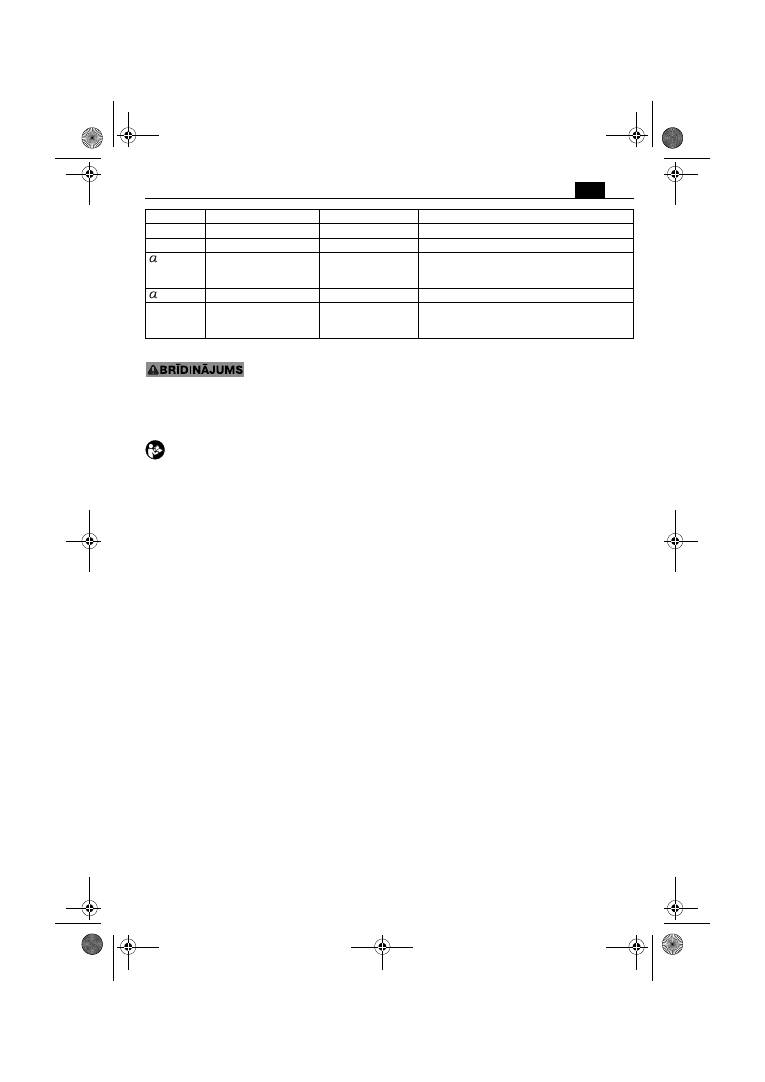
95
lv
Jūsu drošībai.
Uzmanīgi izlasiet visus drošības
noteikumus un norādījumus.
Drošības noteikumu un norādījumu neievērošana var
radīt priekšnoteikumus elektriskajam triecienam, izraisīt
aizdegšanos un/vai būt par cēloni smagam savainojumam.
Uzglabājiet drošības noteikumus un norādījumus
turpmākai izmantošanai.
Nelietojiet šo elektroinstrumentu, pirms uzmanīgi
un ar pilnīgu izpratni nav izlasīta šī lietošanas
pamācība, kā arī tai pievienotie „Vispārējie drošības
noteikumi“ (izdevuma numurs 3 41 30 054 06 1).
Uzglabājiet minētos pavaddokumentus turpmākai
izmantošanai un elektroinstrumenta tālāknodošanas vai
pārdošanas gadījumā nododiet tos jaunajam īpašniekam.
Ievērojiet arī spēkā esošos nacionālos darba aizsardzības
likumdošanas aktus.
Elektroinstrumenta pielietojums:
ar roku vadāms skrūvgriezis, kas paredzēts skrūvju
ieskrūvēšanai un izskrūvēšanai no nelabvēlīgiem laika
apstākļiem pasargātās vietās, izmantojot
darbinstrumentus, kuru lietošanu atļāvusi firma FEIN;
instruments ir īpaši piemērots lietošanai sausbūvēs
skrūvju ātrai ieskrūvēšanai.
Īpašie drošības noteikumi.
Veicot darbu, kura laikā ieskrūvējamā skrūve var skart
slēptus elektriskos vadus, turiet instrumentu tikai aiz
izolētajām virsmām.
Darbinstrumentam skarot
spriegumnesošus vadus, spriegums var nonākt arī uz
elektroinstrumenta metāla daļām un kļūt par cēloni
elektriskajam triecienam.
Ievērojiet piesardzību, strādājot vietās, kuru tuvumā var
būt slēpti elektriskie vadi, kā arī gāzes vai ūdens
cauruļvadi.
Pirms darba pārbaudiet šādas vietas,
izmantojot, piemēram metālmeklētāju.
Nostipriniet apstrādājamo priekšmetu.
Spīļierīcē
iestiprināts priekšmets ir apstrādājams daudz drošāk,
nekā tad, ja tas tiek turēts ar roku.
Stingri turiet elektroinstrumentu.
Darba gaitā uz
strādājošās personas rokām var īslaicīgi iedarboties
ievērojams griezes moments.
Neapstrādājiet materiālus, kas satur azbestu.
Tiek
uzskatīts, ka azbests izraisa vēzi.
Nav atļauts pie elektroinstrumenta pieskrūvēt vai
piekniedēt marķējuma plāksnītes un apzīmējumus.
Bojātā izolācija nenodrošina pietiekošu aizsardzību pret
elektrisko triecienu. Lietojiet uzlīmes.
Neizmantojiet piederumus, kas nav īpaši izstrādāti šim
elektroinstrumentam vai ieteikti lietošanai kopā ar to.
Piederuma drošu lietošanu vēl nenosaka apstāklis, ka to
var iestiprināt elektroinstrumentā.
Akumulatoru (bloku) lietošana un pareiza
apiešanās ar tiem
Lai nepieļautu aizdegšanos vai sprādzienu un novērstu
ādas apdegumus vai citus savainojumus, rīkojoties ar
akumulatoriem, ievērojiet šādus noteikumus:
Akumulatorus nedrīkst izjaukt, atvērt vai sadalīt.
Nepakļaujiet akumulatorus mehāniskiem triecieniem.
Bojājuma gadījumā vai nepareizas apiešanās dēļ no
akumulatora var izplūst veselībai kaitīgi tvaiki vai kodīgs
šķidrums. Tvaiki var izsaukt elpošanas ceļu kairinājumu.
Izplūdušais šķidrais akumulatora elektrolīts var izraisīt
ādas kairinājumu vai pat apdegumus.
Ja no bojāta akumulatora izplūdušais šķidrais elektrolīts
ir saslapinājis tuvumā esošus priekšmetus, pārbaudiet
un notīriet elektrolīta skartās daļas vai, ja nepieciešams,
nomainiet tās.
Neturiet akumulatoru karstumā, neievietojiet to ugunī.
Neturiet akumulatoru tiešā saules gaismā.
Uzsākot akumulatora lietošanu, izņemiet to no oriģinālā
iesaiņojuma.
Pirms elektroinstrumenta apkalpošanas izņemiet no tā
akumulatoru.
Ja elektroinstruments patvaļīgi sāk
darboties, tas var radīt savainojumus.
Izņemiet akumulatoru no elektroinstrumenta tikai laikā,
kad tas ir izslēgts.
Neļaujiet bērniem rīkoties ar akumulatoru.
Uzturiet akumulatoru tīru un sargājiet no mitruma un
ūdens.
Ja akumulatora vai elektroinstrumenta kontakti ir
kļuvuši netīri, notīriet tos ar sausu, tīru audumu.
Izmantojiet tikai nebojātus oriģinālos firmas FEIN
akumulatorus, kas ir piemēroti Jūsu
elektroinstrumentam.
Lietojot un uzlādējot
nepiemērotus, bojātus vai savu laiku nokalpojušus
akumulatorus, to pakaļdarinājumus un citu zīmolu
akumulatorus, tie var aizdegties vai sprāgt.
Ievērojiet drošības noteikumus, kas sniegtas uzlādes
ierīces lietošanas pamācībā.
Vibrācijas iedarbība uz rokām un delnām
Šajā pamācībā norādītais vibrācijas līmenis ir izmērīts
atbilstoši standartā EN 60745 noteiktajai procedūrai un
var tikt lietots elektroinstrumentu salīdzināšanai. To var
izmantot arī vibrācijas radītās papildu slodzes iepriekšējai
novērtēšanai.
L
pCpeak
dB
dB
Trokšņa spiediena pīķa vērtību līmenis
K...
Izkliede
m/s
2
m/s
2
Vibrācijas paātrinājuma vērtība atbilstoši
standartam EN 60745 (vektoru summa trim
virzieniem)
h
m/s
2
m/s
2
Svārstību paātrinājuma vērtība (veicot skrūvēšanu)
m, s, kg, A, mm, V,
W, Hz, N, °C, dB,
min, m/s
2
m, s, kg, A, mm, V,
W, Hz, N, °C, dB,
min., m/s
2
Pamata un atvasinātās mērvienības atbilst
starptautiskajai mērvienību sistēmai
SI
.
Apzīmējums
Starptautiskā mērvienība Nacionālā mērvienība
Izskaidrojums
OBJ_BUCH-0000000072-001.book Page 95 Monday, June 18, 2012 8:40 AM
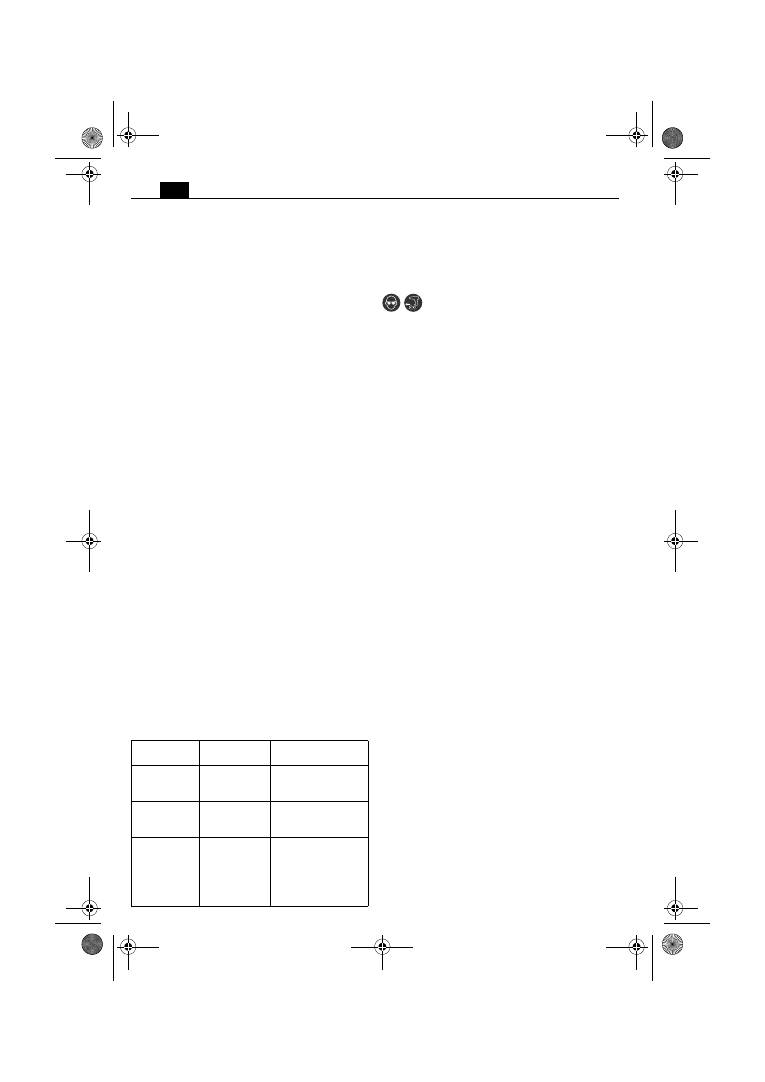
96
lv
Norādītais vibrācijas līmenis ir attiecināms uz elektro-
instrumenta galvenajiem pielietojuma veidiem. Ja elektro-
instruments tiek lietots netipiskiem mērķiem, kopā ar
netipiskiem darbinstrumentiem vai nav vajadzīgajā veidā
apkalpots, tā vibrācijas līmenis var atšķirties no šeit
norādītajām vērtībām. Tas var ievērojami palielināt vibrācijas
radīto papildu slodzi zināmam darba laika posmam.
Lai precīzi izvērtētu vibrācijas radīto papildu slodzi
zināmam darba laika posmam, jāņem vērā arī laiks, kad
elektroinstruments ir izslēgts vai arī darbojas, taču faktiski
netiek izmantots paredzētā darba veikšanai. Tas var
ievērojami samazināt vibrācijas radīto papildu slodzi
zināmam darba laika posmam.
Veiciet papildu pasākumus, lai pasargātu strādājošo
personu no vibrācijas kaitīgās iedarbības, piemēram,
šādus: savlaicīgi veiciet elektroinstrumenta un
darbinstrumentu apkalpošanu, novērsiet roku atdzišanu
un pareizi plānojiet darbu.
Norādījumi lietošanai.
Pārvietojiet griešanās virziena pārslēdzēju tikai laikā, kad
nedarbojas dzinējs.
Lai novērstu instrumenta nejaušu ieslēgšanos, piemēram,
transportēšanas laikā, pārvietojiet griešanās virziena
pārslēdzēju vidējā stāvoklī.
Ja elektroinstruments ir pārkarsis, tas darbojas īsu,
spēcīgu impulsu veidā. Šādā gadījumā atdzesējiet
elektroinstrumentu, darbinot to brīvgaitā.
ASCT14/ASCT14M/ASCT18/ASCT18M:
skrūvēšana jāveic
ar uz instrumenta nostiprinātu dziļuma ierobežotāju.
ASCT14M/ASCT14UM/ASCT18M/ASCT18UM:
skrūvju
magazīnu drīkst izmantot tikai tad, ja ir izvēlēts griešanās
virziens „Pa labi“.
Griezes momenta iestatīšana (ASCT14U/ASCT14UM/
ASCT18U/ASCT18UM) (skatīt lappusi 7).
Ražotājrūpnīcā tiek iestatīts elektroinstrumenta griezes
moments, kas piemērots nelielu un vidēja izmēra skrūvju
ieskrūvēšanai.
Skrūvju pievilkšanas moments ir atkarīgs arī no spēka, ar
kādu elektroinstruments tiek piespiests skrūvei.
Apiešanās ar akumulatoru
Lietojiet un uzlādējiet akumulatoru tikai tad, ja tā
temperatūra atrodas darba temperatūras diapazona
robežās, kas ir 0 °C – 45 °C (32 °F – 113 °F). Akumulatora
temperatūrai jātrodas darba temperatūras diapazona
robežās jau uzlādes procesa sākumā.
Akumulatora uzlādes pakāpes patiesā procentuālā vērtība
tiek parādīta tikai pie izslēgta elektroinstrumenta dzinēja.
Akumulatora dziļās uzlādes gadījumā elektroniskais
mezgls automātiski izslēdz elektroinstrumenta dzinēju.
Uzturēšana darba kārtībā un klientu
apkalpošanas dienests.
Ekstremālos darba apstākļos, izmantojot
elektroinstrumentu metāla apstrādei, tā
korpusa iekšpusē var uzkrāties strāvu vadoši
putekļi. Pietiekoši bieži caur ventilācijas atverēm izpūtiet
elektroinstrumenta iekšpusi ar sausu, saspiestu gaisu, kas
nesatur eļļu.
Šā elektroinstrumenta aktuālais rezerves daļu saraksts ir
atrodams interneta vietnē www.fein.com.
Vajadzības gadījumā lietotājs var saviem spēkiem
nomainīt šādas daļas:
iestiprināmo darbinstrumentu,
dziļuma ierobežotāju, akumulatoru, āķi, magazīnu.
Garantija.
Garantija izstrādājumam tiek noteikta atbilstoši spēkā
esošajai tās valsts likumdošanai, kurā izstrādājums ir ticis
laists pārdošanā. Bez tam firma FEIN nosaka
izstrādājumam garantiju atbilstoši FEIN garantijas
deklarācijai.
Elektroinstrumenta piegādes komplektā var netikt
iekļautas visas šajā lietošanas pamācībā aprakstītās un
attēlotās daļas.
Atbilstības deklarācija.
Firma FEIN ar pilnu atbildību deklarē, ka šis izstrādājums
atbilst šīs lietošanas pamācības pēdējā lappusē minētajām
spēkā esošajām direktīvām.
Tehniskā dokumentācija no: C. & E. FEIN GmbH,
C-DB_IA, D-73529 Schwäbisch Gmünd
Vides aizsardzība, atbrīvošanās no
nolietotajiem izstrādājumiem.
Nolietotie elektroinstrumenti, to iesaiņojums un
piederumi jānogādā otrreizējai pārstrādei apkārtējai videi
nekaitīgā veidā.
Akumulatori jānogādā otrreizējai pārstrādei tikai izlādētā
stāvoklī.
Ja akumulatori nav pilnīgi izlādēti, tie jāpasargā no
iespējama īsslēguma, pārlīmējot pāri kontaktiem līmlenti.
Mirdzdiodes
indikators
Nozīme
Darbība
1 – 4 zaļās
mirdzdiodes
Norāda
procentuālo
uzlādes pakāpi
Cēlonis
Sarkanā
mirdzdiode
deg pastāvīgi
Akumulators ir
gandrīz
izlādēts
Uzlādējiet
akumulatoru
Sarkanā
mirdzdiode
mirgo
Akumulators
nav gatavs
darbam
Nogaidiet, līdz
akumulatora
temperatūra atgriežas
darba temperatūras
diapazona robežās,
un tad to uzlādējiet
OBJ_BUCH-0000000072-001.book Page 96 Monday, June 18, 2012 8:40 AM
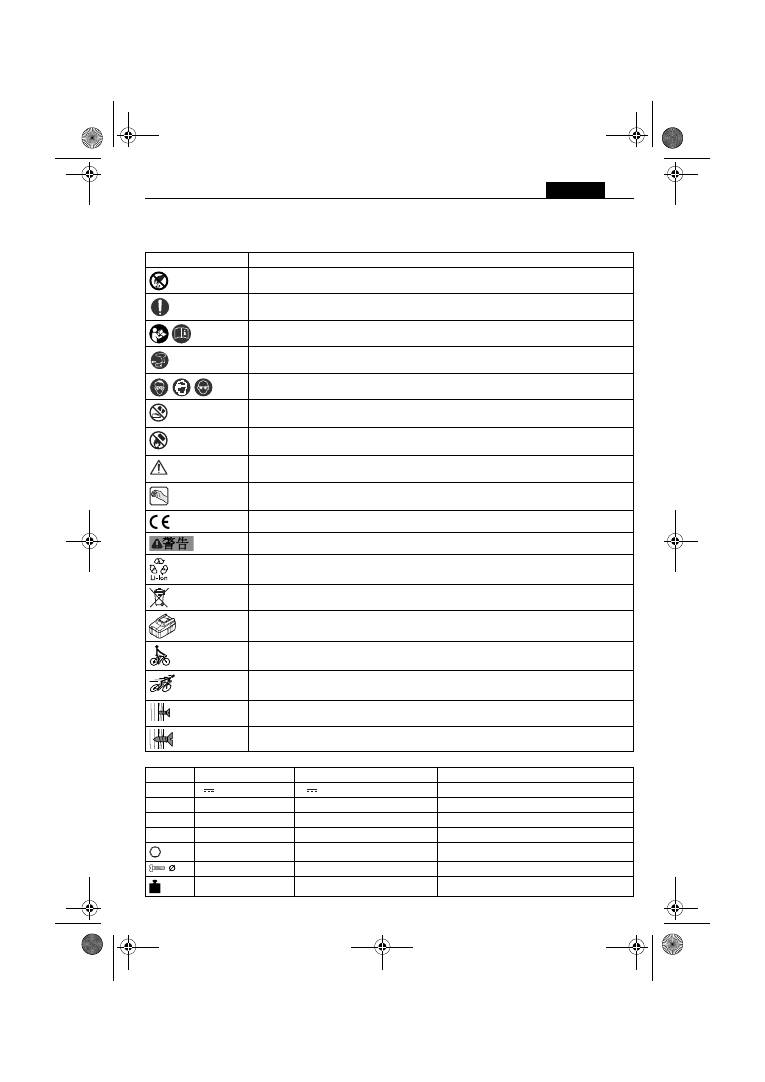
97
zh (CM)
zh (CM)
充电式电钻 / 螺丝起子使用说明书。
使用的符号,缩写和代名词。
符号,图例
解说
不可以触摸电动工具的转动部件。
请遵循旁边文字或插图的指示!
务必阅读附带的文件,例如使用说明书以及一般性的安全提示。
进行这个步骤前先从电动工具上取出蓄电池。否则可能因为不小心启动电动工具而造成伤害。
工作时必须戴上护目镜。
不可以为损坏的蓄电池充电。
不可以把蓄电池抛入火中。 蓄电池不可以靠近高温,例如 避免长期日照。
请留意注文上的提示!
握持部位
证明此电动工具符合欧洲共同体的规定标准。
本提示指出潜伏的危险状况。它们可能导致严重的伤害甚至造成死亡。
回收图案:标明可以再利用的物料
分开收集损坏的电动工具,电子和电动产品,並且以符合环保要求的方式回收可利用的资源。
蓄电池类型
小转速
大转速
缩小扭力
加大扭力
符号
国际通用单位
本国使用单位
解说
U
V
伏
电压
n
0
/min, min
-1
, rpm, r/min
/ 分钟
无负载转速
n
1
/min, min
-1
, rpm, r/min
/ 分钟
负载转速
M...
Nm
牛顿米
扭力 ( 硬 / 软连接 )
inch
英寸
内六角工具接头
mm
毫米
螺丝直径
kg
公斤
重量符合
EPTA-Procedure 01/2003
的规定
OBJ_BUCH-0000000072-001.book Page 97 Monday, June 18, 2012 8:40 AM

98
zh (CM)
有关您的安全。
阅读所有的安全规章和指示。如未遵循安全规
章和指示,可能遭受电击,产生火灾和 / 或造
成严重伤害。
妥善保存所有的安全规章和指示以便日后查阅。
详细阅读並彻底了解本使用说明书和附带的
" 一般性安全规章 " (书目码
3 41 30 054 06 1
)后,
才可以使用本电动工具。妥善保存上述文件以方便日后查
阅。赠送或贩卖本电动工具时,务必把这些文件转交给受
赠者或买主。
同时也要注意各国有关的工作安全规定。
电动工具的用途:
本手提式电钻 / 起子是用来收紧及拆除螺丝 , 特别适合用於
清水墙 ,
FEIN
建议在遮蔽风雨的工作场所 , 配上合适的配
件一起使用。
特殊的安全指示。
工作时如果电动起子机可能割断隐藏的电线, 一定 要握住
绝缘手柄操作机器。 电动起子机如果接触了带电的线路,
电动工具上的金属部件会导电,可能造成操作者触电。
注意隐藏的电线,瓦斯管和水管。 工作前必须先检查工作
范围,例如使用金属探测仪。
固定好工件。 使用固定装置比用手更能够夹紧工件。
好好地握牢电动工具。 可能会出现短暂的高反应力矩。
不可以加工含石棉的物料。 石棉是致癌物质。
切勿使用螺丝或钉子在电动工具上固定铭牌和标签。 如果
破坏了机器的绝缘功能便无法防止电击。请使用自粘铭牌
或标签。
只能使用电动工具制造商特别设计和许可的附件。 即使能
够将其它的工具安装到本电动工具上,並不代表能够确保
操作安全。
使用和处理蓄电池 (蓄电池块)
为了避免使用蓄电池时可能发生的意外状况,例如起火,
火灾,爆炸,皮肤灼伤以及其它的伤害等,请注意以下的
指示:
不可以拆解,打开或缩小蓄电池。不可以让蓄电池遭受撞
击。 电池如果损坏了或者未按照规定使用蓄电池, 可能产
生蒸汽并 且渗出液体。这种蒸汽可能刺激呼吸道,蓄电池
渗出的液体会引起皮肤痒或造成皮肤灼伤。
如果从损坏的电池所渗出的液体沾湿了邻近的部件, 必须
检查被沾污的部件,清洁这些部件,必要的话得更换它
们。
不可以让蓄电池遭受高温或火焰的侵害。 不可以在直接的
日照下为蓄电池充电。
使用蓄电池时,才将它从原始包装中取出。
为电动工具做任何维修工作之前,必须从机器中取出蓄电
池。 如果电动工具被意外地启动了,可能造成伤害。
先关闭电动工具然後再取出蓄电池。
蓄电池必须远离儿童。
蓄电池必须保持清洁,并保护它免受湿气或水侵入。 使用
干燥清洁的布抹除蓄电池接头和电动工具接头上的污垢。
电动工具必须配上
FEIN
原厂蓄电池一起使用。 使用以下的
蓄电池和替以下的蓄电池充电有火灾和 / 或爆炸的危险:
不苻的电池 , 已经损坏的电池,经过修理或改装过的电池,
仿冒品和其它品牌的电池。
遵循充电器的使用说明书中的安全规章。
手掌 - 手臂 - 震动
本说明书中引用的震动水平,是采用
EN 60745
中规定的测
量方式所测得。这个震动水平值可以作为电动工具之间的
比较标准。您也可以拿它来推测机器目前的震动受荷状
况。
此震动水平只适用在以电动工具进行规定的用途时。如果
未按照规定使用电动工具,在机器上安装了不合适的工
具,或者未确实执行机器的维修工作,实际的震动水平会
异于提供的震动水平。因此在操作过程结束后,机器的震
动受荷状况会明显提高。
为了准确地评估机器的震动受荷状况,还必须考虑以下的
时间因素:例如关机的时间或机器空转待命的时间等。如
果把整个工作过程中累加的关机或待命时间列入考虑,则
可以明显地降低机器的震动受荷状况。
为了保护操作者免受机器震动危害,必须另外采行防护措
施,例如:做好电动工具和安装工具的维修工作,手掌要
保持温暖,安排好工作的流程。
L
pA
dB
分贝
声压水平
L
wA
dB
分贝
声功率水平
L
pCpeak
dB
分贝
最高声压水平
K...
不确定性系数
m/s
2
米 / 秒
2
振荡发射值根据
EN 60745
( 三向矢量和 )
h
m/s
2
米 / 秒
2
振荡发射值 ( 拧转 )
m, s, kg, A, mm, V,
W, Hz, N, °C, dB,
min, m/s
2
米 , 秒 , 公斤 , 安培 , 毫米 , 伏特 ,
瓦 , 赫兹 , 牛顿 , 摄氏 , 分贝 ,
分 , 米 / 秒
2
国际性单位系统
SI
中的标准单位和引用单位。
符号
国际通用单位
本国使用单位
解说
OBJ_BUCH-0000000072-001.book Page 98 Monday, June 18, 2012 8:40 AM
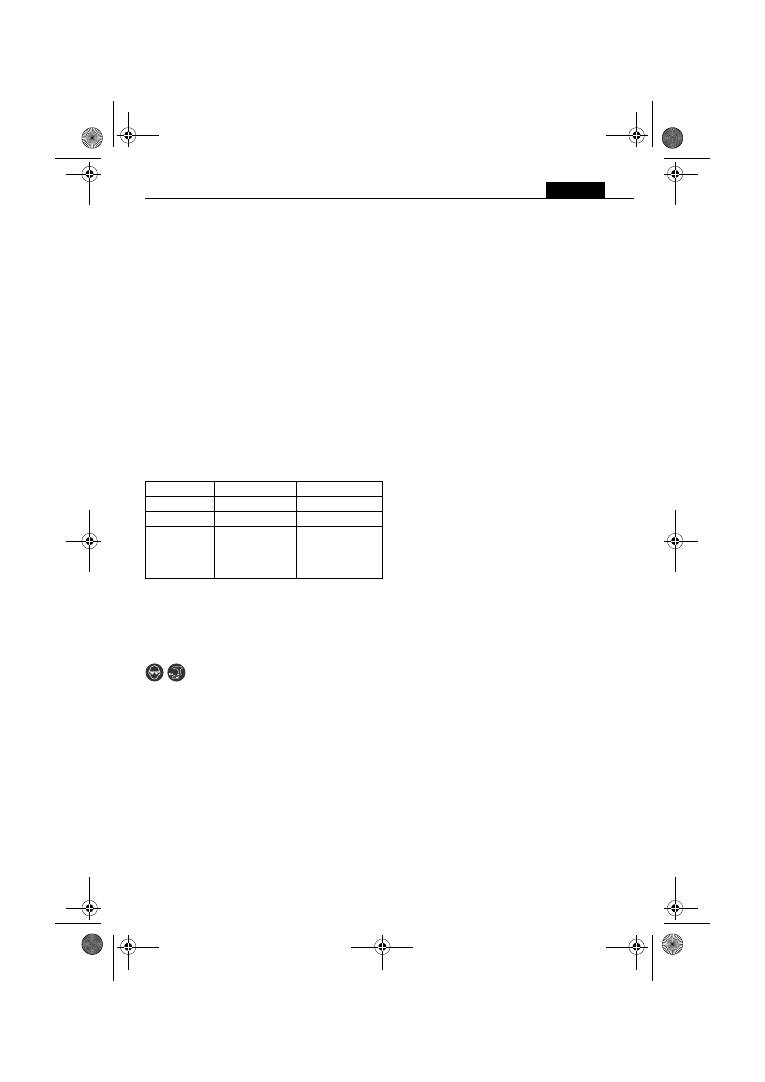
99
zh (CM)
操作指示。
等待马达完全静止後才可以 使用转向变换开关。
把转向变换开关调整在中央的位置,以避免无意间开动机
器,例如搬运机器时。
超温时电动工具会以短促的低功率脉冲运作。 此时要让电
动工具空转以方便冷却。
ASCT14/ASCT14M/ASCT18/ASCT18M:
拧转螺丝时要在机器上
安装深度挡块。
ASCT14M/ASCT14UM/ASCT18M/ASCT18UM:
螺丝进给器只能
在转向设定为 " 右转 " 时使用。
设定扭力
(ASCT14U/ASCT14UM/ASCT18U/ASCT18UM)
( 参考页数
7
).
机器出厂时设定的范围相当於小螺丝到中型的大螺丝。
拧紧扭力也会受电动工具施加在螺丝上的力量影响。
正确地使用蓄电池
当蓄电池的温度位于操作温度范围
0 °C – 45 °C (32 °F –
113 °F)
内时,才可以使用蓄电池以及替蓄电池充电。在充
电初期,蓄电池的温度必须位于操作温度范围内。
蓄电池的充电进度是以百分比的方式显示,当电动工具的
马达停止运转时才能够显示充电实况。
在蓄电池即将进入过度放电的状况时,机器的电子装备会
自动关闭马达。
维修和顾客服务。
在某些特殊的工作状况下, 例如加工金属物料
时 , 可能在机器内部堆积大量的金属废尘。 因此
必须经常使用干燥无油的压缩空气, 从机器的通气孔 吹除
电动工具内部的废尘。
从以下的网址 www.fein.com 可以找到本电动工具目前的
备件清单。
以下零件您可以根据需要自行更换 : 安装件,深度尺,蓄
电池,支架挂钩,螺丝匣
保修。
有关本产品的保修条件,请参考购买国的相关法律规定。
此外
FEIN
还提供制造厂商的保修服务。有关保修的细节,
请向您的专业经销商,
FEIN
在贵国的代理或您的
FEIN
顾
客服务中心询问。
在本使用说明书上提到的和标示的附件,並非全部包含在
电动工具的供货范围中。
合格说明。
FEIN
公司单独保证,本产品符合说明书末页上所列出的各
有关规定的标准。
技术性文件存放在 :
C. & E. FEIN GmbH, C-DB_IA,
D-73529 Schwäbisch Gmünd
环境保护和废物处理。
必须以符合环保要求的方式处理包装材料和废弃的电动工
具与附件。
放空蓄电池的电并根据规定处理待废弃的蓄电池。
如果蓄电池未完全放空电量, 为了安全的理由可以使用胶
带贴住蓄电池的触点 ,以防止发生短路。
LED
指示灯
含意
措施
1 – 4
绿色
LED
电量现况的百分比 操作
红色持续亮着
蓄电池几乎没电了 替蓄电池充电
红灯闪烁
无法使用蓄电池
先让蓄电池的温度
恢复到蓄电池的操
作温度范围内,然
后再替蓄电池充电
OBJ_BUCH-0000000072-001.book Page 99 Monday, June 18, 2012 8:40 AM
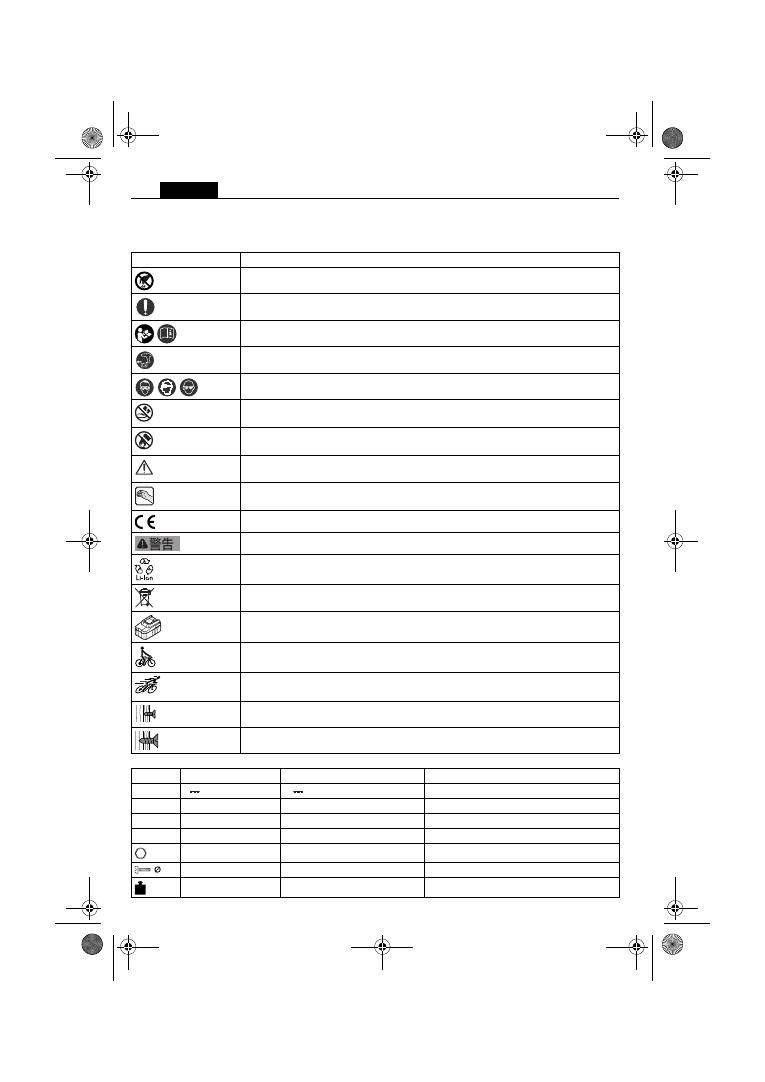
100
zh (CK)
zh (CK)
充電式電鑽 / 螺絲起子使用說明書。
使用的符號,縮寫和代名詞。
符號 , 圖例
解說
不可以觸摸電動工具的轉動部件。
請遵循旁邊文字或插圖的指示!
必須閱讀附帶的文件,例如使用說明書以及一般性的安全提示。
進行這個步驟前先從電動工具上取出蓄電池。否則可能因為不小心啟動電動工具而造成傷
害。
工作時必須戴上護目鏡。
不可以為損壞的蓄電池充電。
不可以把蓄電池拋入火中。蓄電池不可以靠近高溫,例如 避免長期日照。
請遵循注文上的指示!
握持部位
證明此電動工具符合歐洲共同體的規定標準。
本標示提示潛伏的危險狀況。它們可能導致嚴重的傷害甚至造成死亡。
回收圖案:標明可以再利用的物料
分類收集已損壞的電動工具,電子和電動產品,並且以符合環保要求的方式回收 , 可使有用
物料循環再用。
蓄電池類型
慢速
快速
縮小扭力
加大扭力
符號
國際通用單位
本國使用單位
解說
U
V
伏
電壓
n
0
/min, min
-1
, rpm, r/min
/ 分鐘
空載轉速
n
1
/min, min
-1
, rpm, r/min
/ 分鐘
負載轉速
M...
Nm
牛頓米
扭力 ( 硬 / 軟連接 )
inch
英吋
內六角工具接頭
mm
毫米
螺絲直徑
kg
公斤
重量符合
EPTA-Procedure 01/2003
的規定
OBJ_BUCH-0000000072-001.book Page 100 Monday, June 18, 2012 8:40 AM

101
zh (CK)
有關您的安全。
閱讀所有的安全規章和指示。如未遵循安全
規章和指示,可能遭受電擊,產生火災和 /
或造成嚴重傷害。
妥善保存所有的安全規章和指示以便日后查閱。
詳細閱讀並徹底了解本使用說明書和附帶的
" 一般性安全規章 " (文件編號
3 41 30 054 06 1
)
後,才可以使用本電動工具。妥善保存上述文件以方便日
后查閱。贈送或售賣本電動工具時,務必把這些文件轉交
給受贈者或用家。
同時也要注意各國有關的工作安全規定。
電動工具的用途 :
本手提式電鑽 / 起子是用來收緊及拆除螺絲 , 特別適合用於
清水牆 ,
FEIN
建議在遮蔽風雨的工作場所 , 配上合適的配
件一起使用。
特別安全說明。
工作時如果電動起子機可能割斷隱藏的電線, 一定要握住
絕緣手柄操作機器。 電動起子機如果接觸了帶電的線路,
電動工具上的金屬部件會導電,可能 成操作者觸電。
注意隱藏的電線,瓦斯管和水管。 工作前必須先檢查工作
範圍,例如使用金屬探測儀。
固定好工件。 使用固定夾具或鉗台比用手持更能夠夾緊工
件。
穩固地握牢電動工具。 可能會出現短速的高反應力矩。
不可以加工含石棉的物料。 石棉是致癌物質。
切勿使用螺絲或鉚釘在電動工具上固定名牌和標籤。 如果
破壞了機器的絕緣功能便無法防止電擊。請使用自粘名牌
或標籤。
只能使用電動工具制造商特定設計和認可的附件。 即使能
夠將其它的工具安裝到本電動工具上, 並不代表能夠確保
操作安全。
使用和處理蓄電池 (蓄電池塊)
為了避免使用蓄電池時可能發生的意外狀況,例如起火,
火災,爆炸,皮膚灼傷以及其它的傷害等,請注意以下的
指示:
不可以拆解,打開或縮小蓄電池。不可以讓蓄電池遭受撞
擊。 電池如果損壞了或者未按照規定使用蓄電池, 可能產
生蒸汽並 且滲出液體。 這種蒸汽可能刺激呼吸道,蓄電池
滲出的液體會引起皮膚癢或造成皮膚灼傷。
如果從損壞的電池所滲出的液體沾濕了鄰近的部件, 必須
檢查被沾污的部件,清潔這些部件,必要的話得更換它
們。
不可以讓蓄電池遭受高溫或火焰的侵害。 不可以在直接的
日照下為蓄電池充電。
使用蓄電池時,才將它從原始包裝中取出。
為電動工具做任何維修工作之前,必須從機器中取出蓄電
池。 如果電動工具被意外地啟動了,可能造成傷害。
先關閉電動工具然後再取出蓄電池。
蓄電池必須遠離兒童。
蓄電池必須保持清潔,並保護它免受濕氣或水侵入。 使用
干燥清潔的布抹除蓄電池接頭和電動工具接頭上的污垢。
電動工具必須配上
FEIN
原廠蓄電池一起使用。 使用以下的
蓄電池和替以下的蓄電池充電有火災和 / 或爆炸的危險:
不苻的電池 , 已經損壞的電池,經過修理或改裝過的電池,
仿冒品和其它品牌的電池。
遵循充電器的使用說明書中的安全規章。
手掌 - 手臂 - 震動
本說明書中引用的震動水平,是采用
EN 60745
中規定的測
量方式所測得。這個震動水平值可以作為電動工具之間的
比較標準。您也可以拿它來推測機器目前的震動受荷狀
況。
此震動水平只適用於電動工具規定的用途。如果未按照規
定使用電動工具,在機器上安裝了不合適的工具,或者未
確實執行機器的維修工作,實際的震動水平會異于提供的
震動水平。因此在操作過程結束后,機器的震動受荷狀況
會明顯提高。
為了準確地評估機器的震動受荷狀況,還必須考慮以下的
時間因素 ﹕ 例如關機的時間或機器空轉待命的時間等。如
果把整個工作過程中累加的關機或待命時間列入考慮,則
可以明顯地降低機器的震動受荷狀況。
為了保護操作者免受機器震動危害,必須另外采行防護措
施,例如 ﹕ 做好電動工具和安裝工具的維修工作,手掌要
保持溫暖,安排好工作的流程。
L
pA
dB
分貝
聲壓水平
L
wA
dB
分貝
聲壓功率水平
L
pCpeak
dB
分貝
最高聲壓水平
K...
不確定系數
m/s
2
米 / 秒
2
振蕩發射值根據
EN 60745
( 三向矢量和 )
h
m/s
2
米 / 秒
2
振蕩發射值 ( 擰轉 )
m, s, kg, A, mm, V,
W, Hz, N, °C, dB,
min, m/s
2
米 , 秒 , 公斤 , 安培 , 毫米 , 伏特 ,
瓦 , 赫茲 , 牛頓 , 攝氏 , 分貝 ,
分 , 米 / 秒
2
國際性單位系統
SI
中的標準單位和引用單位。
符號
國際通用單位
本國使用單位
解說
OBJ_BUCH-0000000072-001.book Page 101 Monday, June 18, 2012 8:40 AM
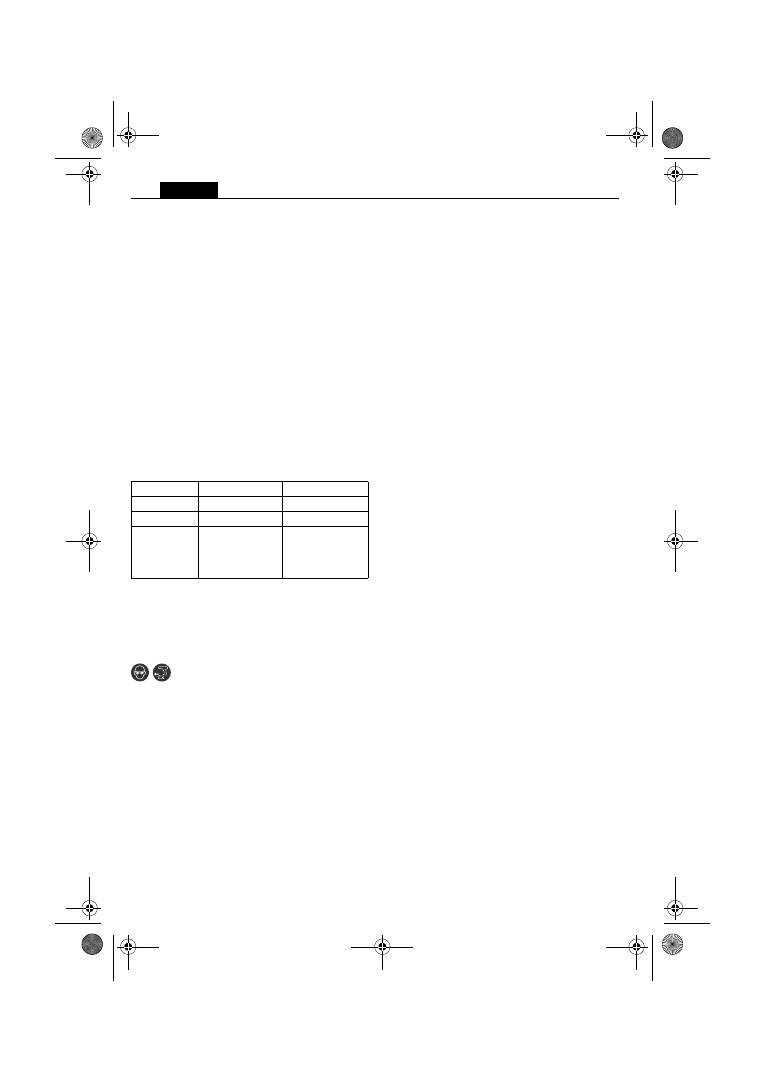
102
zh (CK)
操作指示。
等待馬達完全靜止後才可以 使用轉向變換開關。
把轉向變換開關調整在中央的位置,以避免無意間開動機
器,例如搬運機器時。
超溫時電動工具會以短促的低功率脈衝運作。 此時要讓電
動工具空轉以方便冷卻。
ASCT14/ASCT14M/ASCT18/ASCT18M:
擰轉螺絲時要在機器上
安裝深度擋塊。
ASCT14M/ASCT14UM/ASCT18M/ASCT18UM:
螺絲進給器只能
在轉向設定為 " 右轉 " 時使用。
設定扭力
(ASCT14U/ASCT14UM/ASCT18U/ASCT18UM)
( 參考頁數
7
).
機器出廠時設定的範圍相當於小螺絲到中型的螺絲。
擰緊扭力也會受電動工具施加在螺絲上的力量影響。
正確地使用蓄電池
當蓄電池的溫度位於操作溫度範圍
0 °C – 45 °C (32 °F –
113 °F)
內時,才可以使用蓄電池以及替蓄電池充電。在充
電初期,蓄電池的溫度必須位於操作溫度範圍內。
蓄電池的充電進度是以百分比的方式顯示,當電動工具的
馬達停止運轉時才能夠顯示充電實況。
在蓄電池即將進入過度放電的狀況時,機器的電子裝備會
自動關閉馬達。
維修和顧客服務。
在某些特殊的工作狀況下, 例如加工金屬物料
時 , 可能在機器內部堆積大量的金屬廢塵。 因此
必須經常使用干燥無油的壓縮空氣, 從機器的通氣孔 吹除
電動工具內部的廢塵。
從以下的網址 www.fein.com 可以找到本電動工具目前的
備件清單。
以下零件您可以根據需要自行更換 : 安装件,深度尺,蓄
电池,支架挂钩,螺丝匣
保修。
有關本產品的保修條件,請參考購買國的相關法律規定。
此外
FEIN
還提供制造廠商的保修服務。有關保修的細節,
請向您的專業經銷商,
FEIN
在貴國的代理或您的
FEIN
顧
客服務中心詢問。
在本使用說明書上提到的和標示的附件,並非全部包含在
電動工具的供貨範圍中。
合格說明。
FEIN 公司單獨保證,本產品符合說明書末頁上所列出的各
有關規定的標準。
技術性文件存放在 :
C. & E. FEIN GmbH, C-DB_IA,
D-73529 Schwäbisch Gmünd
環境保護和廢物處理。
必須以符合環保要求的方式處理包裝材料和廢棄的電動工
具與附件。
放空蓄電池的電並根據規定處理待廢棄的蓄電池。
如果蓄電池未完全放空電量, 為了安全的理由可以使用膠
帶貼住蓄電池的觸點 ,以防止發生短路。
LED 指示燈
含意
措施
1 – 4
綠色
LED
電量現況的百分比 操作
紅色持續亮著 蓄電池幾乎沒電了 替蓄電池充電
紅燈閃爍
無法使用蓄電池
先讓蓄電池的溫度
恢復到蓄電池的操
作溫度範圍內,然
後再替蓄電池充電
OBJ_BUCH-0000000072-001.book Page 102 Monday, June 18, 2012 8:40 AM

103
ko
ko
충전
드릴
/
드라이버
사용
설명서
원본
.
사용
기호
,
약어와
의미
.
기호
,
부호
설명
전동공구의
회전하는
부위를
만지지
마십시오
.
문장이나
그림에
나와있는
지시
사항을
반드시
준수하십시오
!
반드시
첨부되어
있는
사용
설명서와
일반
안전수칙을
읽으십시오
.
이
작업을
하기
전에
배터리를
전동공구에서
빼어
놓으십시오
.
그렇지
않으면
전동공구가
실
수로
작동하게
되어
상해를
입을
수
있습니다
.
작업할
때
보안경을
착용하십시오
.
손상된
배터리는
충전하지
마십시오
.
배터리를
불에
가까이
두지
마십시오
.
배터리를
열에
노출되지
않도록
하고
또한
장시간
강
한
햇볕에
두지
마십시오
.
옆에
나와있는
사항을
준수해야
합니다
!
손잡이
면
전동공구가
EU (
유럽연합
)
해당
지침에
적합하다는
것을
증명합니다
.
이
표시는
중상이나
사망을
유발할
수
있는
위험한
상황이
될
수
있다는
것을
나타냅니다
.
리사이클링
표시
:
재생
가능한
소재임을
나타냅니다
.
폐기용
전동공구와
기타
전기
및
전동
제품은
별도로
수거하여
환경
친화적인
방법으로
재생
할
수
있도록
해야
합니다
.
배터리
타입
저속
고속
토크
하향
토크
상향
부호
국제
단위
국내
단위
설명
U
V
V
전기
직류
전압
n
0
/min, min
-1
, rpm, r/min
/min
무부하
속도
n
1
/min, min
-1
, rpm, r/min
/min
부하
속도
M...
Nm
Nm
토크
(
경질
/
연질
시트의
스크류작업
)
inch
inch
육각비트소켓
툴
홀더
mm
mm
스크류
직경
kg
kg
EPTA-Procedure 01/2003
에
따른
중량
OBJ_BUCH-0000000072-001.book Page 103 Monday, June 18, 2012 8:40 AM
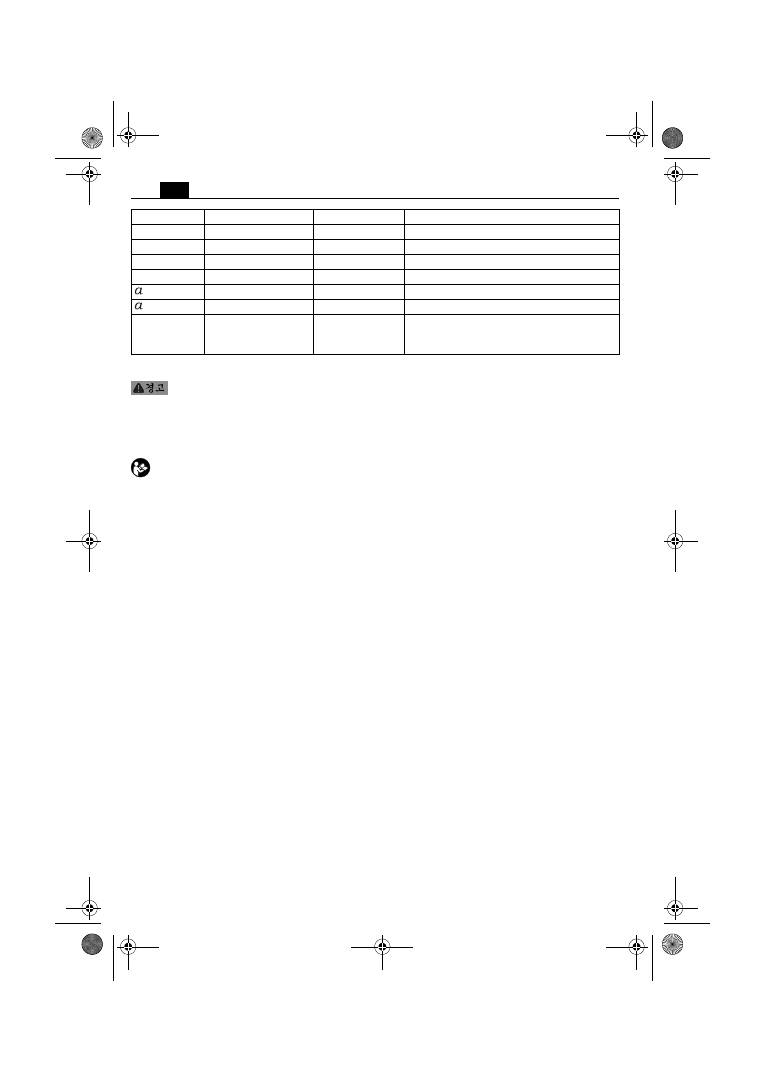
104
ko
안전
수칙
.
모든
안전
수칙과
지시
사항을
상세히
읽고
준수
해야
합니다
.
안전
수칙과
지시
사항을
지키지
않으면
화재
위험이
있으며
감전
혹은
중상을
입을
수
있습
니다
.
추후
참고용으로
모든
안전
수칙과
지시
사항을
잘
보관하
십시오
.
이
전동공구의
사용
설명서와
첨부된
“
일반
안전
수
칙
” (
문서
번호
3 41 30 054 06 1
)
을
자세히
읽고
완
전히
이해한
후에
기기를
사용하십시오
.
나중에
사용할
경
우를
위해
위의
자료를
잘
보관하고
전동공구를
인도하거나
매각할
경우
설명서도
함께
전달하십시오
.
또한
국내의
해당
작업
안전
규정을
준수하십시오
.
전동공구의
사용
분야
:
휴대용
충전
드릴
/
드라이버는
날씨와
관계
없는
환경에서
FEIN
사가
허용하는
비트와
액세서리를
사용하여
특히
건식
벽체
내장
시
스크류를
조이거나
푸는
작업을
하는데
사용
해야
합니다
.
특별
안전
수칙
.
작업할
때
볼트로
보이지
않는
전선에
닿을
위험이
있으면
전동공구의
절연된
손잡이
면을
잡으십시오
.
전류가
흐르
는
전선에
닿게되면
기기의
금속
부위에도
전기가
통해
감
전될
수
있기
때문입니다
.
보이지
않는
부위에
있는
배선
및
배관
여부를
확인하십시
오
.
작업을
시작하기
전에
금속
탐지기
등을
사용하여
작업
분야를
점검하십시오
.
작업물을
잘
고정하십시오
.
고정장치에
장착하여
작업하면
손으로
잡는
것보다
더
안전합니다
.
전동공구를
꽉
잡으십시오
.
갑자기
강한
반동력이
생길
수
있습니다
.
석면이
함유된
소재에
작업하지
마십시오
.
석면은
발암성
으로
간주됩니다
.
레벨이나
표지를
전동공구에
스크류로
고정하거나
리벳으
로
접합하는
것은
금지되어
있습니다
.
절연장치가
파손되
면
감전될
위험이
있습니다
.
접착
레벨을
사용하십시오
.
전동공구
제조사가
특별히
개발하거나
허용하지
않은
액세
서리를
사용하지
마십시오
.
액세서리가
귀하의
전동공구에
맞는다고
해서
안전한
작동을
보장하는
것이
아닙니다
.
배터리
(
배터리
팩
)
의
사용과
취급
배터리를
사용하여
작업할
때
화상
,
화재
,
폭발
,
피부의
상
처
등
기타
상해
위험을
방지하려면
다음
사항을
준수해야
합니다
:
배터리를
분해하거나
절단하지
마십시오
.
배터리에
기계적
인
충격을
가하지
마십시오
.
손상되었거나
규정대로
사용
하지
않은
경우
배터리에서
유해한
증기나
유체가
발생할
수
있습니다
.
증기로
인해
호흡기가
자극될
수
있습니다
.
배터리에서
나오는
유체로
인해
피부에
자극
현상이
생기거
나
화상을
입을
수
있습니다
.
손상된
배터리에서
나오는
유체가
인접해
있는
물체에
닿은
경우
,
해당되는
부위에
이상이
없는지
확인하고
깨끗이
닦
아
주십시오
.
경우에
따라
이를
교환해
주어야
합니다
.
배터리를
고열이나
불에
가까이
두지
마십시오
.
배터리를
직사광선이
드는
곳에서
보관하지
마십시오
.
배터리를
사용하기
바로
전에
정품
포장에서
꺼내십시오
.
전동공구에
작업하기
전에
배터리를
전동공구에서
분리하
십시오
.
실수로
전동공구가
작동하게
되면
상해를
입을
수
있습니다
.
배터리는
전동공구의
스위치가
꺼진
상태에서만
빼십시오
.
배터리는
어린이들의
손이
닿지
않는
곳에
보관하십시오
.
배터리를
깨끗이
유지하고
수분이나
물에
가까이
두지
마십
시오
.
배터리와
전동공구의
오염된
연결
부위를
마른
깨끗
한
천으로
닦아
주십시오
.
귀하의
전동공구용으로
나온
하자가
없는
파인
(FEIN)
정품
배터리만을
사용하십시오
.
적합하지
않은
,
손상되거나
수
리한
배터리
,
모조품이나
타사의
배터리를
사용하여
작업
하거나
충전하면
,
화재
그리고
/
혹은
폭발
위험이
있습니
다
.
배터리
충전기의
사용
설명서에
나와있는
안전수칙을
준수
하십시오
.
손과
팔에
가해지는
진동
이
사용
설명서에
나와있는
진동
측정치는
EN 60745
의
규
정에
따라
측정한
것이므로
전동공구를
서로
비교하는데
사
용할
수
있습니다
.
또한
진동
부하를
측정하는데도
적당합
니다
.
L
pA
dB
dB
음압
레벨
L
wA
dB
dB
음향
레벨
L
pCpeak
dB
dB
최고
음압
레벨
K...
불확정성
m/s
2
m/s
2
EN 60745
에
따른
진동
방출치
(
3
방향의
벡터값
)
h
m/s
2
m/s
2
진동
방출치
(
스크류작업시
)
m, s, kg, A, mm, V,
W, Hz, N, °C, dB,
min, m/s
2
m, s, kg, A, mm, V,
W, Hz, N, °C, dB,
min, m/s
2
국제
단위
시스템
SI
의
기본
및
유도
단위
부호
국제
단위
국내
단위
설명
OBJ_BUCH-0000000072-001.book Page 104 Monday, June 18, 2012 8:40 AM

105
ko
기재된
진동
측정치는
전동공구의
주요
사용
분야의
경우입
니다
.
전동공구를
적당하지
않은
액세서리를
장착하여
사
용하거나
제대로
정비하지
않은
상태에서
비정상적으로
사
용하면
진동
측정치가
달라질
수
있습니다
.
이로
인해
전체
작업
시간의
진동
부하가
훨씬
높아질
수
있습니다
.
진동
부하를
정확히
측정하려면
기기의
스위치가
꺼져있는
시간과
무부하
상태로
가동하는
시간까지
고려해야
합니다
.
그렇게
하면
전체
작업
시간의
진동
부하가
훨씬
낮아집니
다
.
더불어
작업자의
안전을
위해
진동
효과가
생기기
전에
추
가
안전
수칙을
세우십시오
.
예를
들면
전동공구와
액세서
리를
정비하고
,
손을
따뜻하게
하며
작업
순서를
정하십시
오
.
사용
방법
.
회전방향
선택
스위치는
기기의
모터가
정지된
상태에서만
작동하십시오
.
운반
시
기기가
실수로
작동하는
것을
방지하려면
회전방향
선택
스위치를
치즐
위치로
두십시오
.
전동공구가
과열되면
잠깐씩
약한
임펄스로
작동합니다
.
이
경우
전동공구를
무부하
상태로
식히십시오
.
ASCT14/ASCT14M/ASCT18/ASCT18M:
깊이
조절기를
장착하
여
스크류작업을
실시하십시오
.
ASCT14M/ASCT14UM/ASCT18M/ASCT18UM:
스크류
매거진은
“
우회전
방향
”
상태에서만
사용할
수
있습니다
.
토크
설정하기
(ASCT14U/ASCT14UM/ASCT18U/
ASCT18UM)
(
7
면
참조
).
제품
출시
초기값은
소형
및
중형
사이즈의
스크류에
맞게
설정되어
있습니다
.
조이는
토크는
전동공구로
스크류를
누르는
힘에
좌우됩니
다
.
배터리
취급
.
0 °C – 45 °C (32 °F – 113 °F)
사이의
배터리
작동
온도
범위에
서만
배터리를
사용하고
충전하십시오
.
배터리
온도는
충
전을
시작할
때부터
배터리
작동
온도
범위
내에
있어야
합
니다
.
배터리의
실제
충전
상태
(
퍼센트
)
는
전동공구가
정지한
상태에서만
보입니다
.
배터리가
과방전되기
전에
전자장치가
자동으로
모터의
스
위치를
끕니다
.
보수
정비
및
고객
서비스
.
극심한
작업
환경조건에서
금속에
작업할
경우
전도성
분진이
전동공구
안에
쌓일
수
있습니다
.
자주
전동공구의
내부로
환기구를
통해
습기와
오일
성분이
없는
압축
공기를
불어
넣으십시오
.
본
전동공구의
부품
목록은
인터넷
www.fein.com
에
나와
있습니다
.
다음
부속품은
필요에
따라
직접
교환하실
수
있습니다
:
장
착
액세서리
,
깊이
조절기
,
배터리
,
벨트
클립
,
매거진
품질
보증
및
법적
책임
.
제품에
대한
품질
보증은
유통하는
국가의
법적
규정에
따
라
유효합니다
.
더불어
FEIN
사는
FEIN
제조사
보증서에
부
응하는
품질
보증을
합니다
.
귀하의
전동공구
공급
내역에는
이
사용
설명서와
그림에
나와있는
액세서리
중
일부만
들어있을
수도
있습니다
.
적합성에
관한
선언
.
FEIN
사는
단독
책임
하에
본
제품이
이
사용
설명서
후면에
나와있는
관련된
규정과
일치함을
자체
선언합니다
.
기술
자료
문의
:
C. & E. FEIN GmbH, C-DB_IA,
D-73529 Schwäbisch Gmünd
환경
보호
,
처리
.
포장재
,
폐기용
전동공구
및
액세서리는
환경
친화적인
방
법으로
재생할
수
있도록
분류해야
합니다
.
배터리를
반드시
방전된
상태로
폐기하십시오
.
완전히
방전되지
않은
배터리는
단락되는
것을
방지하기
위
해
끼워넣는
연결
부위에
접착
테이프를
붙여
절연하십시
오
.
LED
표시기
의미
조치
1 – 4
녹색
LED
배터리
충전
단계
작동
적색
연속등
배터리가
거의
방
전
상태입니다
배터리를
충전하십
시오
적색
깜박등
배터리가
작동
상
태가
아닙니다
배터리가
작동
온도
범위에
있도록
한
다
음
,
충전하십시오
OBJ_BUCH-0000000072-001.book Page 105 Monday, June 18, 2012 8:40 AM
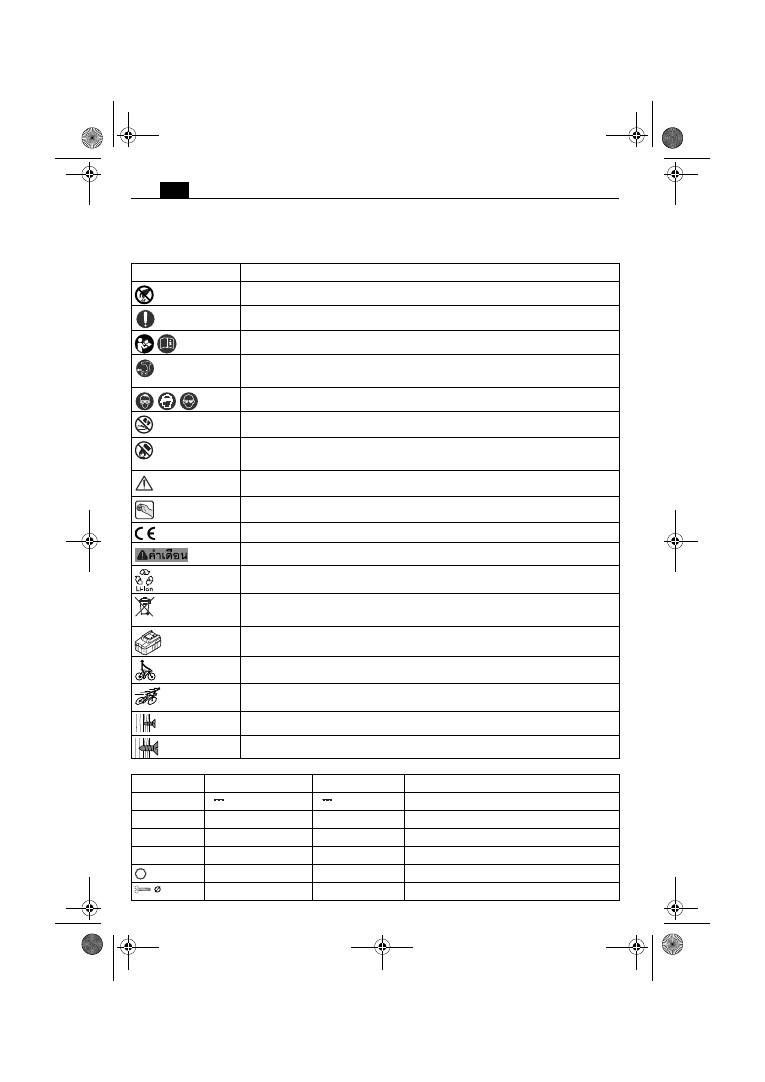
106
th
th
หนังสือคูมือการใชงานฉบับตนแบบสําหรับไขควงไรสาย
สัญลักษณ อักษรยอ และคําศัพทที่ใช
สัญลักษณ
ตัวอักษร
คําอธิบาย
อยาสัมผัสสวนที่หมุนของเครื่องมือไฟฟา
ปฏิบัติตามคําสั่งที่เปนตัวหนังสือหรือรูปภาพดานตรงขาม
!
ตองอานเอกสารที่แนบมา
เชน
หนังสือคูมือการใชงาน
และคําเตือนทั่วไปเพื่อความปลอดภัย
กอนเริ่มขั้นตอนการทํางานนี้
ตองถอดแบตเตอรี่ออกจากเครื่องมือไฟฟา
มิฉะนั้นจะไดรับอันตราย
จากการบาดเจ็บอันเกิดจากเครื่องมือไฟฟาติดขึ้นโดยไมตั้งใจ
สวมอุปกรณปองกันตาขณะปฏิบัติงาน
อยาชารจแบตเตอรี่ที่ชํารุด
เอาแบตเตอรี่ออกหางจากเปลวไฟ
ปกปองแบตเตอรี่จากความรอน
ต
.
ย
.
เชน
จากแสงแดดจานาน
ตอเนื่อง
ปฏิบัติตามขอสังเกตตามเนื้อหาที่อยูขางเคียง
!
พื้นผิวจับ
ยืนยันวาเครื่องมือไฟฟาสอดคลองกับระเบียบของสหภาพยุโรป
เครื่องหมายนี้แจงถึงสถานการณที่อาจเปนอันตราย
ที่อาจทําใหบาดเจ็บอยางรายแรงหรือถึงตายได
สัญลักษณรีไซเคิล
:
วัสดุที่ระบุนี้เปนวัสดุท
ี่รีไซเคิลได
ตองคัดแยกเครื่องมือไฟฟา
และผลิตภัณฑไฟฟาและอิเล็กทรอนิกสอื่นๆ
ที่เสื่อมสภาพ
เพื่อสงเขาสู
กระบวนการนํากลับมาใชใหมโดยไมทําลายสภาพแวดล
อม
ประเภทแบตเตอรี่
ความเร็วต่ํา
ความเร็วสูง
ลดแรงบิด
เพิ่มแรงบิด
ตัวอักษร
หนวยการวัด
สากล
หนวยการวัด
แหงชาติ คําอธิบาย
U
V
V
แรงดันไฟฟากระแสตรง
n
0
/min, min
-1
, rpm, r/min
rpm
ความเร็วเดินตัวเปลา
n
1
/min, min
-1
, rpm, r/min
rpm
ความเร็ว
ภาระเต็มที่
M...
Nm
Nm
แรงบิด
(
การขันสกรูแบบแข็ง
/
แบบนุม
)
inch
inch
อุปกรณจับยึดเครื่องมือหัวจมหกเหลี่ยม
mm
mm
เสนผาศูนยกลางสกรู
OBJ_BUCH-0000000072-001.book Page 106 Monday, June 18, 2012 8:40 AM
Оглавление
- สัญลักษณ อักษรยอ และคําศัพทที่ใช
- เพื่อความปลอดภัยของทาน
- คําแนะนําในการปฏิบัติงาน
- การซอมบํารุงและการบริการลูกคา

